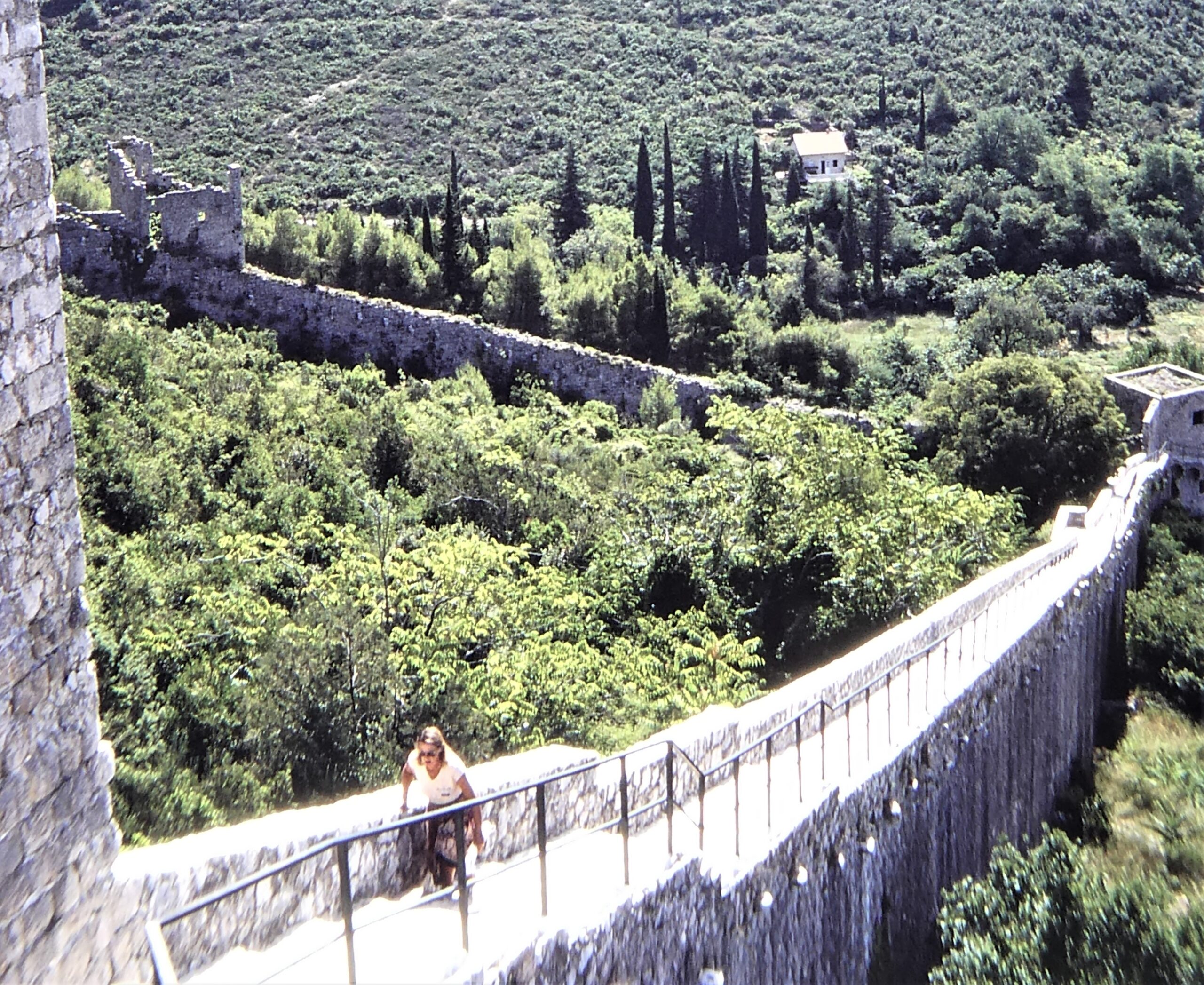The Mediterranean Sea
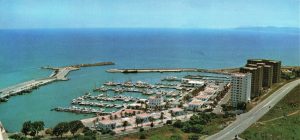 To the Costa del Sol in Spain for the winter
To the Costa del Sol in Spain for the winter
After six days in Gibraltar getting organised we took a five-hour sail to our destination for the winter, the Puerto Deportivo Estepona. We were directed into a good berth by friendly Antonio, who complimented me on my boat-handling! We signed in to the marina office and paid for our stay to the end of March 1987.
We wandered around the many restaurants and small supermercados in the complex, and it all seemed very pleasant - as did the classic Andalusian town. There were many white houses, cars kept to the main roads, and many cobbled streets were confined to pedestrians. The shops and market looked promising, with better prices than we had seen in Spain earlier and in Portugal. We took the evening "paseo" round the marina. Over the next few days we did more settling in, catching up with friends we had made along the way - including Jim and Margaret from Loon - and getting friendly with others who were to be our - and especially Norma's - neighbours for a long time.
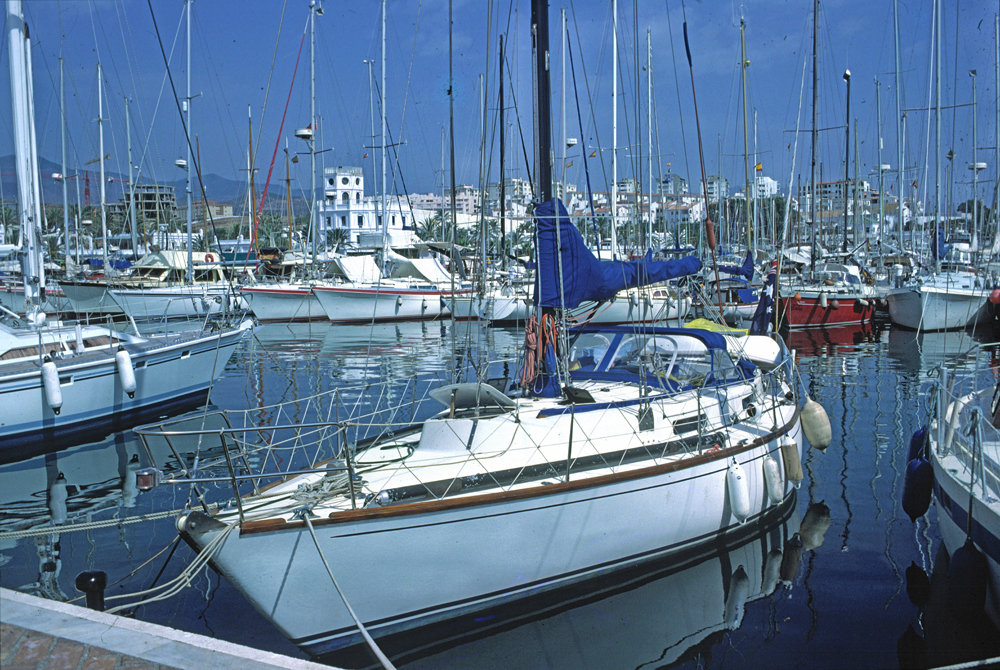
On 23 September I flew out to England to live with my mother for a while and to to make some money by writing a book. Norma was to stay aboard until Christmas. The first thing she did after I had left was to visit Loon and have a cheering-up glass of wine with Margaret.
Norma then got into an amazing program of doing up the boat. She washed and painted the whole interior, including taking up the floorboards and painting the bilge and cleaning out all the lockers before repainting them. She also rubbed down and re-did all the exterior varnish, a big and fiddly job.
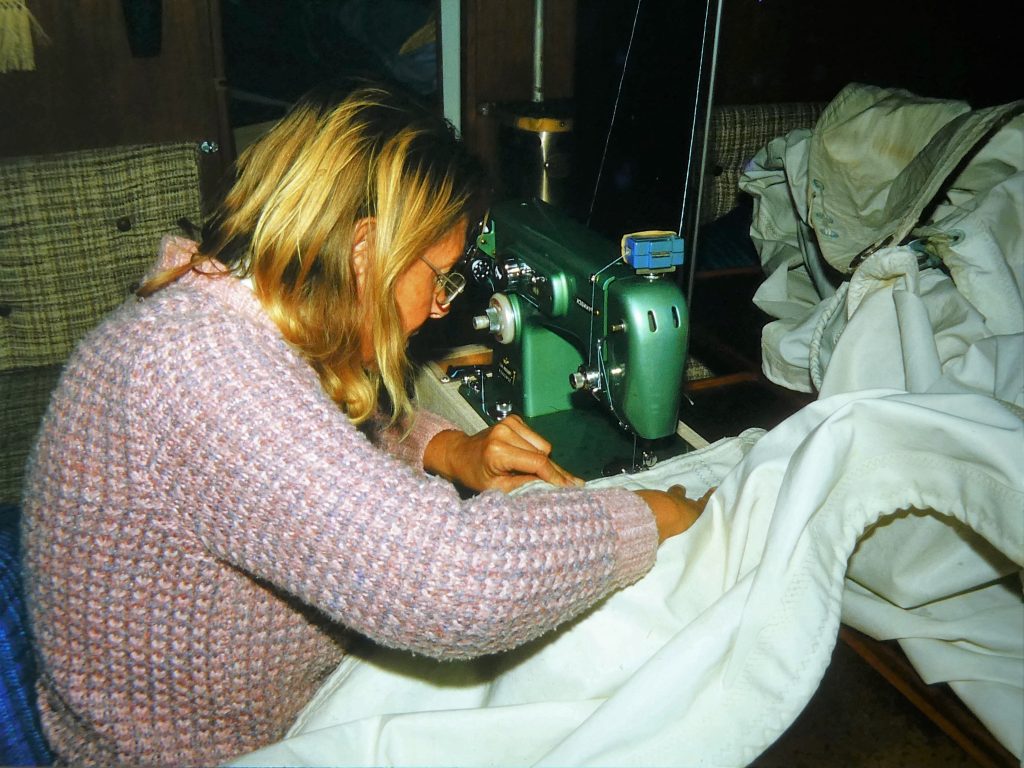 She washed, patched up or remade all the canvas covers and the interior upholstery, using the sailmaker's sewing machine we carried aboard, and made (and sold) several national courtesy flags for other boats. She spend good social time with friends, of course, including Jim and Margaret, Tom and Sylvia of Diphda, and Bill and Eileen in Aurora among others. Less welcome were some uncomfortable visits from predatory single males, mostly locals, a matter for discussion with another woman living aboard by herself.
She washed, patched up or remade all the canvas covers and the interior upholstery, using the sailmaker's sewing machine we carried aboard, and made (and sold) several national courtesy flags for other boats. She spend good social time with friends, of course, including Jim and Margaret, Tom and Sylvia of Diphda, and Bill and Eileen in Aurora among others. Less welcome were some uncomfortable visits from predatory single males, mostly locals, a matter for discussion with another woman living aboard by herself.
The weather she faced was very varied. She was regularly faced by the west Mediterranean Levanter wind, an easterly blowing across from Africa. This can be strong and persistent, and she and all the others had to maintain careful attention to the mooring lines. In mid-October there was a violent storm at night, the rainfall from which caused flooding and the collapse of part of the coastal roadway into town.
In much of her spare time she did plenty of walking, before flying to England in mid-December for Christmas with the relations.
She returned at the end of January with the flu but very pleased to be "home". In February I rejoined her, having completed my contract with the BMA by the submission of a manuscript for a book on the perception and analysis of risk, to be titled "Living with Risk".
A short land tour of southern Spain
Once together again on our yacht, we set out on a program of more refurbishing and maintenance. But first, however, we embarked on some touring in southern Spain.
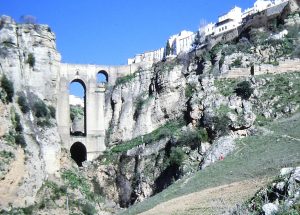
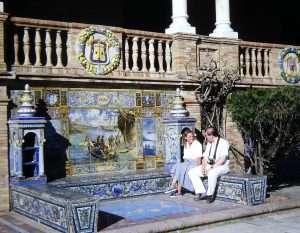 For the first week of this we were joined by my brother-in-law, Tony Price, and we rented a noisy little shoebox of a car, a Seat Panda - but an acceptable and cheap transport. We started off with a day's visit to Gibraltar and Algeciras and then headed up into the region of the pueblos blancos. Then, via the gorgeously spectacular Ronda, sitting among lovely hillsides in the morning light, to the city of Sevilla. We walked round the large and imposing cathedral, the old "Jewish" quarter, and the pretty Plaza de Espana. We revisited Arcos de la Frontera to show this lovely place to Tony, and returned to Ronda for some different views. Back to the coast we dropped into Marbella, with its tourist reputation but surprisingly attractive old part of town.
For the first week of this we were joined by my brother-in-law, Tony Price, and we rented a noisy little shoebox of a car, a Seat Panda - but an acceptable and cheap transport. We started off with a day's visit to Gibraltar and Algeciras and then headed up into the region of the pueblos blancos. Then, via the gorgeously spectacular Ronda, sitting among lovely hillsides in the morning light, to the city of Sevilla. We walked round the large and imposing cathedral, the old "Jewish" quarter, and the pretty Plaza de Espana. We revisited Arcos de la Frontera to show this lovely place to Tony, and returned to Ronda for some different views. Back to the coast we dropped into Marbella, with its tourist reputation but surprisingly attractive old part of town.
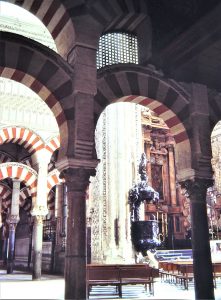 We dropped Tony back to Malaga airport but kept the little car for some more touring a little further afield on our own. The first stop was at Cordoba, and walked through the ancient mosque. Its amazing feature includes the cathedral that's sort of inserted into it, with a fit that works surprisingly well. There's beautiful walks through the older parts of the city, which we explored before setting off for unimpressive Jaen. On the way we drove through miles and miles of olive groves, and meandered on our way to Granada.
We dropped Tony back to Malaga airport but kept the little car for some more touring a little further afield on our own. The first stop was at Cordoba, and walked through the ancient mosque. Its amazing feature includes the cathedral that's sort of inserted into it, with a fit that works surprisingly well. There's beautiful walks through the older parts of the city, which we explored before setting off for unimpressive Jaen. On the way we drove through miles and miles of olive groves, and meandered on our way to Granada.
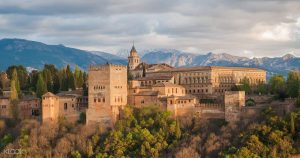 We stopped outside the city to view the Alhambra from an adjacent hill, and then drove down to the cathedral. Its hard to view outside, but its interior is huge and very impressive, with some beautiful features. There were few tourists there, unlike the Alhambra and the Moorish glories of Alcazar, which were packed. Finally we visited the 9-13th century castle of Alcazaba, with superb views from its western watchtower.
We stopped outside the city to view the Alhambra from an adjacent hill, and then drove down to the cathedral. Its hard to view outside, but its interior is huge and very impressive, with some beautiful features. There were few tourists there, unlike the Alhambra and the Moorish glories of Alcazar, which were packed. Finally we visited the 9-13th century castle of Alcazaba, with superb views from its western watchtower.
Back in Estepona we got stuck into more maintenance, and then took the boat out from the marina and sailed down to Gibraltar to pick up and fit a collection of boat gear at the helpful and well-equipped Sheppards Marina. Notably, I had ordered from England and now installed a gadget I had been wanting for a long time, 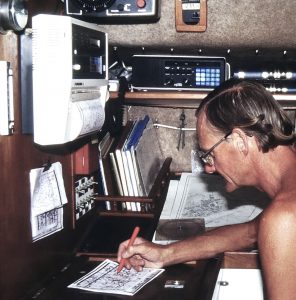 a Furuno weatherfax, which picks up and prints weather maps from anywhere in the world. I was already very committed to learning about and forecasting weather, and the new 'fax made this much more efficient a process. We also collected a new three-bladed propeller, the specs for which I had discussed with a propeller manufacturer at a boat show in London. One stainless wire strand in a lower shroud had fractured, so I got two new ones made up to fit later. We sailed back after a couple of busy and useful days in Gib.
a Furuno weatherfax, which picks up and prints weather maps from anywhere in the world. I was already very committed to learning about and forecasting weather, and the new 'fax made this much more efficient a process. We also collected a new three-bladed propeller, the specs for which I had discussed with a propeller manufacturer at a boat show in London. One stainless wire strand in a lower shroud had fractured, so I got two new ones made up to fit later. We sailed back after a couple of busy and useful days in Gib.
By this time we were counting down the final days of our winter stay, and had the boat hauled out at the slipway in our marina. We cleaned and painted the hull and fitted the new prop. As the month of March ran out the persistent winds that had been blowing appeared to ease, and on the morning of the 30th we waved to friends, pulled out, and sailed away.
But, err, we didn't. Outside the marina the wind was blowing at least 25 knots from the east, with a rotten little chop. So we turned round and came back in. "Here comes the boat with the weatherfax!", came the cry.
But after another calm night we did actually keep going after leaving, with not enough wind to sail but only a low swell. The plan at this point was to harbour-hop along the south coast of Spain. We would try to move as quickly as possible, allowing that the weather was likely to be changeable at this time of the year, with passing cold fronts trailing down from depressions to the north. It was still about two months before Old Med Hands would usually start to move. What we had not appreciated - quite apart from the changeable weather - was that while the land was beginning to heat up at this time, the water was still very cold. This meant that the afternoon sea breezes could be truly ferocious, kicking up the very choppy white water so typical of any real wind in the Mediterranean.
As it was, however, after leaving for the second time we motored most of the way to our first harbour along the way, Benalmadena , where a massive new marina was being planned. We simply tied up at a convenient wharf in the open harbour for an overnight stop. The next day we had a great sail with a fair wind initially, but the wind shifted to a sea breeze and the sea became horribly rough and rolly - what we were to confirm were typical Mediterranean conditions.
We spent the night in Motril harbour; the entrance had been very hard to see and the wind was rising to 30 knots, so we were relieved to anchor near a small yacht club marina. Otherwise, it was just a commercial harbour.
The wind died overnight but the weatherfax indicated that the cold front was not yet through. We sailed out into heavy left-over seas and the wind built up again into a full gale, so we diverted into the harbour at Adra to sit it out. This was another artificial harbour protected by a sea wall, big enough to take a ship or two, but with plenty of room for us to anchor. The 'fax told us there was a deep depression in Biscay, with a cold front moving through where we were. It got worse, with rain and black skies, and the barometer bottomed out at 997 MB. Snow had fallen on the hills behind the town!
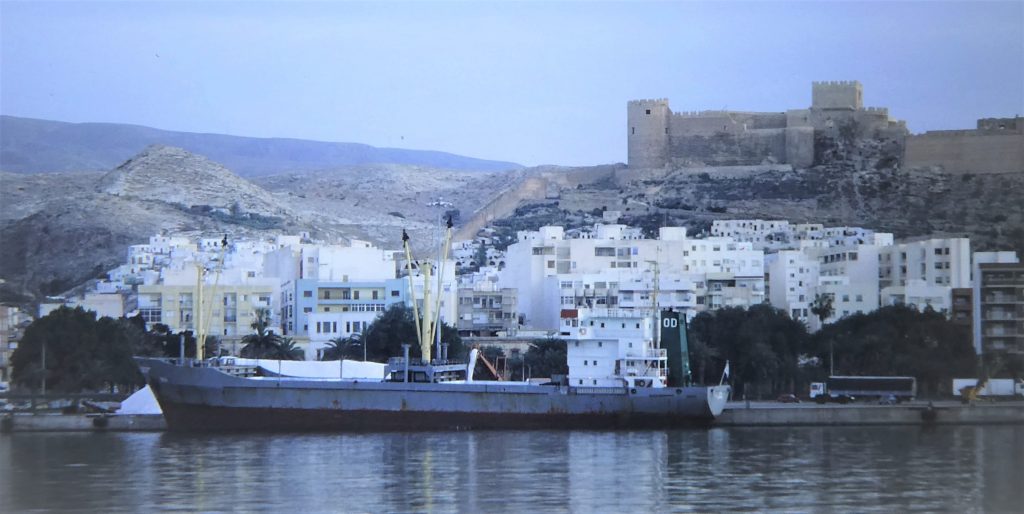 After a couple of nights of wind and rain, with some improvement we took a walk into the town; a typical working-class Spanish coastal town, cheap shops, a good market. We got to know the handful of cruising yachts that had also pulled in for shelter. We stayed two more night waiting for the weather to clear, and the forecast was good, so we left for a day sail that took us to the harbour at the big town of Almeria. We anchored off the Club del Mar, with a view of the Alcazaba and the stony brown hills rising up behind the town.
After a couple of nights of wind and rain, with some improvement we took a walk into the town; a typical working-class Spanish coastal town, cheap shops, a good market. We got to know the handful of cruising yachts that had also pulled in for shelter. We stayed two more night waiting for the weather to clear, and the forecast was good, so we left for a day sail that took us to the harbour at the big town of Almeria. We anchored off the Club del Mar, with a view of the Alcazaba and the stony brown hills rising up behind the town.
Soon ashore, we walked through the old part of town and up to the Alcazaba (which in Spanish means a Moorish fortification). This 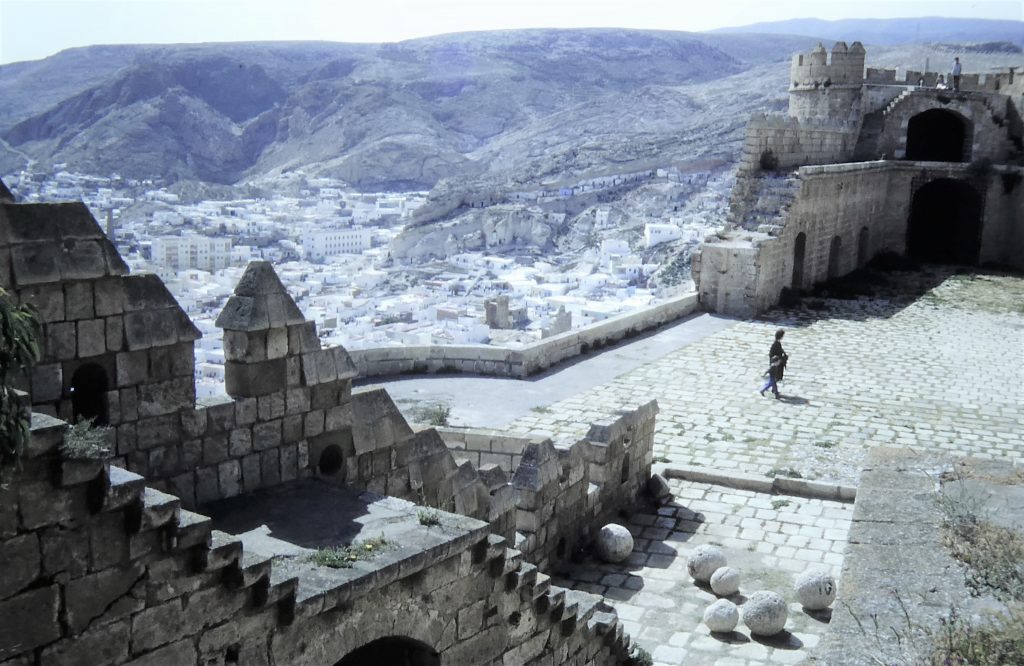
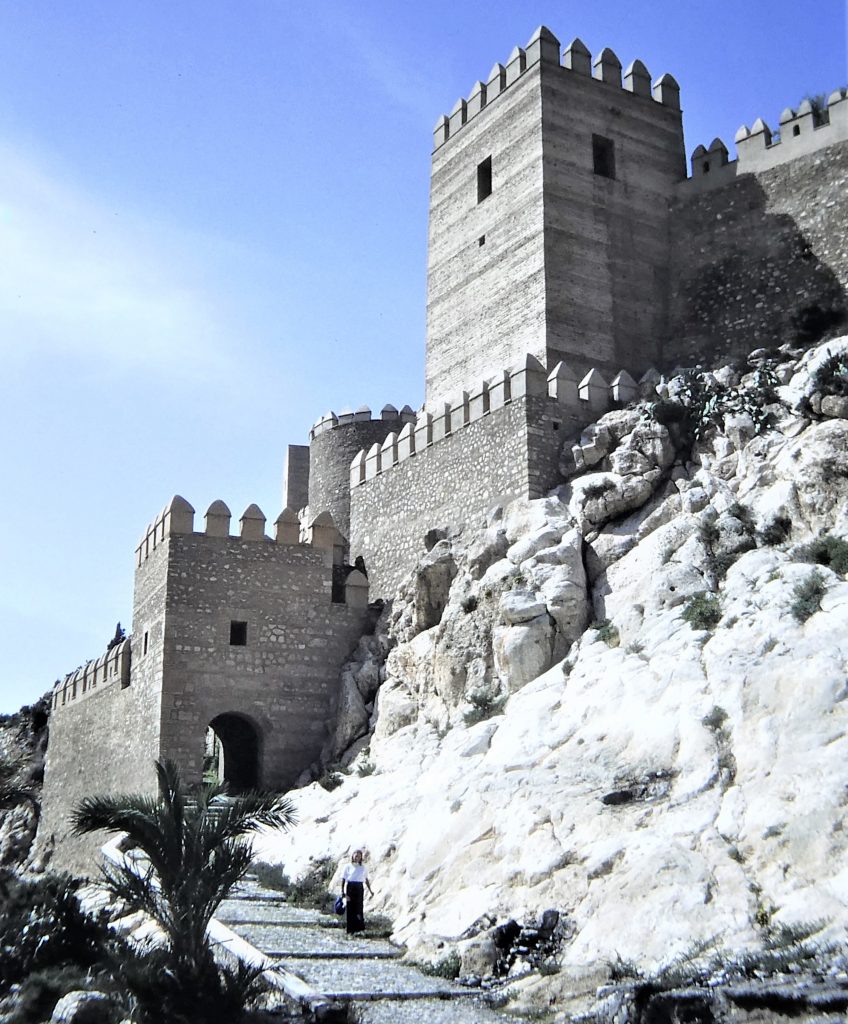 was a highly impressive fort with outstanding views over the town, the harbour and the arid hills. The original stronghold was built by the Phoenicians, and the Arabs rebuilt it into the fortress. The cannon balls are a memorial of the taking of the fort by Christian armies in the 15th century.
was a highly impressive fort with outstanding views over the town, the harbour and the arid hills. The original stronghold was built by the Phoenicians, and the Arabs rebuilt it into the fortress. The cannon balls are a memorial of the taking of the fort by Christian armies in the 15th century.
In the town there was a modern shopping centre with a good supermarket, all very non-tourist Spain. The main street was lined with neatly-trimmed leafy trees.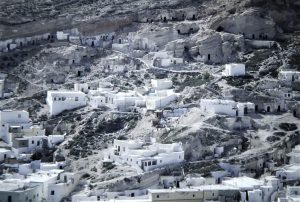
In an old part of the outskirts, people were still living in cave houses.
The night was a bit disturbed, with a swell still rolling in and a noisy VHF constantly broadcasting the yabbering between, we assumed, fishing boats.
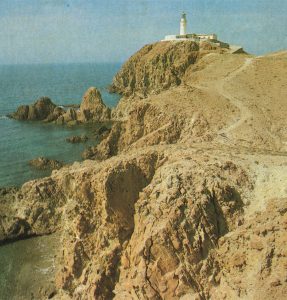 Once away, our first landmark was impressively high and notorious Cabo de Gata, the local Cape Horn, marking another corner turned on our passage round southern Spain. We rounded it under power in glassy calm, and turned up to the north-east, still following the coast. In no wind we were motoring well, very pleased with the much improved performance under power granted us by our new propeller. Our target was Garrucha, open to to the south, with another entrance through breakwaters very hard to make out from seawards. There was a central pier where some yachts were tied up, but it was crowded and looked dangerously rolly, so we anchored just away from some moorings. Unsurprisingly it was a restless night, and we pulled out early the next morning into a persisting southerly swell.
Once away, our first landmark was impressively high and notorious Cabo de Gata, the local Cape Horn, marking another corner turned on our passage round southern Spain. We rounded it under power in glassy calm, and turned up to the north-east, still following the coast. In no wind we were motoring well, very pleased with the much improved performance under power granted us by our new propeller. Our target was Garrucha, open to to the south, with another entrance through breakwaters very hard to make out from seawards. There was a central pier where some yachts were tied up, but it was crowded and looked dangerously rolly, so we anchored just away from some moorings. Unsurprisingly it was a restless night, and we pulled out early the next morning into a persisting southerly swell.
Further up the coast in hot and still conditions we came to an unexpectedly beautiful and peaceful little marina, Puerto Mazarron. We got a genuine welcome from the marina manager at the clubhouse; there were no tourists, few visiting boats and the marina - in the very early stages of its construction - was not yet in any guides. We refuelled, topped up the water, and did some maintenance in warm, peaceful conditions. We got friendly with a British couple who had over-wintered there.
The Balearic Islands
It became calm and settled after a pleasant three days, and as the marina boss commented, "everybody says they're going!" We motored out from behind the little island outside the port, along to Cape Palos and sailed away from the Iberian peninsula for the first time for nearly a year. We crossed many shipping lanes off the coast at one of these maritime crossroads and headed away from the land to the north-east and into the relatively open Mediterranean Sea. It got windy in the afternoon and into the clear night but calmed down in the early morning, still enough to sail. It was an unexpected pleasure to be able to make sail all night - rare in the Med!
 Arriving at the archipelago of the Balearic Islands, we first anchored in a bay in the little private island of Isla San Espalmador (aka Formentera). This was about mid-day, and we enjoyed a peaceful afternoon in the sun, with just a curving beach and low scrub around us. We relished a good Rioja with dinner, celebrating what seemed to be a return to island cruising.
Arriving at the archipelago of the Balearic Islands, we first anchored in a bay in the little private island of Isla San Espalmador (aka Formentera). This was about mid-day, and we enjoyed a peaceful afternoon in the sun, with just a curving beach and low scrub around us. We relished a good Rioja with dinner, celebrating what seemed to be a return to island cruising.
Espalmador is adjacent to Ibiza to the north, and it was a short sail up to Ibiza harbour. On final approach to the harbour, we had a terrific view of the fortifications around the old city and the cathedral.
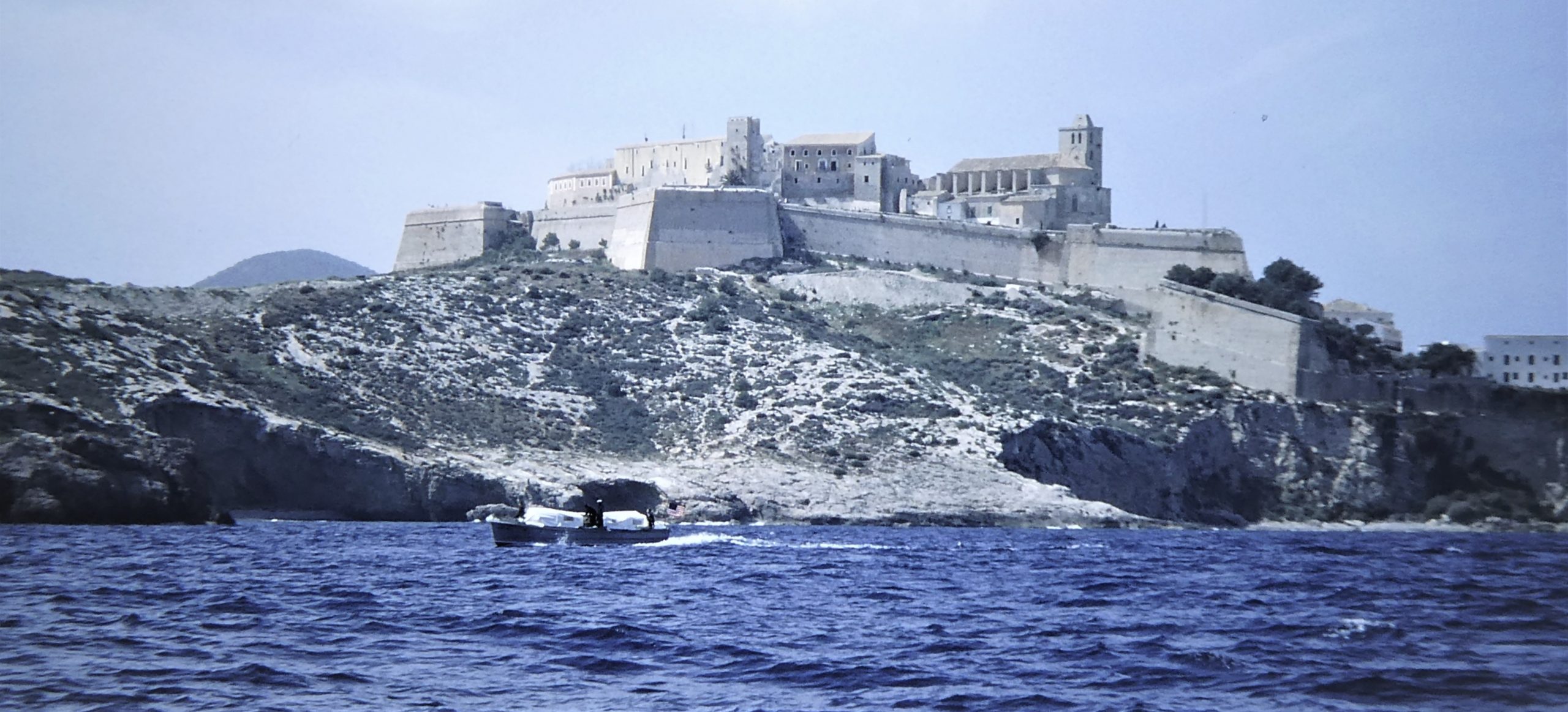 We anchored near the fishing harbour; there were plenty of marinas, but we knew they were expensive, some five times as much as along the Costa del Sol. No-one else was at anchor, and we didn't know whether it was allowed, but we were not bothered
We anchored near the fishing harbour; there were plenty of marinas, but we knew they were expensive, some five times as much as along the Costa del Sol. No-one else was at anchor, and we didn't know whether it was allowed, but we were not bothered 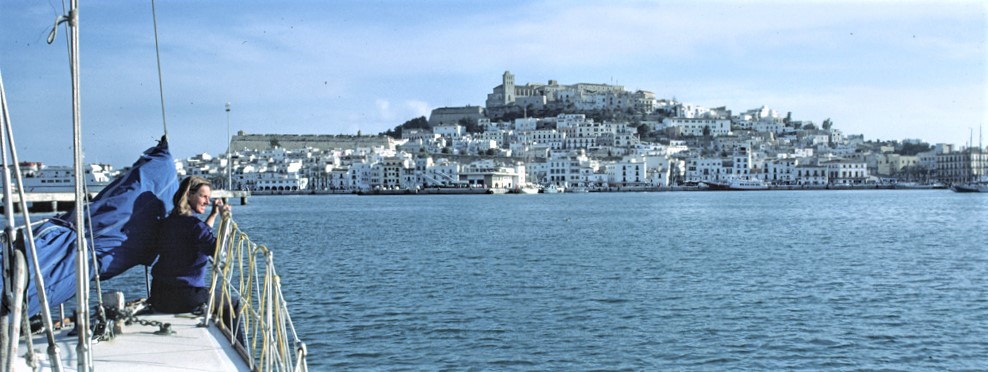 by officialdom during the two nights we were there. The town was pleasant, featuring spectacular old town walls and a cathedral at the top of a hill overlooking all. We walked around some touristy areas and visited the quite good tourist office - not that there were many tourists here at that time.
by officialdom during the two nights we were there. The town was pleasant, featuring spectacular old town walls and a cathedral at the top of a hill overlooking all. We walked around some touristy areas and visited the quite good tourist office - not that there were many tourists here at that time.
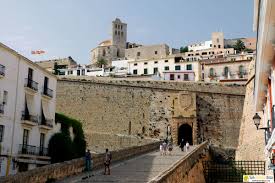 There was a lovely old market building of classical looks and a beautiful
There was a lovely old market building of classical looks and a beautiful 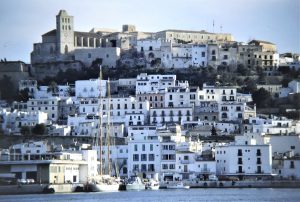 gateway leading up to the old town and the cathedral with its great view of the harbour, the town and the foothills around. An archeological museum showed well-displayed findings from many ages, including Punic (Carthaginian) and Roman. We did some shopping at the super-market on the way back to the boat.
gateway leading up to the old town and the cathedral with its great view of the harbour, the town and the foothills around. An archeological museum showed well-displayed findings from many ages, including Punic (Carthaginian) and Roman. We did some shopping at the super-market on the way back to the boat.
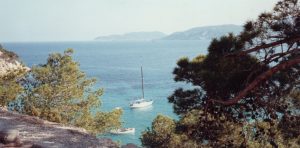 The day we left, we arranged to meet Aurora at an wide-open bay a little further east along the coast, Cala San Vicente. It was good to catch up with our friends Bill and Eileen, and had a great lunch, but there was a swell rolling in and the holding in fine sand was poor. We moved to the east side of the bay, which was better, but it was a restless night.
The day we left, we arranged to meet Aurora at an wide-open bay a little further east along the coast, Cala San Vicente. It was good to catch up with our friends Bill and Eileen, and had a great lunch, but there was a swell rolling in and the holding in fine sand was poor. We moved to the east side of the bay, which was better, but it was a restless night.
We left early for the short run to the island of Mallorca, sailing nicely in generally light winds, and across the big Bay of Palma in the late afternoon. This was the Thursday before Easter, and there were dozens of dinghies and small yachts racing in the bay including, we learnt, one being sailed by the king of Spain and his daughter. There were also several naval ships at anchor, including the US aircraft carrier Nimitz. We pulled into a marina at C'an Pastilla, on the eastern side of the bay across from Palma, and rafted up with a rather scruffy boat that was for sale.
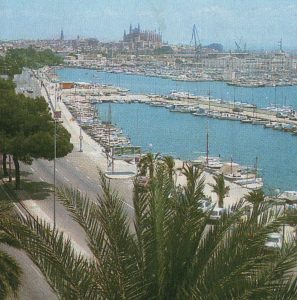 There we caught up with another pair of very good friends, Don and Jan on Passages, whom we had first met on the ICW and several times since. We had drinks and dinner with them. On Good Friday we motored to the head of the bay to the Puerto de Palma de Mallorca in calm conditions and to the Club de Mar marina in the Puerto Pi commercial centre. We were shown to a berth on one of the wide stone piers. Aurora was also in the marina, of course. The marina was not cheap but was good value by European standards and a lot safer than being tied up to the city's seafront wall, which was free, but where boats were prone to being cast off by happy ex-disco revellers as a late-night prank.
There we caught up with another pair of very good friends, Don and Jan on Passages, whom we had first met on the ICW and several times since. We had drinks and dinner with them. On Good Friday we motored to the head of the bay to the Puerto de Palma de Mallorca in calm conditions and to the Club de Mar marina in the Puerto Pi commercial centre. We were shown to a berth on one of the wide stone piers. Aurora was also in the marina, of course. The marina was not cheap but was good value by European standards and a lot safer than being tied up to the city's seafront wall, which was free, but where boats were prone to being cast off by happy ex-disco revellers as a late-night prank.
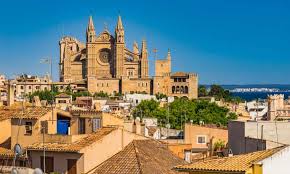 We took an afternoon walk into the town along the waterfront promenade. We immediately noted some lovely buildings, and thought that Palma was a much more attractive city than we had expected. At the other side of the port sits the cathedral, sitting high in the old town and overlooking a beautiful water park. We took a look at the old town, very quiet, narrow streets, brown and grey buildings with ornate doorways, balconies and windows. Many had huge overhanging eaves over shady alleys.
We took an afternoon walk into the town along the waterfront promenade. We immediately noted some lovely buildings, and thought that Palma was a much more attractive city than we had expected. At the other side of the port sits the cathedral, sitting high in the old town and overlooking a beautiful water park. We took a look at the old town, very quiet, narrow streets, brown and grey buildings with ornate doorways, balconies and windows. Many had huge overhanging eaves over shady alleys.
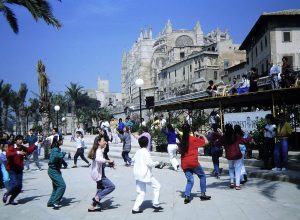 It was cool the next morning, pleasant for another walk into the town to check for mail, nothing much, and picked up some tourist literature at the tourist office - about as "helpful" as usual. In the evening we were picked up by Don and Jan, and taken to an out-of-town restaurant in a beautifully converted windmill. All the original machinery was in place. A great place and evening, but not so much the food.
It was cool the next morning, pleasant for another walk into the town to check for mail, nothing much, and picked up some tourist literature at the tourist office - about as "helpful" as usual. In the evening we were picked up by Don and Jan, and taken to an out-of-town restaurant in a beautifully converted windmill. All the original machinery was in place. A great place and evening, but not so much the food.
Easter Sunday was busy. We walked first to the cathedral, and caught the end of the Easter mass along with the packed congregation. The Gothic cathedral is huge, with slim pillars and high stained-glass windows. It is of an unusually open plan, with no screens, and the chapels all around the interior were especially lit for Easter, an unusual treat.
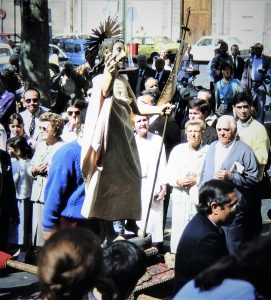
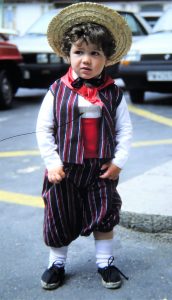 On leaving we heard bells, so we followed the sounds and caught the end of a procession entering the church of Santa Eulalia, accompanied by holy statues, local bands and young men in donkey outfits. The mass turned out to be for many children's first communion, with all the families watching, and event the youngest dressed up in local costume.
On leaving we heard bells, so we followed the sounds and caught the end of a procession entering the church of Santa Eulalia, accompanied by holy statues, local bands and young men in donkey outfits. The mass turned out to be for many children's first communion, with all the families watching, and event the youngest dressed up in local costume.
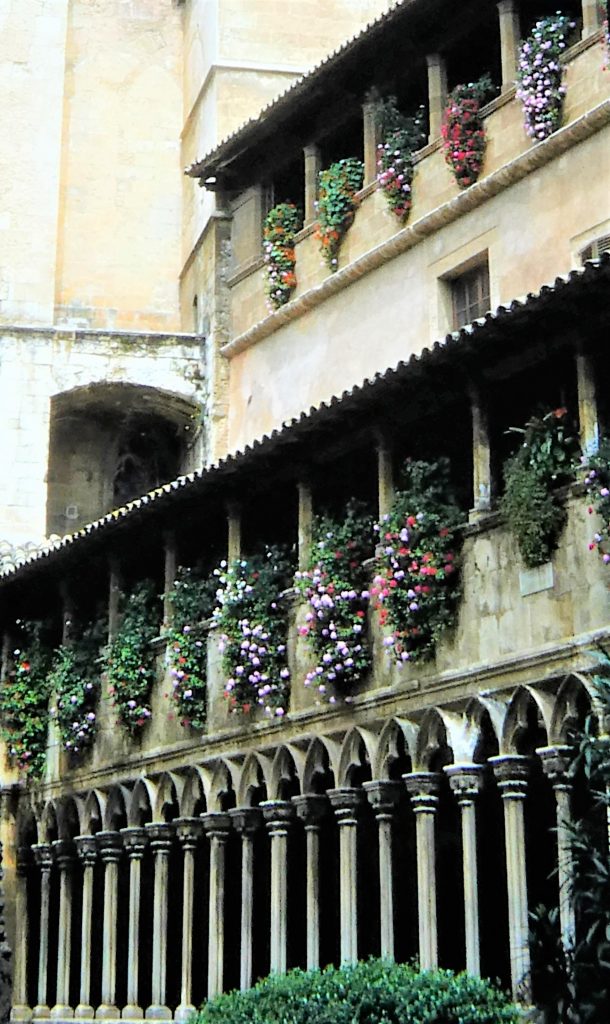 We next visited the church of St Francis, this time nearly empty because of competing events, to see its beautiful 14th century cloisters in the adjoining monastery. They enclosed an asymmetrical quad, with two layers of slim columns, Gothic trimmings, flowers spilling over from the upper cloister. Further into the old town we looked into a convent and a 10th century Arab bath-house in remarkable condition.
We next visited the church of St Francis, this time nearly empty because of competing events, to see its beautiful 14th century cloisters in the adjoining monastery. They enclosed an asymmetrical quad, with two layers of slim columns, Gothic trimmings, flowers spilling over from the upper cloister. Further into the old town we looked into a convent and a 10th century Arab bath-house in remarkable condition.
We made our way down to the park and lake under the cathedral and caught the end of a performance by a cheerful folk singing group. We had an outstanding lunch at Agustin's tapa bar: squid stuffed with crab, a superb kebab, mussels with mayonnaise, Mallorcan live stew, bread and beer. In the evening we went to a performance of the Mikado by a visiting British group: great fun and a good performance, but most of the small audience were ex-pat Brits.
The weather became cool and misty, but we continued chasing the Easter festivities and went to another performance of Mallorcan music and dance, of high standard.
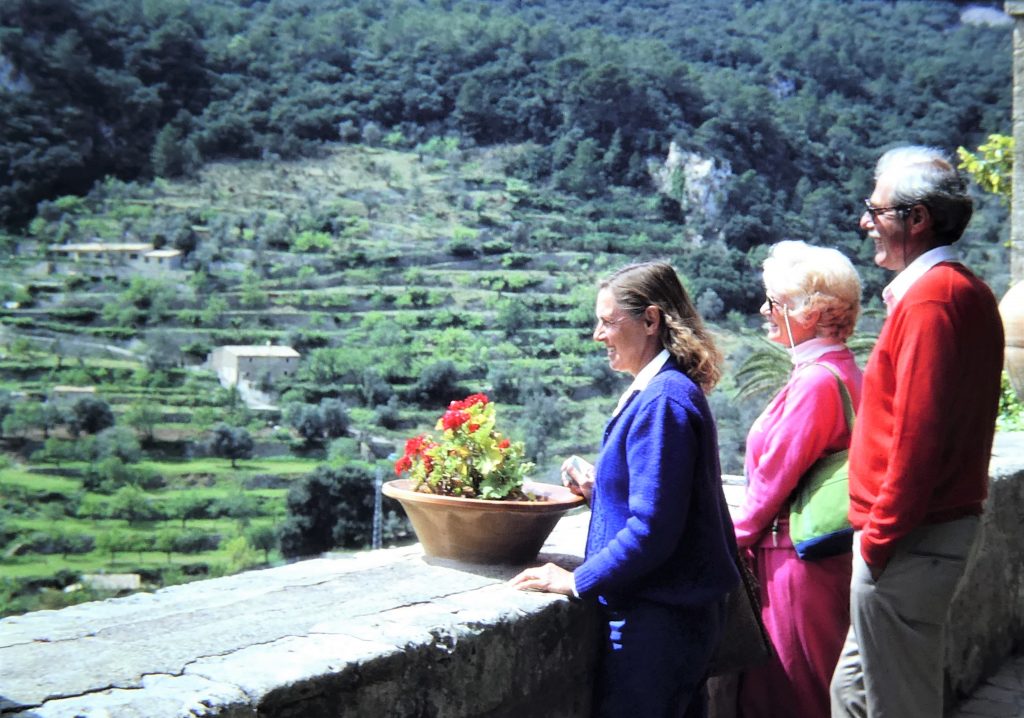 With Don and Jan in their little old Fiat we went off for a tour of the island. We first went to Valdemossa, and specifically the Carthusian monastery where Chopin and George Sand had spent a winter. We had long been puzzled by pictures showing the two different pianos supposedly used by Chopin there – we were highly amused to find out that one was a borrowed one he was forced to use for almost all the time, his own one having been held up in Spanish Customs! Nothing changes . . . . According to Sands’ book a rotten time was had by all, but they had a lovely view from their “cell”.
With Don and Jan in their little old Fiat we went off for a tour of the island. We first went to Valdemossa, and specifically the Carthusian monastery where Chopin and George Sand had spent a winter. We had long been puzzled by pictures showing the two different pianos supposedly used by Chopin there – we were highly amused to find out that one was a borrowed one he was forced to use for almost all the time, his own one having been held up in Spanish Customs! Nothing changes . . . . According to Sands’ book a rotten time was had by all, but they had a lovely view from their “cell”.
The beautiful buildings overlooked an outstanding view down the valley from little patios outside the monastery cells. We had lunch overlooking the cliffs of the north coast 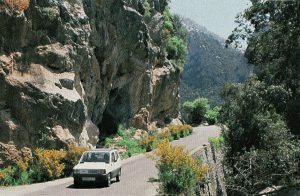 and then took a long drive east along a narrow winding road through the craggy, rocky mountains of the north, with the occasional view down a gorge to the sea. We went as far as Pollenca and Cape Formentor at the north-east corner and returned to Palma via the straight, smooth main road through the centre of the island, pointing out the scores of windmills. We dined at our favourite tapa bar, Agustin's again.
and then took a long drive east along a narrow winding road through the craggy, rocky mountains of the north, with the occasional view down a gorge to the sea. We went as far as Pollenca and Cape Formentor at the north-east corner and returned to Palma via the straight, smooth main road through the centre of the island, pointing out the scores of windmills. We dined at our favourite tapa bar, Agustin's again.
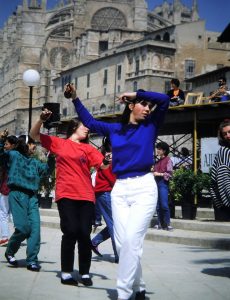 After a week we were well settled in, waiting for mail (proofs of my book) socialising with friends and making new ones all the time. There was yet more musical and folkloric events all over the town, part of a world folk dance festival, we learnt.
After a week we were well settled in, waiting for mail (proofs of my book) socialising with friends and making new ones all the time. There was yet more musical and folkloric events all over the town, part of a world folk dance festival, we learnt.
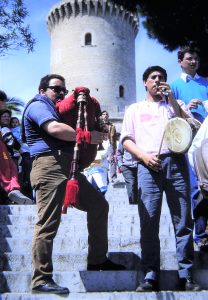
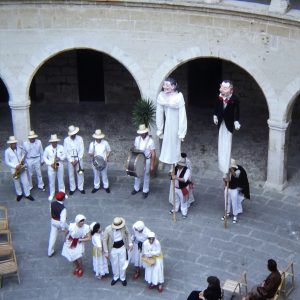 We walked up to the top of the big hill behind the town to Bellver castle for the Bellver Festival. We saw a mock wedding ceremony, hammed by players in clown costumes. In another extraordinary performance people were shut in small chicken-wire cages, while mimers dressed as clowns played out mini-dramas. We could make nothing of it, but learnt that the colourful dancing associated with the performance was called "Ball de Bot".
We walked up to the top of the big hill behind the town to Bellver castle for the Bellver Festival. We saw a mock wedding ceremony, hammed by players in clown costumes. In another extraordinary performance people were shut in small chicken-wire cages, while mimers dressed as clowns played out mini-dramas. We could make nothing of it, but learnt that the colourful dancing associated with the performance was called "Ball de Bot".
The proofs of my book finally arrived, having had to be picked up at Customs at the airport. Then, after another couple of days waiting for some wet and windy weather to clear, we sailed out from almost three enjoyable weeks in Palma and around the west end of the island to the port of Andraitx.
Sure enough our shadow was already there, and we had drinks aboard Aurora before dinner. Bill was already getting every possible weather forecast for the whole Mediterranean while planning their passage east, while attempting to make countless phone calls NY-style.
We joined the other anchored yachts crowded into the inner part of the harbour, beyond the marina. It was a quiet anchorage in the conditions, although we thought it would get pretty rough in a westerly. We started what would become a long friendship with Chris (a Professor of Geology) and Darlene in Denali, anchored next to us.

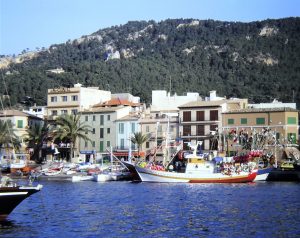 It was a very attractive harbour, surrounded by steep hillsides with a fishing village on the dockside - the main town of Andraitx is further up the valley, inland. With Bill and Eileen we rented a little Renault 5, primarily to get back to Palma for mail but also to take another trip up to lovely Valdemossa in beautiful weather (for a change, as it happens - the man on the fuel dock was not the only one complaining about "frio"). The cold and persistent wind
It was a very attractive harbour, surrounded by steep hillsides with a fishing village on the dockside - the main town of Andraitx is further up the valley, inland. With Bill and Eileen we rented a little Renault 5, primarily to get back to Palma for mail but also to take another trip up to lovely Valdemossa in beautiful weather (for a change, as it happens - the man on the fuel dock was not the only one complaining about "frio"). The cold and persistent wind 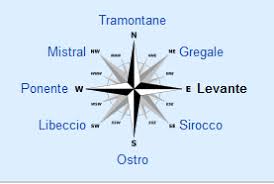 was primarily from the north and north-west, falling down from the Pyrenees and French Alps. Here, this wind is called the Mistral or the Tramontane.
was primarily from the north and north-west, falling down from the Pyrenees and French Alps. Here, this wind is called the Mistral or the Tramontane.
Every wind has its own name in the Mediterranean (we had complained about the Levanter in Estepona), giving them supernatural overtones and wrapping them in folklore, but we preferred to rely on the basic physics of the weather – not that it makes forecasting any easier in these waters!
Aurora and Denali sailed away, and the following day, after a pleasant week in Andraitx, we went back to sea, destination Sardinia. Our original plan, formulated months before we had come to understand the Mediterranean weather patterns, had been to sail from Mallorca to Menorca and maybe then on up to Corsica, but the persistently changeable and generally windy and wet conditions had us wanting to get south and for more of the warm Med weather we had been seeking. We were sorry to miss out on Menorca, because it looked good in the cruising guides.
 It was clear and calm when we left on May 7 for our two-night passage to Sardinia, but we weren't able to sail until the afternoon sea breeze came in as we passed round the south of the island. The southern tip of Mallorca is Cap Salinas, so named because it is backed by several kilometres of salt flats, which we could see from the boat. As we sailed away from the island we were back to motoring as the sun went down and that continued for most of the night. In the morning a good northerly came in, along with some confused Med swells, but it died by mid-day. We were visited by migrating redstarts and a swallow, who dropped in for a rest. One was happy to sit on my head. Over the second night it was much the same, wind coming and going, sails up and down - sailing in the Mediterranean is often very busy, and you don't get much sleep at night!
It was clear and calm when we left on May 7 for our two-night passage to Sardinia, but we weren't able to sail until the afternoon sea breeze came in as we passed round the south of the island. The southern tip of Mallorca is Cap Salinas, so named because it is backed by several kilometres of salt flats, which we could see from the boat. As we sailed away from the island we were back to motoring as the sun went down and that continued for most of the night. In the morning a good northerly came in, along with some confused Med swells, but it died by mid-day. We were visited by migrating redstarts and a swallow, who dropped in for a rest. One was happy to sit on my head. Over the second night it was much the same, wind coming and going, sails up and down - sailing in the Mediterranean is often very busy, and you don't get much sleep at night!
Sardinia, Italy
In the afternoon of the third day we pulled into Puerto di Teulada, a simple harbour behind a big harbour wall poking out into a bay right at the southern end of Sardinia. In the outer part of the bay we passed several US Navy landing craft and some other official-looking craft, but behind the sea wall it was a splendid little harbour with no apparent purpose, save that it was in a military area. There were no other yachts there, just a few small fishing boats.
After a quiet and calm night we took a walk ashore, and observed that the sea wall must have been originally planned to take large commercial vessels, but the lights and bollards were by then neglected and 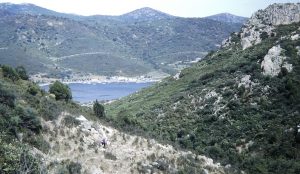 derelict. The wind was howling from the east by afternoon, but we were well protected. We walked up into the wild countryside up behind the harbour, through rocky hillsides, very wild, brown and scrubby, with pretty little wildflowers.
derelict. The wind was howling from the east by afternoon, but we were well protected. We walked up into the wild countryside up behind the harbour, through rocky hillsides, very wild, brown and scrubby, with pretty little wildflowers.
After a second night we sailed away for Cagliari. Sailing round Capo di Pula we could see the remains of a Roman amphitheatre and other ruins just up from the beach.
During this short passage the benighted Navico wheelpilot, which we had bought new in the UK and given trouble ever since, completely stripped its gears. We replaced it with our old Shipmate pilot and hoped it would hang in there for the rest of the voyaging. As far as possible we only used it for motoring, because it was very heavy on the battery.
Approaching Cagliari harbour we came across Aurora coming out, and Bill of course gave us lots of good advice! Cagliari is an ancient city, with lots of ruins from Punic, Carthaginian and Roman times. These would have been interesting, but we were only intending to make a brief stop on our way to Sicily.
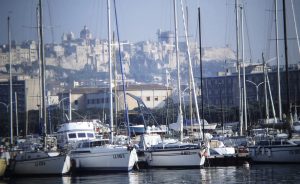 We anchored off the yacht club in the eastern corner of the harbour; the club officials were happy with that and told us that the only prohibited anchorage was around the naval area in the inner harbour. In quite hot weather - for a change, at last - we walked into the town to sign in at the Capitanaria di Porto for formal entry into Italy and to obtain the mandatory third-party ("civil responsibility") insurance required for Italian waters. We paid also for a two-month cruising permit.
We anchored off the yacht club in the eastern corner of the harbour; the club officials were happy with that and told us that the only prohibited anchorage was around the naval area in the inner harbour. In quite hot weather - for a change, at last - we walked into the town to sign in at the Capitanaria di Porto for formal entry into Italy and to obtain the mandatory third-party ("civil responsibility") insurance required for Italian waters. We paid also for a two-month cruising permit.
 We walked up into the old town through an impressive arch, passing many craft stalls run by black-clad old ladies, some with colourful head-dresses and aprons. We had a good but quite expensive (by Spanish standards) lunch at a small restaurant: ravioli with cheese, salsicchia con funghi. We saw more
We walked up into the old town through an impressive arch, passing many craft stalls run by black-clad old ladies, some with colourful head-dresses and aprons. We had a good but quite expensive (by Spanish standards) lunch at a small restaurant: ravioli with cheese, salsicchia con funghi. We saw more 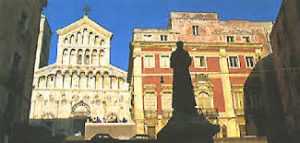 of the old town the next day, but it was a frustrating visit: the cathedral, the archeological museum and the Roman amphitheatre were all shut. The town itself looked seedy, with grey and peeling walls.
of the old town the next day, but it was a frustrating visit: the cathedral, the archeological museum and the Roman amphitheatre were all shut. The town itself looked seedy, with grey and peeling walls.
Back at the boat we were then told we could not anchor out, this was forbidden everywhere, and we must tie up with other visiting yachts on the main Capitanaria pier. Preparing to move from our peaceful anchorage we found that our anchor was fouled on a massive chain, and it was a heavy task to winch the whole bundle up and untangle the anchor.
By the time we were tied up at the pier the skies were quite clear and it was warm when out of the strong nor-wester that blew all day. After a good forecast and optimistic weather maps on the 'fax we slipped our lines early next morning for another overnighter on our way to Sicily.
Sicily
It started calm but then enough SW wind came in to sail. It then backed into the south east, more or less the way we wanted to go. This wind built during the day, and come the night we were banging into well-developed short, choppy seas in a night lit only by stars. It became clear that we were not going to be able to lay the north-west corner of Sicily on our starboard tack, so we decided to make instead for the tiny island of Isola Ustica, about 30 miles north of Palermo. Soon after 5:00 pm, under a blue sky, we caught our first sight of the island. This was exciting, because in his story of Ulysses' travels and adventures in the Mediterranean, the Odyssey, Homer has Ulysses approaching the island - for the first time - from the west. He has Ulysses recalling:
"We made our landfall on Aiolia (Aeolus) Island, domain of Aiolos Hippotades, the wind king, dear to the gods who never die - an isle adrift upon the sea, ringed round with brazen ramparts on a sheer cliffside."
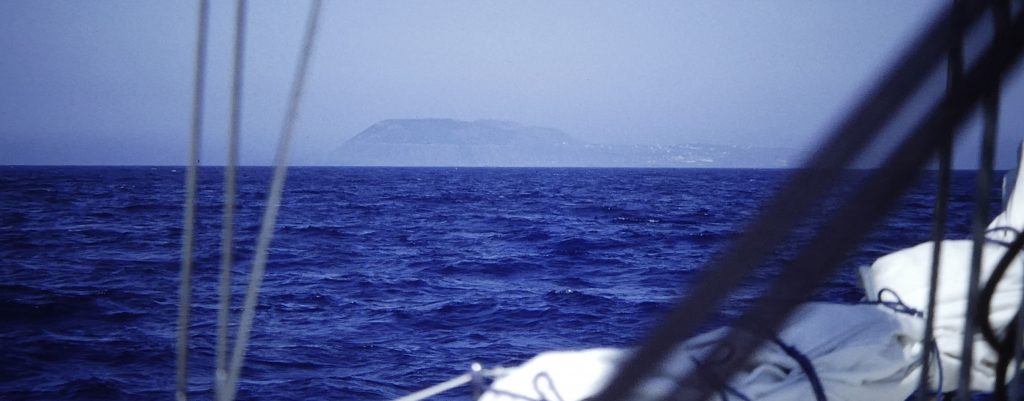 It is indeed a solitary and steep-to island. "Adrift" is normally understood as meaning floating around on the sea, but what does appear when the island looms up on a fair day out of the blue sky and haze of the Mediterranean is that it is suspended in the air, clear of the horizon. And that's exactly how it looked to us that May evening, just as Homer said to have done through the eyes of Ulysses.
It is indeed a solitary and steep-to island. "Adrift" is normally understood as meaning floating around on the sea, but what does appear when the island looms up on a fair day out of the blue sky and haze of the Mediterranean is that it is suspended in the air, clear of the horizon. And that's exactly how it looked to us that May evening, just as Homer said to have done through the eyes of Ulysses.
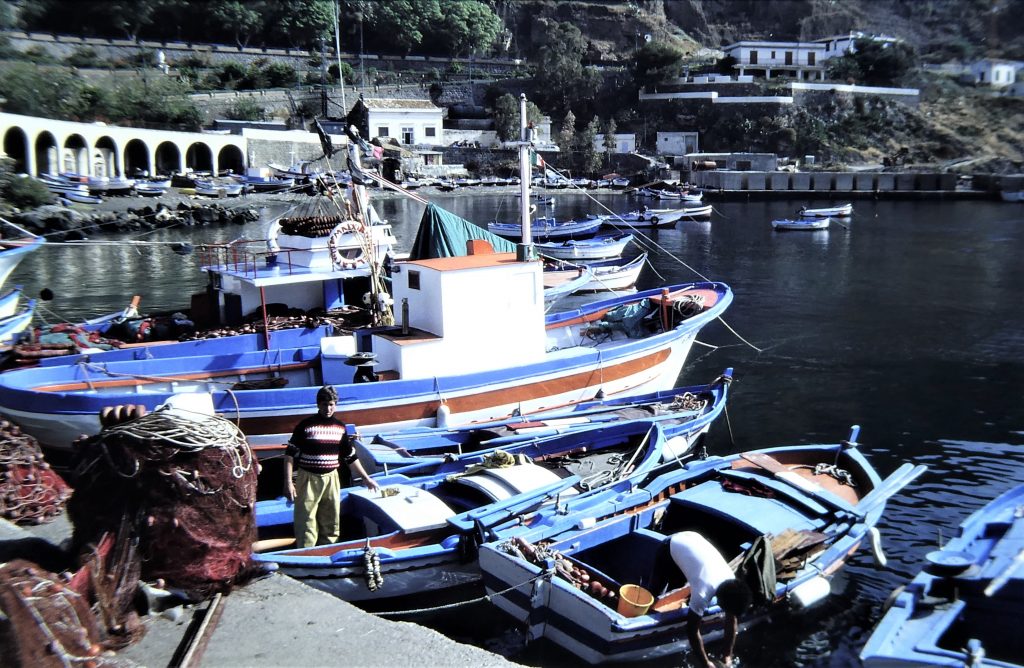 Through an opening in the cliffs we sailed into the tiny harbour. There was nowhere obvious to go, so we tied up on a wharf the inner side of the harbour wall. A passenger hydrofoil came in soon after us, and this was clearly a big event for the islanders, who came down to the town wharf in little cars. The town itself was very quiet; the hotel and restaurants were all shut and shuttered.
Through an opening in the cliffs we sailed into the tiny harbour. There was nowhere obvious to go, so we tied up on a wharf the inner side of the harbour wall. A passenger hydrofoil came in soon after us, and this was clearly a big event for the islanders, who came down to the town wharf in little cars. The town itself was very quiet; the hotel and restaurants were all shut and shuttered.
We stayed by ourselves all night, apart from some swell coming in with a passing front and change of wind direction, and Norma rearranging the fenders! It was still peaceful in the morning, and Norma did a big clothes wash and, as usual, hung it all up in the rigging to dry. We topped up with fuel and water.
But then the commotion began: the fishing fleet returned, and we were on their wharf. The fishermen started moving us around as they were trying to get alongside, with a typically Sicilian air: not unfriendly but quiet, glum, apparently emotionless. They simply didn't react when we tried to communicate. Anyway, with some regret because we had been looking forward to a walk round the island, we untied the boat and moved out of the harbour, the washing still flying proudly from the rigging.
Homer writes that when Ulysses asked Aiolos for his leave to sail, and asked for provisioning, "he stinted nothing, adding a bull's hide sewn from neck to tail into a mighty bag, bottling storm winds; for Zeus had long ago made Aiolos warden of winds, to rouse or calm at will". After starting well, on the tenth day of their voyage back to the island of Ithaca, in western Greece, the wind died. Ulysses, "weary to the bone", fell asleep. The impatient crew of the becalmed vessel thought at the time it might be a good idea to open the bag of winds ("crack that bag") and sail home. They untied the bag and got their wind all right: "Then every wind roared into hurricane; the ships went pitching west with many cries; our land was lost . . . the rough gale blew the ships and rueful crews clear back to Aiolia". King Aiolos was showed no sympathy: "Take yourself out of this island, creeping thing - no law, no wisdom, lays it on me now to help a man the blessed gods detest - out!"
Fortunately we were not aiming for a 10-day voyage, but only over to Sicily. Outside the little harbour we had a light nor'easter and a lovely sail with our colourful lightweight headsail down to the city of Palermo, on the north coast of mainland Sicily. It then became windless and humid only as we crossed the Golfo di Palermo. White clouds were drooping over the craggy mountains behind the city, all contributing to an impressive approach.
Into Palermo, and there was nowhere obvious to go, except that there appeared to be a harbour for yachts separate from the big ship and ferry docks. Anchoring was obviously not an option. As we were motoring slowly down past the line of marinas and got to the inner end, we got a call and wave from the shore, and were guided into a berth at the Yacht Club del Mediterraneo. The club secretary arrived on a moped, and nominated a reasonable charge including power and water. Friendly and helpful, he entertained us for coffee on his own boat. There was a fair bit of rubbish floating in the harbour, but we were expecting that, and looked forward to exploring the city the next day.
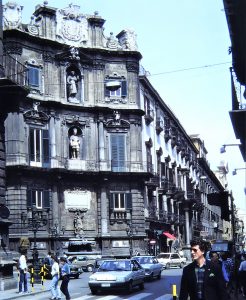 Palermo has been playing an important role in history throughout much of its existence; it is over 2,700 years old. It lies on the northwest coast of the island of Sicily, and was once one of the the crossroads of western civilisation, founded by the Phoenicians, conquered by the Romans, taken over by the Arab Saracens and rebuilt by the Normans in the 11th and 12 centuries. More recently it has become notorious as the power centre of the Mafia in Sicily.
Palermo has been playing an important role in history throughout much of its existence; it is over 2,700 years old. It lies on the northwest coast of the island of Sicily, and was once one of the the crossroads of western civilisation, founded by the Phoenicians, conquered by the Romans, taken over by the Arab Saracens and rebuilt by the Normans in the 11th and 12 centuries. More recently it has become notorious as the power centre of the Mafia in Sicily.
Our first impressions were negative, perceiving that the city could be a dreadful demonstration of what things could be like if that civilisation was ever to fail. Our first thoughts on entering the town were that the garbage situation was out of control: all the roadside garbage cans and bins were full, so piles were building up at short intervals all along every road and alley. We did see later some attempts to burn the piles as they lay. The traffic was anarchic, the several parks and squares looking scruffy and unattended.
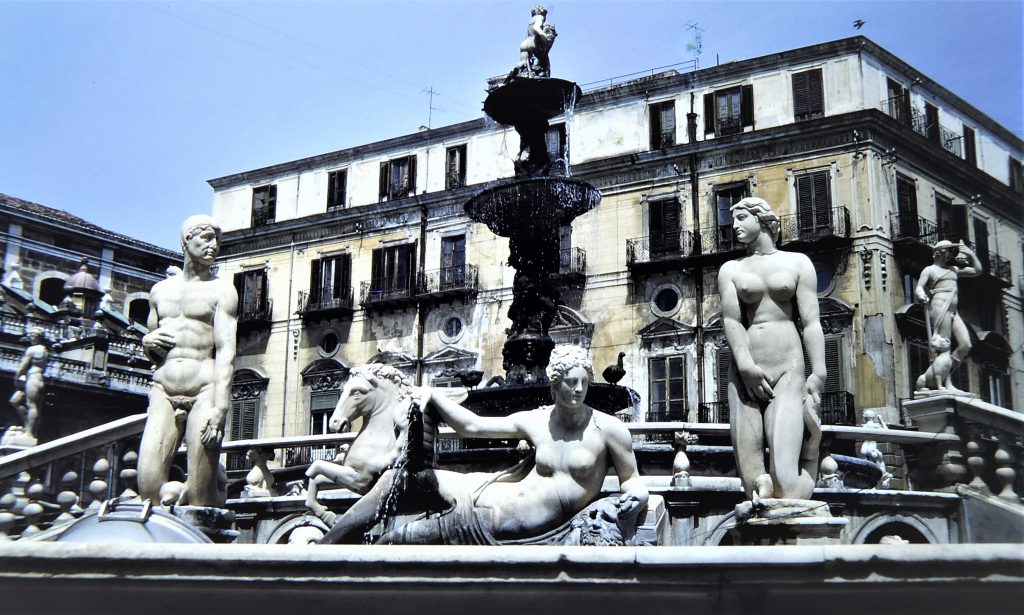 But then came the Palermo paradox: the facades of the public buildings, and most of the large private ones, were fundamentally beautiful. The central crossroads (right) have gorgeously curved facades. The 1575 fountain in the Piazza Pretoria (below) sits by the old Senate of Palermo, the centre of civic power. There is grandeur in the architecture but a feeling of sadness now. A contemporary commentator writes: "Birds did not sing, people did not laugh - at least, not in my presence". Precisely, we could only agree. Cleaned up, the city would clearly have been truly beautiful.
But then came the Palermo paradox: the facades of the public buildings, and most of the large private ones, were fundamentally beautiful. The central crossroads (right) have gorgeously curved facades. The 1575 fountain in the Piazza Pretoria (below) sits by the old Senate of Palermo, the centre of civic power. There is grandeur in the architecture but a feeling of sadness now. A contemporary commentator writes: "Birds did not sing, people did not laugh - at least, not in my presence". Precisely, we could only agree. Cleaned up, the city would clearly have been truly beautiful.
But, getting closer, we could see that the decorated facades were peeling and decayed. Old palaces were converted into apartment slums, wooden shutters were drunkenly askew over blind blank windows; blinded beauty, we wrote in the log. At the Amex (for mail) and tourist offices we were served by bored but pretty girls, gloomy with grey clothes, green and blue eyes signs of Norman genes.
There were some massive theatres - including the Teatro Massimo - in the area of the main road intersection, decorated with baroque statues and architecture, crumbling black. The interiors of the churches, such as the Palatine Chapel, were still displaying marvellous golden mosaics.
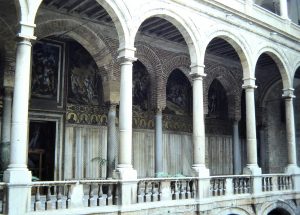 We walked down to the market - "colourful" was certainly the word. The Palermo market has always been famous. The vendors were all shouting, Arab style. There were large and good displays of typical Mediterranean small fish and more
We walked down to the market - "colourful" was certainly the word. The Palermo market has always been famous. The vendors were all shouting, Arab style. There were large and good displays of typical Mediterranean small fish and more 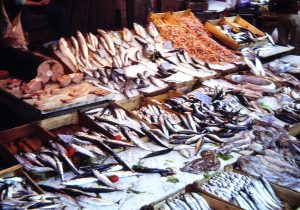 interesting large swordfish. Cheerful (by Sicilian standards ) groups of men were disjointing and butchering animals with hatchets. The alleyways around were all festooned with washing.
interesting large swordfish. Cheerful (by Sicilian standards ) groups of men were disjointing and butchering animals with hatchets. The alleyways around were all festooned with washing.
Bill and Eileen in Aurora had found a spot in the small enclosed inner harbour right in the city, and they came round for evening drinks. We had a long discussion about our experiences and reactions to Palermo!
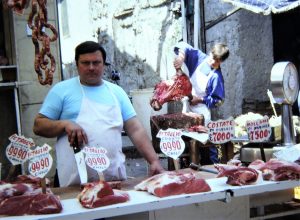 They had come into an inner harbour, beyond where our marina was, tied up to a wharf in the heart of the city. We had never seen such filthy water in our lives! It was absolutely black, and although it did not smell as bad as a cesspool, it certainly looked like one. But we laughed about it all, and they did enjoy being right in the centre of things and talking to the locals - Eileen was of Sicilian heritage and spoke good Italian.
They had come into an inner harbour, beyond where our marina was, tied up to a wharf in the heart of the city. We had never seen such filthy water in our lives! It was absolutely black, and although it did not smell as bad as a cesspool, it certainly looked like one. But we laughed about it all, and they did enjoy being right in the centre of things and talking to the locals - Eileen was of Sicilian heritage and spoke good Italian.
Over the next few days we often came across them, like us, with Michelin guide in hand to navigate the complicated streets.
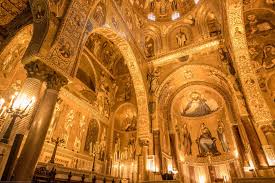 Our explorations took us to the Palatine chapel, with its interior shining with golden mosaics and topped by an
Our explorations took us to the Palatine chapel, with its interior shining with golden mosaics and topped by an 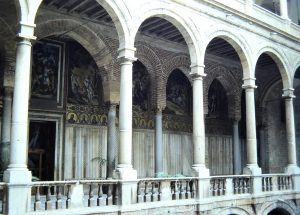 exceptional carved wood ceiling. Its decorations were a mixture of Alhambra-style Arab figuring and Christian pictures. The altar was glittering, flanked by marble columns and carved candelabras. Outside, there were some lovely and quite simple columned cloisters, very peaceful.
exceptional carved wood ceiling. Its decorations were a mixture of Alhambra-style Arab figuring and Christian pictures. The altar was glittering, flanked by marble columns and carved candelabras. Outside, there were some lovely and quite simple columned cloisters, very peaceful.
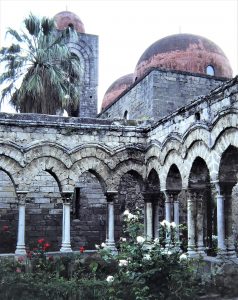 Nearby was the church of San Giovanni degli Erimiti, partly now in ruins. It was built in 1132 in a Moorish style, with pink domes. It was adjoined by a pretty 13th century cloister, a bit on the scruffy side.
Nearby was the church of San Giovanni degli Erimiti, partly now in ruins. It was built in 1132 in a Moorish style, with pink domes. It was adjoined by a pretty 13th century cloister, a bit on the scruffy side.
We did have one particularly interesting wander. Michelin suggested we should visit some catacombs in the outer western part of the city. After passing the cathedral we entered what was clearly a poorer part of town, and an old lady hailed us. "Stop!" And to Norma, "please take off your necklace!" She told us where we were heading was not safe, but she would get her son to guide us. And so he did, ducking through lots of alleyways where we would undoubtedly have got lost. This all helped to give us a much kinder feeling about the people here, and we came to find that the Sicilian's glum appearance would usually turn easily into helpful smiles.
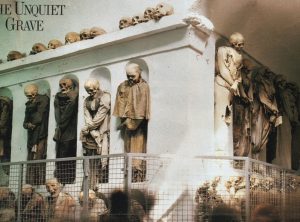 And thus we came to the Catacombe dei Cappucini under the church and convent of the Capuchins. The origin of this unusual, if not unique, "burial" space was in the 16th century, when the church ran out of space for the burial of monks. Instead, they began to excavated crypts underneath it. In 1599 they mummified brother Silvestro de Gubbio and placed him down in the new catacombs.
And thus we came to the Catacombe dei Cappucini under the church and convent of the Capuchins. The origin of this unusual, if not unique, "burial" space was in the 16th century, when the church ran out of space for the burial of monks. Instead, they began to excavated crypts underneath it. In 1599 they mummified brother Silvestro de Gubbio and placed him down in the new catacombs.
Over the centuries benefactors expressed a wish to be buried there too, and it became a status symbol to be entombed into the Capuchin catacombs. In their wills, local luminaries would ask to be preserved in certain clothes, or even to have their clothes changed at regular intervals. Priests wore their clerical vestments, others were clothed according to the contemporary fashion. Relatives would visit to pray with and for the deceased, whose body would be maintained in a presentable condition. In such a way the Sicilians have become known as worshippers of the dead.
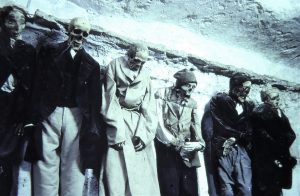 By ourselves we walked the whole length of the catacombs. We saw that some bodies are better preserved than others. Some are set in poses; for example, two children are presented sitting together in a rocking chair. Many bodies were laid out on large drying grids to speed desiccation, and the grids are still there.
By ourselves we walked the whole length of the catacombs. We saw that some bodies are better preserved than others. Some are set in poses; for example, two children are presented sitting together in a rocking chair. Many bodies were laid out on large drying grids to speed desiccation, and the grids are still there.
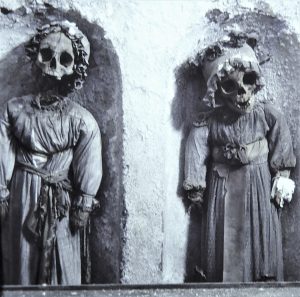 Sections of the catacombs became dedicated for different groups, including lay men, women, virgins, children, professional people, monks and priests. The last cleric to be entombed here was Brother Riccardo of Palermo, in 1871 but other famous people were still interred. The family groups are incredibly touching, despite also being macabre.
Sections of the catacombs became dedicated for different groups, including lay men, women, virgins, children, professional people, monks and priests. The last cleric to be entombed here was Brother Riccardo of Palermo, in 1871 but other famous people were still interred. The family groups are incredibly touching, despite also being macabre.
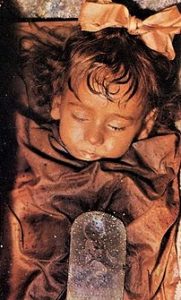 The catacombs were officially closed in 1880 but tourists continued to visit. The last burials are from the 1920s. One of the last of all to end up there was the lovely little girl Rosaria Lombardo, then nearly two years old, whose body is still remarkably intact. Lying in a catafalque in the centre of a little chapel of her own, frankly she looks like she is asleep. Her body was preserved through a complex embalming procedure only recently identified.
The catacombs were officially closed in 1880 but tourists continued to visit. The last burials are from the 1920s. One of the last of all to end up there was the lovely little girl Rosaria Lombardo, then nearly two years old, whose body is still remarkably intact. Lying in a catafalque in the centre of a little chapel of her own, frankly she looks like she is asleep. Her body was preserved through a complex embalming procedure only recently identified.
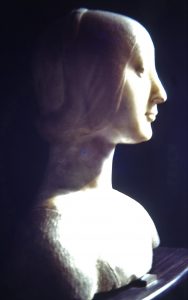 We spent time with the priest in charge at the entry doors. He spoke good English, and we were very interested to learn that he had been an Italian soldier in WW2 who was transported to a prison camp in Australia. He was similarly pleased to welcome Australian visitors.
We spent time with the priest in charge at the entry doors. He spoke good English, and we were very interested to learn that he had been an Italian soldier in WW2 who was transported to a prison camp in Australia. He was similarly pleased to welcome Australian visitors.
The weather had become windy and wet, so we did a little more exploring, including a visit to the Palazzo Abatellis. This holds the regional art gallery, which holds a fine and well-displayed collection of medieval religious art. There was a wonderful 15th century fresco, "The Triumph of Death", which seemed appropriate in Palermo! Also lovely was a marble bust of Eleanor of Aragon, its calm pose reminiscent of la Gioconda.
During our stay in Palermo our attitude to the city underwent a gradual change. We could no longer regard it as a dirty place with ruined buildings and grumpy people, but one of the most interesting places we had ever visited, with - often rather hidden - enclaves of beautiful medieval art and highly decorated baroque buildings. The people responded well to efforts at communication, and while we would not miss the more dismal aspects of the city we would miss it and hoped that it would be rebuilt to reflect its history, culture and architecture.
We sailed out in reasonable weather with a sea breeze, and after a day's sail rounded in to the harbour at the old town of Cefalu. It lies on a peninsula, with the harbour on the east side. In the centre of the peninsula rises a steep hill, topped with a bastion; down nearer the water stands a huge cathedral in what looked like the centre of the city. There was nowhere obvious to anchor with suitable protection, and we ended up rafted with Aurora alongside a long new wharf in the centre of the harbour.
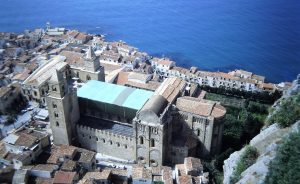 We went into the town the next morning and found it a pretty place, clean, and aiming for more tourists - which helped to make the locals very friendly. Cobbled streets with diamond-shaped inlays carried only little. local cars The cathedral was very old, with a Norman base, under renovation, so only the altar area was accessible. As in Palermo, the altar was backed by magnificent golden mosaics. In the old part of town was set an ancient Roman laundry with a running stream, little pools and rubbing stones; all very practical and used by the local people until recently. In the afternoon we walked up the "Rocca" behind the town, the site of a settlement in Roman times. There were lovely views over the sea, the town and the cathedral, whose towers rise out of the densely-packed tiled roofs. The top of the rock was another world, verdant, flowers everywhere, quiet.
We went into the town the next morning and found it a pretty place, clean, and aiming for more tourists - which helped to make the locals very friendly. Cobbled streets with diamond-shaped inlays carried only little. local cars The cathedral was very old, with a Norman base, under renovation, so only the altar area was accessible. As in Palermo, the altar was backed by magnificent golden mosaics. In the old part of town was set an ancient Roman laundry with a running stream, little pools and rubbing stones; all very practical and used by the local people until recently. In the afternoon we walked up the "Rocca" behind the town, the site of a settlement in Roman times. There were lovely views over the sea, the town and the cathedral, whose towers rise out of the densely-packed tiled roofs. The top of the rock was another world, verdant, flowers everywhere, quiet.
The harbour is wide open to the east, and a swell came in that made our berth very uncomfortable. Closely followed by Aurora we left early after the second night in a miserable dawn, wet, with squally winds from the west. The decks were covered in red Saharan dust. In the early afternoon we came to the harbour on the east side of the very prominent Capo d'Orlando. We had been told about this but it was not in our cruising guide. We were motioned into a good spot near an iron wharf in the NW corner, with only a small swell rolling in from the east. We anchored stern-to to the wharf to face the swell.
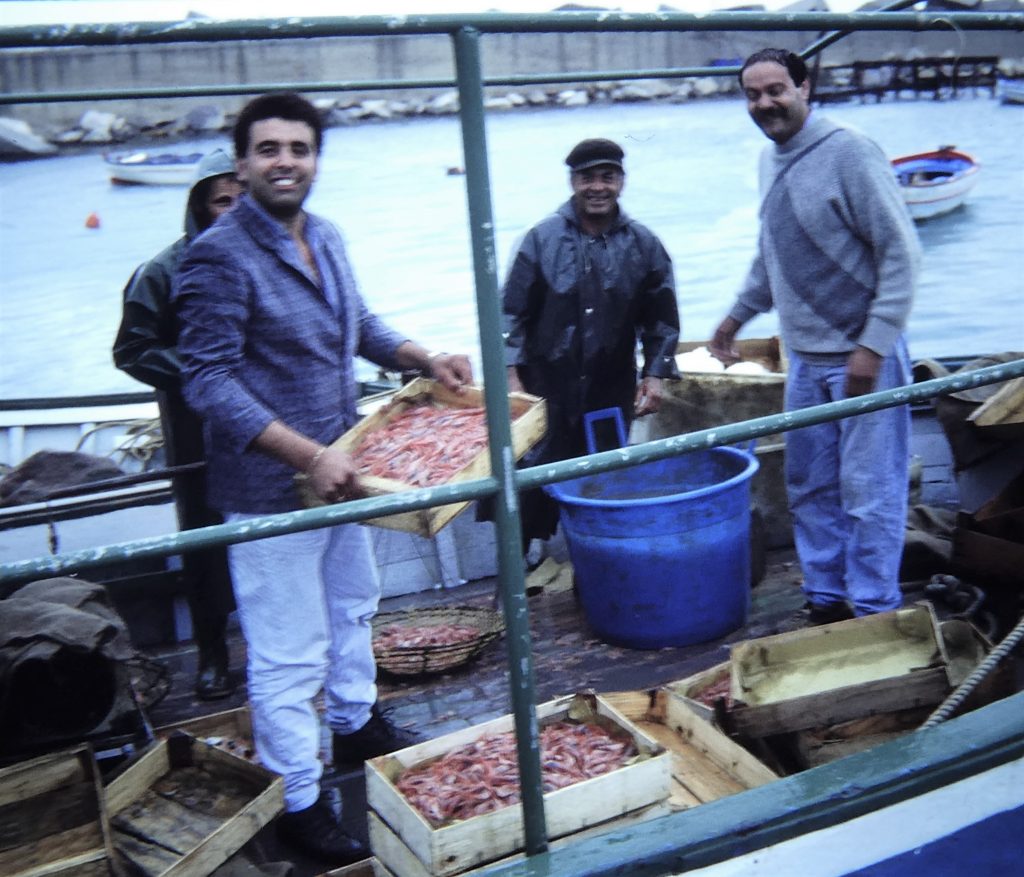 Then came the drama. First, a whole lot of local fisherman came down to the wharf to fish and chat. Then a big fishing boat came alongside, telling us that they were sheltering from the threatened Scirocco wind. Another fishing boat joined us on the other side. Then came heavy rain and a strong and gusty sou-wester. We pulled ourselves out away from the wharf a bit. It was all getting too much for us, when a small fishing boat handed us a great load of prawns "because we were Australian"! The wind and rain continued to built in the night, but was from the west, from which the harbour was sheltered.
Then came the drama. First, a whole lot of local fisherman came down to the wharf to fish and chat. Then a big fishing boat came alongside, telling us that they were sheltering from the threatened Scirocco wind. Another fishing boat joined us on the other side. Then came heavy rain and a strong and gusty sou-wester. We pulled ourselves out away from the wharf a bit. It was all getting too much for us, when a small fishing boat handed us a great load of prawns "because we were Australian"! The wind and rain continued to built in the night, but was from the west, from which the harbour was sheltered.
At crack of dawn the fishing boats started moving out, and one of them deposited a coat of black carbon from their exhaust when they started the motor. We decided to make another precipitate departure, but of course our anchor rode was crossed by another from a fishing boat. We managed to get disentangled, with the aid of quite clear water, and got straight into cleaning the decks as we motored out of the harbour.
In the early afternoon we rounded another very prominent cape and the town of Milazzo. We tied up at a street-side wharf, for the first time bow-to with a stern anchor, which became our favourite method for the "Mediterranean moor". We found that the boat maneuvering was easier, and it was much more private for us in the cockpit. There was good shopping at the supermarket, and drinks again on Aurora. None of us were deliberately seeking to cruise "together", but we were good friends who shared anchorages simply because were going the same direction at about the same speed.
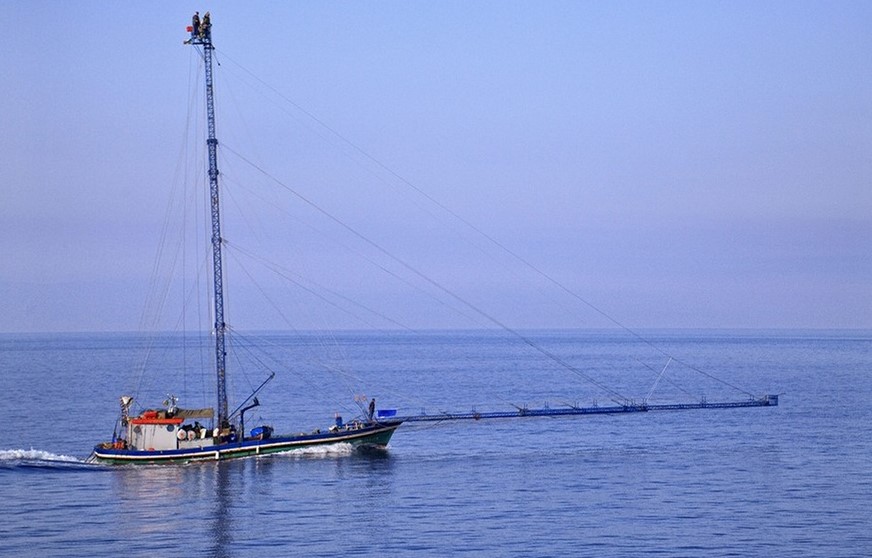 We were both off early the next morning under a murky sky and in flat calm. We soon came across the amazing sight of the swordfishing boats of Messina, called feluccas. Two or three men were standing on a lookout tower about 25 metres high, and an immensely long bowsprit, or gangplank, was the place from which the fish were speared. The vessels looked fearfully unstable, and I sure wouldn't have wanted to be up there with the spotters.
We were both off early the next morning under a murky sky and in flat calm. We soon came across the amazing sight of the swordfishing boats of Messina, called feluccas. Two or three men were standing on a lookout tower about 25 metres high, and an immensely long bowsprit, or gangplank, was the place from which the fish were speared. The vessels looked fearfully unstable, and I sure wouldn't have wanted to be up there with the spotters.
The swordfish season runs from about May to August. The story is that the fishermen on the long gangplank pray to the virgin saint and, following the directions of the lookout man, hurl a harpoon with a long fishing line to catch the fish. After a struggle, the fishermen pull the fish on board and thank God and the Saints for having helped them in their battle against this giant of the sea.
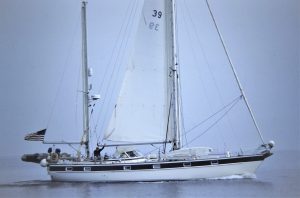 Bill in Aurora was in sight and in steady contact, and sure enough he drew our attention to these extraordinary craft, just in case we hadn't. On another issue altogether, Bill's main obsession at this time was his inability to get local technicians to fix his refrigeration in his luxurious new yacht. In true New York style, he complained, "I give these people the money and they still don't fix the fridge!".
Bill in Aurora was in sight and in steady contact, and sure enough he drew our attention to these extraordinary craft, just in case we hadn't. On another issue altogether, Bill's main obsession at this time was his inability to get local technicians to fix his refrigeration in his luxurious new yacht. In true New York style, he complained, "I give these people the money and they still don't fix the fridge!".
During the morning we passed under the high cables connecting Cape Peloro at the north-east tip of Sicily with mainland Italy, at the northern end of the Stretto di Messina. Transiting the strait has to be an exciting prospect for any sailor, with its strong tidal streams, eddies and whirlpools at the northern end. This is one of the only places in the Mediterranean where there is any marked tidal action, which made it alarming for early Mediterranean navigators unused to such movements. In addition, there is a steady southward surface current because the Ionian Sea, to the north, is colder and more saline than the Tyrrhenian to the south. However, we had near-perfect conditions as we motored through the narrowest part of the strait. When the wind blows from the south, we learnt from our sailing guide, the seas can be truly malicious and "no place for a yacht to be".
Just across the strait from Cape Peloro, on mainland Italy, sits a cliff-faced rock about which Circe had plenty of advice for Ulysses. She warned him that in the middle of this cliff is a dim cave and it is here that Scylla dwells, huge and monstrous. "Her legs -and there are twelve - are like great tentacles, unjointed, and upon her serpent necks are borne six heads like nightmares of ferocity, with triple serried rows of fangs and deep gullets of black death." Normally, she said, Scylla lived on swordfish and other large fish. But, she warned, "no ship's company can claim to have passed her without loss and grief; she takes, from every ship, one man for every gullet".
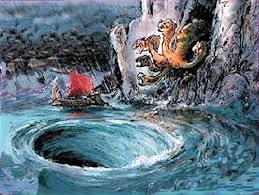 However, she advised him nevertheless to hold a course close to the rock, because otherwise he and his ship would be sucked down to the depths by the bottomless whirlpools overseen by Charybdis, "dire gorge of the salt sea tide", on the other side of the strait. Circe had told him to look for a tongue of land on which grew "a great wild fig tree in full leaf, and beneath it great Charybdis sucks down the dark waters". Nothing could save them if that happened. This threat was more to be feared than Scylla, because the risk was the loss of the vessel and all the men, rather than just a few of the crew.
However, she advised him nevertheless to hold a course close to the rock, because otherwise he and his ship would be sucked down to the depths by the bottomless whirlpools overseen by Charybdis, "dire gorge of the salt sea tide", on the other side of the strait. Circe had told him to look for a tongue of land on which grew "a great wild fig tree in full leaf, and beneath it great Charybdis sucks down the dark waters". Nothing could save them if that happened. This threat was more to be feared than Scylla, because the risk was the loss of the vessel and all the men, rather than just a few of the crew.
Thus, Ulysses had no choice but to hold Scylla's rock close by; and as foretold, "Scylla made her strike, whisking six of my best men from the ship. I happened to glance aft at ship and oarsmen and caught sight of their arms and legs, dangling high overhead. . . She ate them as they shrieked there, in her den".
He urged his crew to row as fast as they could down the eastern shores, and thus came safely past the "funnel of the maelstrom" of Charybdis and into the calmer waters to the south.
For ourselves, we did sail down the western side, daring Charybdis to swallow us, but although we certainly saw some overfalls off Cape Peloro and smooth whirlpools to the south of it, they were not of a nature to offer much of a threat. We read The Odyssey as we sailed along, and read a few appropriate pieces to Aurora over the radio.

Mainland Italy
We passed Messina on the western side and then Reggio Calabria to the east, holding the mainland to port as we rounded the tip-toe of Italy. We had been told that there was a possible anchorage just past the prominent lighthouse on Capo dell'Armi, but had no other details. We came to see what looked like a harbour wall, and went cautiously round it in shallow water to see, opened up in front of us, a massive ship harbour enclosed by high concrete walls. But no ships to be seen, just a couple of Scandinavian yachts tied to an inner wall. We did the same. There was ample space!
We relaxed in this sanctuary of peace after a busy and often turbulent ten days, in beautiful hot conditions. The spacious harbour was adjacent to a disused oil and gas plant, and was itself unused as well, apart from a handful of small fishing boats that came and went. There were clearly plans for its further development, and huge numbers of concrete blocks lay all around and into the surrounding scrub. We and the other yachties surmised that someone had ordered a crew to cast concrete blocks, but no-one had told them to stop! Italian government was pouring funds into Calabria in order to hasten its development, but much of the money was being diverted into Mafia projects with no secure future, and we guessed that this was one of them. We joined the Scandinavian crews for a barbeque that night.
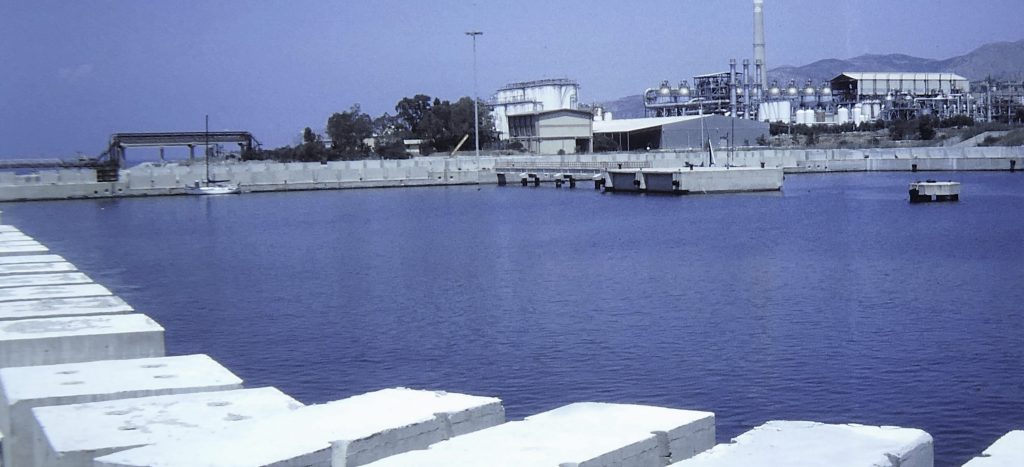
In what seemed to be summer at last, and we did some spring cleaning of the boat, particularly washing off the oil on the topsides we had accumulated in all those small Sicilian harbours. We walked into the quiet little village of Melito to the east. Many houses were empty, and decaying churches sat on the hillsides. The whole village had never really been completed. But there were smart new fields of citrus and vine with spray irrigation, and some healthy-looking compact farms. We bought some local food from a friendly old lady in one of the two shops.
The next day we took a longer walk along the beach to the west, to the larger village of Saline, with some more shops - and we came across a supermarket hidden behind some empty oil storage tanks on the way back, we assumed originally intended for the oil plant.
After four peaceful and productive days we sailed out eastwards in changeable weather and wind for an overnighter to Crotone, on the ball of the foot of Italy. There were lots of ships around this corner of the Med, which made life busy as the winds shifted and we kept switching from motor to sail. Rounding Capo Colonna to the north we encountered a northerly gale, most unpleasant and very wet. A typical longish and sleepless sail in the Mediterranean, in other words.
In the Porto Vecchio at Crotone, as the gale died away, we tied bow-to to the visitor's yacht quay next to Alegria, the boat owned by our new Danish friends Lise and Flemming. Our cruising guide told us that this was the worst harbour for yachts in Italy, but there are no other harbours of refuge anywhere near in this remote corner of Italy. In any event, we found it a perfectly adequate place, with efforts being made to clean it up and reasonable shops in the town. I soon had a medical call to look after an English yachty's injured leg.
After a couple of nights we motor-sailed for a day in calm weather across the Golfo di Taranto, between the toe and heel of Italy, and to the harbour at Capo S Maria di Leuca, at the very tip of Italy's heel. We tied alongside the inner wall of the breakwater, but moved to anchor when the fishing boats started coming in. The harbour is wide open to the west, and at Norma's suggestion we laid out a stern anchor to keep us head on to any swell - a very good idea, as it turned out, because sure enough the wind did come in and would have rolled us out of bed if we'd lain sideways.
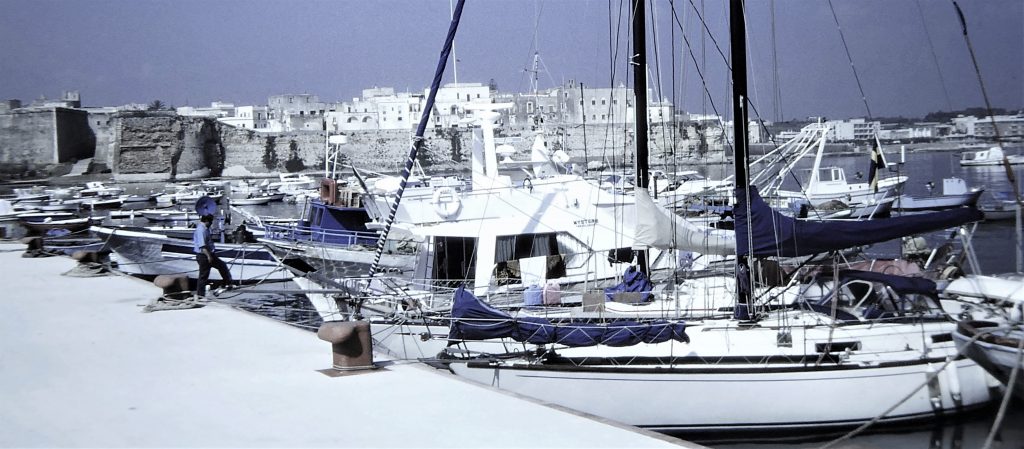
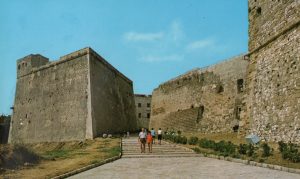 Norma was having trouble with biliary colic in the morning, but this was no harbour to sit out sickness, and we were early away for a reasonable sail to Otranto, where we tied up next to Alegria, bow-to to a NW-facing wall. It was an easy walk into the attractive old walled town. This reached by climbing steps up through the bastion and into the collection of small shops. There was a little Byzantine church, and a cathedral with a highly impressive mosaic floor.
Norma was having trouble with biliary colic in the morning, but this was no harbour to sit out sickness, and we were early away for a reasonable sail to Otranto, where we tied up next to Alegria, bow-to to a NW-facing wall. It was an easy walk into the attractive old walled town. This reached by climbing steps up through the bastion and into the collection of small shops. There was a little Byzantine church, and a cathedral with a highly impressive mosaic floor.
There was more to explore in Otranto, including an impressive castle, but at this stage in our Mediterranean voyaging we were simply making tracks as quickly as practically possible to reach Yugoslavia and our prime target of Venice, at the head of the Adriatic. We got the folding bikes reassembled and went for a short ride the third afternoon. This got us to a better shopping area and more interesting food.
We left a pretty narrow slot when we backed out of the tightly-packed harbour wall - a common observation when cruising the Med - and had a flat calm motor the whole way to the major harbour of Brindisi. The big port is a fair way inland, past the outer  breakwater walls and extensive commercials docks, and finally through the narrow Canale Pigonati to the wall along the face of the town. Flemming again took our lines and we tied up alongside Alegria. (Flemming and I had earlier found that we were both chess players, something we always on the lookout for.) We were moored right by the end of the Via Appia, marked by a Roman column at the top of a high, wide range of steps.
breakwater walls and extensive commercials docks, and finally through the narrow Canale Pigonati to the wall along the face of the town. Flemming again took our lines and we tied up alongside Alegria. (Flemming and I had earlier found that we were both chess players, something we always on the lookout for.) We were moored right by the end of the Via Appia, marked by a Roman column at the top of a high, wide range of steps.
With them, we watched the evening passegiata - families, men in suits, kids and all others - and we joined them later with gelati di passegio ashore along the waterfront walk, delightful.
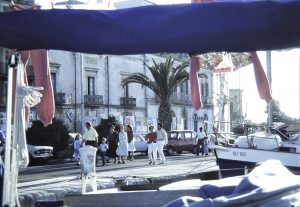 Brindisi has been a major port for thousands of years. Over its long history, the city has played an important role in trade and culture, due to its strategic position on the Italian peninsula and its connections to Rome's eastern provinces.
Brindisi has been a major port for thousands of years. Over its long history, the city has played an important role in trade and culture, due to its strategic position on the Italian peninsula and its connections to Rome's eastern provinces.
In the face of a good forecast the next morning we left with Alegria, with them sailing to Yugoslavia and us to move a bit further up eastern Italy before crossing over The Adriatic. By mid-day we were boiling along in a fantastic sail, going so well in a southerly of up to 30 knots that we decided to skip our next scheduled port of call of Villanova and press on to Monopoli.
This turned out to be an attractive and "genuine" harbour, a good stop of its kind. We moored bow-to in the inner part of the harbour wall, with only a short space available for cruising yachts. However, we were the only one there. We had a great position, right by the castle of Carlo V. We were the only cruising yacht (see our mast in the photo below). A Russian ship was tied up opposite us and another was in the outer harbour, along with fleets of blue-painted fishing boats. We were intrigued later to find that the Russian ship was unloading olive oil - talk about coals to Newcastle! We thought the oil was probably from Spain, to be sold later as genuine Italian.
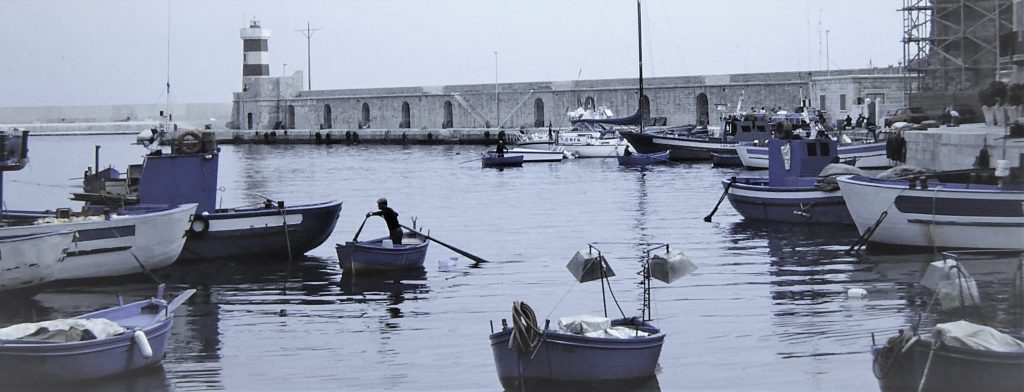 After a calm night some overcast cleared to a hot and sunny day, with a warm scirocco wind from the south-east. The old town was quite a surprise: it held a market with excellent produce (except for the typical scrappy Med fish), and was on the route through to the "new" town, with good shops of all kinds. The people, as we had already found in these east-coast Italian ports, were cheerfully friendly once contact was established, and very helpful with directions. We thought that this might be because they had very few tourists!
After a calm night some overcast cleared to a hot and sunny day, with a warm scirocco wind from the south-east. The old town was quite a surprise: it held a market with excellent produce (except for the typical scrappy Med fish), and was on the route through to the "new" town, with good shops of all kinds. The people, as we had already found in these east-coast Italian ports, were cheerfully friendly once contact was established, and very helpful with directions. We thought that this might be because they had very few tourists!
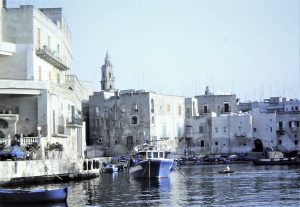 We took a bus to Bari, the large, modern city that is the commercial and
We took a bus to Bari, the large, modern city that is the commercial and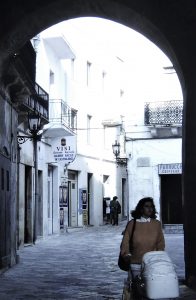 administrative centre of Apulia (Puglia). The description in our cruising guide of yachting facilities had made it, for us, an unattractive sailing destination, and a bus trip would show us a bit of the local country. The ride in was along the coast road via the small towns of Polignano and Mola to the bus terminal in the centre of the city. Bari has a reputation for petty crime, including the snatching of handbags by scooter riders, and we got several friendly warnings from local people. The main reason for the visit was business, as we had to get to the Amex agent for mail and money. This time we did get stacks of mail, including items that had been forwarded from the UK, Gibraltar and even Palma de Mallorca! We found the return bus stop with difficulty, and it was a hot ride back. Along the way we passed many
administrative centre of Apulia (Puglia). The description in our cruising guide of yachting facilities had made it, for us, an unattractive sailing destination, and a bus trip would show us a bit of the local country. The ride in was along the coast road via the small towns of Polignano and Mola to the bus terminal in the centre of the city. Bari has a reputation for petty crime, including the snatching of handbags by scooter riders, and we got several friendly warnings from local people. The main reason for the visit was business, as we had to get to the Amex agent for mail and money. This time we did get stacks of mail, including items that had been forwarded from the UK, Gibraltar and even Palma de Mallorca! We found the return bus stop with difficulty, and it was a hot ride back. Along the way we passed many 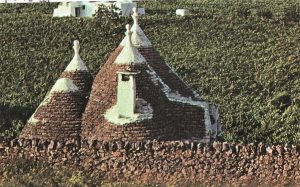 small farms and several limestone "trullis" with their conical roofing, typical of Puglia, mostly being used for storage.
small farms and several limestone "trullis" with their conical roofing, typical of Puglia, mostly being used for storage.
Walking back to the boat we enjoyed good Italian gelati on the hottest day so far this summer. We still had to stay a while longer, to deal with the masses of correspondence that now needed attention. We further explored the very original-looking old town, where fishermen's families still lived in tightly packed lines of houses in narrow streets and alleyways. Little plazas were hung about with flowers. A bas-relief sculpture on the nearby castle wall depicted a dead fisherman being carried ashore.
In earlier planning our intention had been to continue up the east coast of Italy to Venice, then sail south down the coast of Yugoslavia. However, although the Italian people were friendly and well-meaning, and the food good, we were getting tired of moving from one noisy crowded harbour to another, and we yearned for a return to peace and quiet, lying to our anchor in a protected bay. We even debated leaving the Mediterranean earlier than scheduled and sail to the Caribbean. But we had never quit so far, and accounts by other cruisers and descriptions in the cruising guides made it pretty clear that the Croatian coast would give us all we wanted.
So, after a typically noisy night, with fishermen coming and going, we cast off from Monopoli and headed out north across the Adriatic, sailing for the small town - and port of entry - Korcula, in the Socialist Republic of Croatia, a constituent of the Socialist Federal Republic of Yugoslavia.
Yugoslavia, the Croatian coast
We had a pleasant sail in sunny weather and light winds during the morning and afternoon, but by late evening we were motoring in one of the flattest calms we have ever seen. In the early hours of the following day we were able to set sail again though the early dawn. Leaving the island of Mljet to our right we crossed the Mljetski Kanal and entered the Peljeski Kanal, all between the multitude of islands we came to love, all along the Croatian coast. Navigation was mostly by sight, and was easy once the islands were identified and we got used to trying to pronounce their names.
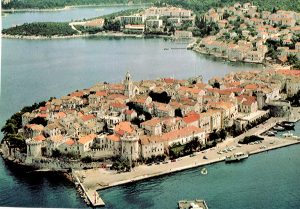
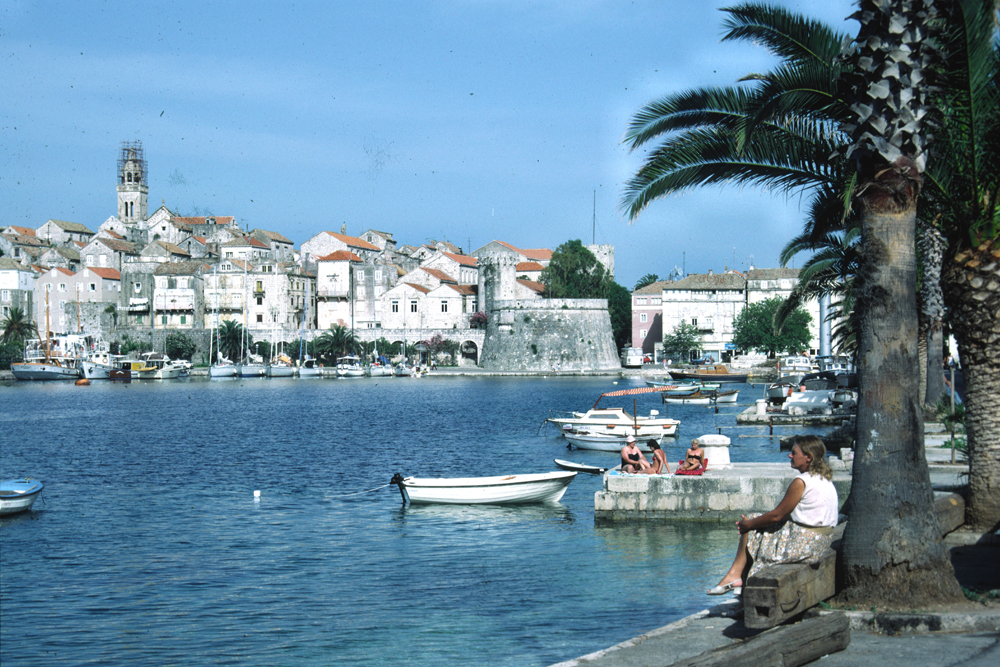 Korcula lies in a very protected position on the north side of the long island (most of the islands are long) of the same name, looking across the channel to the long Peljesac peninsula, part of the mainland. The old walled town of Korcula lies of a little peninsula of its own, and we tied bow-to to the harbour wall on the town's north-west side. We were immediately approached by a sailor who escorted us to the office of the Port Captain. We were cleared in quickly and efficiently, after Customs had checked us out aboard. We were in a very picturesque position, right under the battlements of the town walls.
Korcula lies in a very protected position on the north side of the long island (most of the islands are long) of the same name, looking across the channel to the long Peljesac peninsula, part of the mainland. The old walled town of Korcula lies of a little peninsula of its own, and we tied bow-to to the harbour wall on the town's north-west side. We were immediately approached by a sailor who escorted us to the office of the Port Captain. We were cleared in quickly and efficiently, after Customs had checked us out aboard. We were in a very picturesque position, right under the battlements of the town walls.
We walked into the tightly-packed little town, all old and original - there'd be no room for anything new! We climbed a flight of steps through a gate into a small square, then into the main "street" to the central town square. The church was there, of course, and an attractive palace with ornate balconies. There was much Venetian influence, and rounded battlements.
Shopping at the market the next day we found plenty of fruit and veg, although not of great quality, and the supermarket was perfectly adequate.
The mooring on the wharf got very crowded, so we moved off to get fuel - we'd been using a lot - and left the harbour to sail up the Peljesac channel to the west and to an anchorage between the little island of Otocic Kneza Mala and the mainland. This was a much better anchorage than it looked on the chart or on entry, well protected and very quiet. We relished the fact that we 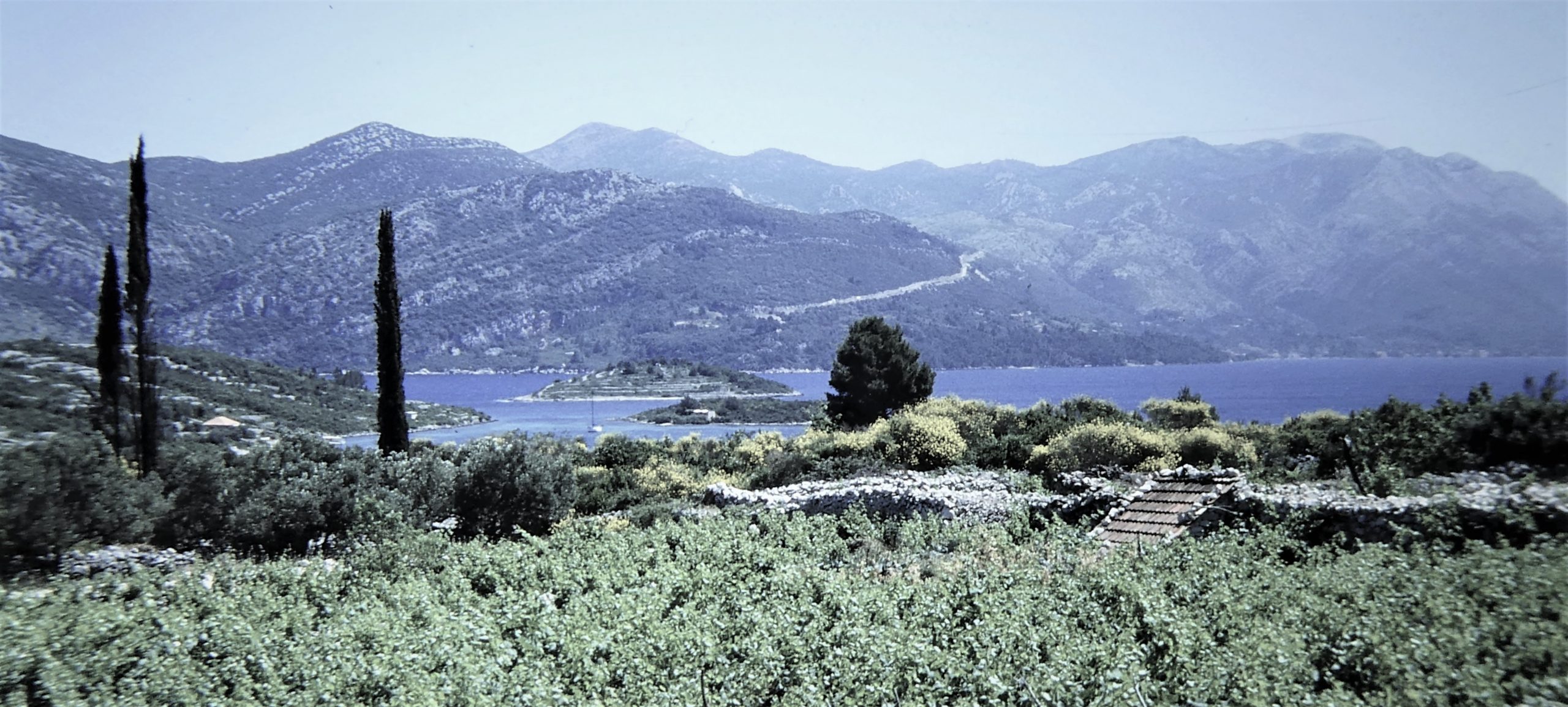 were lying to our anchor, alone, in a "proper" anchorage at last, for the first time since Teulada.
were lying to our anchor, alone, in a "proper" anchorage at last, for the first time since Teulada.
By our side, ashore, there were steep terraced slopes, and across the channel to the mainland we could see the high, steep mountains along the Peljesac peninsula. A fisherman came over to say he was laying nets, so to be careful if we moved - and said we had a "very pretty boat"!
After a peaceful night despite a brisk wind we walked ashore via a little dinghy dock and to the head of the bay ("uvala") and across the top of the peninsula to the village port of Racisce. The hillsides were covered by tiny plots enclosed by terraced stone walls - some vines, some vegetables and olive trees. Wild flowers were growing in abundance among green scrub on the rich soil. With the blue sea as a background, it was all very picturesque and colourful. Racisce was a comparatively newly built place, in an attempt to repopulate the area, but people were moving out, according to a chatty Yugo-Australian on the wharf. He had several investments in Australia, but was in Yugoslavia for a while on family matters. Australia was booming, and he said he was "in fear of missin' out"! (Later, we came across characters with similar views in Greece.)
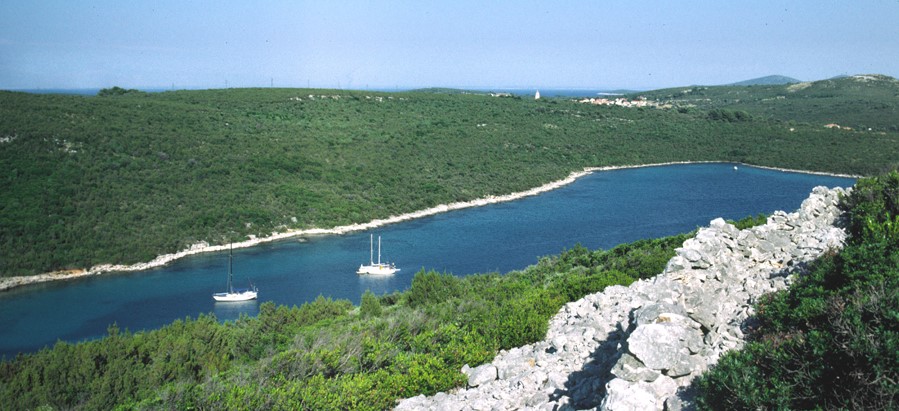 The next stop was at the small island ("Otok") of Scedro, with the deeply indented bay of Luka Levisce. This is a popular place for shelter in bad weather, including the notorious Bora, but there was only one other boat when we arrived, another Australian boat, two years out via Suez. We anchored in the south-east corner. There was nothing ashore except deep green scrubland.
The next stop was at the small island ("Otok") of Scedro, with the deeply indented bay of Luka Levisce. This is a popular place for shelter in bad weather, including the notorious Bora, but there was only one other boat when we arrived, another Australian boat, two years out via Suez. We anchored in the south-east corner. There was nothing ashore except deep green scrubland.
We left the next morning and pressed on to the north. We knew that we would be coming down this same coast on our way back out of the Adriatic later in the summer, and at this stage we were anxious to get to Venice before the worst of the tourist rush. We had a fast sail past Hvar, to which we knew we would return, and turned north towards the gap between Solta and Brac, aiming ultimately to Split.
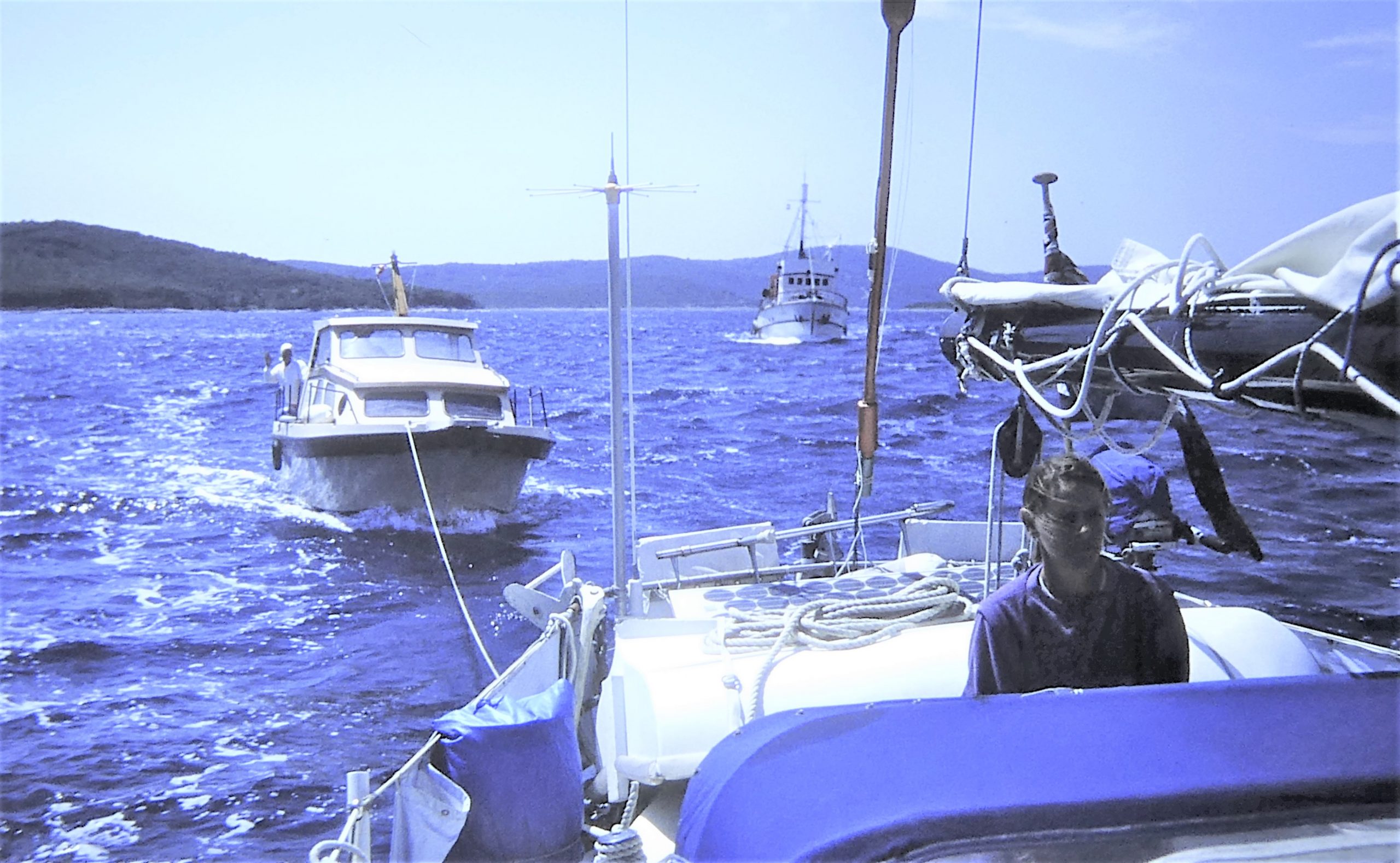 In the early afternoon, in the best sail we had had for ages, we were waved down by folk in a cabin cruiser that was wallowing in the choppy sea. They were seeking help, their engine having given up, and they had been waving for help for four hours. They thought they were done for, as they were gradually being blown down on a very steep and rocky shore. I called the marina at Milna by radio, but got no reply. So we dropped all sails and took them in tow to the big new ACY marina at Milna, deep in a bay at the west end of Otok Brac.
In the early afternoon, in the best sail we had had for ages, we were waved down by folk in a cabin cruiser that was wallowing in the choppy sea. They were seeking help, their engine having given up, and they had been waving for help for four hours. They thought they were done for, as they were gradually being blown down on a very steep and rocky shore. I called the marina at Milna by radio, but got no reply. So we dropped all sails and took them in tow to the big new ACY marina at Milna, deep in a bay at the west end of Otok Brac.
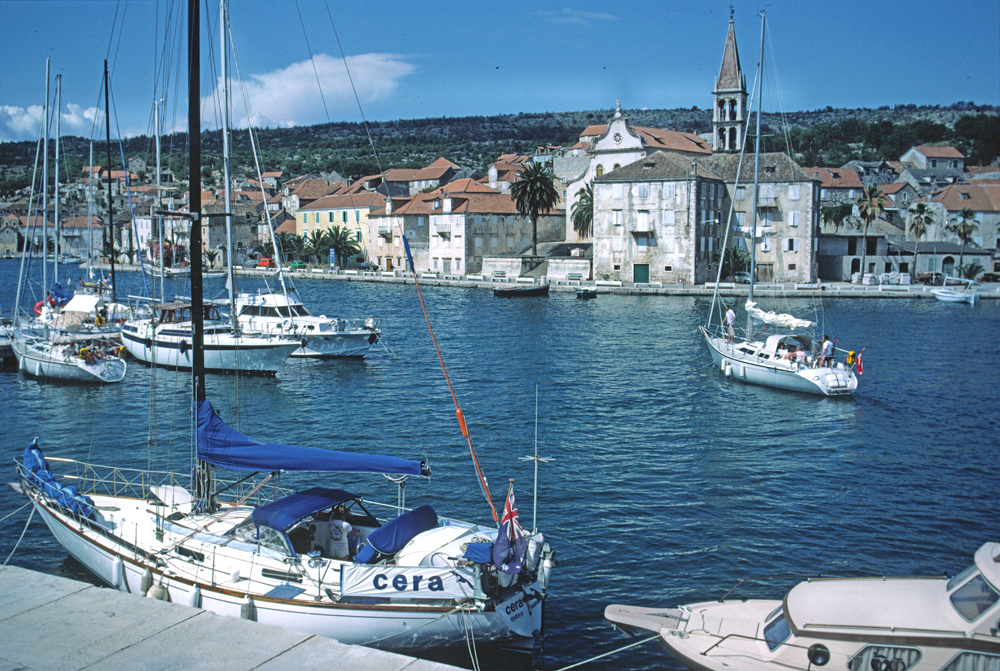 The German couple on the motorboat, which they had chartered out of Zadar, were extremely grateful! They were happy to pay for us to stay at the marina, so we tied alongside the main wharf and quickly got into tasks such as filling the water tanks, doing the washing and the like. We walked around the little town, with a particularly attractive church with a Venetian-style campanile.
The German couple on the motorboat, which they had chartered out of Zadar, were extremely grateful! They were happy to pay for us to stay at the marina, so we tied alongside the main wharf and quickly got into tasks such as filling the water tanks, doing the washing and the like. We walked around the little town, with a particularly attractive church with a Venetian-style campanile. 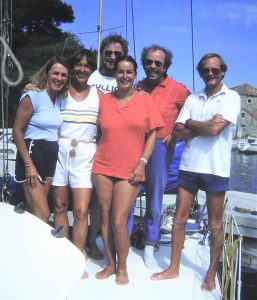 In the evening Boris and Edith, the German couple, took us out for dinner at the marina restaurant along with another German pair on a cruising yacht. It was good fun, with Boris gradually relaxing!
In the evening Boris and Edith, the German couple, took us out for dinner at the marina restaurant along with another German pair on a cruising yacht. It was good fun, with Boris gradually relaxing!
The meal was our first encounter with Yugoslav wine, a Brac red, which we thought was superb. We came to like the country's wine very much. The food at the marina we found later in the country was typical: pieces of meat - usually lamb, which we came to call "lambits" - with salad, simple but perfectly acceptable and very good value.
Other foods we were finding good in Yugoslavia were for example honey and bottled fruits. Small shops sold a wide variety of goods. The people were invariably cheerful and charming, with most of them speaking at least some English.
We got a late start the next day, after some shopping, and sailed in light airs up past more islands and the town of Primosten and into an area studded with long, stony islands. We anchored in a popular and well-protected bay, Uvala Potkucina in Otok Kakan. We were surrounded by steep hillsides, stones everywhere and plots separated by 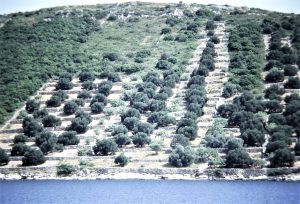 stone terraces - we couldn't see enough soil to grow anything!
stone terraces - we couldn't see enough soil to grow anything!
It rained overnight and then, pressing on still, under cloudy skies and squally showers, we mostly motored up through the channels between the low, stony elongated islands of the Kornati group, the whole area being a National Park. We came to anchor in the northern bay in Otok Ist, Uvala Kosiraca, in a very pretty location, with yellow flowers growing amid green scrub. A chapel sat high on the hill. Sheep were wandering around, their bells ringing. This had been another quite long day's run.
We stayed put the next day, to do some work on a leaking engine water pump. For the first time on this coast we swam, mainly to clean the propeller; the water was still pretty cold! After that short stop we were off motoring again, this time to Luka Balvanida on Otok Losinj. We anchored in the middle of the bay, rather open to the west, and took a stern line ashore to the north side. We took a walk to nowhere, passing a few deserted and ruined farmhouses, more stone walls, unhappy fruit trees and herb gardens. With interest, we also observed millions of caterpillars, which explained the many butterflies that had been fluttering around the boat.
Sailing the following day we noticed that the yacht population was building up, as the holiday season was getting going. The nationalities were predominantly Austrian, German and Italian. We had a quite pleasant beat up to the north against a northerly sea breeze, and in the early evening took an unplanned diversion to Luka (or Uvala) Paltana, an almost totally enclosed basin near the southern tip of the Istrian peninsula. It indents the mainland and is reached through a narrow channel, with a military base along one side. We anchored by ourselves in shallow mud off a dormant-looking fish factory. We woke to a beautiful, calm, clear morning, and motored a short way up to Pula, rounding a long breakwater into the wide channel winding into the harbour and to the new ACY marina there. Like the one we had visited at Milna, the ACY marinas were a new chain being publicly funded to encourage yacht tourism, which the government could see was promising to be very remunerative.
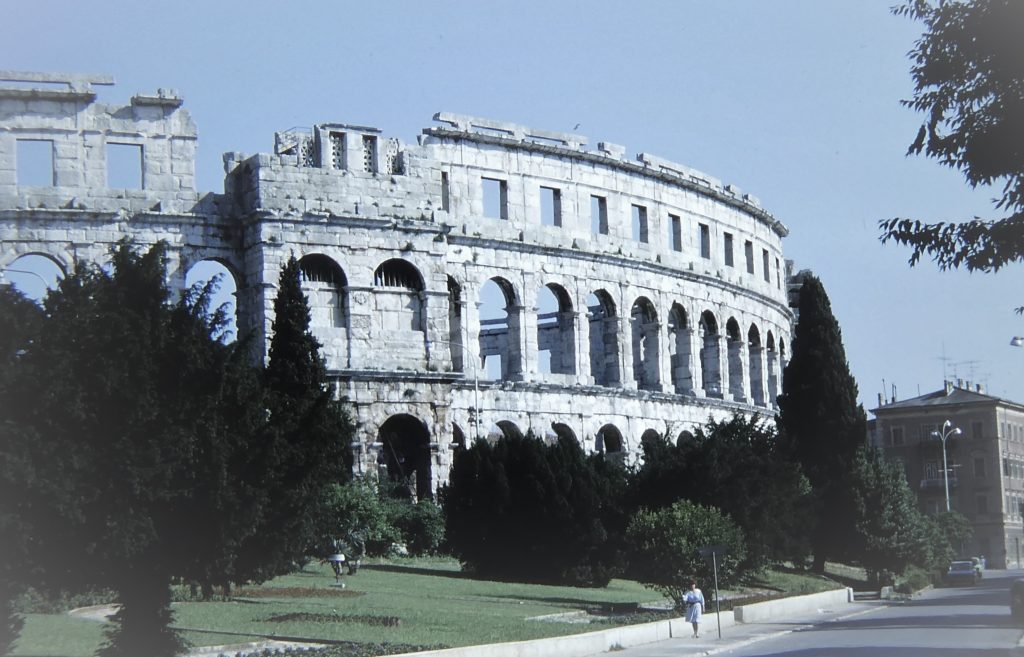 Pula boasts a tremendous Roman amphitheatre, which was overlooking the boat where we lay. The town was scattered with Roman remains including monuments, statues, columns and walls. We got friendly with a British couple skippering an American Swan 57 out for charter - with no customers they took us for a short excursion in their car. This included an effort - unsuccessful - to fill our gas bottles, for which we needed adaptors that were being very hard to find.
Pula boasts a tremendous Roman amphitheatre, which was overlooking the boat where we lay. The town was scattered with Roman remains including monuments, statues, columns and walls. We got friendly with a British couple skippering an American Swan 57 out for charter - with no customers they took us for a short excursion in their car. This included an effort - unsuccessful - to fill our gas bottles, for which we needed adaptors that were being very hard to find.
We had a sociable couple of nights at Pula, and then worked out way up the Lazanski Kanal between the Brioni Islands and the mainland. Landing on the Brionis was prohibited; they had been the haunt of the late President of Yugoslavia Josep Broz Tito, who had established herds of deer which we could see grazing on the trim green lawns sweeping down to the water from trees partly hiding official-looking columned buildings. In 1956 Tito had met there with Nasser and Nehru to create the foundations for the non-aligned movement in opposition to the Cold War.
After a good fast sail for a change we anchored on the east side of Otok Sv Nikola, in the harbour at Porec, near a smart new hotel. We walked round the hotel complex and the island for the rest of the windy day.
Porec, on the mainland, was an attractive little town, retaining its original Roman layout and remains of its Roman wall. The Byzantine basilica still had parts of the original mosaic floor and retained outstanding mosaics around the altar. We watched an astonishing juggling display by a gelato vendor, and bought a lovely little oil-behind-glass painting for the aft cabin.
Venice, Italy
The weather went through a short wet period, but after a couple of nights we left on Sunday 28 June 1986 in a clear blue morning and a building nor-easter to cross the 25 nautical miles due west over the Adriatic to Venice. The wind died by mid-day, but shortly afterwards we were approaching the outer breakwaters for the Venetian lagoon. The visibility became very poor, and  we could only see the land and channel markers with difficulty. Entering the main channel on a Sunday we encountered scores of local runabouts, many resting on sand banks or tied to pilings off the channel. Further navigational complications were raised by ferries, day-trip boats and the occasional ship.
we could only see the land and channel markers with difficulty. Entering the main channel on a Sunday we encountered scores of local runabouts, many resting on sand banks or tied to pilings off the channel. Further navigational complications were raised by ferries, day-trip boats and the occasional ship.
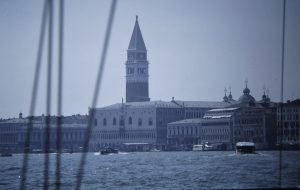 As we moved further into the lagoon the air cleared but the channels in the lagoon were still not easy to discern; there was the multitude of markers, the absence of a detailed guide or chart, and massive ferry traffic. Nevertheless we found eventually found ourselves at the eastern end of the Canale della Guidecca and in sight of the Palazzo Ducale (Doge's Palace) and the Piazza San Marco. This was a staggering view that a few years previously we could never have dreamt we would ever see from the deck of our own yacht, our dearly-loved Cera. Sailing into the Venice lagoon had become over more recent years a major target for our whole voyaging experience, and we felt proud of the achievement.
As we moved further into the lagoon the air cleared but the channels in the lagoon were still not easy to discern; there was the multitude of markers, the absence of a detailed guide or chart, and massive ferry traffic. Nevertheless we found eventually found ourselves at the eastern end of the Canale della Guidecca and in sight of the Palazzo Ducale (Doge's Palace) and the Piazza San Marco. This was a staggering view that a few years previously we could never have dreamt we would ever see from the deck of our own yacht, our dearly-loved Cera. Sailing into the Venice lagoon had become over more recent years a major target for our whole voyaging experience, and we felt proud of the achievement.
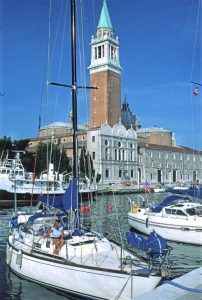 However, a more immediate difficulty was to find somewhere to moor. We were drifting just off the Isola San Giorgio Maggiore, which we already knew housed a substantial marina. We also knew it was private, and not open to cruising yachts. We could see only a few boats in it, and two of them had Italian courtesy flags flying from their masts, showing that they must be visitors. We shouted across to the American skipper of one of them (chartered locally), "is this place open?" "Well, it is at present", he replied. So we motored in, and moored bow-to to the outer wall of the marina. From the boat we were facing straight across the Guidecca to one of the most iconic sights in the world, the complex of historic buildings around the Piazza San Marco. We could hardly believe it.
However, a more immediate difficulty was to find somewhere to moor. We were drifting just off the Isola San Giorgio Maggiore, which we already knew housed a substantial marina. We also knew it was private, and not open to cruising yachts. We could see only a few boats in it, and two of them had Italian courtesy flags flying from their masts, showing that they must be visitors. We shouted across to the American skipper of one of them (chartered locally), "is this place open?" "Well, it is at present", he replied. So we motored in, and moored bow-to to the outer wall of the marina. From the boat we were facing straight across the Guidecca to one of the most iconic sights in the world, the complex of historic buildings around the Piazza San Marco. We could hardly believe it.
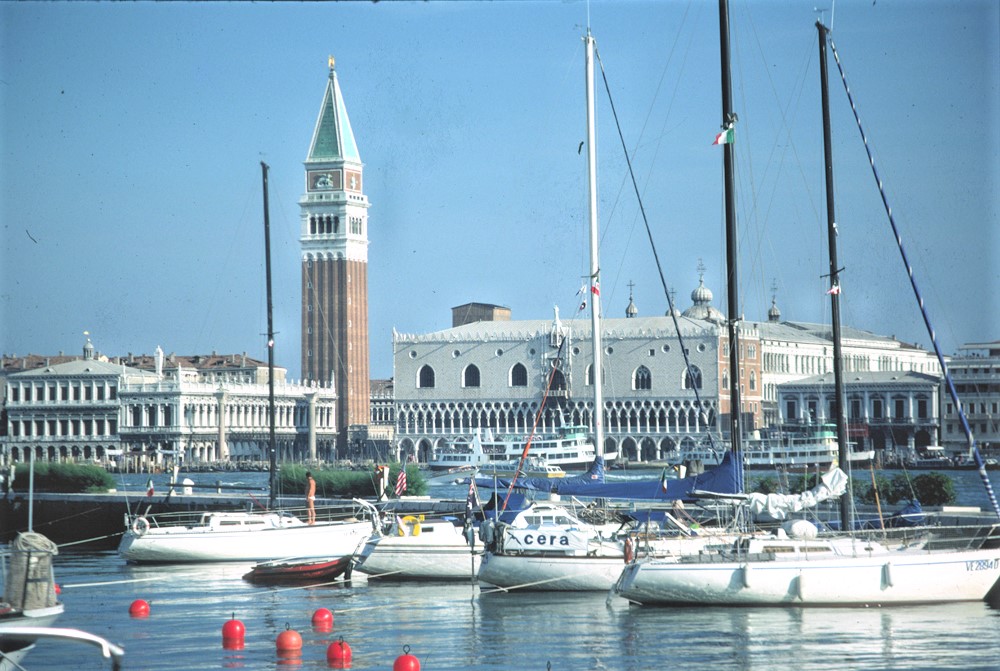
We soon found out that the marina was being refurbished; we could stay this Sunday night, but would have to move out tomorrow. For us, even the one night was an unexpected privilege.
But after this glamorous short stay we had to move to somewhere else. As everyone knows, Venice - the capital of northern Italy’s Veneto region - is built on more than 100 small islands in a lagoon at the north-west end of the Adriatic Sea. It has few roads on these islands, just canals. Through the biggest and most important island, supporting the city of Venice, runs the Grand Canal, which is lined with Renaissance and Gothic palaces. The central square, Piazza San Marco, contains St. Mark’s Basilica and the Campanile bell tower. To reach where we now lay we had entered the lagoon through a canal between a finger of the mainland and a long island extending southwards, the Lido di Venezia. To the north of the main island scores of small islands are scattered over a wide, shallow part of the lagoon, extending up over some 15 kilometres. A less populated area of the lagoon extends to the southwards about 25 km.
We motored out with the intention of going down west down the Guidecca canal to the western end of the main island of Venice. The limited information we had available told us that the only place to take a yacht was the Porto Turistico, a marina by a large car park. However, it had a bad reputation in regard to dirt, noise and security.
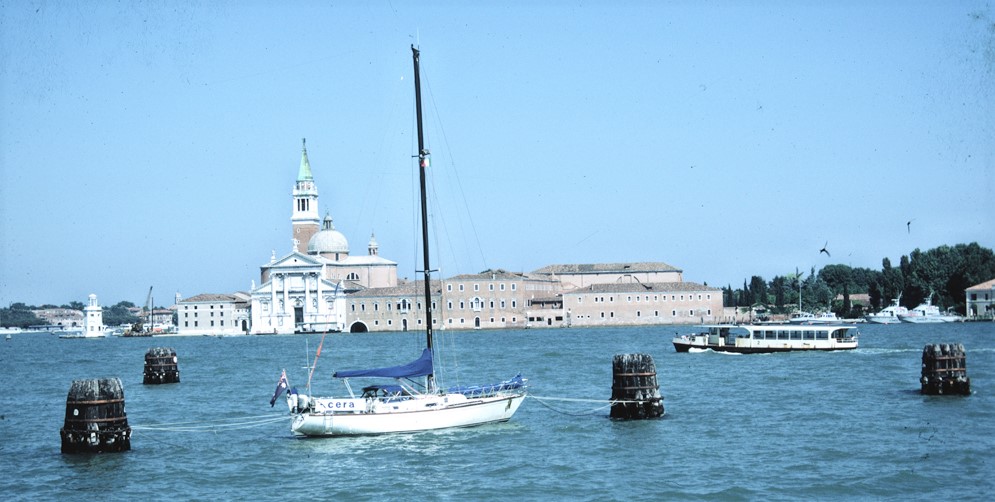
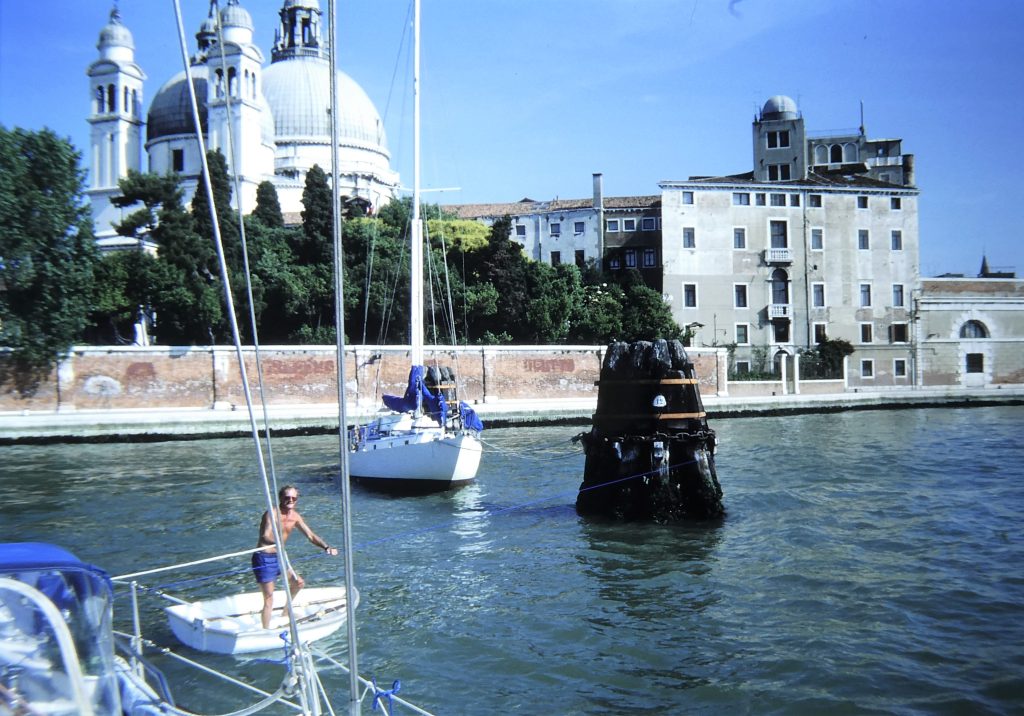 As we motored out of the San Giorgio marina we could see a yacht tied between pilings just off the Punta della Dogana (the old customs point, where stands the magnificent Basilica di Santa Maria della Salute). We went over, and recognised that the boat was an Australian one that we had met briefly a short time ago. We shouted across, "what's it like here?" "It's OK", they replied. We already knew that the pilings were - in theory - open for anyone, and tying up to them was free, but had thought they were too exposed and vulnerable to rough water for yachts, rather than megayachts and small ships.
As we motored out of the San Giorgio marina we could see a yacht tied between pilings just off the Punta della Dogana (the old customs point, where stands the magnificent Basilica di Santa Maria della Salute). We went over, and recognised that the boat was an Australian one that we had met briefly a short time ago. We shouted across, "what's it like here?" "It's OK", they replied. We already knew that the pilings were - in theory - open for anyone, and tying up to them was free, but had thought they were too exposed and vulnerable to rough water for yachts, rather than megayachts and small ships.
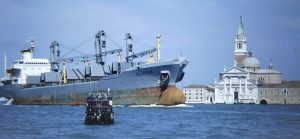 But we took them at their word, and with great difficulty we managed to rope ourselves bow and stern between a pair of pilings, facing into the Guidecca in an attempt to minimise the effect of wakes from passing vessels. There was obviously going to be some surge, so we backed up the rope with lengths of anchor chain. It took the best part of a day to make ourselves as secure as possible.
But we took them at their word, and with great difficulty we managed to rope ourselves bow and stern between a pair of pilings, facing into the Guidecca in an attempt to minimise the effect of wakes from passing vessels. There was obviously going to be some surge, so we backed up the rope with lengths of anchor chain. It took the best part of a day to make ourselves as secure as possible.
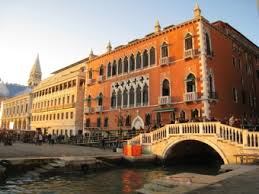 We got a call on the radio from George, the American we had met on the marina, who thanked us for some simple medical advice and invited us to join him and his family for dinner at a restaurant adjoining to the Danieli hotel, where his daughter was staying. This was too good to refuse, so we went ashore by dinghy at a nearby rowing club pontoon. From there we walked round the point, then along the Grand Canal, crossed over the Ponte dell'Accademia and walked east through St Mark's square to the Danieli on the waterfront just past the Doge's palace. It was a big group of family and young friends, and the dinner must have cost a fortune! We were very grateful, after a hard and busy day. The restaurant was the Trattoria do Forni - acceptable food but not brilliant, touristy, but we had a great time. It was a late walk back to the boat, boarding at around 1:00 am.
We got a call on the radio from George, the American we had met on the marina, who thanked us for some simple medical advice and invited us to join him and his family for dinner at a restaurant adjoining to the Danieli hotel, where his daughter was staying. This was too good to refuse, so we went ashore by dinghy at a nearby rowing club pontoon. From there we walked round the point, then along the Grand Canal, crossed over the Ponte dell'Accademia and walked east through St Mark's square to the Danieli on the waterfront just past the Doge's palace. It was a big group of family and young friends, and the dinner must have cost a fortune! We were very grateful, after a hard and busy day. The restaurant was the Trattoria do Forni - acceptable food but not brilliant, touristy, but we had a great time. It was a late walk back to the boat, boarding at around 1:00 am.
It was then a restless night, with the "anchorage" not calming down as much as we had hoped. And during the day it became very choppy indeed, with passing ships (on their way down to the ship canals to the south), tugs, ferries, vaporettos, taxis (very bad wakes!), delivery vessels, garbage boats, postal boats and official boats of one kind and another, also particularly bad with their wakes, coming from both sides where we lay.
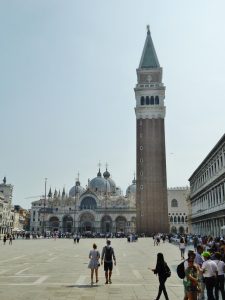 We ventured ashore again and took the same route back to St Mark's and the Amex office for mail and money. We then navigated ourselves through a maze of narrow Venetian alleys and along the waterfront and crossed a canal to the island of St Elena, the eastern extremity of the main urban Venice complex. We had learnt that there was a marina there, but that it was another private yacht club and not open to visitors. We thought to give it a try, and were told by the manager that a marina berth for us "might be possible" and to come back and see when we were ready. We took the vaporetto back to the Accademia and bought some food for the boat. It was very hot by then, over 90 degrees F in the cabin.
We ventured ashore again and took the same route back to St Mark's and the Amex office for mail and money. We then navigated ourselves through a maze of narrow Venetian alleys and along the waterfront and crossed a canal to the island of St Elena, the eastern extremity of the main urban Venice complex. We had learnt that there was a marina there, but that it was another private yacht club and not open to visitors. We thought to give it a try, and were told by the manager that a marina berth for us "might be possible" and to come back and see when we were ready. We took the vaporetto back to the Accademia and bought some food for the boat. It was very hot by then, over 90 degrees F in the cabin.
The view from our berth was still as spectacular as ever, but just as uncomfortable! In the sunset of a beautiful evening the facades of the churches lost their three-dimensional appearance and looked like enormous paintings, placed all around us for our appreciation. A fine, warm morning followed, but the boat was being thrown around again and as Norma staggered up the companionway to the cockpit she gasped, "I don't think I can take this any more!"
It took a while to undo the ropes and chains, but by mid-day we were off and motoring slowly against the tide to the east and the Isola di Sant'Elena, where we cautiously entered the marina of the club Diporto Velico. We were welcomed again by the marina manager, paid for five days and just squeezed in between some piles. It was hot and not nearly as beautiful as where we'd been, but, as I recorded in the log, were now in "blessed peace and quiet!" In the hot sun we quickly deployed the full awning and hoisted our Boxing Kangaroo flag.
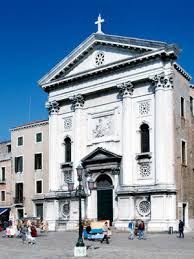 A rather scruffy steel yacht then pulled in, carrying an Australian flag, owned by Jim, an American and Judy (Australian), bought in Greece. They had been accepted in but were not popular with the manager, not having having made any attempt to seek permission or make a booking. In the evening we had planned to attend a Vivaldi concert at "his" church, the Chiesa della Pieta, Santa Maria della Visitazione. This was the kind of attraction in Venice to which we had long looked forward, but this couple insisted on tagging along despite any interest in music. However, in true Italian style the concert had been cancelled, so after waiting for a while along with other disappointed patrons we had an expensive beer on the waterfront instead.
A rather scruffy steel yacht then pulled in, carrying an Australian flag, owned by Jim, an American and Judy (Australian), bought in Greece. They had been accepted in but were not popular with the manager, not having having made any attempt to seek permission or make a booking. In the evening we had planned to attend a Vivaldi concert at "his" church, the Chiesa della Pieta, Santa Maria della Visitazione. This was the kind of attraction in Venice to which we had long looked forward, but this couple insisted on tagging along despite any interest in music. However, in true Italian style the concert had been cancelled, so after waiting for a while along with other disappointed patrons we had an expensive beer on the waterfront instead.
Then came a big tourist day. First, we took the vaporetto to the other end of the Grand Canal and the Piazzale Roma vaporetto, bus and car terminal. The marina we had been originally aiming for was also there, and we went to have a look at this Porto Turistico. It was an absolutely horrible-looking place, noisy and open to wakes to boot. It was in full view of smoky Mestre, on the Italian mainland as well as the bus park and industrial buildings. There was nothing that represented real Venice.
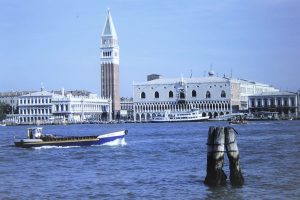 We walked back through the fish and food market area on the bank of the Grand Canal and then into the areas well known to tourists. We visited the Doge's Palace, of staggering magnificence: hundreds of statues and other artefacts taken from Constantinople, marble stairs, brilliant golden ceilings. The walls were hung with countless huge paintings, featuring Tintoretto and Veronese unsurprisingly. There were eery echos of autocratic rule in a letter box for denunciations, and the Bridge of Sighs across to the prisons.
We walked back through the fish and food market area on the bank of the Grand Canal and then into the areas well known to tourists. We visited the Doge's Palace, of staggering magnificence: hundreds of statues and other artefacts taken from Constantinople, marble stairs, brilliant golden ceilings. The walls were hung with countless huge paintings, featuring Tintoretto and Veronese unsurprisingly. There were eery echos of autocratic rule in a letter box for denunciations, and the Bridge of Sighs across to the prisons.
We walked back to the marina via the commercial Via Garibaldi, the main shopping street in eastern Venice, and a region where "real" Venetians live. Barges were pulled up in the small canals, unloading produce.
There was a violent thunderstorm early next morning, a relief from hot and humid days, and we gave the boat a good clean. More walking and visits then, first to the nearby maritime museum and Arsenal, where we learnt more about the early days of sea battles in the eastern Mediterranean. It was then back through lanes for a visit to the Basilica San Marco, an extraordinary blend of western and eastern religious art and architecture. Beautiful mosaics lined the domes, but were hard to see in the gloomy interior.
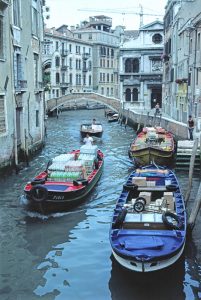 As all visitors to Venice do, we wondered how the place was still standing after all these years. It sits on a marshy base that was packed by wooden piles reinforced by stones. While the buildings were surviving many of the facades were crumbling, especially in areas outside the tourist beat. In the smaller side canals many windows and doors were shuttered, and water was lapping against rusty water gates. The pollution from industrial Mestre was rotting the old stone buildings.
As all visitors to Venice do, we wondered how the place was still standing after all these years. It sits on a marshy base that was packed by wooden piles reinforced by stones. While the buildings were surviving many of the facades were crumbling, especially in areas outside the tourist beat. In the smaller side canals many windows and doors were shuttered, and water was lapping against rusty water gates. The pollution from industrial Mestre was rotting the old stone buildings.
We took a motoscafi circular trip round San Giorgio, the San Michele cemetery island, and Murano, the glass-makers' island before taking the regular vaporetto from the Roma terminus back home after another busy tourist day.
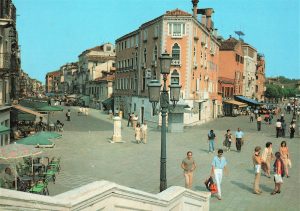 We then spent a quiet day on and around the boat. Norma spent time in "her shopping street", the Via Garibaldi, stocking up with food, and also did some routine washing. We never wasted marina facilities! The area around the marina, as we had already observed, was for normal living, with simple dwellings, pleasant squares and green parks, wide walkways, hundreds of cats - and no cars.
We then spent a quiet day on and around the boat. Norma spent time in "her shopping street", the Via Garibaldi, stocking up with food, and also did some routine washing. We never wasted marina facilities! The area around the marina, as we had already observed, was for normal living, with simple dwellings, pleasant squares and green parks, wide walkways, hundreds of cats - and no cars.
In the evening we went to a lovely little early music concert in the cloistered garden of an adjacent convent, the Chiesa di S Elena. The singing was a capella, mostly madrigals and canzoni, many by Gabrieli and Monteverdi as well as other lesser-known Italian composers. Jim and Judy were there too, and we had drinks aboard afterwards.
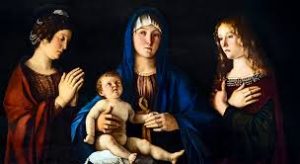
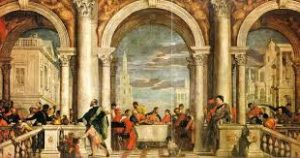
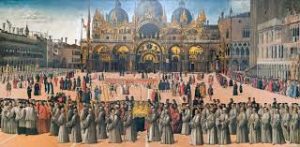 The next day started with another vaporetto ride into the city, and specifically to the Galleria dell'Accademia. This is an astounding gallery of Venetian art of the 14th-18th centuries. Whole rooms are filled with enormous works by such as Tintoretto, Veronese, Carpaccio and many others. To us especially memorable were the Madonna with Mary Magdalene and St Catherine by Giovanni Bellini, the huge Meal in the House of Levi by Veronese, and Gentile Bellini's Procession in St Mark's Square.
The next day started with another vaporetto ride into the city, and specifically to the Galleria dell'Accademia. This is an astounding gallery of Venetian art of the 14th-18th centuries. Whole rooms are filled with enormous works by such as Tintoretto, Veronese, Carpaccio and many others. To us especially memorable were the Madonna with Mary Magdalene and St Catherine by Giovanni Bellini, the huge Meal in the House of Levi by Veronese, and Gentile Bellini's Procession in St Mark's Square.
We took the vaporetto back for lunch, and in the afternoon an air show was centred over the Lido, including stunts by small aerobatic aircraft and a display by the Italian air force team.
We did finally get to a concert in Vivaldi's church, the Pieta. This was by the Cambridge University Consort of Voices, all a capella, and beautifully sung by this young and enthusiastic choir. There were perfect acoustics in this simple and austere (by baroque standards) church.
This was a grand finale to our time in the marina. We had walked the city from end to end and visited many historic sights, but we had decided to leave for a little tour of the islands and canals of the northern lagoon.
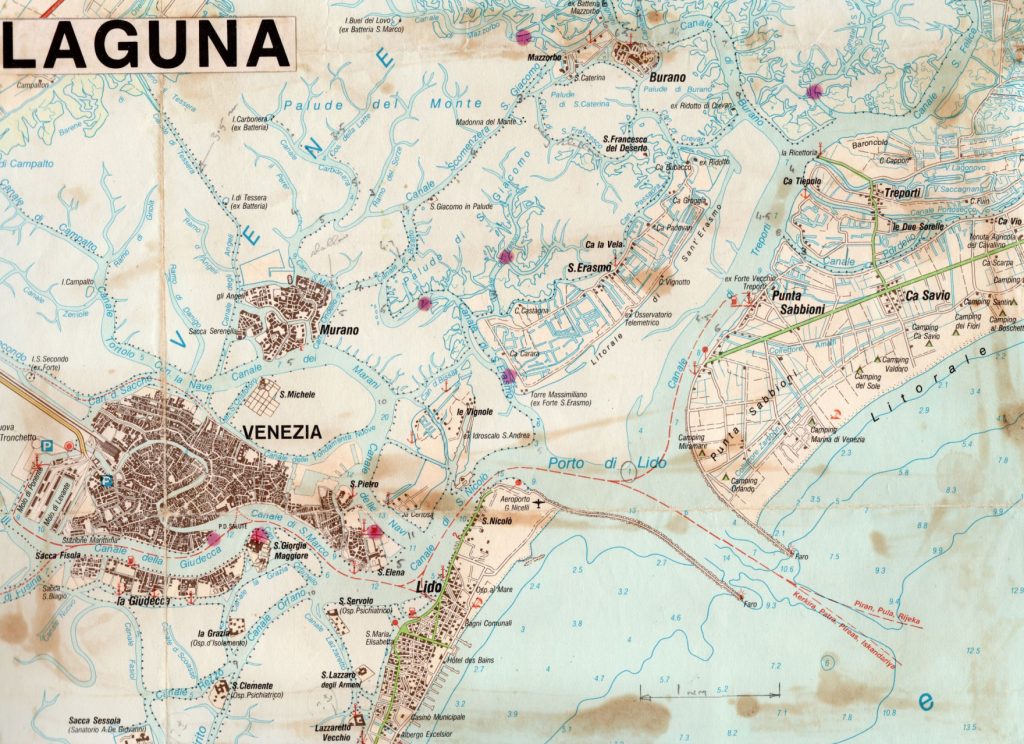 There was no nautical chart of the lagoon and its channels, but we did find a fairly detailed map of the Laguna in a book shop. We could not truly have ventured out without it, because most of the landscape is flat and featureless marshland. Our map did show some depths along the major canals, but we soon found out that these could not be relied on! In the smaller canals we simply explored carefully and slowly, working the tide, and in any case the bottom was always soft mud and offered no real hazards.
There was no nautical chart of the lagoon and its channels, but we did find a fairly detailed map of the Laguna in a book shop. We could not truly have ventured out without it, because most of the landscape is flat and featureless marshland. Our map did show some depths along the major canals, but we soon found out that these could not be relied on! In the smaller canals we simply explored carefully and slowly, working the tide, and in any case the bottom was always soft mud and offered no real hazards.
We started off by going north away from the marina towards Murano, along the Canale dei Marani. This was fine, but we soon went aground venturing round the northern side of the island. We backed out and retreated to a canal leading up to Burano, but deviated into the Canale di S Erasmo and found a lovely anchorage and stopped. There were marshes all around, but Venice and the other major 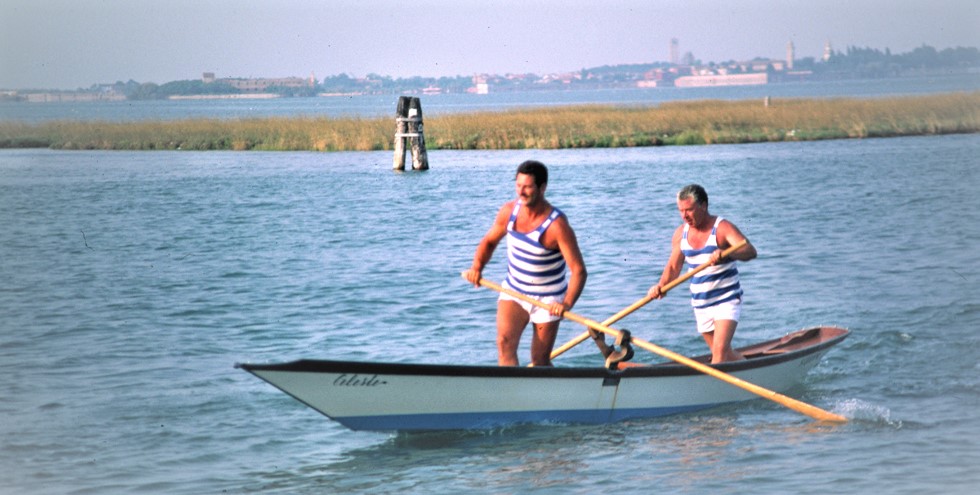 islands were still in sight. This canal was not on a ferry or big-boat route. There were birds aplenty, a few passing runabouts, fishermen and the occasional barge. We watched racing gondolas out for the evening's training session, and a couple of racing oarsmen. It was a beautiful, cloudless day, with a cooling sea breeze coming in through the Lido entrance canal to the south.
islands were still in sight. This canal was not on a ferry or big-boat route. There were birds aplenty, a few passing runabouts, fishermen and the occasional barge. We watched racing gondolas out for the evening's training session, and a couple of racing oarsmen. It was a beautiful, cloudless day, with a cooling sea breeze coming in through the Lido entrance canal to the south.
After a quiet night we took the dinghy back to St Elena island and with it ventured into the canals and under the bridges leading to the commercial area and the end of the Via Guiseppe Garibaldi, Norma's shopping street. From our dinghy we shopped for market goods directly from the boats moored along the canal, the Rio de S Ana. Norma stepped off to get bread and pizza. We ventured along more little canals around the outer walls of the Arsenale.
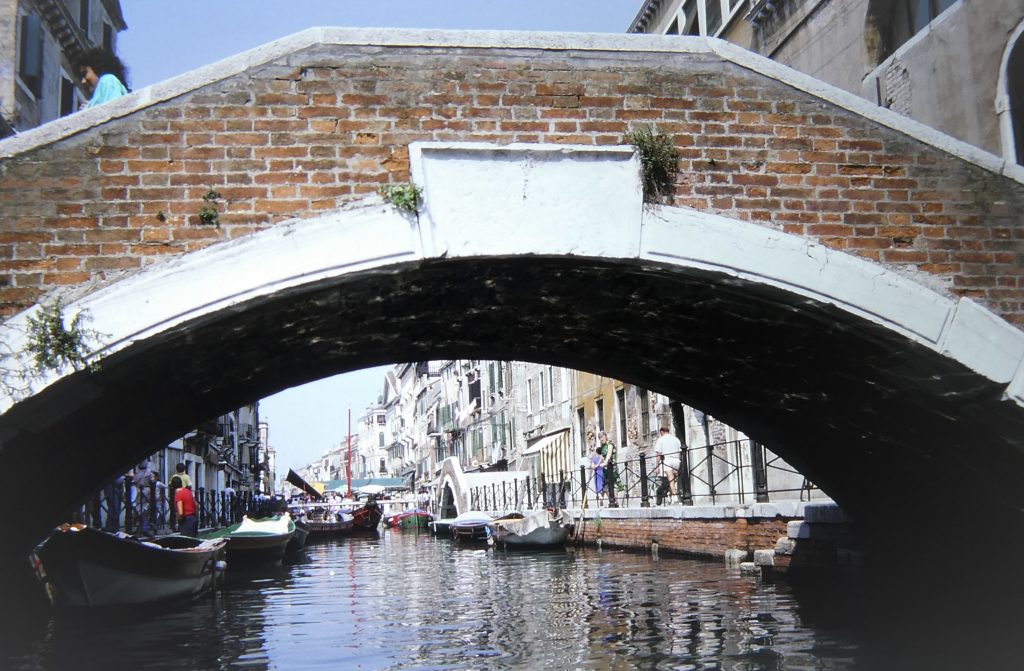 Overnight the weather broke with a vengeance, with heavy rain, lightning and wind. It cleared enough to take the inflatable dinghy back into the marina and a revisit to the S Elena Convent for another concert. This time it was a small youth orchestra playing Corelli, Vivaldi and Bach. Taking the dinghy more than a nautical mile back to the boat in pitch dark was a challenge. We had some difficulty crossing the big channel first, and then identifying the narrow entrance to the small channel where we were anchored. We had the yacht's masthead anchor light on, and we could that clearly all the way from the marina, and we also carried a powerful torch that we could use to see and identify the channels' wooden pylon markers.
Overnight the weather broke with a vengeance, with heavy rain, lightning and wind. It cleared enough to take the inflatable dinghy back into the marina and a revisit to the S Elena Convent for another concert. This time it was a small youth orchestra playing Corelli, Vivaldi and Bach. Taking the dinghy more than a nautical mile back to the boat in pitch dark was a challenge. We had some difficulty crossing the big channel first, and then identifying the narrow entrance to the small channel where we were anchored. We had the yacht's masthead anchor light on, and we could that clearly all the way from the marina, and we also carried a powerful torch that we could use to see and identify the channels' wooden pylon markers.
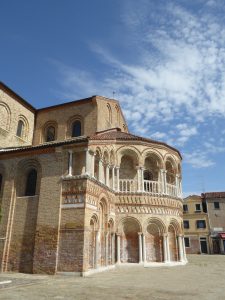 In the morning we took the dinghy to Murano, the "glass island". We went to the heart of the island along the Canal Grande that bisects it and into a secondary canal that passes the lovely 12th century church, the Basilica dei Santa Maria e Donato. Its campanile sat in an attractive plaza. We "parked" on the canal side to explore ashore and visit some glassware shops - mostly too art deco for our taste. Part of the Murano complex was an island specialising in marine engineering, which included what was supposedly a Perkins agent - but which did not hold any of the basic parts we were seeking.
In the morning we took the dinghy to Murano, the "glass island". We went to the heart of the island along the Canal Grande that bisects it and into a secondary canal that passes the lovely 12th century church, the Basilica dei Santa Maria e Donato. Its campanile sat in an attractive plaza. We "parked" on the canal side to explore ashore and visit some glassware shops - mostly too art deco for our taste. Part of the Murano complex was an island specialising in marine engineering, which included what was supposedly a Perkins agent - but which did not hold any of the basic parts we were seeking.
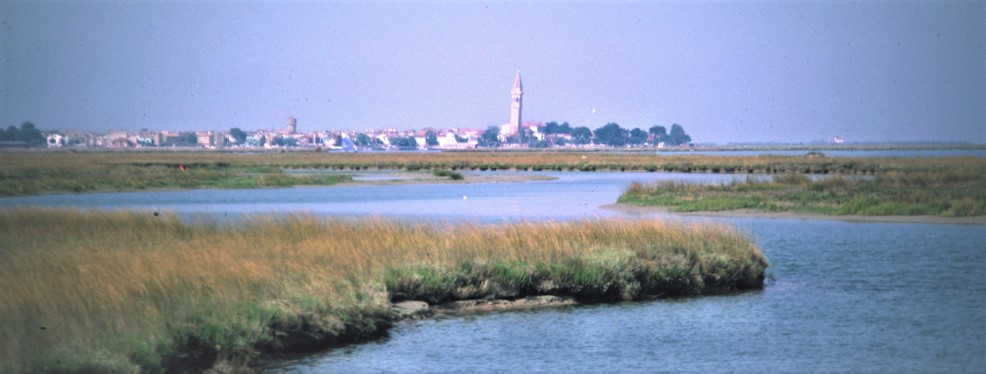 We moved on in the afternoon, not far, to the even smaller and more peaceful creek, the Canale di Tresso. We were only slightly stuck at its entrance! It was a dead end, so there was no passing traffic, just the odd runabout fishing. We anchored fore-and-aft, because it was on the narrow side. We were joined later by a Kiwi boat that we had met in the marina, so it was soon time for evening drinks.
We moved on in the afternoon, not far, to the even smaller and more peaceful creek, the Canale di Tresso. We were only slightly stuck at its entrance! It was a dead end, so there was no passing traffic, just the odd runabout fishing. We anchored fore-and-aft, because it was on the narrow side. We were joined later by a Kiwi boat that we had met in the marina, so it was soon time for evening drinks.
After three nights we cautiously groped our way out, and then motored up the Canale San 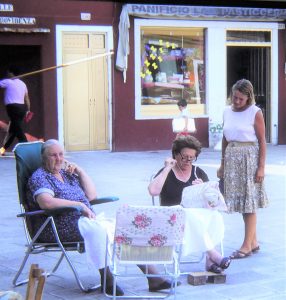
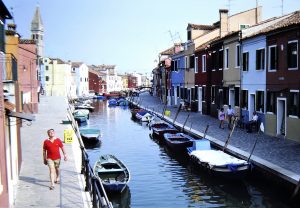 Giacomo to Mazzorbo and Burano, anchoring at the outer end of the Canale Mazzorbo, out of the way of multiple ferries.
Giacomo to Mazzorbo and Burano, anchoring at the outer end of the Canale Mazzorbo, out of the way of multiple ferries.
We took the dinghy to Burano and tied up in the fishing gondola harbour. The island is justly famous for the pastel-painted houses that pack the tight space of the island. There were lots of tiny canals weaving through the island, wooden bridges and tourists. In the plazas ladies were sitting in their doorways making the lace that is another of the island's attractions. Alongside the 16th century church of San Martino in the main square is another famous landmark, the (quite alarming) leaning campanile.
It was a hot and humid evening. Mosquitoes were becoming a problem in the later hours, but did not seem particularly aggressive.
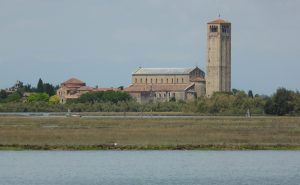
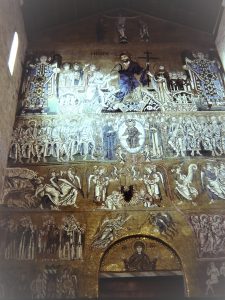 We then took the dinghy to Torcello, the site of the original settlement in the Venetian lagoons but which was in decline by the 9th century. We tied up by Cipriani's restaurant, Hemingway's original "Harry's Bar", and walked over a grassy piazza past sellers of lace and souvenirs to the cathedral and its adjacent campanile.
We then took the dinghy to Torcello, the site of the original settlement in the Venetian lagoons but which was in decline by the 9th century. We tied up by Cipriani's restaurant, Hemingway's original "Harry's Bar", and walked over a grassy piazza past sellers of lace and souvenirs to the cathedral and its adjacent campanile.
The Torcello Basilica did not strike us as particularly impressive on our approach, but inside it boasted some lovely features including an immense mosaic of the Day of Judgement on the west wall. We were shown round by an exceptional guide, a retired professor of ecclesiastical history. We thought we could do with him all the time, but the amount of information we were absorbing was already overwhelming. We met an English couple, both retired doctors from Hereford; they were good company, and we took them to Burano and back to the boat for lunch. In the evening we watched fishermen  set nets, using genuine working gondolas. Before bed we completely blocked up the boat against mosquitos.
set nets, using genuine working gondolas. Before bed we completely blocked up the boat against mosquitos.
Which was just as well. We woke to see the boat's exterior blackened by a seething mass of bugs, with Norma counting several hundreds on each cabin window. It was an eery spectacle, but again, they did not seem that aggressive - we concluded that some sort of mass hatching had occurred. Emerging cautiously we boarded the dinghy, which we took to Mazzorbo to catch the ferry to Venice. We needed to check for mail and call the BMA for an update on the status of the first printed copies of my book.
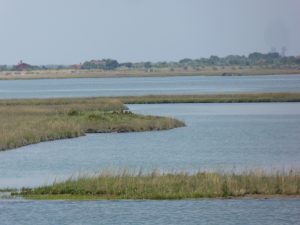 On return we were still in mosquito plague mode, so moved out in search of a more exposed and windy location. We worked our way past Burano and down the Canale de Burano to nearer the sea, turning up the wide Canale di Treporti and anchoring in the Canale S Lorenzo e Gaggio just off it to the west. A good sea breeze did arrive, and we spent the rest of the day washing off dead and dying mosquitos.
On return we were still in mosquito plague mode, so moved out in search of a more exposed and windy location. We worked our way past Burano and down the Canale de Burano to nearer the sea, turning up the wide Canale di Treporti and anchoring in the Canale S Lorenzo e Gaggio just off it to the west. A good sea breeze did arrive, and we spent the rest of the day washing off dead and dying mosquitos.
We took the dinghy across the Treporti canal to the eponymous town, which we found to be a good place for shopping. It is on the mainland, on the peninsula that forms the eastern barrier for the northern Venetian lagoon, with a substantial population and many campers. We did a loop around several little urban canals before crossing the Treporti canal back to the boat.
After a couple of nights we took a ferry back to Venice to pick up some mail, which Amex told us was waiting for clearance at the airport. We finally were able to hold the first printed copies of "Living with Risk" - the work of the winter - in our hands. We then moved down the Treporti and back to our favourite anchorage in the Canale di Tresso. The weekend was the Festa del Redentore, which we had intended to visit by taking the dinghy into Venice, but the weather was poor - so we stayed up late and watched the fireworks over San Marco from the deck of the boat. On the Sunday we did take the dinghy in to the S Elena marina and walked into the city - we hoped to catch the gondola races, but only saw lots of tourists.
When at the marina we chatted to the Italian skipper of a yacht we had lain aside when we were there. He asked where we had been, and was astonished when we told him we had been cruising the outer lagoon. He had never heard before of anyone doing that in a yacht, he said - let alone Italians!
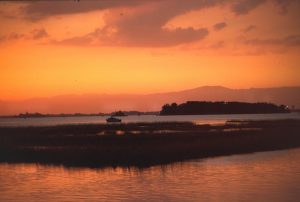 Later that day the weather suddenly cleared, and all of a sudden the Dolomite Alps dramatically became visible to the north and north-west. We enjoyed a beautiful sunset.
Later that day the weather suddenly cleared, and all of a sudden the Dolomite Alps dramatically became visible to the north and north-west. We enjoyed a beautiful sunset.
Preparing at last to leave Venice, we moved out from our peaceful but shallow little anchorage to the southern end of the Canale di S Erasmo, from where we could see the main entrance canal leading out to the Adriatic. Still very much a holiday weekend, we watched runabouts, runabouts and runabouts . . . Venice at play.
On Tuesday July 21, three weeks after arriving, we left the Venetian lagoon and motored out between the long breakwaters into the Adriatic Sea, initially motoring in very light airs back to Yugoslavia.
Back to the Croatian Coast, Yugoslavia
Starting our day's passage across to Vrsar, Yugoslavia, we had to motor for a while but were able to set our lightweight headsail , with a wind backing to the SSE. As a small excitement, we spotted an inflatable dinghy apparently adrift and unoccupied. We sailed over for a check that all was OK, but observed only a couple of naked people lying on the floorboards, apparently perfectly healthy and happy . . .
In the later afternoon we anchored in the middle of the very busy harbour of Vrsar. Runabouts and cruise boats were all around, and we observed for the first time that the wearing of clothes in high summer was an optional matter for most holiday-makers, especially Germans. The town looked quite attractive from the anchorage, with red-roofed dwellings ranging up the hillside, which was topped by the church's campanile.
We dived to finish cleaning the underwater hull of Venetian slime, and Norma removed from the propeller a large ball of weed. We had drinks aboard a British ketch, and listened to a noisy disco into the late hours. We had a look around in the morning and walked up through the old town, very original and basic. We shopped in the adequate supermarket.
Preparing to leave, we were approached by the British couple, who could not start their yacht's engine. We agreed that it was likely to be a problem with the starter motor. They requested a tow to nearby Rovinj, where they thought they could get it fixed. Their engine was terribly inaccessible, and probably needed lifting to fix the problem. Back in saviour mode we hitched them up and towed them out of the harbour, around the off-lying shoals, and to Rovinj, about three nautical miles to the south.
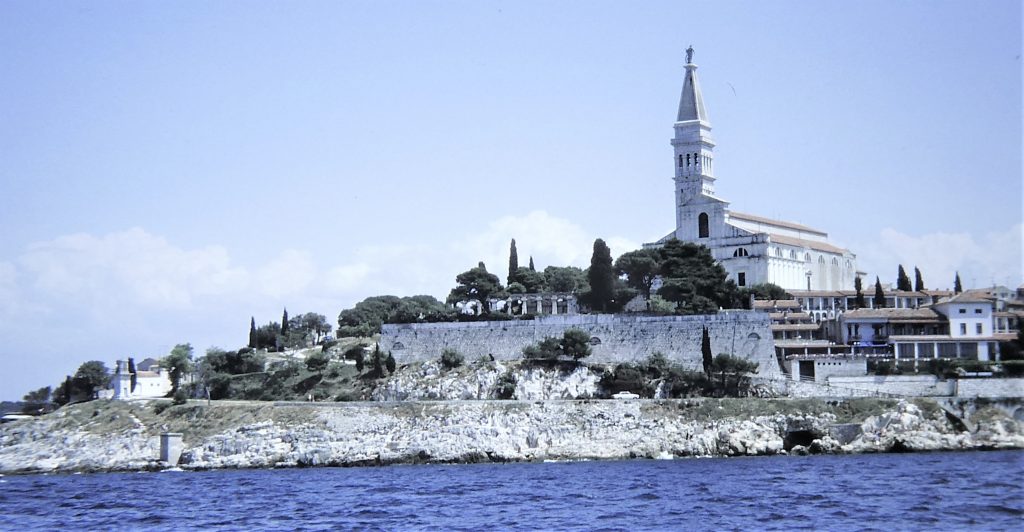 Rovinj looked lovely, with its huge church beautifully sited on a hill in the centre of the old town on a little peninsula. Soaring into the sky was its highly impressive Venetian-style campanile. We dropped off our tow at the ACY marina, and continued on our way south.
Rovinj looked lovely, with its huge church beautifully sited on a hill in the centre of the old town on a little peninsula. Soaring into the sky was its highly impressive Venetian-style campanile. We dropped off our tow at the ACY marina, and continued on our way south.
We were soon sailing in a reasonable westerly, under the spinnaker, but by mid-afternoon we had to revert to power, Adriatic style. We passed Pula and four miles further came to anchor in what looked like the well-protected and almost land-locked inlet, Uvala Kanalic. It was very busy, with about 70 other boats in the bay. Nevertheless it was peaceful, with no cruise boats around, and we were surrounded by heavily-wooded shore.
It was lovely weather all the next day, and we took the dinghy a short way out to sea and up the coast to an enormous camp site, where we understood we would be able to fill our gas bottles. To our pleasure this did work out, with our connection adapters and those of the helpful attendant enabling the fill of both our British and Australian bottles. In a beautiful evening we did a little more cleaning of the underside in clear water. After a peaceful night we walked over the nearby hills to the village of Veruda, where we did some limited shopping. On the way we traversed narrow country roads, passed lots of little dwellings and guest houses, and smallholdings with lush growth.
After an overnight hot southerly (the Scirocco) we moved on south, with clouds increasing and wind decreasing, leaving a rotten slop and underlying swell. We had a look at several possible anchorages down the long island of Mali Losinj, including Balvanida, which we had stayed in on our way up. But all were being affected by the southerly swell, and we ended up in Luka Ilovic, which appeared (and reported in the cruising guide) to be a well protected slot between the islands of Otok Ilovic and Otocic Sv Petar. We anchored on the east side of the slot, under a castle on the hillside. In calm water it was again very popular and packed with boats of all sizes. It was very hot and cloudy.
The next day started in similar conditions, with some rain. On the radio there was talk about a national emergency in Greece, with temperatures of 48 degrees C and 500 people dead. All of eastern and central Mediterranean was reported to be in an exceptional heatwave. The official forecast and the weatherfax map indicated a rapidly-moving frontal system, with the wind shifting from SW to NE and increasing to gale force in the north Adriatic, up to 50 knots in waters north of us. With these forecasts we were then waiting for the onset of the notorious Bora, an often dangerous katabatic wind caused by masses of cold air falling down from the Alpine mountains and the Velebit mountain range along central Croatia.
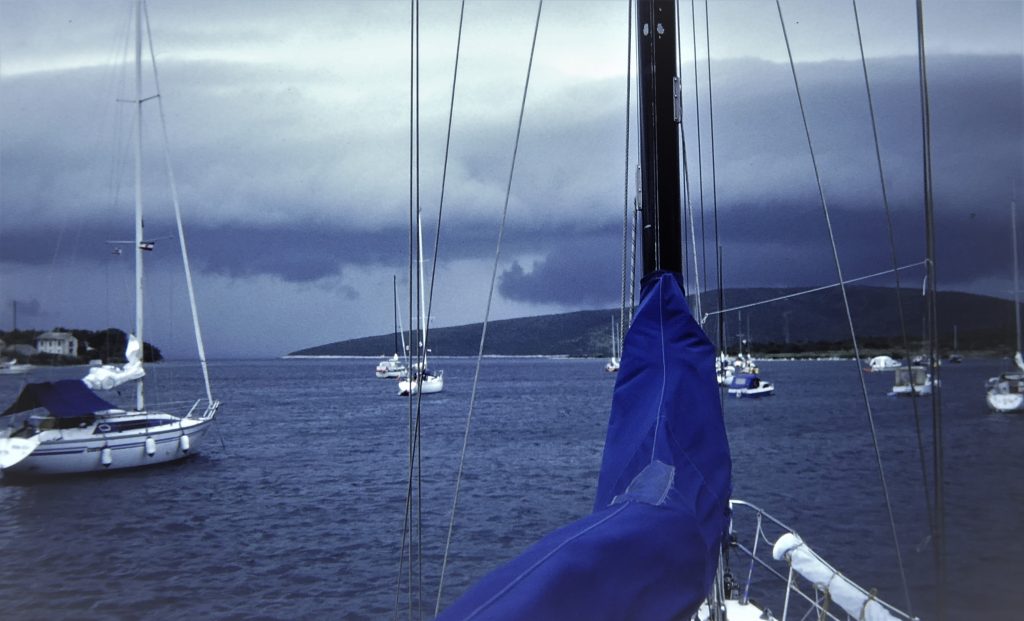 Our anchor was holding fast, with 35 metres scope (chain with some nylon rope to add some spring) in 6 metres of water, but we spent the day worrying about the other vessels in the anchorage. Sure enough, during the day an Italian boat did drag and struck us, and fouled our anchor chain, but we got disentangled without damage. The problem was that the anchorage was a slot running north-west to south-east, which made us especially vulnerable to north-west winds.
Our anchor was holding fast, with 35 metres scope (chain with some nylon rope to add some spring) in 6 metres of water, but we spent the day worrying about the other vessels in the anchorage. Sure enough, during the day an Italian boat did drag and struck us, and fouled our anchor chain, but we got disentangled without damage. The problem was that the anchorage was a slot running north-west to south-east, which made us especially vulnerable to north-west winds.
By 7:00 pm we were looking at a truly vicious-looking cloud roll moving in from the north-west, a classic warning of the Bora, and at 7:15 we were hit by a north-west wind of hurricane force. We had the surreal experience of seeing about 40 boats anchored to windward of us dragging down on us as one fleet, with the air full of spume, fury and fear.
The first boats to hit us were a Yugoslav yacht and a motor vessel, both of which we tied alongside us. While arranging fenders we were then struck by a raft of three entangled yachts that had drifted down upon us sideways. Incredibly, our anchor was still holding, but when one of the yachts stuck on our bow tried to motor away, their prop cut our anchor rope.
The six-boat raft was therefore set adrift, but we got separated one by one as we floated free. We tried to get under power, but our propeller had been fouled by someone's line. We therefore sailed under bare poles to the south, intending if necessary to leave the anchorage through its southern entrance. Fortunately the prop cleared itself and we were able cautiously to motor back and search for a lee while sorting out our second anchor, a 45-pound Danforth, and our supplementary supply of chain. We ended up holding well, but were worrying all night about other boats as they were wandering around looking to re-anchor themselves. There was a big sea outside the anchorage visible to the south, with some swell coming in, but as the wind settled somewhat overnight we were comfortable enough. If we had been on our own, we would only have had a few moments of concern at the peak of the squall, and no more.
The morning after boasted blue skies and a rapidly-rising barometer. The local forecast was for more Bora squalls, but our weather map showed that the front was well through and the outlook was good. Our first task was to find and retrieve our trusty 35-pound CQR, which had saved us and five other boats from ending up ashore. With Norma using our glass-bottomed bucket and me snorkelling we did find our chain and two entangled anchors. Our own anchor was completely buried. We grappled up the mess of chain and anchors and set a buoy on our own chain. We brought Cera back and retrieved our chain and - with some difficulty - our trusty anchor. Its performance had been unbelievable, and explained why we simply never dragged under normal conditions.
The other two anchors belonged to a pleasant Austrian with a motor vessel, who was very grateful to get them back!
After all was settled we went ashore to see the village on the other side of the anchorage and found a simple traditional place, with old ladies in black dresses, lots of flowers everywhere and well established, assured architecture. We got some red wine, but that was all. The evening breeze was strong enough to be worrying for a short while, but soon died.
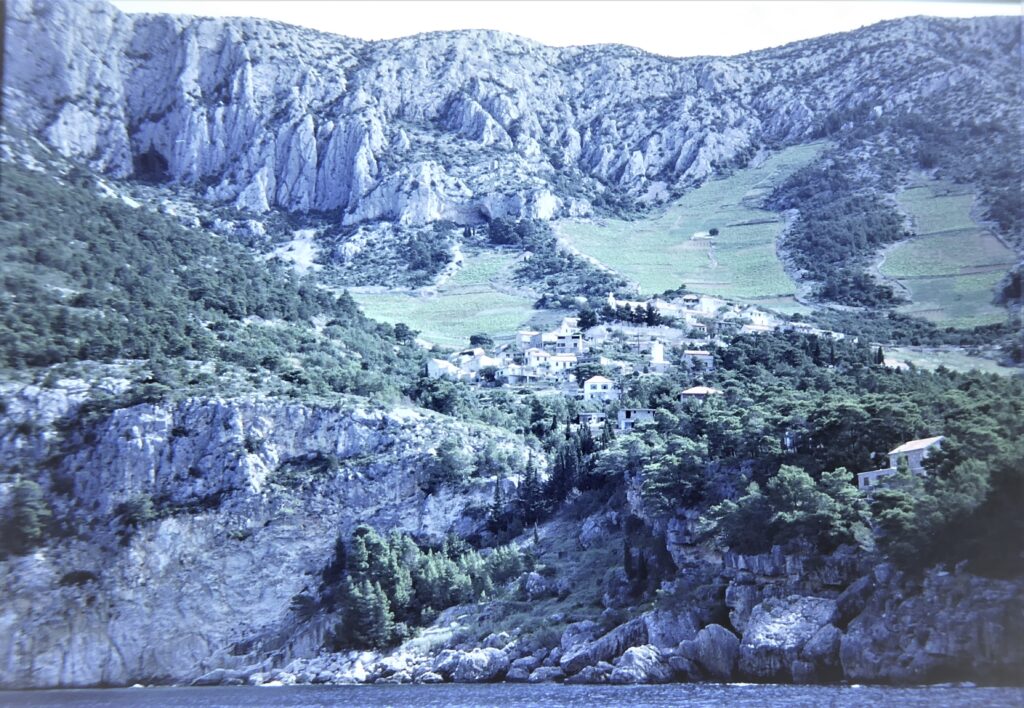 We left to sail south through more islands and down the Olipski Kanal with a great following wind, and anchored at Norma's urging in the best protected far north-west corner of Uvala Polgarbe, an inlet on the west side of Otok Molat. It was a pleasant little cove, and we walked up into the quiet hinterland, stone walls enclosing small plots and neglected vineyards and olive groves. There was a good view of Molat village from the top of the hill. We took the dinghy to the village the next day, a clean and neat place with a simple but graceful church and campanile. There were no cars; goods were being transported by wheelbarrows on concrete paths, reminiscent of Placentia in Belize!
We left to sail south through more islands and down the Olipski Kanal with a great following wind, and anchored at Norma's urging in the best protected far north-west corner of Uvala Polgarbe, an inlet on the west side of Otok Molat. It was a pleasant little cove, and we walked up into the quiet hinterland, stone walls enclosing small plots and neglected vineyards and olive groves. There was a good view of Molat village from the top of the hill. We took the dinghy to the village the next day, a clean and neat place with a simple but graceful church and campanile. There were no cars; goods were being transported by wheelbarrows on concrete paths, reminiscent of Placentia in Belize!
We were joined in the anchorage by three large Italian motor vessels, so we departed and sailed across to Veli Rat, a rather shallow basin off the village at the far end of a long inlet into the island of Dugi Otok. There were fewer boats there than we had expected, as the channel was very narrow as well as being shallow, and therefore most were anchored outside. Also, there was a charge for anchoring in the basin, but we had chosen it for its convenience in catching the early-morning ferry to Zadar.
We were up at 4:15 am for the three-hour trip. The ferry was old and rather neglected but the passage was interesting, winding through the multiple islands between us and the city and visiting lots of little villages on its way. At Zadar, it moored on the wharf by the old town.
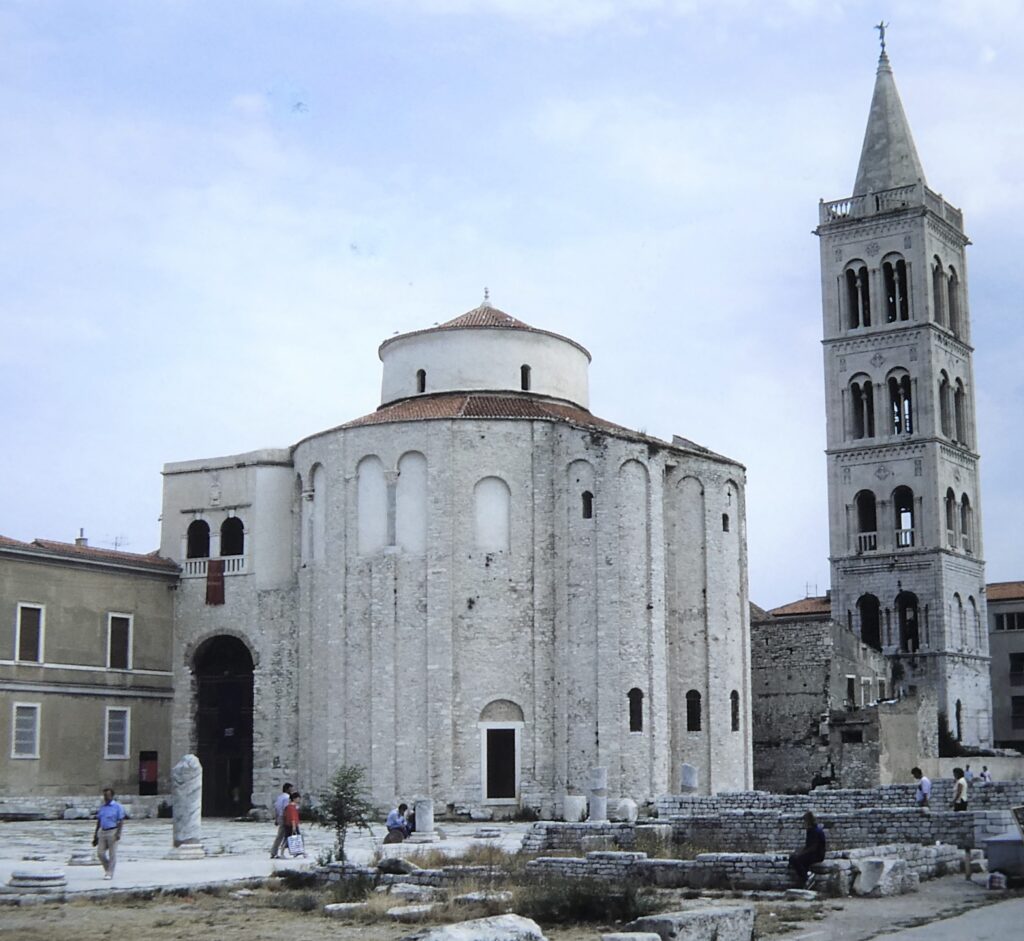 The old town is separated from the newer parts of the city by a causeway, and it was refreshingly free of cars. To get to the Amex office we had to go through the urban new town, where the traffic and parking was as shambolic as Palermo. Amex had some mail for us - its forwarding service was continuing to prove very efficient - and we had a look at the large and impersonal marina while we were there.
The old town is separated from the newer parts of the city by a causeway, and it was refreshingly free of cars. To get to the Amex office we had to go through the urban new town, where the traffic and parking was as shambolic as Palermo. Amex had some mail for us - its forwarding service was continuing to prove very efficient - and we had a look at the large and impersonal marina while we were there.
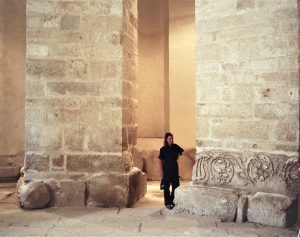
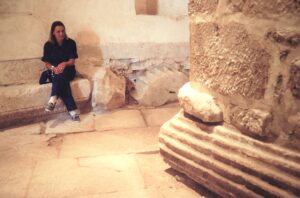 Back in the old town we walked around several 12-13th century churches, but the most interesting was the 9th century Crkva Sv Donato. It's a tall circular building with its foundations built of the jumbled bits of remains of a Roman forum. Excavations showed the amazing use of these old artefacts. There was little left of the forum, but its shape could be discerned, and there were other bits of the Roman world all over the town.
Back in the old town we walked around several 12-13th century churches, but the most interesting was the 9th century Crkva Sv Donato. It's a tall circular building with its foundations built of the jumbled bits of remains of a Roman forum. Excavations showed the amazing use of these old artefacts. There was little left of the forum, but its shape could be discerned, and there were other bits of the Roman world all over the town.
We had lunch in a waterside restaurant, took a nap in the park, and caught the afternoon ferry back to Molat. The ferry was carrying loads of goods for the islands, so the wharves were very busy at every stop.
The night was thundery and windy, and, sure enough, some boats dragged - but they were not near us, and anchored downwind, so no problems this time. Nevertheless, we stayed up on anchor watch for a while. We woke to a pleasant morning and had a great downwind sail down to Otok Iz and to a little inlet down near its south-east tip, Uvala Vodenjak Veli.
We anchored and tied stern-to to its northern shore, all on our own again. There were showers overnight, but no storms, and we then took the dinghy up the island to the village of Iz Mali for some light shopping. This was a tiny harbour, with tiny fishing boats - and tiny fish. Back on the boat we were well sheltered from the typically strong sea breeze, the seas were glittering blue and the bushy countrysides green. We did some maintenance, Norma replaced some mainsail slides, we slept and read. The next morning, Norma baked some bread. This was what we were here for!
Bread done, we motored out into very light winds and motored across in flat calm water to the narrow channel between Otok Katina and Otok Kornat, taking us into the heart of the Kornati National Park. We turned north towards the heart of Dugi Otok along the long, wide inlet of Luka Telascica, scattered with stony, domed islets. We anchored beyond a pair of these bare islets and near the end of the inlet just beyond them. This was a popular place, with lots of tourists and cruise boats. We had to move once, because a couple of large Italian motor vessels anchored on top of us, but ended up in a good place. We ended the day with a welcome swim.
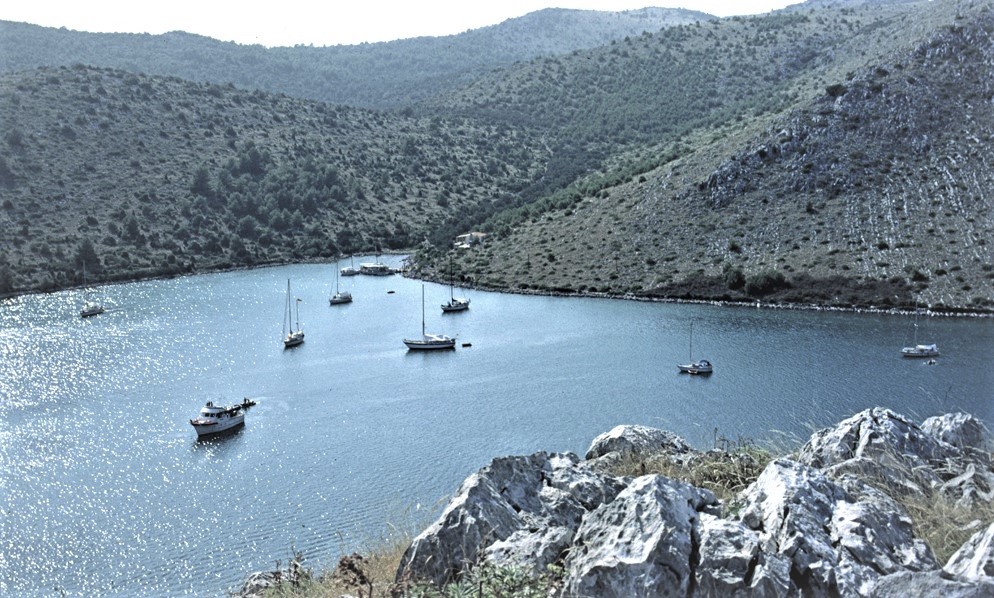
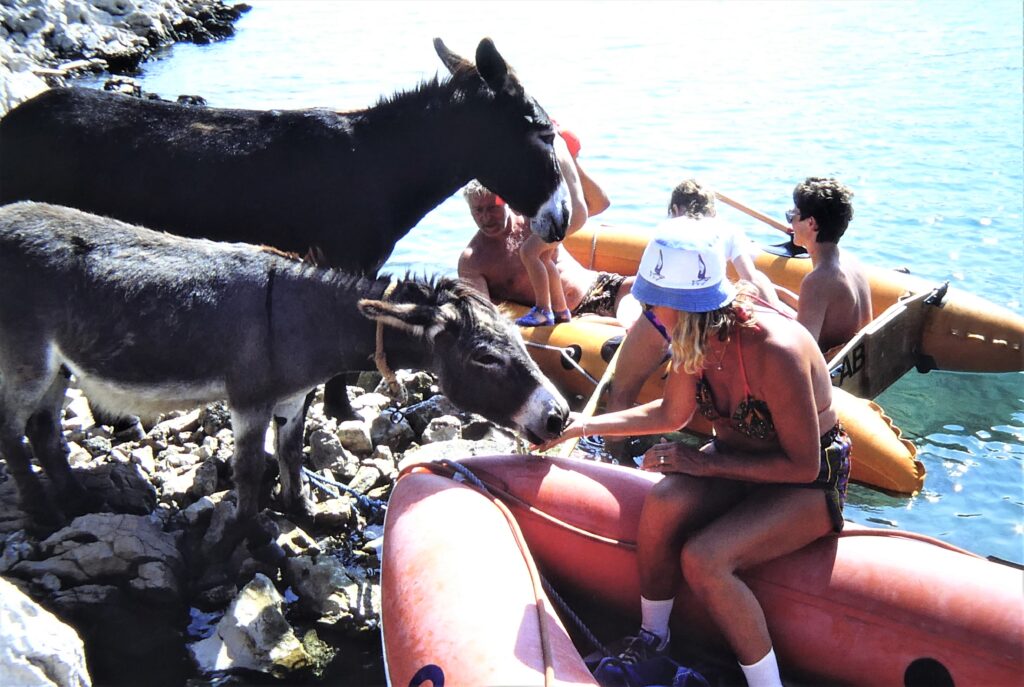 In the morning we got stuck into some maintenance, including varnishing most of the teak deckwork. After lunch we went ashore on what was being called the "donkey island". We were met by two friendly donkeys, one young, very keen to welcome us and any dinghy carrying food. The little one especially liked cucumbers! We took a tough walk up to the top of the island, which had a lovely view down the length of Telescica. Norma harvested some blackberries.
In the morning we got stuck into some maintenance, including varnishing most of the teak deckwork. After lunch we went ashore on what was being called the "donkey island". We were met by two friendly donkeys, one young, very keen to welcome us and any dinghy carrying food. The little one especially liked cucumbers! We took a tough walk up to the top of the island, which had a lovely view down the length of Telescica. Norma harvested some blackberries.
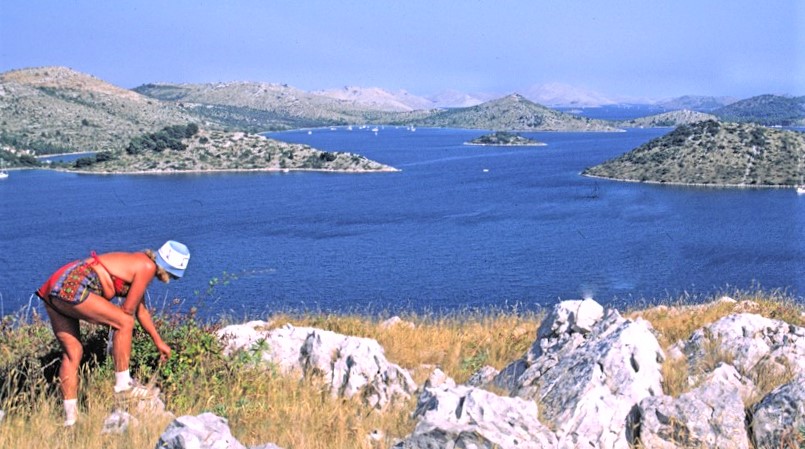 The weather was becoming windy again, so we stayed put. We walked across to the east side of the island of Dugi Otok to its main settlement, Sali, via a long stony track up a hill to a road that took us down to the village. Sali was a typical little island port, with a couple of large fishing boats. The walk back was easier, because we got a lift from a public works truck.
The weather was becoming windy again, so we stayed put. We walked across to the east side of the island of Dugi Otok to its main settlement, Sali, via a long stony track up a hill to a road that took us down to the village. Sali was a typical little island port, with a couple of large fishing boats. The walk back was easier, because we got a lift from a public works truck.
After five nights at this great anchorage, sitting out a couple of fronts, we motored out and down the northern part of the Kornati chain of islands.
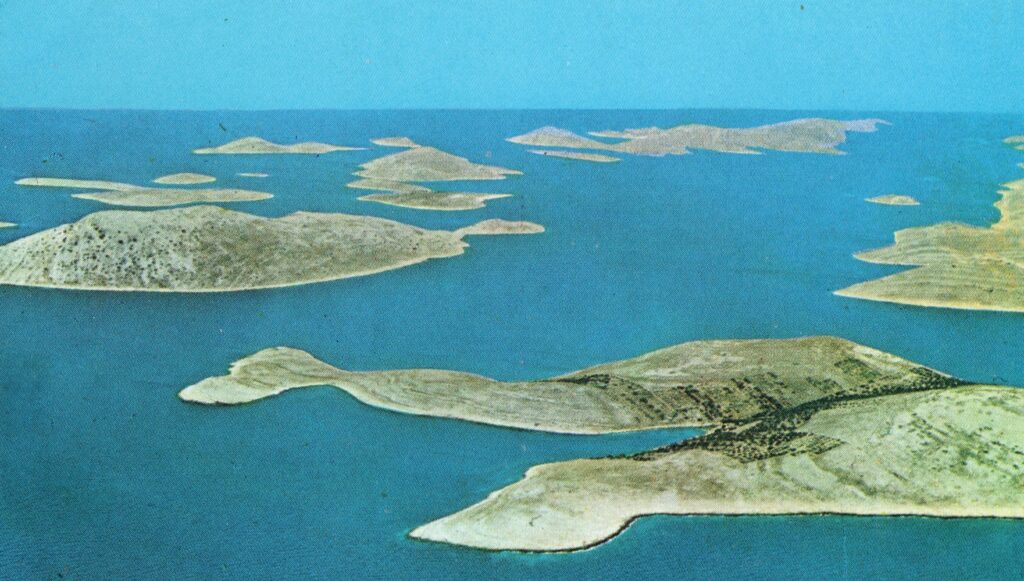 We learnt that human presence on the Kornati islands appears to extend back to the Neolithic Age. Occupation by wealthy Romans is shown by mosaic floors in the remains of Roman villas. In Venetian times the islands were used for resupplying the Venetian fleet. Deforestation and subsequent erosion, and overgrazing by sheep and goats, for whose benefit the scrub was periodically burnt over, impoverished the fauna and depopulated the islands.
We learnt that human presence on the Kornati islands appears to extend back to the Neolithic Age. Occupation by wealthy Romans is shown by mosaic floors in the remains of Roman villas. In Venetian times the islands were used for resupplying the Venetian fleet. Deforestation and subsequent erosion, and overgrazing by sheep and goats, for whose benefit the scrub was periodically burnt over, impoverished the fauna and depopulated the islands.
We made our way to the bay at the settlement of Vrulje on the western side of Otok Kornat, the biggest island of the archipelago. There wasn't a lot of room, but we found room close to its northern shore. It got even more crowded by 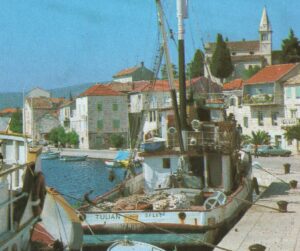 evening. We only stopped for the night, and then continued on down through the Kornatis without the scenery changing much. We called in at Premik marina, near Primosten on the mainland, to take on fuel and water, and then motored on round the headland to the big, sheltered and nearly land-locked bay at Rogoznica.
evening. We only stopped for the night, and then continued on down through the Kornatis without the scenery changing much. We called in at Premik marina, near Primosten on the mainland, to take on fuel and water, and then motored on round the headland to the big, sheltered and nearly land-locked bay at Rogoznica.
The little town was on an island in the attractive bay, connected to the mainland by a causeway. The anchorage was to the west of the town and the causeway. We had a quick swim and then went ashore for some basic provisions from a sleepy butcher and shopkeeper. We returned later for a concert of Dalmatian music, but it wasn't very good. After some basic maintenance the next morning we were away in the afternoon for a lovely downwind sail, with the sea breeze curling conveniently into and along the channels. We came to an officially un-named inlet on the northern side of Otok Ciovo, just off Trogir. This a popular and well-protected anchorage, which the authors of our very good cruising guide to the Adriatic has named Uvala Gbldguk, in an amusing salute to the difficulty of the local language.
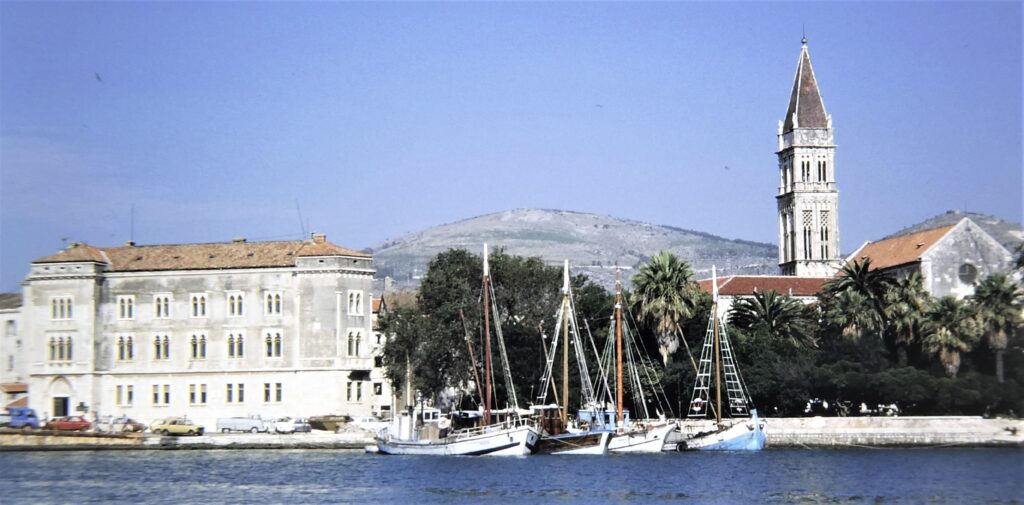
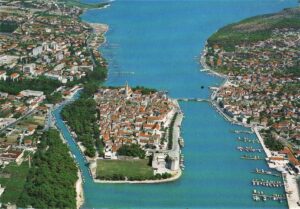 It was very quiet overnight, and in another beautiful morning we took the dinghy over to the old town of Trogir. We tied up the dinghy in the channel dividing the old town island from the mainland, right by the bus station. The town was seething with tourists, with long waits to change money and post letters. We didn't even try to join the telephone queue.
It was very quiet overnight, and in another beautiful morning we took the dinghy over to the old town of Trogir. We tied up the dinghy in the channel dividing the old town island from the mainland, right by the bus station. The town was seething with tourists, with long waits to change money and post letters. We didn't even try to join the telephone queue.
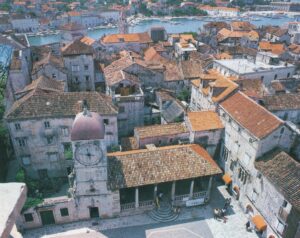 However, the tourists were there for a good reason: it's a lovely place, which we thought was one of the prettiest along the coast. There's a gorgeous little central square, featuring the 13th century cathedral of St Laurence (Sveti Lovro), a Gothic bell tower that we climbed, a loggia and campanile. Leading to the square is a maze of Venetian-style alleys.
However, the tourists were there for a good reason: it's a lovely place, which we thought was one of the prettiest along the coast. There's a gorgeous little central square, featuring the 13th century cathedral of St Laurence (Sveti Lovro), a Gothic bell tower that we climbed, a loggia and campanile. Leading to the square is a maze of Venetian-style alleys.
In the 13th and 14th centuries Trogir was a walled town, with only remnants of the wall remaining now. The bell tower was completed in the 16th century
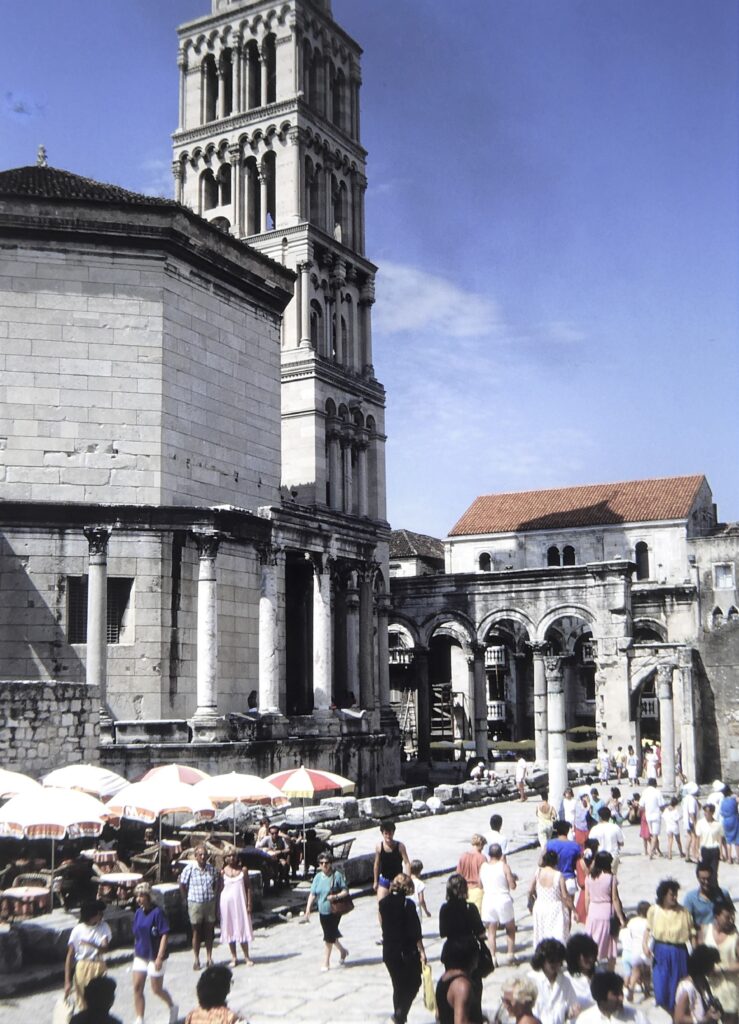 There was a sprinkle of rain overnight but it was hot the next morning and we returned by dinghy to Trogir and our dinghy park by the bus station. The purpose was to take a bus to Split, along a not particularly attractive road, out of sight of the sea but
There was a sprinkle of rain overnight but it was hot the next morning and we returned by dinghy to Trogir and our dinghy park by the bus station. The purpose was to take a bus to Split, along a not particularly attractive road, out of sight of the sea but 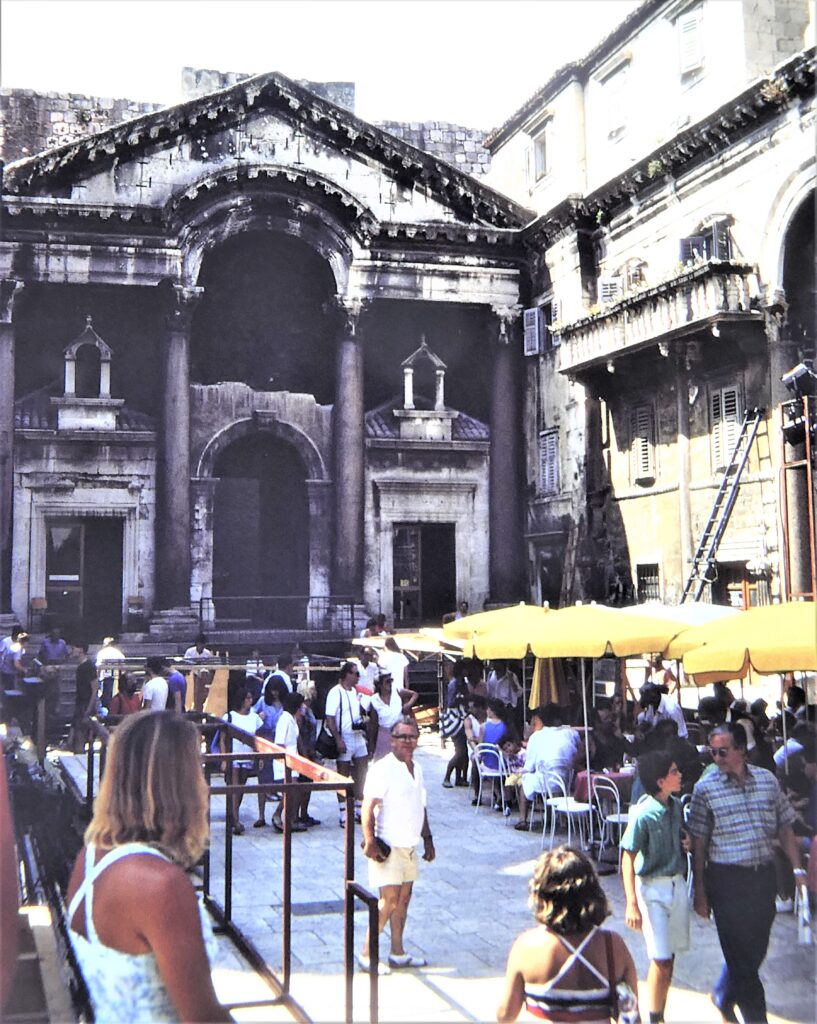 overshadowed by the mountain range inland. We walked from the bus station to our main target, the 4th century palace of the Roman emperor Diocletian.
overshadowed by the mountain range inland. We walked from the bus station to our main target, the 4th century palace of the Roman emperor Diocletian.
Again there were hundreds of tourists in the jumble of remains of Roman and many other civilisations that have built the city and live there. There is an impressive centre, with an octagonal church/mausoleum, a restored campanile, a forum and peristyle. Houses were built within and round the columns. Narrow little streetsand tiny squares defined the old town.
Underground there were more Roman and other remains, cool, dripping water from green algae, big cellars with typically Roman brickwork.
The bus back was uncomfortable and hot, with wooden seats - when we finally got to sit down - and a bad driver. We did a little shopping in the good Trogir market before returning to the boat.
After a weak cold front had moved through we motored down the Splitski Kanal in a flat calm, through the Brac-Solta channel and to the Pakleni group of small islands just off the south side of Otok Hvar. We had a look into some of the inlets on the north side of the group's islands, but the potential anchorages were deep and with poor holding in weed. We settled on the slot between Marinkovac and Planikovac islands, which was fine once we had got the anchor through the weed and into the sand. It was quiet, with only a few little boats rushing around.
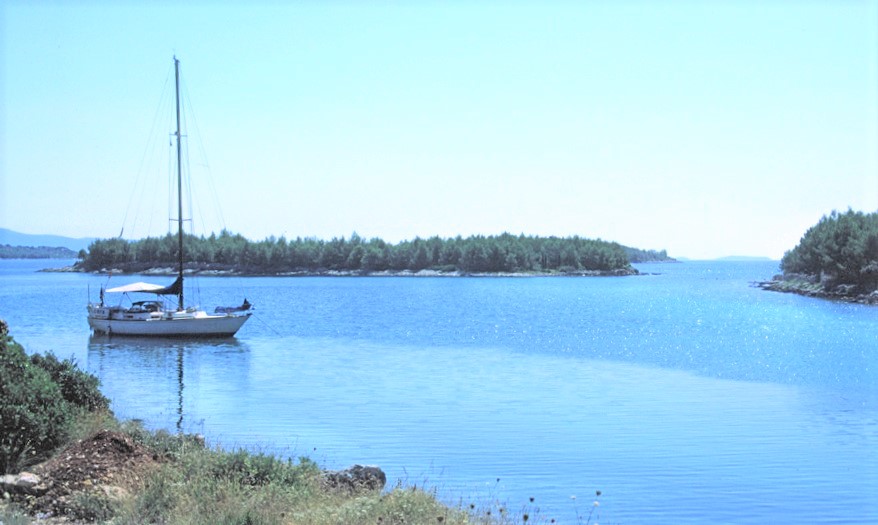
We took the boat over to the town of Hvar the next morning. The anchorage in the bay within the town was packed, as we suspected it would be, but we were anchored right in the middle, identifiable through our unusual black mast.
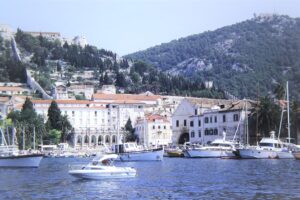 Hvar is yet another attractive Venetian fortified town, with a cathedral, square, clock tower and loggia (now a hotel). We walked up to the citadel, with a lovely view overlooking the town and the Pakleni islands. The castle's viewing place was despoiled by tasteless neon signs advertising discos and the like. Up behind us were steep pine-filled valleys with a hairpin road winding up through them, Alpine style.
Hvar is yet another attractive Venetian fortified town, with a cathedral, square, clock tower and loggia (now a hotel). We walked up to the citadel, with a lovely view overlooking the town and the Pakleni islands. The castle's viewing place was despoiled by tasteless neon signs advertising discos and the like. Up behind us were steep pine-filled valleys with a hairpin road winding up through them, Alpine style.
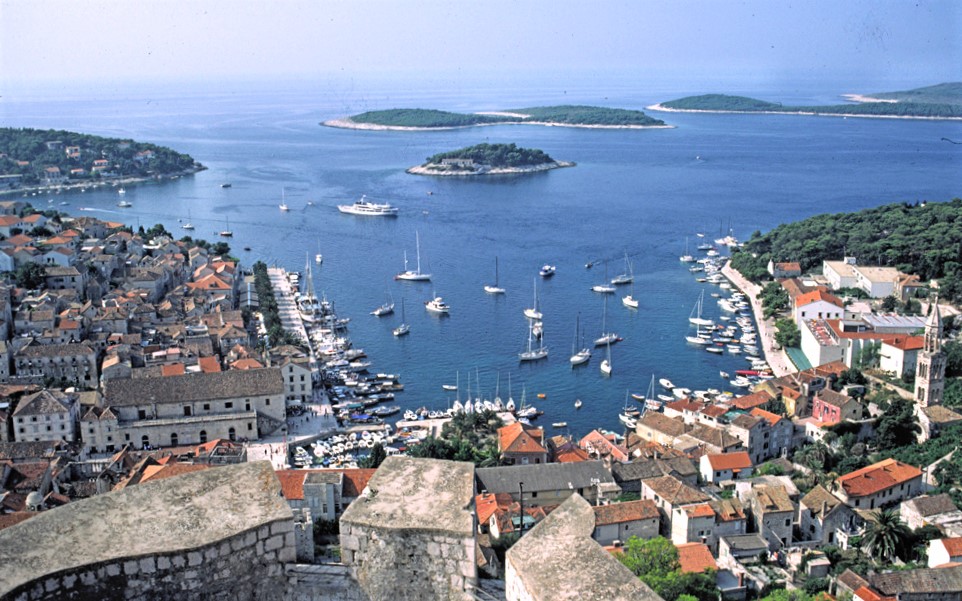 Back down, the ancient arsenal was now the supermarket, crowded as always. Up above it was a pretty little 12th century theatre.
Back down, the ancient arsenal was now the supermarket, crowded as always. Up above it was a pretty little 12th century theatre.
We were out and away by mid-day, with a good sail fast sail down to the southern side of Otok Korcula, latterly in a typical 20-25 knot afternoon blast of wind. We sailed up to the NW end of a fjord-like inlet near the village of Brna, with the gusty wind having the characteristics of a mild Bora but settling by morning.
We motored on south-east during the morning with - as usual - the sea breeze kicking in just as we reached or day's destination, Luka Polace, Mljet. This is a big, wide anchorage in a national park, with excellent all-round protection in beautiful wooded surroundings. It was a popular place, with about 60 boats in by nightfall but in plenty of room.
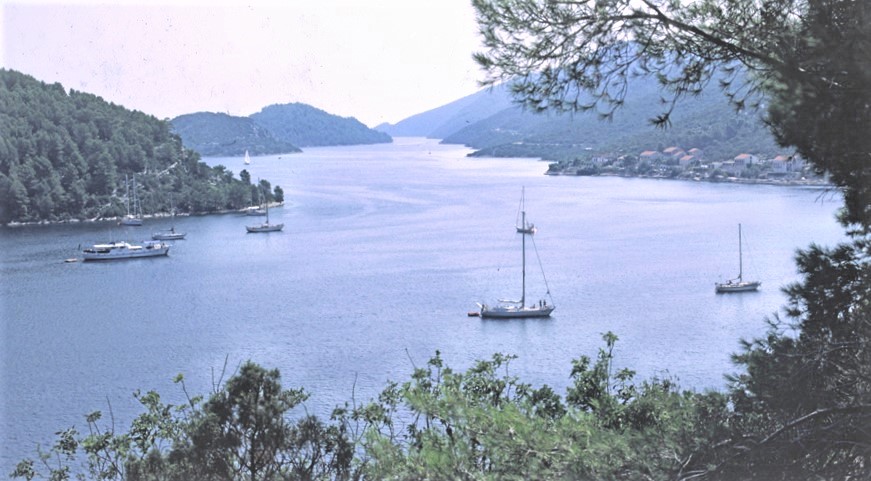
We walked ashore in the morning, starting by the ruins of a Roman castle near the village of Polace. We walked a mile or so along a rough track over the hills to the inland "sea lake" of Jezero, connected to the sea by a narrow channel.. There were a few abandoned smallholdings along the way, and one or two farms hanging on, growing olives, grapes and scruffy cabbages. On the other side, on a little peninsula looking like an island, there was an old monastery being converted into a hotel. Back over a different route via the hill village of Govedari we had lovely views over the multiple bays and islands of the park.
This was followed by sociable day, starting with helping a big motor vessel that was dragging and followed by drinks and meals on four other boats. One was Mary Constance, a big ketch owned by an American couple Ted and Mary. They were sailing for four months each year, then returning to the US where they toured in a motorhome selling a directory of funeral homes. We came across them again several times over the next several months.
We were sorry to leave this pleasant anchorage after a weekend there, and sailed away down a lovely but narrow channel through some outer islands to the open sea and a magnificent view of the mountainous spine of the Peljesac peninsula to our north. At the south-east end of the peninsula we turned into a long inlet leading up a very pretty valley to the small town of Ston at its very head, where we anchored by ourselves in good-holding mud.
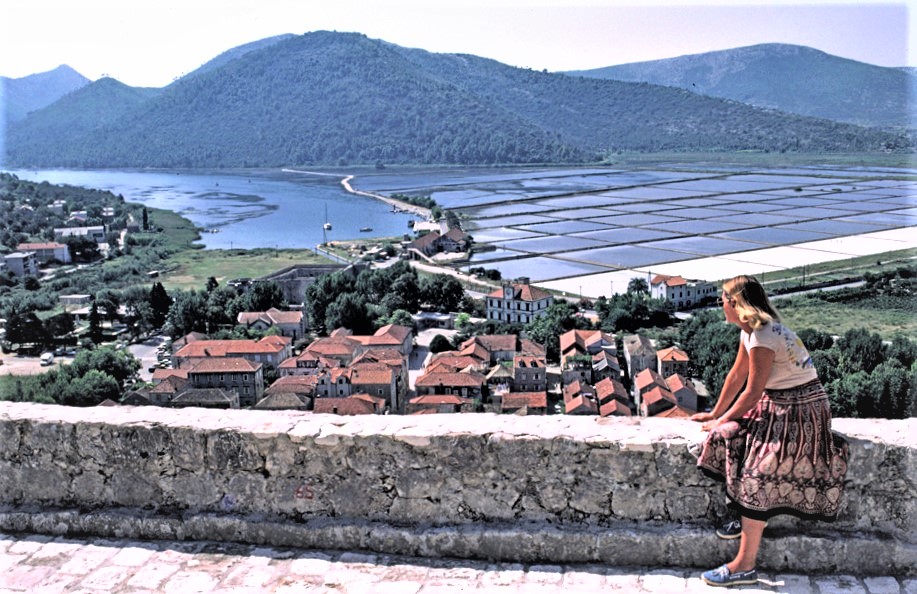
We could see the impressive fortifications up behind the village, and what looked like a miniature Great Wall stretching up over the hills to the north, dividing the Peljesac peninsula from the "mainland". To our left coming in we passed wide-ranging salt flats, old churches among the cypress trees, sparkling in the backlight of a westering sun.
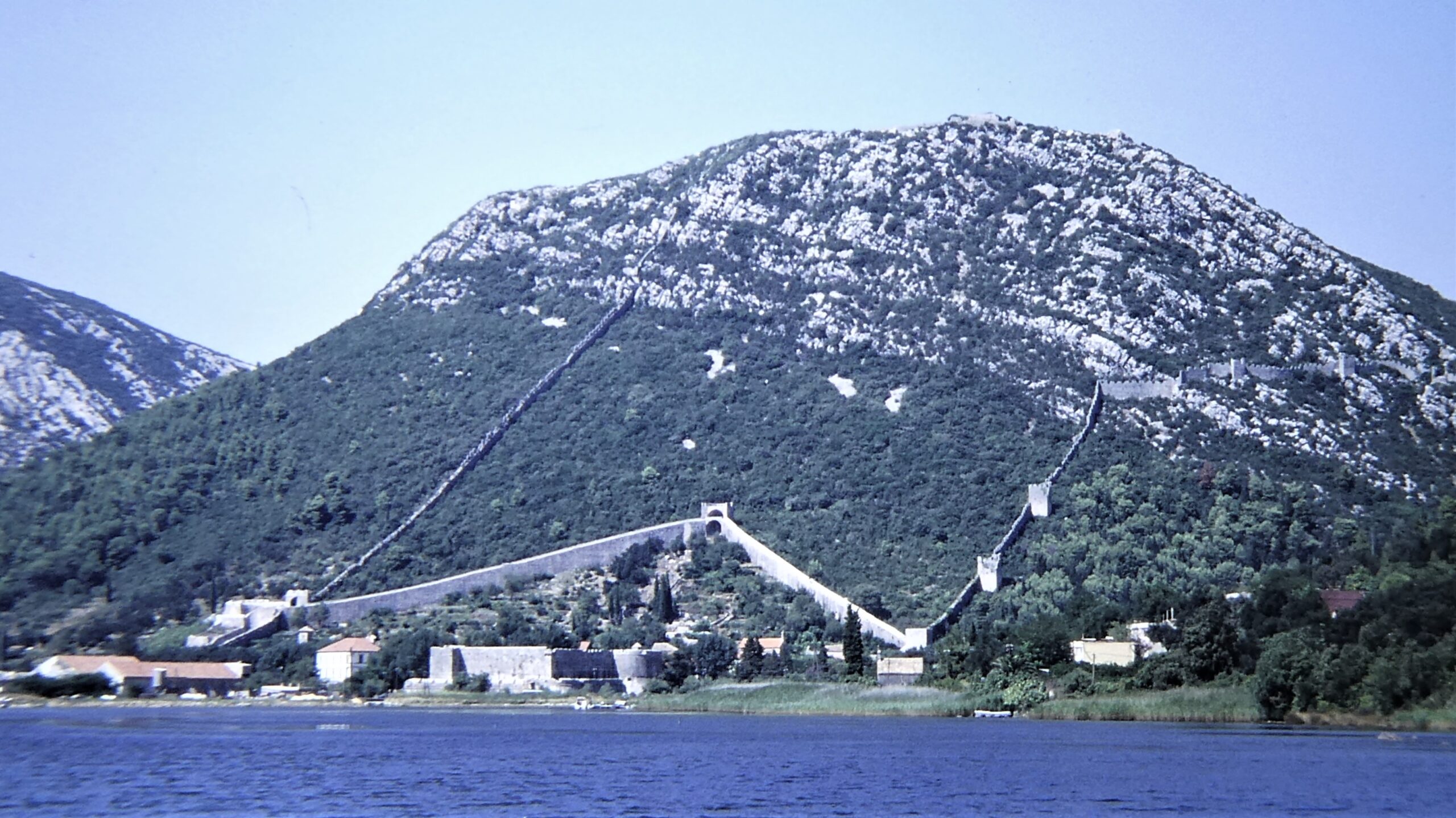 We walked ashore to the village, almost invisible behind a part-ruined castle and its associated walls. A gate led through to the town, over a bridge and to the big market in the main square. The surrounding buildings and little shops were faced by polished marble. We even found a working public phone with vacant booths at the post office, and caught up with some overdue and quite important calls about some possible work in the coming winter.
We walked ashore to the village, almost invisible behind a part-ruined castle and its associated walls. A gate led through to the town, over a bridge and to the big market in the main square. The surrounding buildings and little shops were faced by polished marble. We even found a working public phone with vacant booths at the post office, and caught up with some overdue and quite important calls about some possible work in the coming winter.
A walk the next day took us over the isthmus to Mali Ston along a dangerously narrow road (leading to Dubrovnik) with no walkway and lots of traffic. Castellated walls and fortified towers connected the two towns but Mali Ston was not thriving like its big sister. It was very quiet, with a few 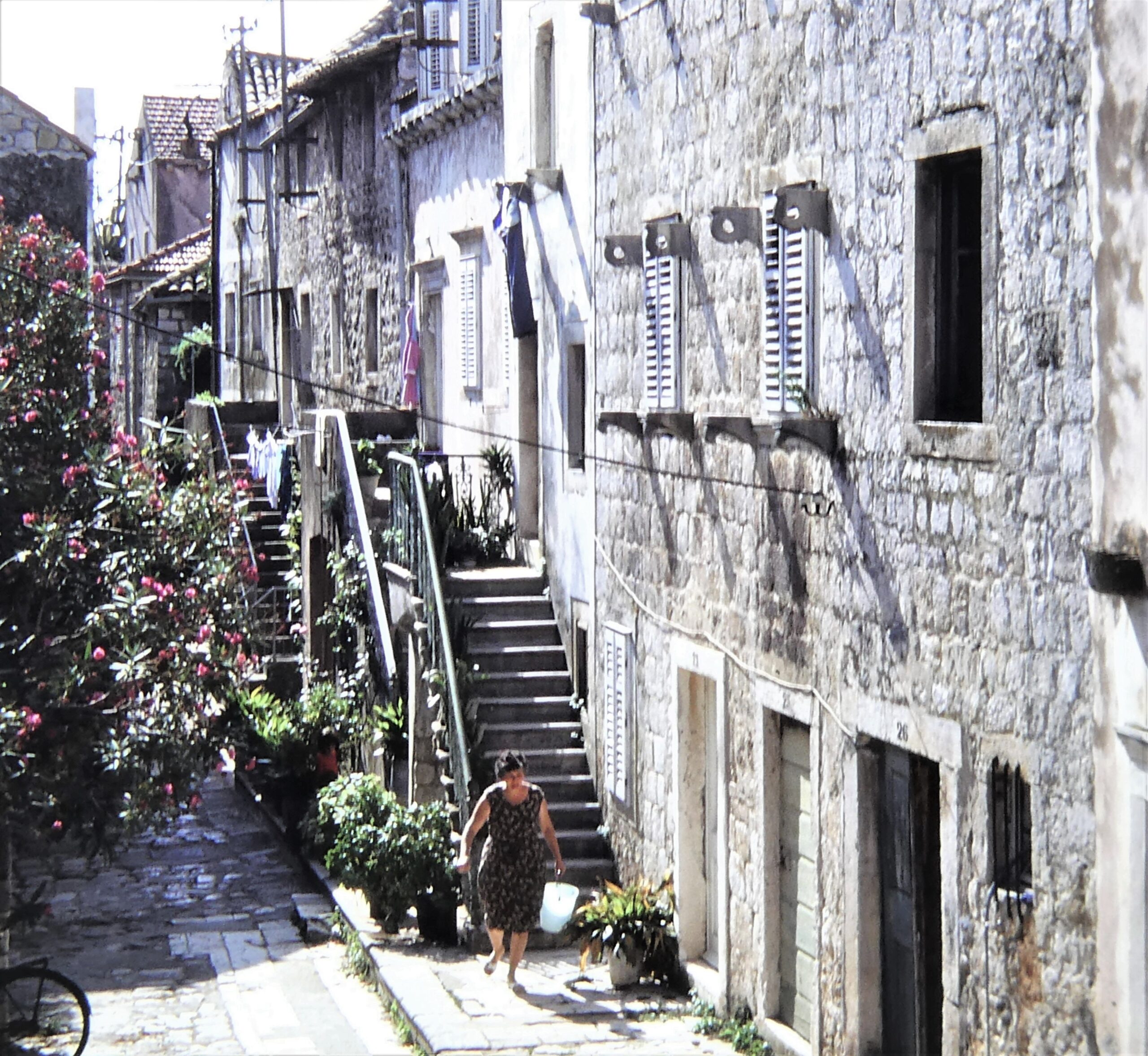 old citizens pottering about, ruined cottages tucked away in steep alleys. It was still in a gorgeous setting, with a little harbour, sitting at the eastern end of the channel between the Peljesac peninsula ad the mainland, encased by green and stony hills.
old citizens pottering about, ruined cottages tucked away in steep alleys. It was still in a gorgeous setting, with a little harbour, sitting at the eastern end of the channel between the Peljesac peninsula ad the mainland, encased by green and stony hills.
Back in Ston we walked up the restored part of the fortified walls behind the town, with a lovely view of the salt pans and the anchorage.
We waited for some windy and wet weather to clear before moving out the next day, and motored down the cliffy coast to the long inlet of Luka Zaton, just up the coast north-west from Dubrovnik. We anchored in a basin up at the end, with the shoreline lined by grey stone buildings, a mill and camp sites. We were the only yacht there. On this coast, as we were learning, anchorages were either busy or empty, but it was impossible to forecast which it would be.
It was a good place to leave the boat for our visit to Dubrovnik. We went ashore via a camp site in the bay and found we had just missed the two-hourly bus. However, we soon hitched a lift with a pleasant young German on a driving holiday. They dropped us off at the Dubrovnik marina because as we passed it we caught sight of Passages lying there, the yacht of our good friends Jan and Don Fribourg, last seen in Mallorca. We had a great reunion. They told us that they had become sick of Italy, and were planning to stay in this marina for the winter.
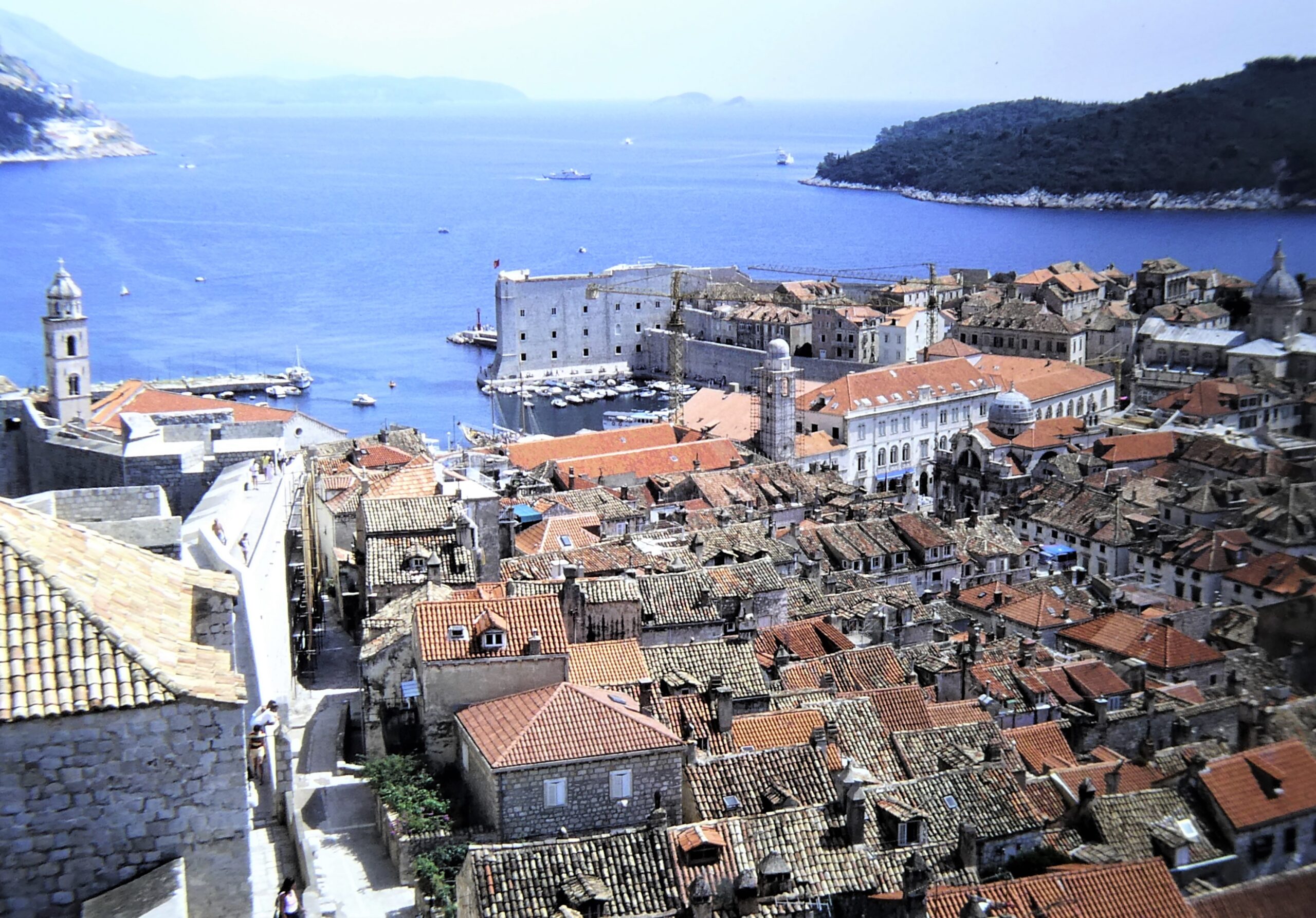
We then took a bus the rest of the way into Dubrovnik town. The first stop was at the Amex agent, at Atlas Travel, to pick up a pile of mail - again, we found that this system was working well. We lunched on the forecourt of the Imperial Hotel, pleasantly cool under the trees but touristy food: "how do you want your hamburger?"
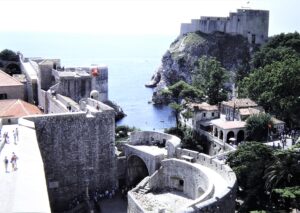 We then walked right round the outstanding and immense city walls, with their splendid views over the old town roofs and alleyways. Down in the town we had a
We then walked right round the outstanding and immense city walls, with their splendid views over the old town roofs and alleyways. Down in the town we had a 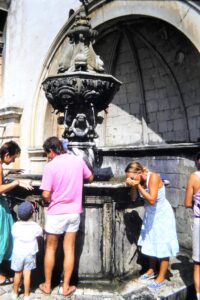
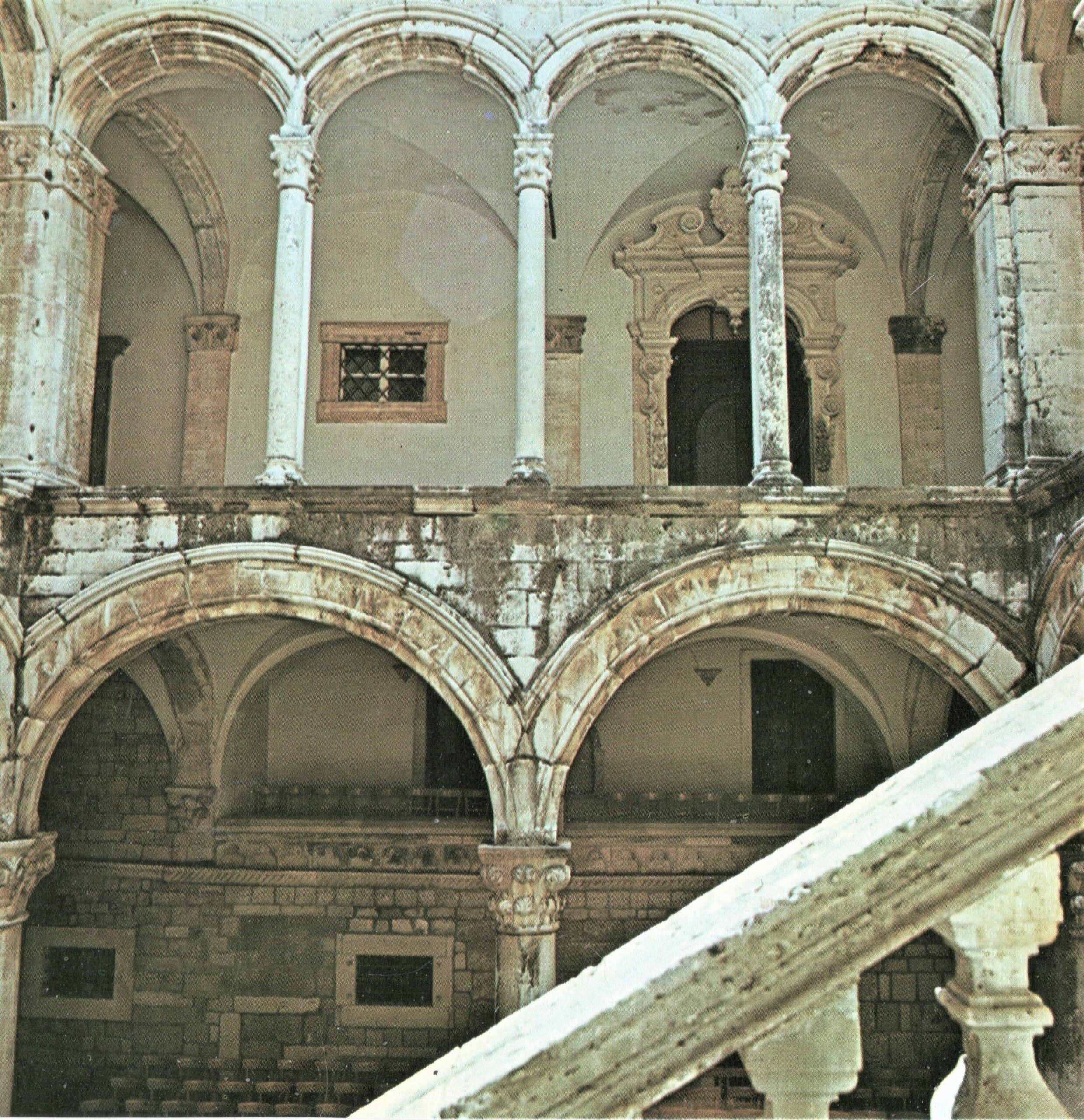 drink at the old fountain and walked the primary street to the Rector's Palace. The rooms were partly furnished and enclosed a beautiful central atrium and staircase.
drink at the old fountain and walked the primary street to the Rector's Palace. The rooms were partly furnished and enclosed a beautiful central atrium and staircase.
We also visited the two main monasteries, the church and the cathedral. The main attraction of Dubrovnik, we thought, was its completeness and originality as a town.
There were of course lots of tourists and it was very hot, so this was a tiring visit. We walked over to the 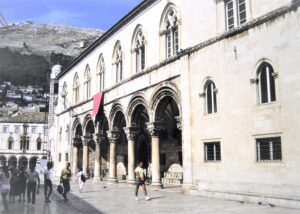 suburb of Gruz and booked seats on the inter-city bus back to Zaton. The way the driver drove, we were glad we weren't going the whole way to Trieste! We were back in time for a swim before the sun disappeared behind the hills to the inlet's west side.
suburb of Gruz and booked seats on the inter-city bus back to Zaton. The way the driver drove, we were glad we weren't going the whole way to Trieste! We were back in time for a swim before the sun disappeared behind the hills to the inlet's west side.
It was a gusty night, but after writing some letters in the morning we moved out and round to Dubrovnik, motoring under the high road bridge and up the river to the big ACY marina. We 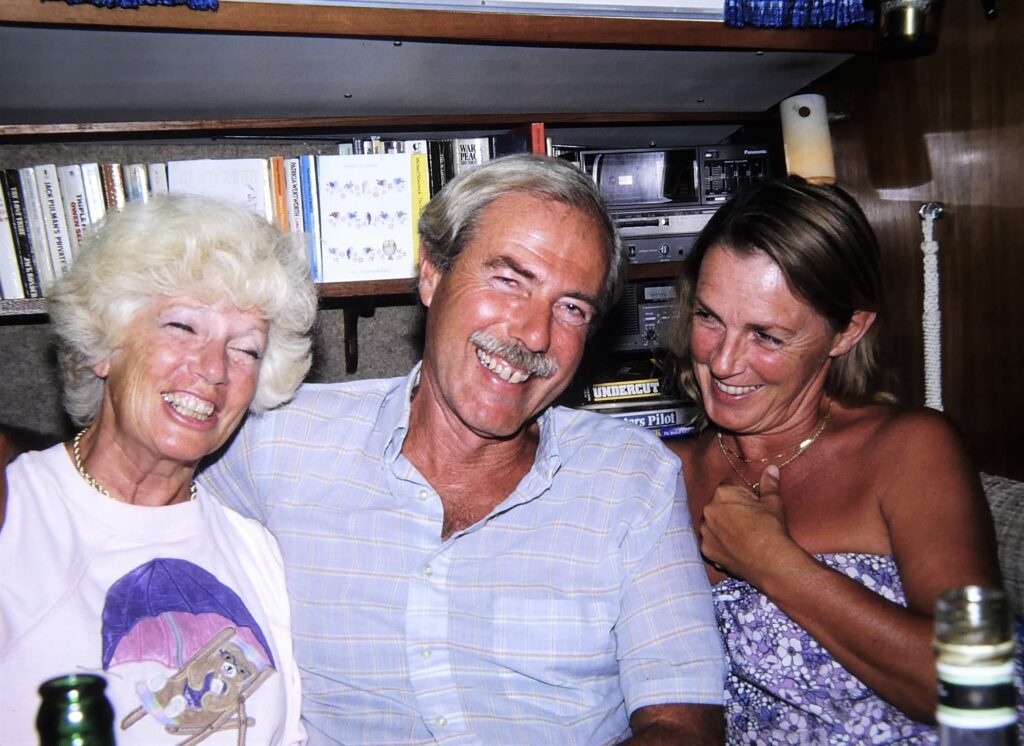 went on past the marina where the river continues for a short way, and we understood that anchorage there was possible. We moved cautiously and it was narrow but just deep enough, and we anchored fore-and aft. It soon became clear that we were not welcomed there by the riverside locals and fishermen, but apparently it was legal and we ignored the scowls. In the evening Don and Jan joined us for drinks and we talked and laughed into the small hours.
went on past the marina where the river continues for a short way, and we understood that anchorage there was possible. We moved cautiously and it was narrow but just deep enough, and we anchored fore-and aft. It soon became clear that we were not welcomed there by the riverside locals and fishermen, but apparently it was legal and we ignored the scowls. In the evening Don and Jan joined us for drinks and we talked and laughed into the small hours.
It was a restless night, with wind howling down the valley, rustling the riverside reeds. So we carefully moved out early, at low tide just touching the bottom a couple of times. Leaving the river, we hooked around the headland to have a look at Dubrovnik from the sea. Its walls made the city 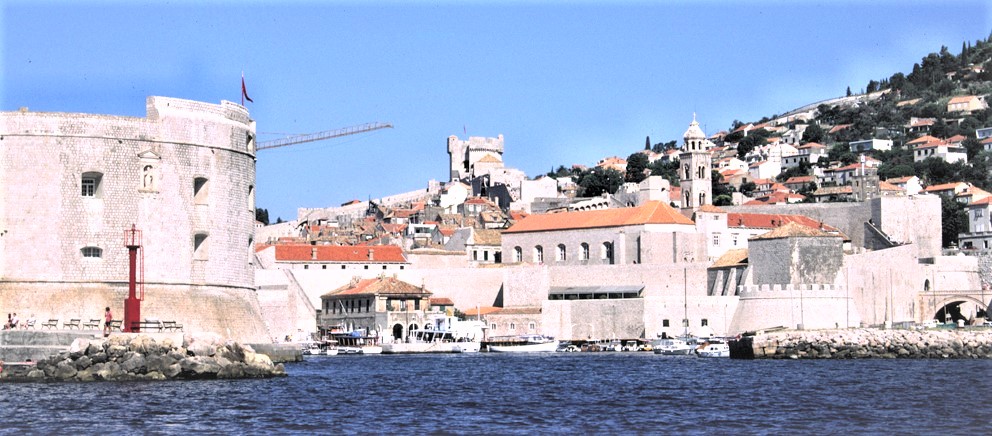 look impregnable. From there we motored down the coast a short distance and anchored in the well-protected bay on which the appealing little town of Cavtat sits, and where the backdrop is a line of high, stony mountains. There was a bit of a swell rolling in from the north-west, so after doing some shopping for stores we continued on down to the west side of the open, wooded bay at Molunat, where only one other vessel was anchored. After a rather rolly night we continued a short distance down the coast until turning inland from the open sea through the channel into the Boka Kotorski, the magnificent Gulf of Kotor, in the Yugoslav region of Montenegro.
look impregnable. From there we motored down the coast a short distance and anchored in the well-protected bay on which the appealing little town of Cavtat sits, and where the backdrop is a line of high, stony mountains. There was a bit of a swell rolling in from the north-west, so after doing some shopping for stores we continued on down to the west side of the open, wooded bay at Molunat, where only one other vessel was anchored. After a rather rolly night we continued a short distance down the coast until turning inland from the open sea through the channel into the Boka Kotorski, the magnificent Gulf of Kotor, in the Yugoslav region of Montenegro.
This is effectively an inland sea, with the whole system encompassing four smaller landlocked waters (each a "Zaliv") connected by channels.
On our left as we entered the gulf we passed the formidable Dubrovnik-style castle that was a military base, and on our right a matching set of forts. Because of its status as a military base the gulf had only just been opened for access by private yachts, so we were one of the first from overseas. Ahead we could see the big and reportedly busy city and holiday resort of Herceg-novi. Turning right we motored across the Tivatski Zaliv, the second of the three connected secondary gulfs within the whole system, and went down to a beautiful cove in its south-east corner, Uvala Krtoli, where we anchored by ourselves - apart from several runabouts buzzing around us.
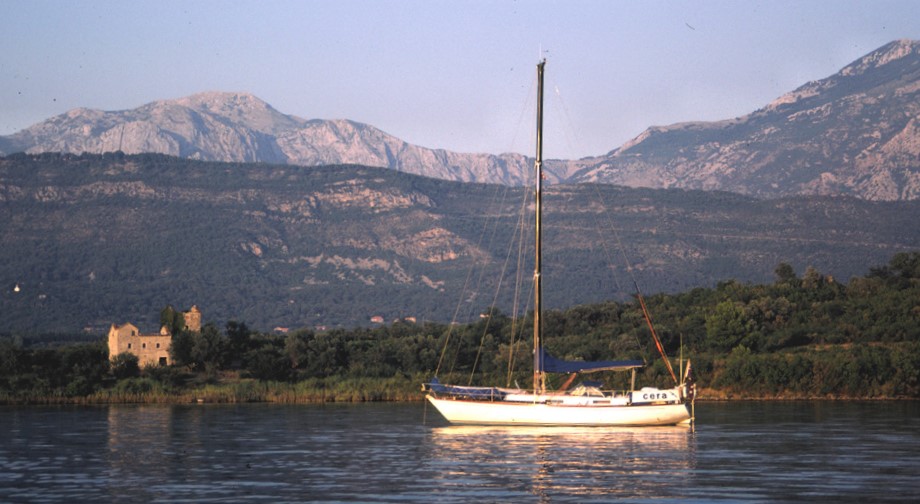
Separated from the main bay by the small island of Stradioti we were surrounded by thick woodlands backed by towering grey mountains on all sides. There were a few holiday-makers on a camp site ashore on a tiny holiday island, once a Club Med. Taking the dinghy further into the cove we saw some very poor dwellings and a few half-built houses occupied by glum locals. Walking the tracks ashore, which looked like something out of a farm, we came across several wandering tortoises.
On the east side of the main bay was the commercial centre of Tivat, and after a windy night we took the dinghy there for stores from a good selection of shops and a market. Very much enjoying our Krtoli anchorage, we stayed there and did some more exploring, including some disused salt pans, and got stuck into some routine boat maintenance.
We then moved north through a narrow passage further into the inner reaches of the system, the gulf of Risanski Zaliv, with the scenery becoming more fjord-like the further we went. At the furthermost north-east extremity of the gulf we tied up to the very ricketty harbour wall at the small town of Risan, with not a single other boat in sight. It was not a particularly attractive place, with much of it suffering from unrepaired earthquake damage. Under the shadows of the limestone cliffs of the towering mountains around us, we felt as isolated as it was possible to get in Mediterranean waters. The town has a history back to ancient times, and we strolled around some Roman mosaic floors.
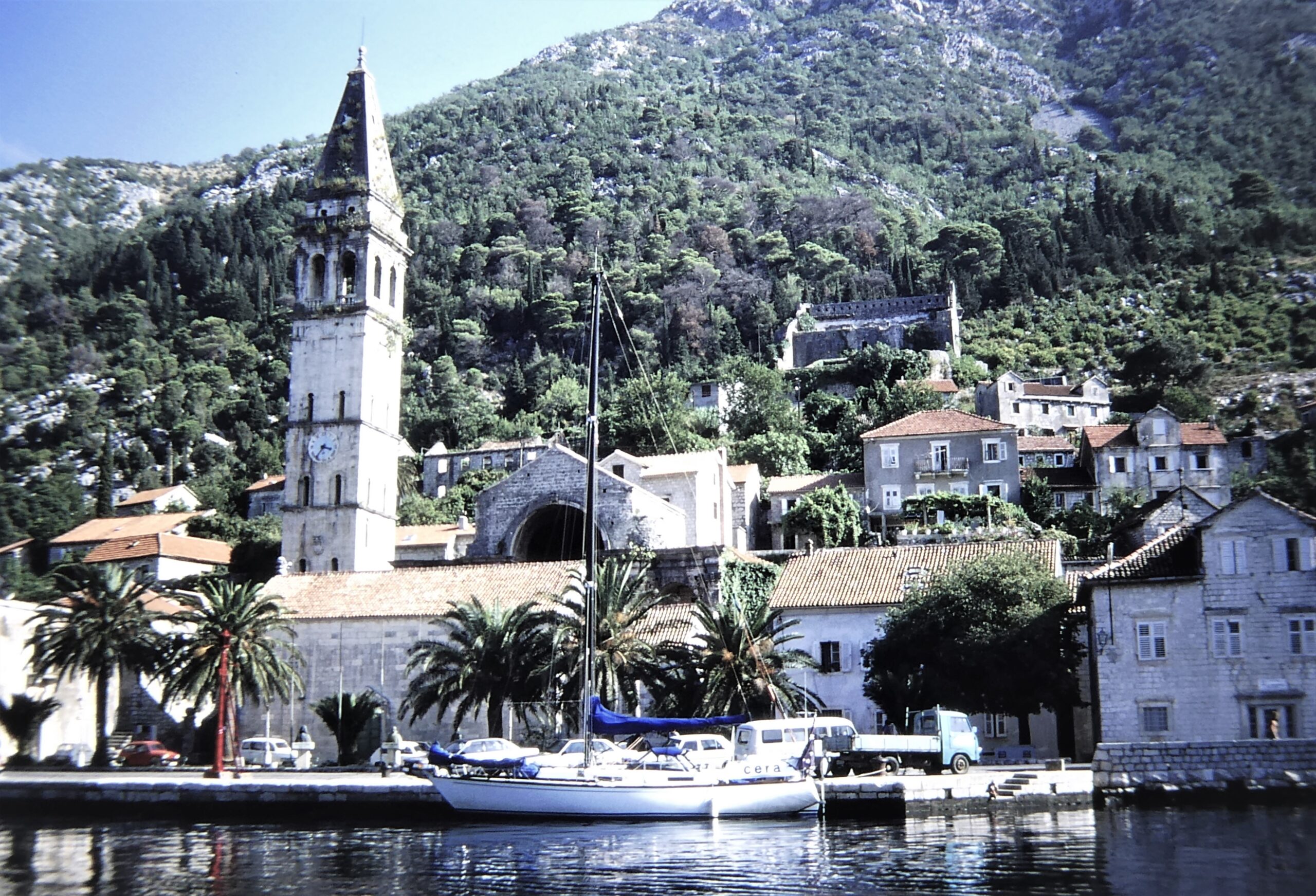
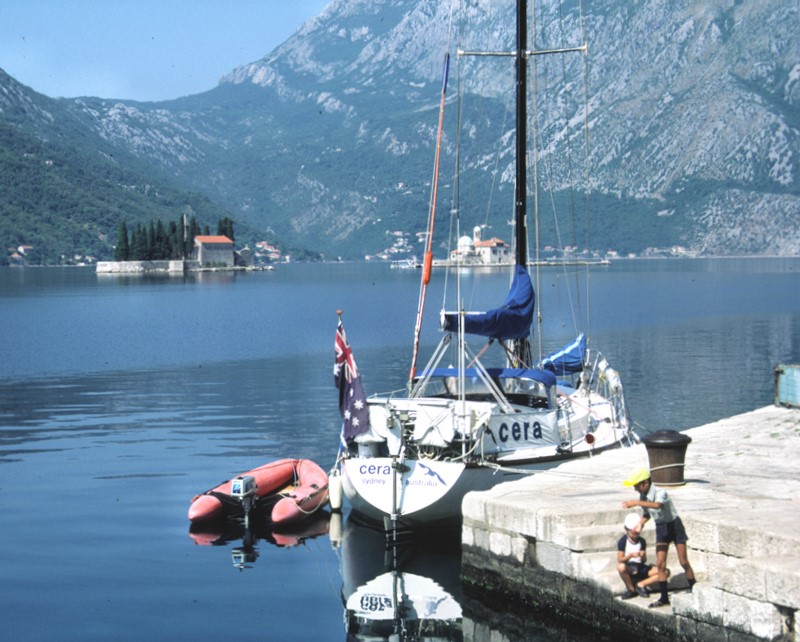 We then visited another town on the shores of the upper part of the gulf, Perast, an old maritime base and very pretty in a decaying sort of way. The buildings were mossy, many being just facades. The outlook was lovely, though, featuring two little islands with beautiful churches on them.
We then visited another town on the shores of the upper part of the gulf, Perast, an old maritime base and very pretty in a decaying sort of way. The buildings were mossy, many being just facades. The outlook was lovely, though, featuring two little islands with beautiful churches on them.
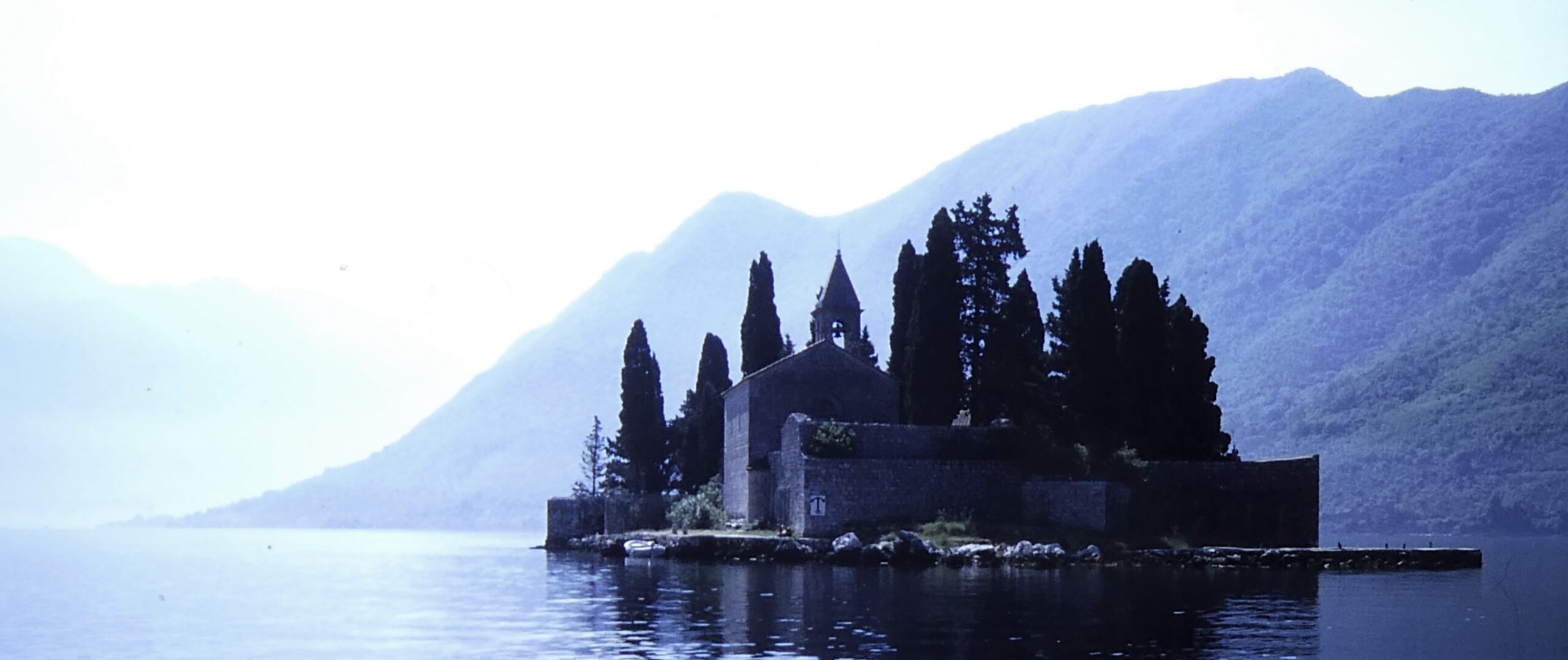 We tied to the quay and took the dinghy over to these
We tied to the quay and took the dinghy over to these 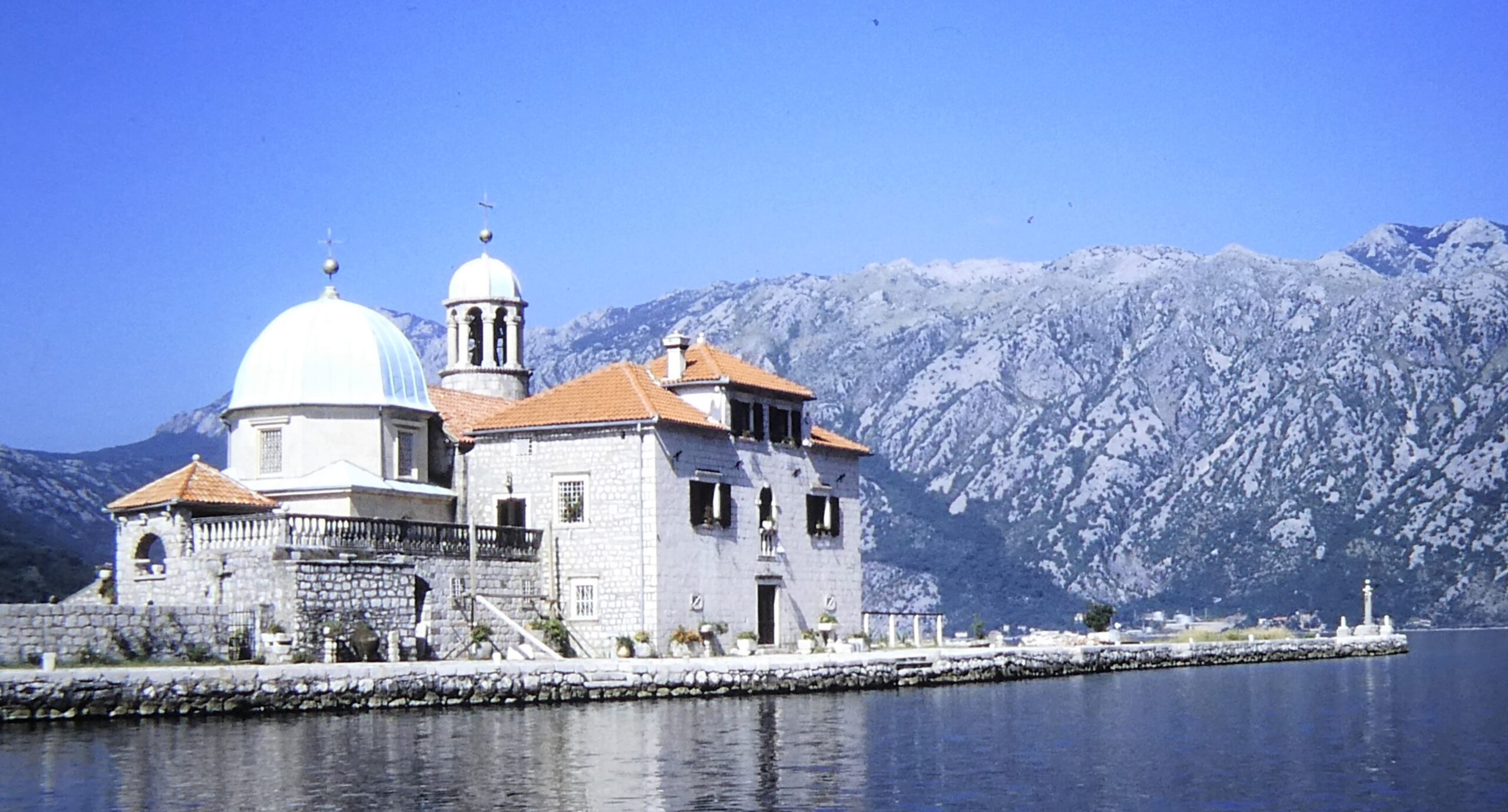 monastery islands. We went first to the island of Sveti Dorde (Saint George), with its church surrounded by cypresses. There was once a Benedictine abbey there, but it was twice sacked by the Turks and destroyed. We were escorted around by a young man, who we assumed was studying holy orders.
monastery islands. We went first to the island of Sveti Dorde (Saint George), with its church surrounded by cypresses. There was once a Benedictine abbey there, but it was twice sacked by the Turks and destroyed. We were escorted around by a young man, who we assumed was studying holy orders.
The other island, Gospa od Skrpjela (Our Lady of the Rocks), is artificial. It was created by the people of Perast dropping stones on a reef. Construction of the church began in 1630, and its interior is richly decorated with silver votive plaques and paintings. We were guided by a nun, who showed us an extraordinary collection of nautical bric-a-brac donated by seamen over many years.
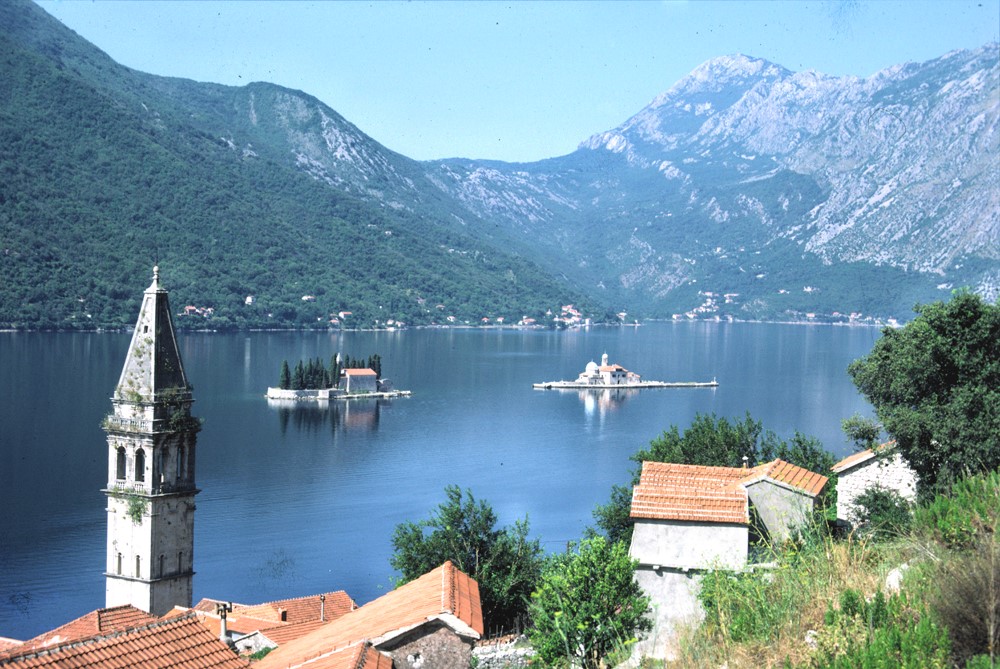
From Perast we moved south into the Kotorski Zaliv and the major town of Kotor, at its southern extremity. The mountains behind the town seemed even more craggy and steep, and amazing fortified walls climbed up and along them. We tied up on the town dock alongside the main street. We had to pay a small sum, but we were in good protection. Power and water connections were apparent, not functioning, but water available later.
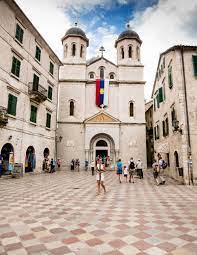
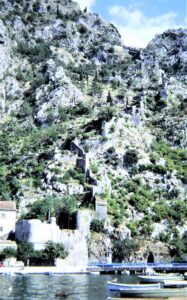
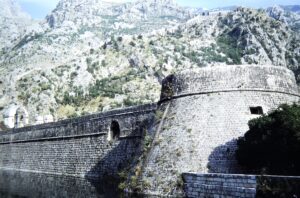 Kotor is another place with a history back to ancient times. It was a Greek settlement in the third century BC, and has been destroyed and rebuilt several times since then. The Venetians started building the present town walls in 1720 to protect the town against raiders, especially Turks and pirates. Walking into the walled old town, right across the road from us, we found that parts were being rebuilt yet again, this time because of recent earthquake damage. The costs were being borne by UNESCO. The old buildings were pleasant, while not spectacular. We did like a charming little Orthodox church, and we bought some local Orthodox music there. The evening was a sociable time, with lots of chatting with local passers-by, both local people and tourists.
Kotor is another place with a history back to ancient times. It was a Greek settlement in the third century BC, and has been destroyed and rebuilt several times since then. The Venetians started building the present town walls in 1720 to protect the town against raiders, especially Turks and pirates. Walking into the walled old town, right across the road from us, we found that parts were being rebuilt yet again, this time because of recent earthquake damage. The costs were being borne by UNESCO. The old buildings were pleasant, while not spectacular. We did like a charming little Orthodox church, and we bought some local Orthodox music there. The evening was a sociable time, with lots of chatting with local passers-by, both local people and tourists.
We organised a little rental car for the following day, and started our tour by taking the spectacular "old" road up the mountains 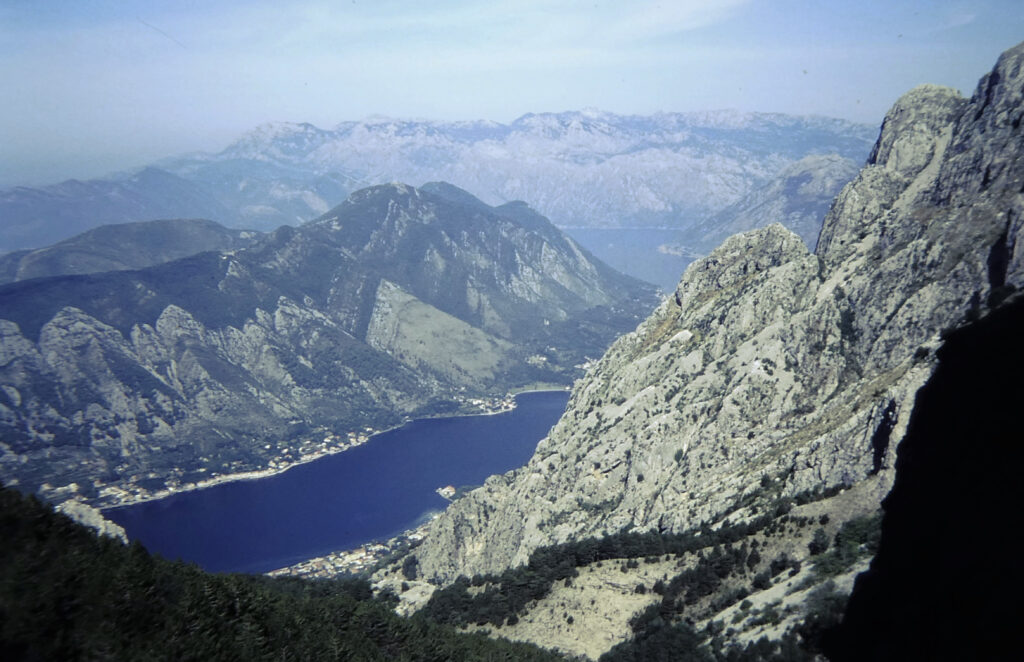 be
be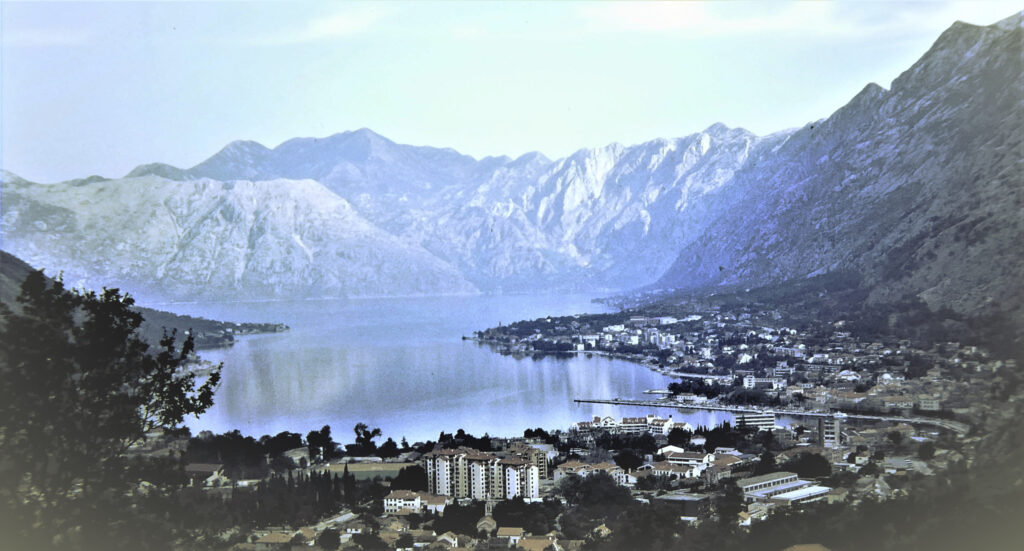 hind the town. The multiple hairpins through the increasingly rugged terrain were of Alpine standards, rendering some staggering views down to the gulf and the monastery islands. At the top, we drove across a wooded plateau to the town of Cetinje. It was still a lovely drive, along narrow roads with many steep drop-offs on the downhill side. Passing oncoming vehicle was hard. The approaches to the town, unfortunately, were strewn with garbage and the town itself was a mess, so we pressed on right to the top of Mount Lovcen. On the peak there is a mountain-top mausoleum designed by the Croatian sculptor Ivan Mestrovic for Njegos, Montenegro's Prince-Bishop, a ruler-poet of the 19th century. His works are widely considered to be some of the most important in Serbian literature.
hind the town. The multiple hairpins through the increasingly rugged terrain were of Alpine standards, rendering some staggering views down to the gulf and the monastery islands. At the top, we drove across a wooded plateau to the town of Cetinje. It was still a lovely drive, along narrow roads with many steep drop-offs on the downhill side. Passing oncoming vehicle was hard. The approaches to the town, unfortunately, were strewn with garbage and the town itself was a mess, so we pressed on right to the top of Mount Lovcen. On the peak there is a mountain-top mausoleum designed by the Croatian sculptor Ivan Mestrovic for Njegos, Montenegro's Prince-Bishop, a ruler-poet of the 19th century. His works are widely considered to be some of the most important in Serbian literature.
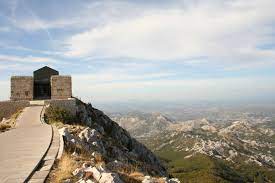
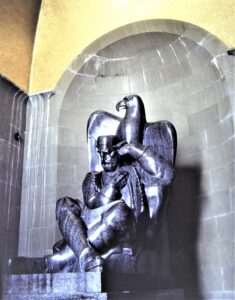 We walked up a tunnel to the mausoleum and to the highly impressive statue of Njegos, made from 28 tons of black marble, overlooking more magnificent views over Montenegran mountain country. We wound our way down along the high and narrow roads through tiny and generally decaying villages, some of the better houses looking Alpine, with steep roofs for the snow times. The local people, especially the men, looked like classically tough Balkan mountain fighters, with bristling moustaches and guns. One such stepped out, frowned, and waved us down to stop. We did so with some trepidation. He then grinned, and with some glee picked up a large snake that had been lying in the road ahead!
We walked up a tunnel to the mausoleum and to the highly impressive statue of Njegos, made from 28 tons of black marble, overlooking more magnificent views over Montenegran mountain country. We wound our way down along the high and narrow roads through tiny and generally decaying villages, some of the better houses looking Alpine, with steep roofs for the snow times. The local people, especially the men, looked like classically tough Balkan mountain fighters, with bristling moustaches and guns. One such stepped out, frowned, and waved us down to stop. We did so with some trepidation. He then grinned, and with some glee picked up a large snake that had been lying in the road ahead!
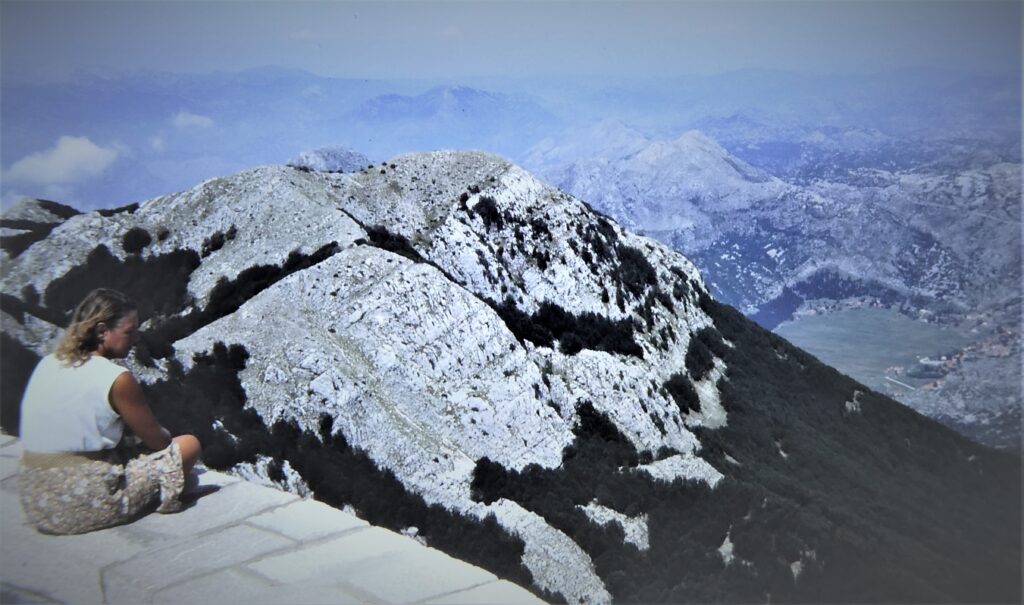 We continued east, by-passing the major town of Titograd, and came to a view from the mountains over Lake Skadar and the border with Albania.
We continued east, by-passing the major town of Titograd, and came to a view from the mountains over Lake Skadar and the border with Albania.
Returning, we drove down to the coast and Budva, another town being rebuilt after the recent earthquake. It was shut to visitors, and we stuck to the main road not far from the coast back to Kotor.
We sat there for a few more days because we had both caught colds, and then moved down to "our" favourite anchorage down in Krtole bay. From there, we could see the Njegos mausoleum perched high on the mountain-top we had just visited.
While returning with some regret to the open Adriatic Sea, in the lower reaches of the Kotor gulf we passed several obvious military areas, with tunnels into the rocky shores big enough to take small ships and, no doubt, submarines. We could see gun emplacements both on the hillsides and hilltops. We had been told to be aware of possible gunnery practice operations on the seaward side of the high land around the gulf, but also that warnings would be transmitted by radio. We had heard no such warnings, and having left the gulf we turned south down along the coast. Then we heard a loud "bang" from high on the hillsides! No problem, I assured Norma. They'll be practising with blank aretillery. Then we saw a big splash in the waters, well offshore of us. Accordingly, wasting no time I pushed the throttle lever to full ahead, escaping the area as quickly as possible!
Late in the afternoon we entered the harbour at Bar, close to the border with Albania. We needed to clear Customs to leave Yugoslavia, and this was the only place possible. We tied to the outer wall of an uncompleted new marina, and walked into the town, modern by Yugoslav standards, and obtained clearance from the marina harbourmaster for our passage south to Greece. The next day a strong southerly was forecast and we decided to wait it out. But a group of officials visited us and told us that we had to report to the main shipping port for formal clearance, and we had to take the boat round to do this. We had then to go through the whole health, Customs, immigration and crew list performance, for the first time since arriving in Yugoslavia from Venice, but "nema problema", as they say in Croatia.
We met a pleasant young German couple with a 30 foot yacht, and had them over for wines. She was not much enjoying the sailing life, and was very scared of the passage down to Greece. Albania, down which coast we must pass, was closed to all foreigners and approaching the coast was forbidden. Yachts had even been shot at. Both the sailing guides and the charts warned of the possibility of redundant WW2 mines that had been laid off the country's shores, and the advice was to stay at least 20 miles away from the shoreline. The heel of Italy and the coast of Albania are only 40 nautical miles apart across the Strait of Otranto, so significant care in navigation was to be required.
It was fine the next morning, with a favourable forecast, so we left early for what we anticipated would be an overnight sail down to Corfu. It was quite cool, and became very humid and muggy, even a bit foggy. We had to motorsail in a gentle sou-wester, and late in the afternoon we could see boiling cumulus exploding over the pollution-hazed Albanian coast to the east. During the night we were sailing on a beam reach in pitch dark, lit occasionally by thunderstorms astern. By mid-day we were approaching the channel between the island of Corfu and the southern-most shores of Albania, and soon came to the bay of Ayios Stephanos about half way down the strait.
Greece - the Ionians
Ayios Stephanos was an attractive little bay and harbour, wooded all round, with a few tavernas and shops ashore. We settled in simply for a sleep and a swim during a hot afternoon. But the next morning after a quiet night we had to press on down the short distance to the town and port of Corfu, as officialdom was wary of yacht movements because of the proximity to Albania. Albanian people were going to all kinds of effort to escape from their country, some even attempting to swim across. Riding on a yacht was easier.
The day was to turn out to be a rather trying one.
Our cruising guide advised that we should tie up at the fuel dock to enter the country and obtain our Transit Log. We were motioned away, however, and moved to a dock just to the east. But there, we touched bottom, so we went back to the furl dock and tied bow-to. There was little room, and we broke our bow navigation light on the mooring line for a naval patrol boat.
Ashore, we duly attended the Customs office, but . . . "too busy". There was also some issue relating to a strike. So we returned to the boat to wait, and Norma went off to do some shopping at a nearby small supermarket - well stocked by Yugo standards! We topped up water and fuel. Then back to Customs, and did this time get through all the paperwork with the port Captain and immigration officials. Their attitude was friendly enough but disinterested.
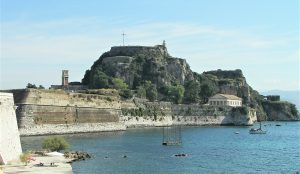 We left the inner harbour with some relief, and moved round close to the other side of a little peninsula on which sat an impressive citadel. The anchorage would have been fine, but we got tangled up with fishing nets and moved again further to the south and a wider open part of the bay. There were still lots of nets around, but a bit more space. We were glared at by the fishermen.
We left the inner harbour with some relief, and moved round close to the other side of a little peninsula on which sat an impressive citadel. The anchorage would have been fine, but we got tangled up with fishing nets and moved again further to the south and a wider open part of the bay. There were still lots of nets around, but a bit more space. We were glared at by the fishermen.
The town was quieter than expected, but there were still plenty of tourists, overwhelmingly British. There were no decent food shops. We thought it was a scruffy place, with peeling walls, kitchy tourist shops, ritzy bottle shops. The local people looked morose.
 The scores of ferries going up and down just off the bay led to an uncomfortable night. We left early and moved on down between Corfu and the mainland, and on the latter shores came to anchor in a bay off Mourtos village. We walked into the bigger village of Sivota, which we thought had a wild-west look about it. The many scattered offshore islands were wooded and green, but the mainland hills brown, with scattered olive groves. We bought enough supplies to have an excellent Greek lunch aboard. During a peaceful afternoon we could hear the sounds of farmyards in the hillsides, bleating goats, cockerels, bells.
The scores of ferries going up and down just off the bay led to an uncomfortable night. We left early and moved on down between Corfu and the mainland, and on the latter shores came to anchor in a bay off Mourtos village. We walked into the bigger village of Sivota, which we thought had a wild-west look about it. The many scattered offshore islands were wooded and green, but the mainland hills brown, with scattered olive groves. We bought enough supplies to have an excellent Greek lunch aboard. During a peaceful afternoon we could hear the sounds of farmyards in the hillsides, bleating goats, cockerels, bells.
After a quiet night (for a change) we happened to see an octopus swimming past, and jigged for it - successfully! It was very reluctant to be restrained, but ended up in a plastic bag in the wok with the lid strapped down. Later, we took it ashore for the Greek-style whacking it on a rock to start the tenderising process. It made a delicious dinner with hot peppers.
From there it was a short distance offshore to the south to the island of Paxos, the northernmost of the Ionian islands. At its north end is the almost landlocked Lakka bay. We had a swim to clean off the hull, by this time looking very good.
The bay looked well protected but the strong afternoon sea breeze brought in a considerable swell, so we moved off for a quick 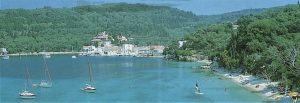 motorsail round the north-east coast of Paxos to another bay at its southern end adjacent to Mongonisi island, with little room to anchor but with much better protection. We took a pretty walk along the winding coastal road for the couple of miles or so up to the main town and harbour of Gaios, where we got some bread and cheese - served after the local people, as usual. We shared the evening meal with a couple of young Australians.
motorsail round the north-east coast of Paxos to another bay at its southern end adjacent to Mongonisi island, with little room to anchor but with much better protection. We took a pretty walk along the winding coastal road for the couple of miles or so up to the main town and harbour of Gaios, where we got some bread and cheese - served after the local people, as usual. We shared the evening meal with a couple of young Australians.
We then had a good sail by Med standards further south to the northern entrance to the Levkas Canal. Levkas is an island only because of the canal that separates it from the mainland. The canal was cut just after the turn of the century by the Greek government, although earlier canals had been built by the Corinthians around the 7th century BC and by Augustus during the Roman occupation. The main town of Levkas is sited at a bend in the canal, and in common with many other towns on this earthquake belt was rebuilt after the 1953 earthquake.
The entrance to the canal was hard to see, and we had to stop and wait for a chain ferry to cross, in gusty winds. Just beyond the ferry was a bridge made of a big barge with lifting ramps at its ends. After the ferry had stopped and the barge ramps opened, we were free to pass through a narrow gap and at last into the canal.
We passed the town of Levkas, not an attractive looking place but several yachts were moored there. Down the canal we passed several salt flats with green slopes up behind them. At the southern end of the canal we came across our friends in Denali, and we agreed to meet with them at a tiny inlet to the south, Vathi-Vali. Since we'd last seen them they had taken a trip back to California and returned to cruise mainly in Italy. They reported having come across Bill and Eileen in Aurora, who were on their way to the south of France.
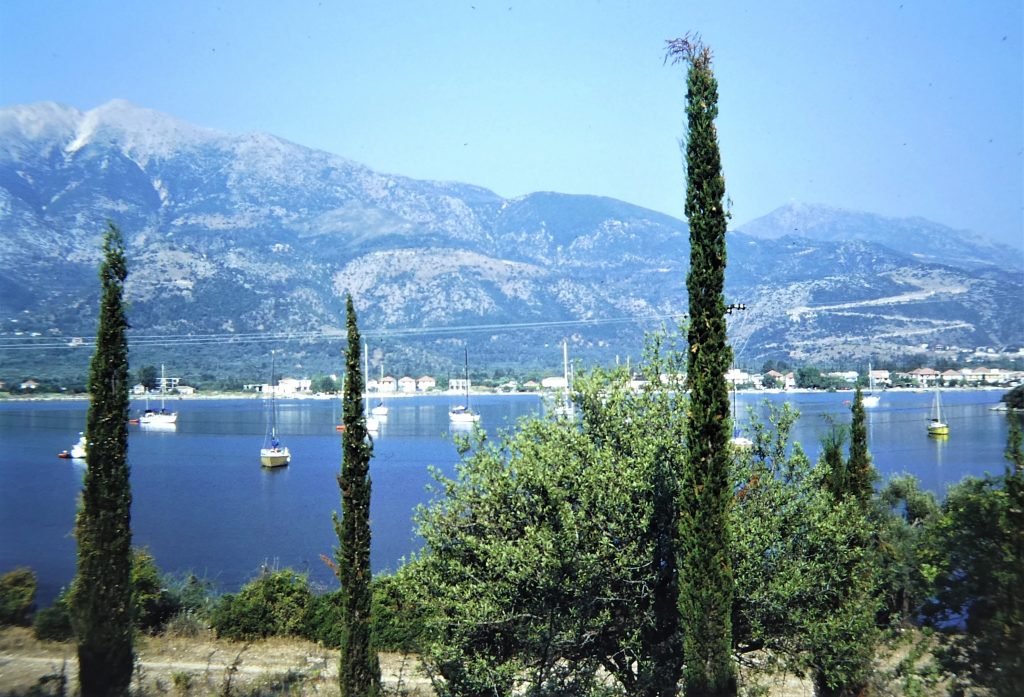 After a peaceful night we motored across to Nidri, half way down on the eastern side of Levkas island. A little further and we entered a bay within a bay. It was a beautiful approach to the well-protected anchorage on the inner side of a tongue of land facing the Levkas "mainland", overlooked by green and grey mountainsides. We anchored just off the shores of the densely wooded green island, opposite the town. We later learnt that this was a favoured place for some who wintered over in Greece, and when sitting in this bay within a bay within a bay, we could see why.
After a peaceful night we motored across to Nidri, half way down on the eastern side of Levkas island. A little further and we entered a bay within a bay. It was a beautiful approach to the well-protected anchorage on the inner side of a tongue of land facing the Levkas "mainland", overlooked by green and grey mountainsides. We anchored just off the shores of the densely wooded green island, opposite the town. We later learnt that this was a favoured place for some who wintered over in Greece, and when sitting in this bay within a bay within a bay, we could see why.
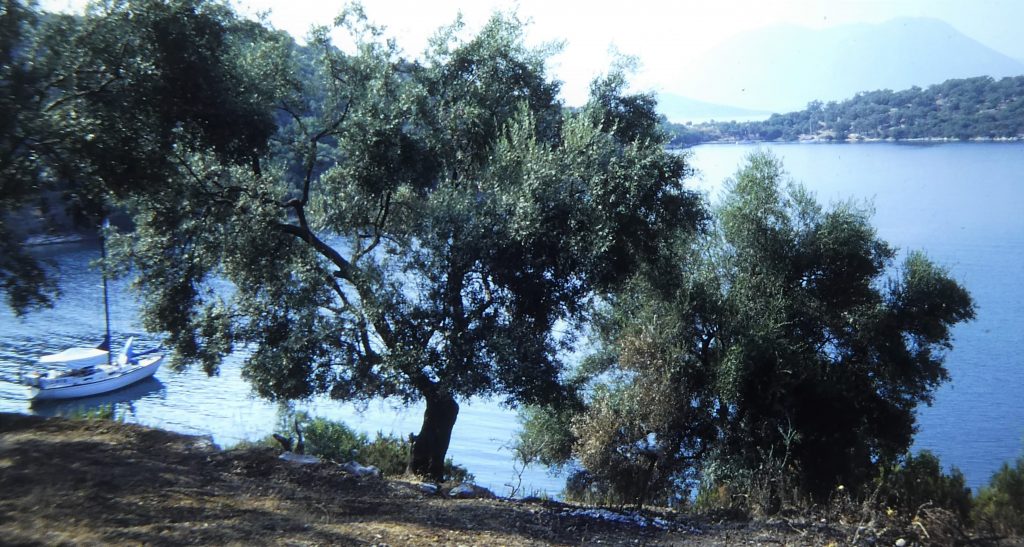 Nidri was a classic small Greek harbourside town, with a lovely outlook over the multiple offshore islands. There were few land-based tourists, but masses of small yachts in charter flotillas, most with British guests. The shops were adequate, and English was spoken in most of them. We liked the place and the anchorage, but had to keep moving, and pressed on south. We motored past Scorpios island, the private island of the late Aristotle Onassis, thick with flowers, shrubs and trees because it had been planted out as a park.
Nidri was a classic small Greek harbourside town, with a lovely outlook over the multiple offshore islands. There were few land-based tourists, but masses of small yachts in charter flotillas, most with British guests. The shops were adequate, and English was spoken in most of them. We liked the place and the anchorage, but had to keep moving, and pressed on south. We motored past Scorpios island, the private island of the late Aristotle Onassis, thick with flowers, shrubs and trees because it had been planted out as a park.
A little further south we came to Meganisi island and anchored in an un-named bay just west of Abeliki Bay. This was another lovely and peaceful anchorage. In continuing beautiful cloudless weather we walked ashore over red soil, through silvery green olive groves and cypress trees. We passed the heads of several other bays, where we were pleased to see all the charterers had chosen to moor.
The next stop in the Ionians was at Kalomo island, and Port Leone on its eastern side. We anchored in a cove to the north-west of a church on a little headland. The "port" of Leone was a small and now deserted village, with an abandoned olive mill. There were a handful of small yachts on a quay by the village, and we were disappointed to see piles of rubbish left by these visitors under the graffiti appealing, "Keep this place clean". They soon left. We walked around on some donkey tracks and had a swim from the boat afterwards. In the evening we watched an amazing parade of sheep down to the village from over the hill to feed on the hay left there by a visiting caique. The sound of bells continued overnight, as the sheep settled down in the abandoned houses. We were left completely alone in our delightful cove.
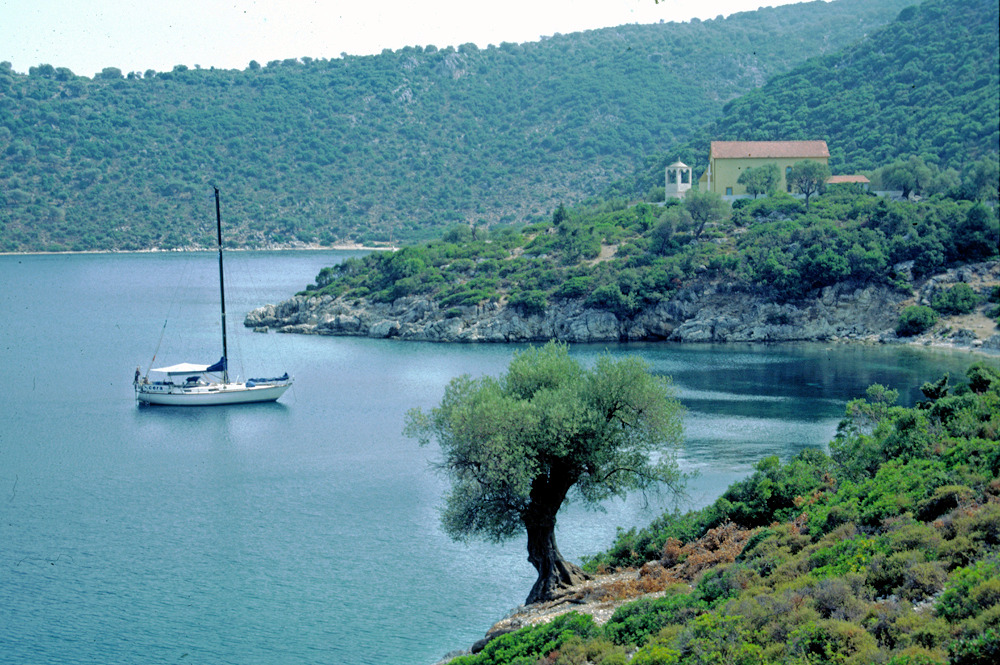 We left the next afternoon and moved over to mainland Greece and the sheltered but otherwise uninteresting bay of Port Pandelamona, once again by ourselves, and in the sound of bells - for cows this time. After a peaceful night we motored over to
We left the next afternoon and moved over to mainland Greece and the sheltered but otherwise uninteresting bay of Port Pandelamona, once again by ourselves, and in the sound of bells - for cows this time. After a peaceful night we motored over to 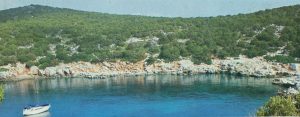 uninhabited Provati island for lunch and a swim, and on again to the wild-looking Petala island. Here we anchored under jagged cliffs, with caves occupied by intrepid goats.
uninhabited Provati island for lunch and a swim, and on again to the wild-looking Petala island. Here we anchored under jagged cliffs, with caves occupied by intrepid goats.
Leaving the Ionians we had an unexpectedly good sail, turning east away from the Ionian islands and into the mouth of the Gulf of Corinth. We had to use the motor to enter the channel through salt marshes that would take us up to the town and harbour 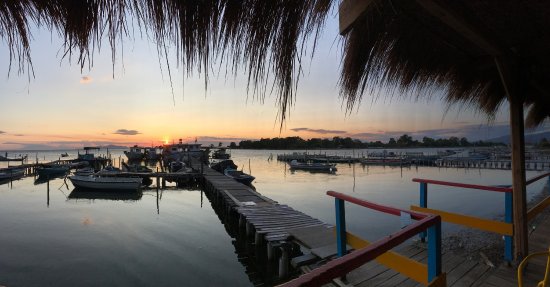 of Mesolongion, or Missilonghi. Around the channel entrance was a collection of fishermen's houses on stilts, looking like houses in Australian flood plains and along the Florida waterways. The harbour was a featureless dredged square, with the town set a way from the back. The large area of salt flats was backed by a mountain range. We anchored in the harbour, three other yachts lay alongside the harbour wall. It was still very hot.
of Mesolongion, or Missilonghi. Around the channel entrance was a collection of fishermen's houses on stilts, looking like houses in Australian flood plains and along the Florida waterways. The harbour was a featureless dredged square, with the town set a way from the back. The large area of salt flats was backed by a mountain range. We anchored in the harbour, three other yachts lay alongside the harbour wall. It was still very hot.
Ashore for shopping in the morning, we found a run-down town, separated from the harbour by wide deserted streets. Sufficient provisions were available, with plenty of fruit and veg. Well-trained sheep with bells came down to the harbour in the evening.
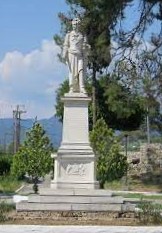 The town is known for its association with the poet Lord Byron, who died there in 1824, but there was little to remind us of this association. There is an obelisque and a statue of the poet in the town, and a museum commemorating its siege during the 19th century Greek War of Independence (from the Ottoman empire). The philhellene Byron supported the Greek struggle for independence. The massacre of its inhabitants by the Turkish-Egyptian forces in the siege led to the town receiving the honorary title of Hiera Polis (the Sacred City), unique among Greek cities.
The town is known for its association with the poet Lord Byron, who died there in 1824, but there was little to remind us of this association. There is an obelisque and a statue of the poet in the town, and a museum commemorating its siege during the 19th century Greek War of Independence (from the Ottoman empire). The philhellene Byron supported the Greek struggle for independence. The massacre of its inhabitants by the Turkish-Egyptian forces in the siege led to the town receiving the honorary title of Hiera Polis (the Sacred City), unique among Greek cities.
Our the first try at leaving for Patras was aborted, as we encountered strong easterly winds and a horribly choppy sea. So we spent another night in the harbour and then successfully, but still uncomfortably, crossed the Gulf of Patras to the Peloponnese and to the major city of Patras, the third largest in Greece. It's not much of a harbour for small boats, being built along the seashore and simply protected by a long, large breakwater. We tied bow-to to a wharf designated for yachts, and had a walk around the town. We got good supplies at a corner store. The place was just a big, noisy city, with motorcycles rushing up and down the wharf and lots of ferries and working craft kicking up an uncomfortable chop. We were visited in the evening by a Greek Australian, who stayed to drink a bottle of wine, but who was also rendered some interesting insights into Greece's relationship with Australia - where, he said, his relatives were "all rich".
We left early the next day and soon passed through the mile-wide pass between the Gulf of Patras and the Gulf of Corinth. Venetian forts sit on each headland, and the waters were busy with ferries crossing to and fro. Soon after we passed the very pretty little harbour of Navpaktos, which we deemed too small and packed for us to get in with any comfort.
About five nautical miles further along the northern side of the gulf we pulled into a sheltered bay on the eastern side of the small island of Trizonia. It was hard to see from a distance, because its wooded rise merges with the wooded hills on the nearby mainland.

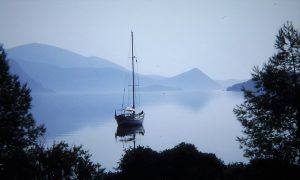 Trizonia turned out to be a great place for rest and recovery. There was a small hamlet on the northeast side of the bay and cultivated fields around. It was quiet except for the friendly sounds of donkeys and cockerels. During our first morning we met some travellers - a Qantas crew and an English couple from Salcombe - and Spiro from Melbourne, with whom we had an ouzo. He was over for some months, dealing with family matters; he told us he was in real estate, where in Australia, he said, "it's booming" - another local "missing out" on Austrralia!
Trizonia turned out to be a great place for rest and recovery. There was a small hamlet on the northeast side of the bay and cultivated fields around. It was quiet except for the friendly sounds of donkeys and cockerels. During our first morning we met some travellers - a Qantas crew and an English couple from Salcombe - and Spiro from Melbourne, with whom we had an ouzo. He was over for some months, dealing with family matters; he told us he was in real estate, where in Australia, he said, "it's booming" - another local "missing out" on Austrralia!
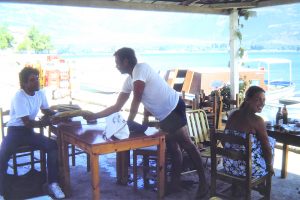 We had beer and a meze with Ion and Smiley, an Anglo-Greek couple who had established a small restaurant and bar that was referred to as the "yacht club" and who were very friendly to the yachties. Everyone we met was cheerful and happy, not always found in Greece, but partly because the tourist season was nearly over. Grapes were being gathered, brought into the village by donkey and pressed in several presses around the village. In the evening we visited Ion and Smiley's place for drinks and a meal. Taking in the great view over the bay and the boat, we were the only customers in a most pleasant evening, learning a lot about Greece and the Greeks.
We had beer and a meze with Ion and Smiley, an Anglo-Greek couple who had established a small restaurant and bar that was referred to as the "yacht club" and who were very friendly to the yachties. Everyone we met was cheerful and happy, not always found in Greece, but partly because the tourist season was nearly over. Grapes were being gathered, brought into the village by donkey and pressed in several presses around the village. In the evening we visited Ion and Smiley's place for drinks and a meal. Taking in the great view over the bay and the boat, we were the only customers in a most pleasant evening, learning a lot about Greece and the Greeks.
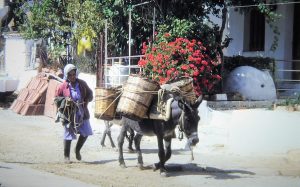 During the following days we spent much time with the couple and with other
During the following days we spent much time with the couple and with other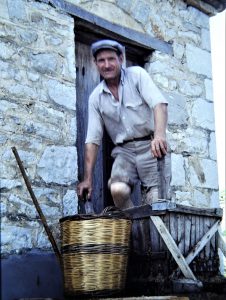 visitors, including the yachties, talking, sharing meals and walks, and helping some set their anchors - the holding was good, but only when the anchors had been manoeuvred through the thick weed. The only way we could help to get an English boat with engine problems and rather light ground tackle to stop dragging was to suggest laying two anchors in line, which worked.
visitors, including the yachties, talking, sharing meals and walks, and helping some set their anchors - the holding was good, but only when the anchors had been manoeuvred through the thick weed. The only way we could help to get an English boat with engine problems and rather light ground tackle to stop dragging was to suggest laying two anchors in line, which worked.
We watched grapes being trodden in traditional style, and learnt that the second pressing, in the presses we had observed soon after arriving, was the start of the process in making pure spirit, which was illegal.
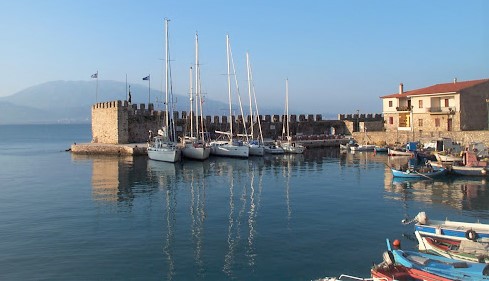 With Ion we took a water taxi and a taxi across to the mainland and to Navpaktos for some shopping. The town was just a simple town of no great attraction, and even the harbour that had looked so good - albeit busy - from the sea was something of a disappointment. The old harbour walls and fortifications were impressive, but looked run down and neglected. It just hasn't fallen down yet, commented Norma.
With Ion we took a water taxi and a taxi across to the mainland and to Navpaktos for some shopping. The town was just a simple town of no great attraction, and even the harbour that had looked so good - albeit busy - from the sea was something of a disappointment. The old harbour walls and fortifications were impressive, but looked run down and neglected. It just hasn't fallen down yet, commented Norma.
The weather was generally variable and often windy and stormy, so we were happy to wait in this great anchorage for a good westerly to take us further along the coast. Finally after leaving we had a fast sail to Anemokambi Bay, where we settled into an inlet in its south-west corner. It was a barren part of the world, with the surrounding hills of reddish rocks coloured by bauxite. No-one else was there except for a few local people catching octopus from the rocky shore.
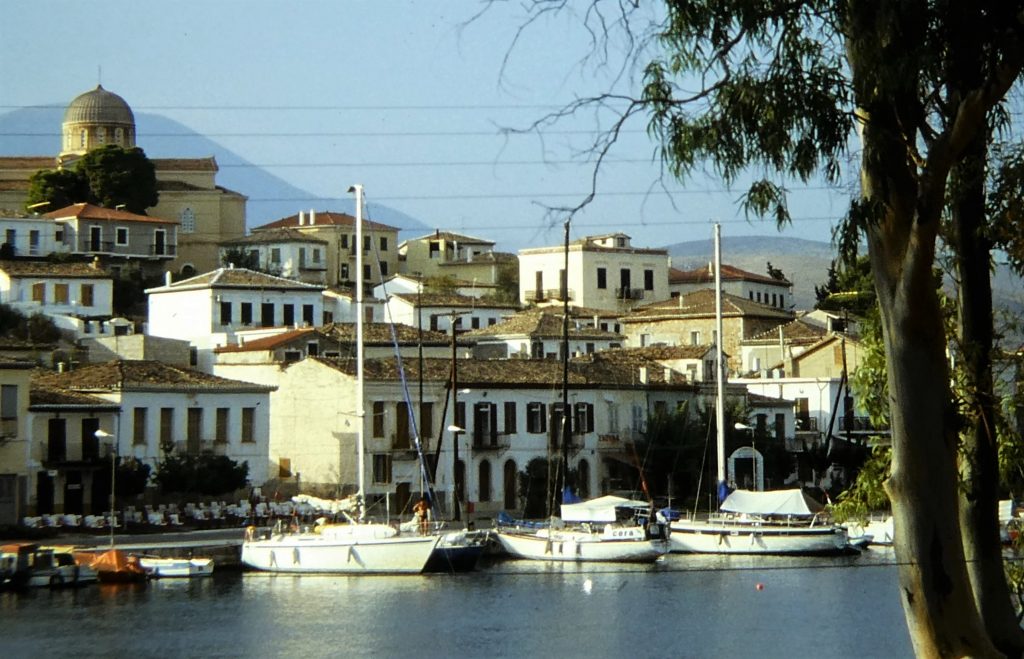 After lunch the following day we motored the short distance round a headland to the north and to the harbour in the heart of the town of Galaxidhi. We tied up bow-to on the town's waterfront road, helped by an uncommunicative Frenchman. It was a pleasant enough mooring, but the road and the tavernes right across from us threatened some noisy evenings. We walked around the town, which was under some kind of "proclamation" that limited the extent of development permitted. It therefore looked very traditional, with colourful shutters Greek style, all shut, Greek style.
After lunch the following day we motored the short distance round a headland to the north and to the harbour in the heart of the town of Galaxidhi. We tied up bow-to on the town's waterfront road, helped by an uncommunicative Frenchman. It was a pleasant enough mooring, but the road and the tavernes right across from us threatened some noisy evenings. We walked around the town, which was under some kind of "proclamation" that limited the extent of development permitted. It therefore looked very traditional, with colourful shutters Greek style, all shut, Greek style.
In the early evening a big yacht under charter to eleven German men backed in beside us. On the way they ran over a floating line - I had shouted a warning but they did not hear or respond. In fact, they were being called in by a port policeman, who had either not seen - or not chosen to see - the line. (We had already met this surly character, who had abruptly asked to see our "papers" and the name of "your woman".)
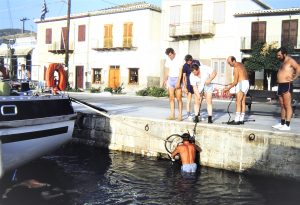 Inevitably the German boat had cut the line, which caused all sorts of arguments on the dock. A local man (with a BMW) claimed that he owned the mooring, which they had damaged. The Germans reset their stern anchor, and backed again into the floating line and wound it all in around their propeller. We met them later for a salad at a poor restaurant on the dockside. By that time they were being hassled to employ a diver to clear the propeller, which we suspected was all part of a scam, but one of them could dive and I volunteered to help him clear the prop in the morning.
Inevitably the German boat had cut the line, which caused all sorts of arguments on the dock. A local man (with a BMW) claimed that he owned the mooring, which they had damaged. The Germans reset their stern anchor, and backed again into the floating line and wound it all in around their propeller. We met them later for a salad at a poor restaurant on the dockside. By that time they were being hassled to employ a diver to clear the propeller, which we suspected was all part of a scam, but one of them could dive and I volunteered to help him clear the prop in the morning.
We found a mass of rope, chain and a grapnel anchor wrapped round the prop and shaft, and it took us more than half an hour to cut, unwind and clear the mess. I had a hot shower on their boat, and we were two bottles of whisky richer!
We took a bus to the ancient stadium and archeological site of Delphi. In an amusing episode on the bus, we got talking with an Australian woman with her young daughter. They were intrigued by our travels and adventures, and explained that we had not been home for six years. In broad Strine the girl commented, "well, you've got a terrible accent!"
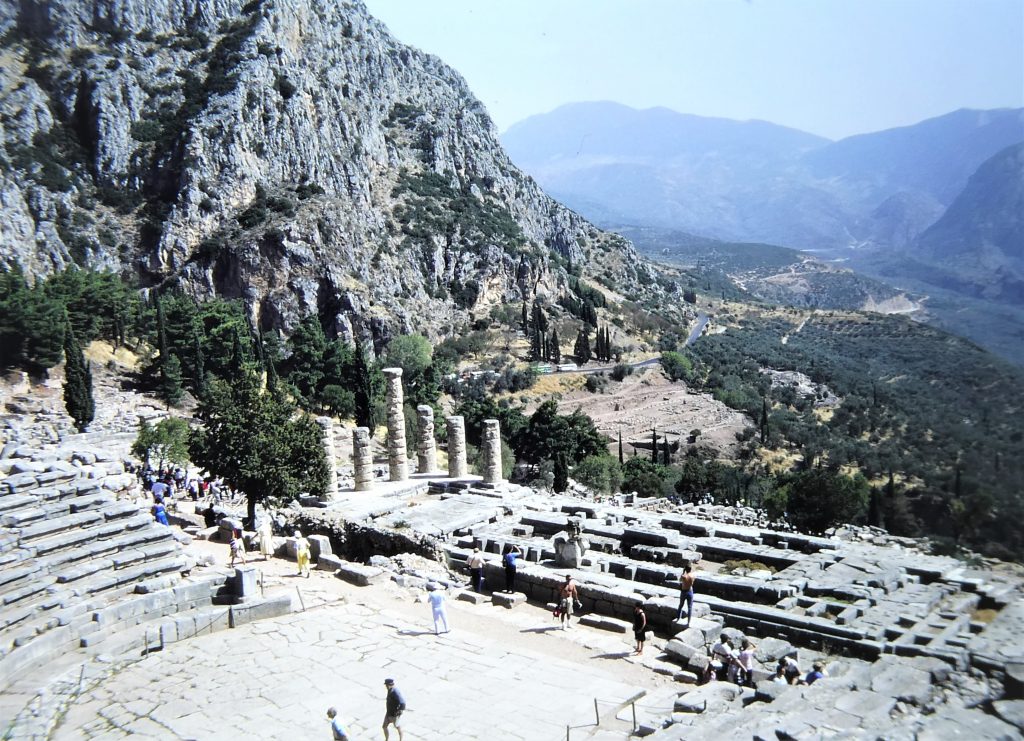 The bus ride took us round several bays lined with red, dusty bauxite workings and then up on a spectacular road into the foothills of Mount Parnassus. We stopped at Delphi town and visited the museum there, with well-displayed statues and friezes from buildings. The depth of information, however, was limited.
The bus ride took us round several bays lined with red, dusty bauxite workings and then up on a spectacular road into the foothills of Mount Parnassus. We stopped at Delphi town and visited the museum there, with well-displayed statues and friezes from buildings. The depth of information, however, was limited.
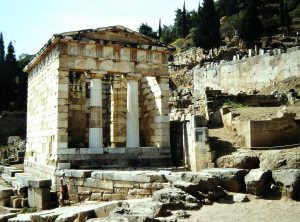 The famous archeological site, however, was wonderful to see, with its beautiful views over the valley with its solid mass of large, old, olive trees. It was regarded by the ancients as the centre of the world. Its spectacular site among ravines, rocky cliffs on the side of the mountain contributes to its air of mystery. It takes its name from Apollo Delphinus, when God was worshipped in the guise of a dolphin. The Delphic oracle was famous throughout Greece, being regarded as more reliable than most.
The famous archeological site, however, was wonderful to see, with its beautiful views over the valley with its solid mass of large, old, olive trees. It was regarded by the ancients as the centre of the world. Its spectacular site among ravines, rocky cliffs on the side of the mountain contributes to its air of mystery. It takes its name from Apollo Delphinus, when God was worshipped in the guise of a dolphin. The Delphic oracle was famous throughout Greece, being regarded as more reliable than most.
We visited all the main monuments, of course, including the Temple of Apollo, the Athenian Treasury, the theatre and the stadium. It was very hot and hard going along stony paths on steep slopes.
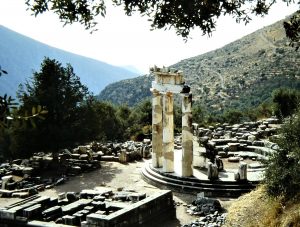 Coming down we had a welcome drink at the natural spring, and visited the gymnasium and the Temple of Marmarins, a very pretty circular building of unknown purpose.
Coming down we had a welcome drink at the natural spring, and visited the gymnasium and the Temple of Marmarins, a very pretty circular building of unknown purpose.
We took the bus back and went to dinner with a group of Australians and Canadians renting a house in the town for five months and thinking of buying locally. Not that late, we collapsed on the boat after a hard but interesting and pleasant day.
We waited for the trough to move through while we did some more socialising, and when the forecast was for fine weather we left for the town of Corinth, at the very head of the gulf at its eastern end. The course was south-east and the distance about 40 nautical miles, so inevitably about half way we found ourselves plugging into an ESE wind that was backing to the east. Either way, it was wet going, battling into the square, white-topped waves so typical of the Mediterranean. From the chart, the harbour at Corinth did not look at all pleasant in these conditions, being wide open to the east. We tied up alongside the inner side of the harbour wall in front of a Dutch boat.
We walked into the town looking for a place to change money to pay for the transit through the Corinth Canal. The only possible place in the unpleasant town was shut. The port captain, who gave us instructions for the transit the next day, was a typically surly official. But after a disturbed night in the sloppy waters we did manage to change some money and do some surprisingly good shopping. We were then away, and joined a convoy of yachts following a ship through the canal.
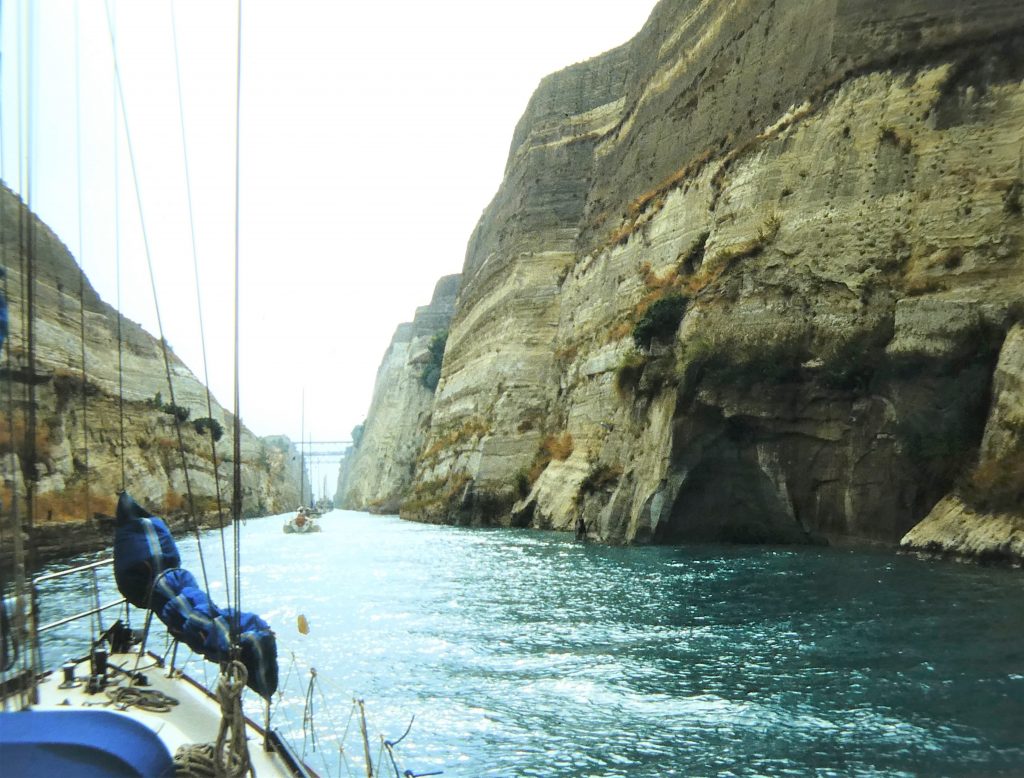
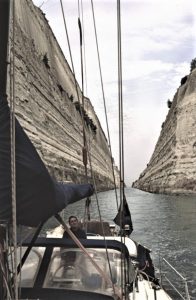 The passage through is memorable, as was the Panama canal passage, but this was a lot more expensive - three times as much, for about three miles! It's an amazing experience, though, as by half way, with the ship high in front, the cliffsides rise even higher each side. We felt very small, and the canal seemed to us much narrower than the nominal 81 feet.
The passage through is memorable, as was the Panama canal passage, but this was a lot more expensive - three times as much, for about three miles! It's an amazing experience, though, as by half way, with the ship high in front, the cliffsides rise even higher each side. We felt very small, and the canal seemed to us much narrower than the nominal 81 feet.
After passing out of the eastern end of the canal we were required to tie up at a dreadfully high and dirty wharf to pay the transit fee. We pulled away into the persisting easterly wind, with a substantial sea running on this, the Aegean side of the isthmus. We motored out only a couple of hours or so after leaving Corinth harbour and bashed into the steep swell in cloudy, humid conditions. We made it to Frangolimani Bay, a nearly landlocked and undeveloped bay on the Aegean coast some seven nautical miles from the canal. We tucked in by ourselves in the innermost inlet, not a brilliant anchorage but acceptable considering the heavy swell outside.
The next morning was still wet and windy, but the glass was climbing and the air clearer. We motored along the swell around a substantial headland and into the more substantial harbour at Korfos, and anchored with bow and stern anchors in the north-east corner in as protected a position as possible. We took the dinghy ashore to the village, where everything was shut but an old man turned on the lights in the minimarket to sell us some wine. We took a more substantial walk the next day. The village was a typically Greek mixture of skeletal concrete frames and half-finished - but occupied - dwellings. Gales were now well established in the whole eastern Mediterranean, with the airstream forced between two weather systems.
We had to go to Athens to do some business, and had a busy day doing so. We missed the morning bus, having been given the wrong time by a neighbouring Dutch boat, but hitched a lift to catch another bus to Corinth. From there we caught the Athens bus, taking us along the coast road, enjoying the spectacular views of the Corinth Canal and then over the waters between the mainland and Salamis. Scores of ships were rafted up near big shipyards. The Athens bus station was miles out of town, so we jumped the taxi queue that we were otherwise doomed to remain at the back, and took a taxi into the city.
In Omonia Square our taxi and another taxi came into collision, and the drivers started a shouting match. Norma and I looked each other, nodded, opened our doors and departed the scene as quickly as possible. We walked the rest of the way to Sintagma square and the Amex agency. We picked up a pile of mail and some money. I booked a flight to London in eleven days time.
We had a great lunch of lamb in eggs and lemon, with stuffed aubergines, salads and beer, for a very reasonable price. After that, it proved impossible to catch a taxi to the bus station - there were scores of taxis but all full or empty but not interested. We walked to the railway station, but the train trip plus the waiting time would take a lot longer than the bus - so, we walked (literally) miles out to the bus station and got the 4:00pm bus back to Corinth. Getting to Korfos by public transport would be the next problem, so we bit the bullet and took a posh Mercedes taxi back to the port.

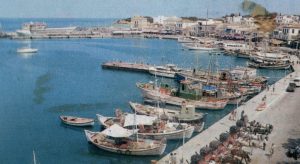 We needed another day to sit out the strong winds, then left on a calm, clear morning with a rising barometer and a favourable weather map. By mid-day we tied up in the harbour on the big island of Aegina, in the centre of the Saronic Gulf in the northern Aegean. This was one of the places we were considering as a possible base for the fast-arriving winter. It immediately struck us as a noisily busy harbour, there were not many places to tie up - let alone for a long time - and the shops were not brilliant. The anchor holding was poor. Accordingly we moved out again after a couple of hours, and motored the short way down to the harbour on the nearby island of Methana, linked by a narrow isthmus to the Peloponnesian coast. This was another possible wintering place. We tied bow-to on the inner side of the harbour wall.
We needed another day to sit out the strong winds, then left on a calm, clear morning with a rising barometer and a favourable weather map. By mid-day we tied up in the harbour on the big island of Aegina, in the centre of the Saronic Gulf in the northern Aegean. This was one of the places we were considering as a possible base for the fast-arriving winter. It immediately struck us as a noisily busy harbour, there were not many places to tie up - let alone for a long time - and the shops were not brilliant. The anchor holding was poor. Accordingly we moved out again after a couple of hours, and motored the short way down to the harbour on the nearby island of Methana, linked by a narrow isthmus to the Peloponnesian coast. This was another possible wintering place. We tied bow-to on the inner side of the harbour wall.
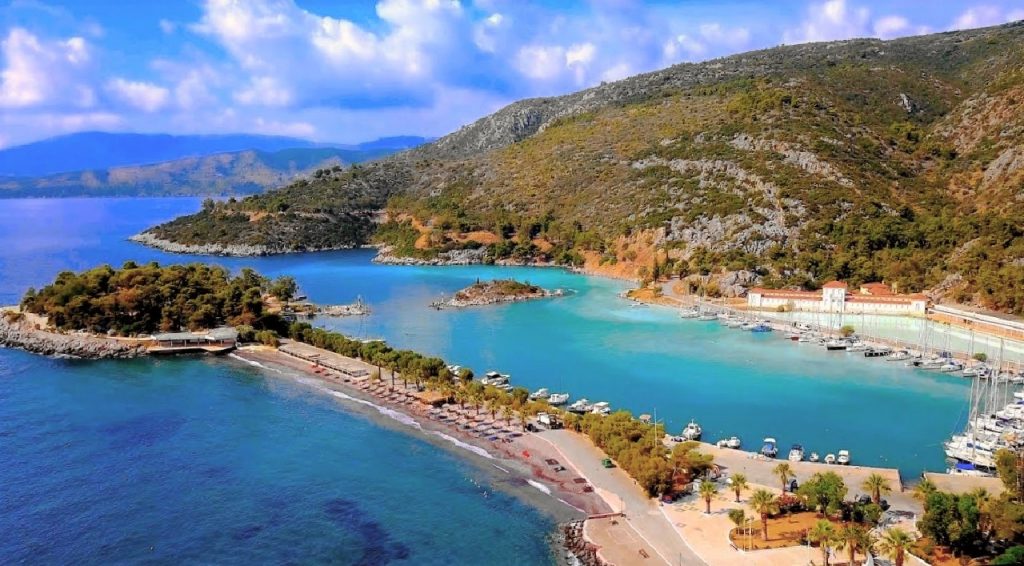 Methana is famous for the smell of hydrogen sulphide, rising from underground volcanic ground, and the buildings on the west side of the harbour house sulphur baths aiming for the cure of rheumatic conditions. The harbour water is just as sulphuric, and if you are game enough to over-winter here it is said that the underwater hull remains clean. As it happens, although Norma has a good sense of smell, we did not find it overwhelming. There is a one-horse town here, and the hydro baths were looking a bit run down. Nothing much was happening, and there were no tourists and few yachts - quite a change from Aegina! We did some boat maintenance and clothes washing. In summary, it might have been a place to leave the boat, but not one for living on for several months
Methana is famous for the smell of hydrogen sulphide, rising from underground volcanic ground, and the buildings on the west side of the harbour house sulphur baths aiming for the cure of rheumatic conditions. The harbour water is just as sulphuric, and if you are game enough to over-winter here it is said that the underwater hull remains clean. As it happens, although Norma has a good sense of smell, we did not find it overwhelming. There is a one-horse town here, and the hydro baths were looking a bit run down. Nothing much was happening, and there were no tourists and few yachts - quite a change from Aegina! We did some boat maintenance and clothes washing. In summary, it might have been a place to leave the boat, but not one for living on for several months
 We stayed for a couple of days waiting for showers to clear, and then motored in the calm through a narrow channel and along to the compact and well-protected Daskalia Bay on the south side of Poros Island, close to the mainland coast. It is possible to tie up in Poros town, but we took the dinghy the short way long the next day. The whole area was very attractive, with the waters between the island and the mainland looking like a big lake. The town lies on a very pretty location on its own little island. The shopping was adequate, and as usual there were plenty of tavernas. But again, over-wintering at the town looked like it would be a hassle.
We stayed for a couple of days waiting for showers to clear, and then motored in the calm through a narrow channel and along to the compact and well-protected Daskalia Bay on the south side of Poros Island, close to the mainland coast. It is possible to tie up in Poros town, but we took the dinghy the short way long the next day. The whole area was very attractive, with the waters between the island and the mainland looking like a big lake. The town lies on a very pretty location on its own little island. The shopping was adequate, and as usual there were plenty of tavernas. But again, over-wintering at the town looked like it would be a hassle.
After a couple of days there was enough wind to sail down to the Old Harbour on the island of Spetsai (or Spetses), another place where had thought of wintering. This was a pretty-enough looking place, but the bay we had hoped would be a possible anchorage was full of moorings, and the better-protected narrow inlet, where many yachts and local boats were already tucked into for the winter, was packed out. We were greeted by surly glares from some of the vessels tied up there, and again pulled out.
Spetsai lies just off the tip of the peninsula between the Saronic and Argolic gulfs. We had seen on the chart and read in our cruising guide that on the mainland just across the Spetsai Channel there was a bay that appeared to be nearly landlocked. This could be promising, we hoped, as we were by this time getting worried about ever finding a suitable anchorage for the winter.
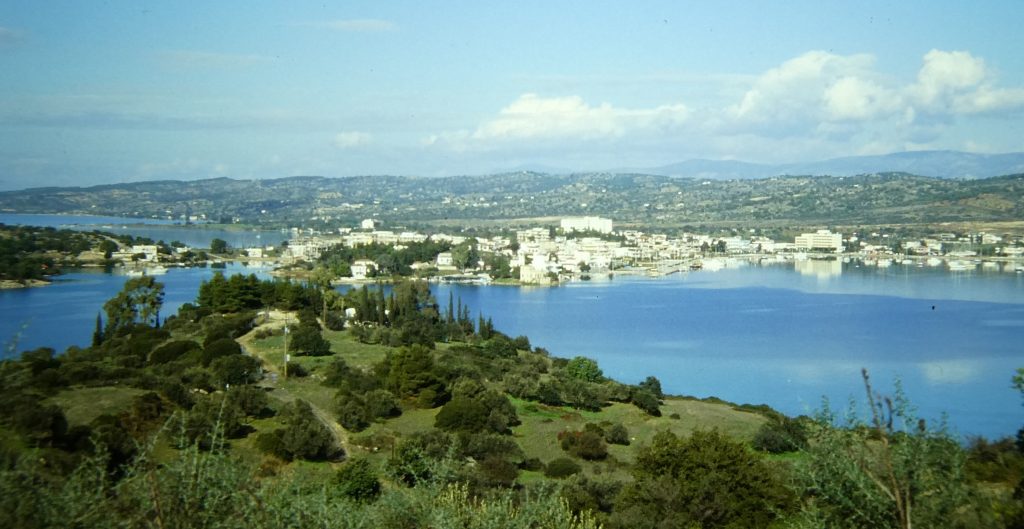 With high hopes we crossed the channel and traversed a short pass into the big near-circular bay of Porto Heli (or Kheli). As it opened up in front of us it appeared to be a hive of activity, with speedboats towing parasails at high speed, water-skiers buzzing around, and a fair bit of background noise. We were not too impressed by all this, but came in to anchor for the night and to think things over. There were a fair few moorings in the north-west corner of the bay, off a small town, and several boats at anchor. We meandered through them and were cheerfully hailed by a lady who was to become a dear friend, Sibyl Williams. "Are you staying for the winter?", she shouted over to us. At this stage we were still in doubt on that matter, but a short time later we had anchored in excellent holding and dinghied over to visit her. She told us that this was officially the last weekend of the summer season, and sure enough, it soon all became calm and peaceful.
With high hopes we crossed the channel and traversed a short pass into the big near-circular bay of Porto Heli (or Kheli). As it opened up in front of us it appeared to be a hive of activity, with speedboats towing parasails at high speed, water-skiers buzzing around, and a fair bit of background noise. We were not too impressed by all this, but came in to anchor for the night and to think things over. There were a fair few moorings in the north-west corner of the bay, off a small town, and several boats at anchor. We meandered through them and were cheerfully hailed by a lady who was to become a dear friend, Sibyl Williams. "Are you staying for the winter?", she shouted over to us. At this stage we were still in doubt on that matter, but a short time later we had anchored in excellent holding and dinghied over to visit her. She told us that this was officially the last weekend of the summer season, and sure enough, it soon all became calm and peaceful.
 We had no difficulty being persuaded by Sibyl that we would indeed spend the winter here. Sibyl had been the wife of Eric "Bill" Williams, famous as the author of the prison camp escape "The Wooden Horse" and other books. They had been cruising the Mediterranean for 25 years in their heavy Danish-built wooden yacht "Escaper", and Bill had only recently died on the boat in this anchorage. It was clear that we would have plenty of company here, with several other English-speaking yachties and expats ashore.
We had no difficulty being persuaded by Sibyl that we would indeed spend the winter here. Sibyl had been the wife of Eric "Bill" Williams, famous as the author of the prison camp escape "The Wooden Horse" and other books. They had been cruising the Mediterranean for 25 years in their heavy Danish-built wooden yacht "Escaper", and Bill had only recently died on the boat in this anchorage. It was clear that we would have plenty of company here, with several other English-speaking yachties and expats ashore.
As noted, Porto Heli is a largish bay, but nearly landlocked, and without the surrounding high hills which make for such gusty conditions in much of the Med. The holding was superb, and as noted there were moorings as well for those that wanted them.
After the most peaceful night for a while, we went ashore for a look around. The 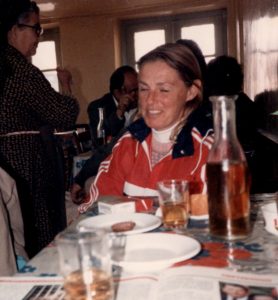 small town had a selection of acceptable shops, all owned by English speaking locals. The next day we met Sibyl ashore, and with her, got a lift up to the town at the top of a hill to the north, Kranidi. We were taken up by Frank, a German, who had recently taken over the moorings business. Kranidi was a typical market town: an assortment of small shops with good selection of fruit and veg. At the old taverna - which we came to learn was known as "the Hilton" - we enjoyed good kokinelli (classic cheap Greek red wine) and bought some feta to take back to the boat.
small town had a selection of acceptable shops, all owned by English speaking locals. The next day we met Sibyl ashore, and with her, got a lift up to the town at the top of a hill to the north, Kranidi. We were taken up by Frank, a German, who had recently taken over the moorings business. Kranidi was a typical market town: an assortment of small shops with good selection of fruit and veg. At the old taverna - which we came to learn was known as "the Hilton" - we enjoyed good kokinelli (classic cheap Greek red wine) and bought some feta to take back to the boat.
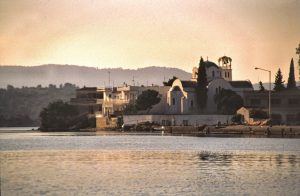 On a small promontory just to the south of the village was set an attractive church, where Bill Williams was buried. This, as Sibyl told us, was a temporary matter; because suitable burial space is so limited, after the period of a year he would be exhumed and his bones moved to an ossuary.
On a small promontory just to the south of the village was set an attractive church, where Bill Williams was buried. This, as Sibyl told us, was a temporary matter; because suitable burial space is so limited, after the period of a year he would be exhumed and his bones moved to an ossuary.
Five days after arriving at our promising winter home, on October 16 1987 I left Norma and the boat to fly off back to England with no great enthusiasm. I took the hydrofoil to Piraeus via Spetsai and Hydra, and then a bus into Athens. I had a cheap meal in Omonia and a bus to the airport where, because of the timing I slept along with many others on the floor before checking in at 4:30 am for the Czech airways Tupolev to Heathrow. On approach to London towering cumulus and turbulent air were clearly apparent. We circled for a long time before landing, when we learnt that great gales had been battering the country, with hurricane-force winds causing extensive damage over wide swathes of southern England.
The reason for the trip was that I had been commissioned to write another book for the British Medical Association, this time on the history and control of infectious diseases. This would require consultation and advice from my colleagues at the BMA, and some extensive research work on a subject for which I presently had less expertise than for my previous book. After a couple of weeks of consultations, research and family visits I flew back with piles of documents for a happy return to our floating home.
 While I was away Norma had done a marvellous job cleaning the boat inside, out and underneath, fixing up the upholstery and doing repairs to the sails. She spent many good times with Sibyl and became friendly with many other expats, local people and yachties.
While I was away Norma had done a marvellous job cleaning the boat inside, out and underneath, fixing up the upholstery and doing repairs to the sails. She spent many good times with Sibyl and became friendly with many other expats, local people and yachties.
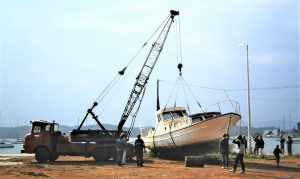 A major acquisition for me in London had been one of the first Toshiba laptop computers, the 1100+, along with a simple dot-matrix printer. This made writing aboard vastly more simple, and I soon buckled down to it. But first, we both spent a couple of days helping Frank to crane some 20 boats from his moorings ashore and on to cradles for the winter. Once all done, the whole team went up to Kranidi for crepes and kokinelli.
A major acquisition for me in London had been one of the first Toshiba laptop computers, the 1100+, along with a simple dot-matrix printer. This made writing aboard vastly more simple, and I soon buckled down to it. But first, we both spent a couple of days helping Frank to crane some 20 boats from his moorings ashore and on to cradles for the winter. Once all done, the whole team went up to Kranidi for crepes and kokinelli.
And so we settled in for six months in the bay - we were to be the only crew to spend the whole winter aboard. While I typed away Norma strengthened her friendship with Sibyl and others, with lots of walking, reading, boat work and shopping. Depending on the direction of the winds we moved from time to time from the anchorage off the village to other parts of the bay and, in particular, across to the southern side.
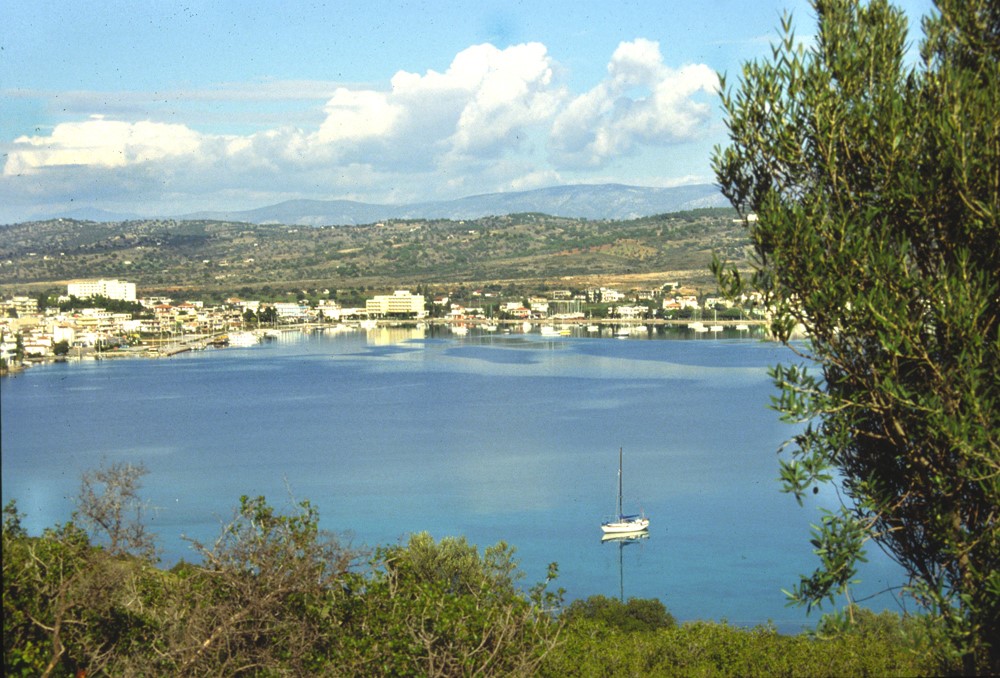
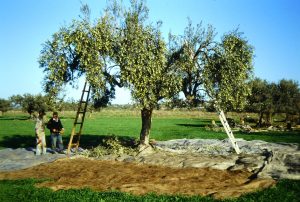 Over there, we were nearly always on our own. Up the hillside there lay the remains of an ancient Roman town. There was the wild greenery for Norma to gather - the spinach-like horiatico, horta and mushrooms - and we enjoyed watching the olives being harvested. Norma pickled several bottles of the fruit, which lasted for years.
Over there, we were nearly always on our own. Up the hillside there lay the remains of an ancient Roman town. There was the wild greenery for Norma to gather - the spinach-like horiatico, horta and mushrooms - and we enjoyed watching the olives being harvested. Norma pickled several bottles of the fruit, which lasted for years.
During a short period of what looked like good and settled weather we did take a short trip out from Porto Heli for a change of scenery. We motored up the Argolic Gulf towards Navplion, and anchored at the head of the deep Khaidhari bay, off the village of Vivari. There were steep hillsides all around, and lots of small fishing boats. Norma took a trip ashore to see the village but was not 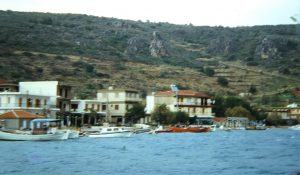 impressed: rather scruffy, she reported. Meanwhile, I got stuck into writing an outline for the book. The wind howled in during the night, and in the morning, because we were lying fairly close to the lee shore, we took the unusual step of setting a second anchor. This was smaller than our main anchor but, as usual, following a wind shift we ended up lying to it alone, but without any problems.
impressed: rather scruffy, she reported. Meanwhile, I got stuck into writing an outline for the book. The wind howled in during the night, and in the morning, because we were lying fairly close to the lee shore, we took the unusual step of setting a second anchor. This was smaller than our main anchor but, as usual, following a wind shift we ended up lying to it alone, but without any problems.
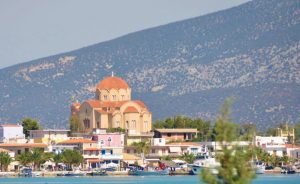 After a couple of night we moved a short distance back down the gulf to Koiladia (aka Kilada), a large bay in the easternmost part of the gulf. We passed some magnate's private island on the way in and anchored in an attractive spot near a big monastery church. There were lots of fishing boats around, and boat-building yards ashore. Norma took her bicycle ashore for a good exploratory ride and, to our great pleasure, she came across the friendliest local people we had so far encountered in Greece. This was not at all a tourist spot, which may have had something to do with it. Kranidi was not far away, and Norma cycled up some very steep hills to do some shopping there.
After a couple of night we moved a short distance back down the gulf to Koiladia (aka Kilada), a large bay in the easternmost part of the gulf. We passed some magnate's private island on the way in and anchored in an attractive spot near a big monastery church. There were lots of fishing boats around, and boat-building yards ashore. Norma took her bicycle ashore for a good exploratory ride and, to our great pleasure, she came across the friendliest local people we had so far encountered in Greece. This was not at all a tourist spot, which may have had something to do with it. Kranidi was not far away, and Norma cycled up some very steep hills to do some shopping there.
As we discussed Norma's experience with the friendly local people in this bay, we reviewed our general experience with Greece so far. It seemed that we had had little interaction with the Greek people generally, and we found them not easy to get on with – slow to smile, much concerned with “face”.
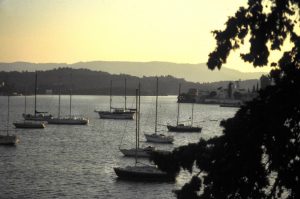 It seemed to us that all visitors to Greece seemed to fall either into the group who would, or those who wouldn’t, want to return. Among the first group have been some of the world’s finest writers – Lawrence Durrell, Henry Miller, Lord Byron – and it is perhaps the works of these famous Hellenophiles that have raised the expectations of newcomers to unrealistic levels. Our own expectations were never really fulfilled, which I readily concede could be our “fault”. We found places that were pretty enough – but not the slices of paradise described by Miller. We came across some lovely people – but in general not many of the paragons of outgoing friendliness and courtesy described by Durrell. We didn’t think much of the food, and the cheaper wines are among the worst in the Mediterranean basin - while admitting that we did enjoy a glass or three of kokinelli, flagons of which we filled up at the Hilton.
It seemed to us that all visitors to Greece seemed to fall either into the group who would, or those who wouldn’t, want to return. Among the first group have been some of the world’s finest writers – Lawrence Durrell, Henry Miller, Lord Byron – and it is perhaps the works of these famous Hellenophiles that have raised the expectations of newcomers to unrealistic levels. Our own expectations were never really fulfilled, which I readily concede could be our “fault”. We found places that were pretty enough – but not the slices of paradise described by Miller. We came across some lovely people – but in general not many of the paragons of outgoing friendliness and courtesy described by Durrell. We didn’t think much of the food, and the cheaper wines are among the worst in the Mediterranean basin - while admitting that we did enjoy a glass or three of kokinelli, flagons of which we filled up at the Hilton.
It is possible that our perceptions had been influenced by the fact that we had so far spent most of the time along the Peloponnese mainland. All these southern areas were originally populated by the warlike Dorians, whose chief descendants were the Spartans. Temperamentally totally different to the Athenian Greeks, the Spartans have of course spent much of Greek history at war with the northerners, and in Porto Heli we heard much disparaging comment about “those Athenians”.
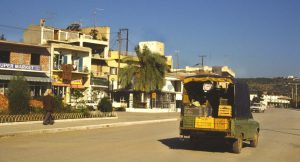
Historically aloof, inhospitable and paranoid, the Spartans seemed to have been a disciplined but unattractive people, and we thought we recognised some of these features in their 20th century descendants! In Porto Heli, mature women rarely appeared out of their houses, where they are visited by small trucks carrying fruit, vegetables and other produce. Norma would be pushed aside in battles to get the best provisions. The harbourside evening stroll, so much a feature of Mediterranean life, was a men-only affair. During a dinner in the biggest taverna, we counted about 25 young Greek men – but only two young women. Boarding a bus, any mature Greek man would resolutely shoulder aside any foreigners or women who might have been waiting there before him. Durrell claims in his book on the Greek islands that the Greeks were the first civilisation to recognize the rights of women, which is a classic example of idealisation; in fact, throughout history Greek women have been regarded as citizens only for the purpose of procreation. Greek aspirations, it seemed to us, died with Alexander the Great, and the frowning countenances of the southerners reflected gloomy memories of glories long gone.
We well understood that our experience in the country had been so far essentially confined to the coast. We looked forward to exploring some of the islands in the spring, and we assumed that one day in the future, we would explore mainland Greece very much more extensively and thoroughly.
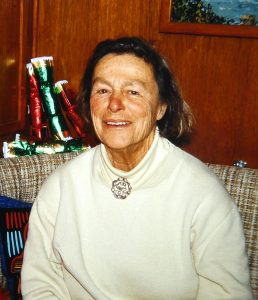
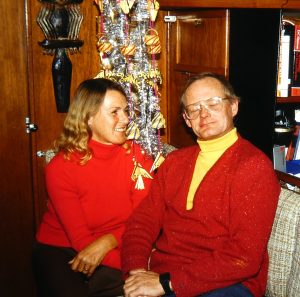 I was delighted to find that the word “laconic” is derived from the Spartans’ main district, Laconia! The strongest impression we gained from some villagers in Porto Heli was that they didn’t care whether we were there or not. Which is their prerogative, of course, and suited us well enough – all we wanted was peace and quiet, and that we got when we wanted it.
I was delighted to find that the word “laconic” is derived from the Spartans’ main district, Laconia! The strongest impression we gained from some villagers in Porto Heli was that they didn’t care whether we were there or not. Which is their prerogative, of course, and suited us well enough – all we wanted was peace and quiet, and that we got when we wanted it.
We still enjoyed the social activity among the friendships we were making among the other yachts and ashore, and indeed with the many Greek people with whom we and others had a good time over Christmas and the noisy Greek New Year.
During the winter the bikes got a fair bit of use, including a long ride via Kranidi to the port of Ermioni, on the east side of the peninsula. There I got a puncture, and had to walk back the eight miles or so. I then bought a puncture repair kit.
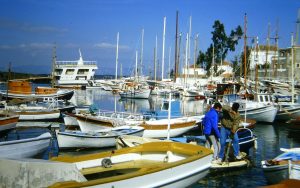
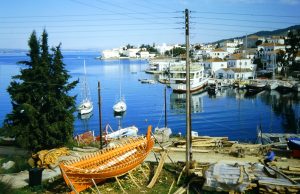 With Sibyl we took the ferry over to Spetsai to visit her friend Hod Fuller. He was a most interesting man, American, who before the war had sailed in the Pacific and Asia. He had served in the Pacific war and then parachuted into France to help the Resistance. In the 50s and 60s he sailed a big yacht from California to Greece, married a Greek lady and settled. He had a lovely place in Spetsai, which this time we found to be a highly attractive little island, with much better food and other shops than Porto Heli or Kranidi. In the old harbour - where we had considered wintering - there were several yards for wooden boatbuilding. A little later we took ourselves over to the island again, for more exploration.
With Sibyl we took the ferry over to Spetsai to visit her friend Hod Fuller. He was a most interesting man, American, who before the war had sailed in the Pacific and Asia. He had served in the Pacific war and then parachuted into France to help the Resistance. In the 50s and 60s he sailed a big yacht from California to Greece, married a Greek lady and settled. He had a lovely place in Spetsai, which this time we found to be a highly attractive little island, with much better food and other shops than Porto Heli or Kranidi. In the old harbour - where we had considered wintering - there were several yards for wooden boatbuilding. A little later we took ourselves over to the island again, for more exploration.
By the end of January I had nearly completed the first draft of the book, and in mid-February we flew back to England to catch up with my contractor the BMA, parents and other relatives. Norma's Dad was in his last days, and died in March. On March 29 we flew out to Athens and took the hydrofoil back to Porto Heli. We were met by Sibyl, had an excellent lunch at Costas' good taverna, and went back to the boat for a long sleep.
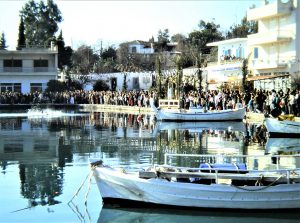 On the Saturday of the Greek Orthodox Easter there were big celebrations on the harbourside, including the throwing of a wreath into the water by the priest, with scores of young men swimming in a race to secure it first. In the evening there were lots of very loud bangs (Greek favourites), flares and fireworks.
On the Saturday of the Greek Orthodox Easter there were big celebrations on the harbourside, including the throwing of a wreath into the water by the priest, with scores of young men swimming in a race to secure it first. In the evening there were lots of very loud bangs (Greek favourites), flares and fireworks.
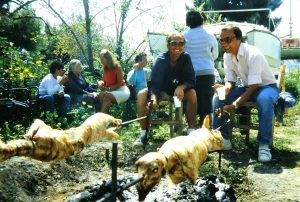 On Easter Sunday Frank had organised a feast and a big party for all the long-term visitors and friends among the local people. Two lambs were slowly turned over charcoal pits, supervised by the local garage owner and his family. It was a long, boozy and highly enjoyable day. Back on the boat, we moved over to the quieter southern shore because of well-founded fears of a noisy evening and explosive fireworks in the town.
On Easter Sunday Frank had organised a feast and a big party for all the long-term visitors and friends among the local people. Two lambs were slowly turned over charcoal pits, supervised by the local garage owner and his family. It was a long, boozy and highly enjoyable day. Back on the boat, we moved over to the quieter southern shore because of well-founded fears of a noisy evening and explosive fireworks in the town.
We borrowed Frank's rickety old Volvo to drive over to Koilada to extend our Transit Log for another six months. A few days later we met the local Port Captain for the first time - he'd had no idea of our existence to that point!
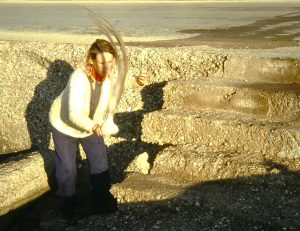
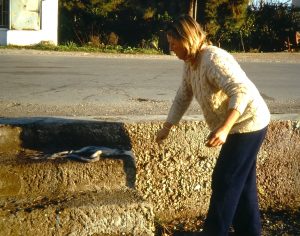 Norma's hunter-gathering continued for the whole stay. An exciting example was catching a big octopus. She took it ashore in a bucket and, using the same set of steps as the locals did, swung and whacked it on those steps until it was tender. It was excellent eating as the sun went down.
Norma's hunter-gathering continued for the whole stay. An exciting example was catching a big octopus. She took it ashore in a bucket and, using the same set of steps as the locals did, swung and whacked it on those steps until it was tender. It was excellent eating as the sun went down.
As April moved to its end we were getting the boat ready in all respects for the sea, and started a round of fond farewells. We had a final dinner with Sibyl, and saw her off the next day for her trip to England. As a last stop we moved to a little bay in the channel into Porto Heli, sharing it with English friends who were also getting going again.
On Monday May 2, 1988, we sailed away from Porto Heli at 0825 and started our exploration of the southern Aegean.
The Aegean Sea
Our original intention had been to return to Poros, but we were anxious get start moving across the Aegean on our way to Turkey. We had received a lot of advice from Sibyl on the most attractive islands and route across the Aegean, and in accord with this advice our destination then became the island of Serifos.
We left in a fair nor-wester. This gave us great sailing for a while, but soon the wind veered to the north-east, which we could still lay in a close reach, but as the wind increased we started punching into a steep little Mediterranean chop, under reefed sail. During the afternoon the wind continued to build, but soon after rounding the south-west corner of Serifos we sailed into the first acceptable anchorage there, Koutala Bay. This was big and open to the south, but it was protected from the prevailing wind and we were glad enough to get in anywhere before sunset, after this 70 nautical mile slog. Ashore, we could only see a small village and its church. There were also the overgrown remains of mining works and buildings.
We ventured right up into the head of the bay, with the wind whistling through the hills. We had difficulty getting the anchor set through the weeds, but at 9:00 pm were were finally settled. It had been a rough, tough sail, a great re-introduction to sailing in the Med! We had hoped for a more pleasant start to the season.
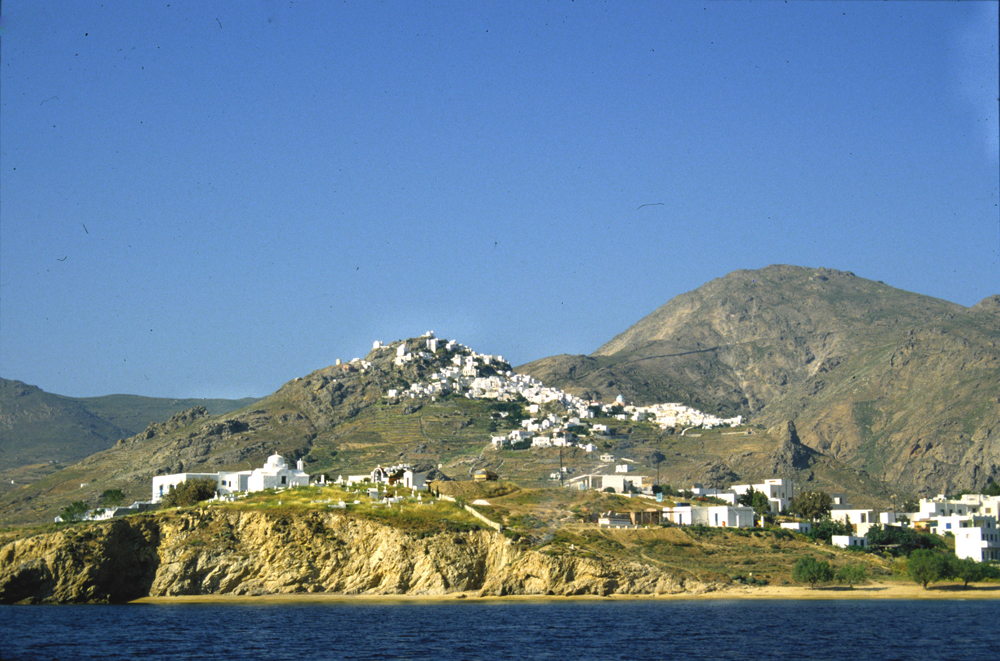 The night was peaceful enough, and we then motored round to the main anchorage for the island, off the village of Port Livadhi. There was a very attractive approach up a long bay, with the white buildings of the island's chora on a prominent outcrop overlooking the harbour. It was possible to tie up at a wharf, where several charter yachts lay, but as usual we chose to anchor off away from the shemozzle. It was still blustery, but "not as bad as yesterday", as a charter yachty commented.
The night was peaceful enough, and we then motored round to the main anchorage for the island, off the village of Port Livadhi. There was a very attractive approach up a long bay, with the white buildings of the island's chora on a prominent outcrop overlooking the harbour. It was possible to tie up at a wharf, where several charter yachts lay, but as usual we chose to anchor off away from the shemozzle. It was still blustery, but "not as bad as yesterday", as a charter yachty commented.
We walked ashore for some minor shopping at the harbour village. The whole setting was lovely, as high Serifos is one of the classic Aegean islands. We were overlooked by steep green-and-brown hillsides and the shining white chora high at the top. Lots of donkeys were wandering around on this sunny afternoon. (Chora, or hora, means "town" in Greece, and is often used as the name of the main town on an island. Throughout the Aegean the chora is often centred on the church, often, as here, up on a hill.) We soon began the socialising process among the anchored yachts. Ferries were coming and going.
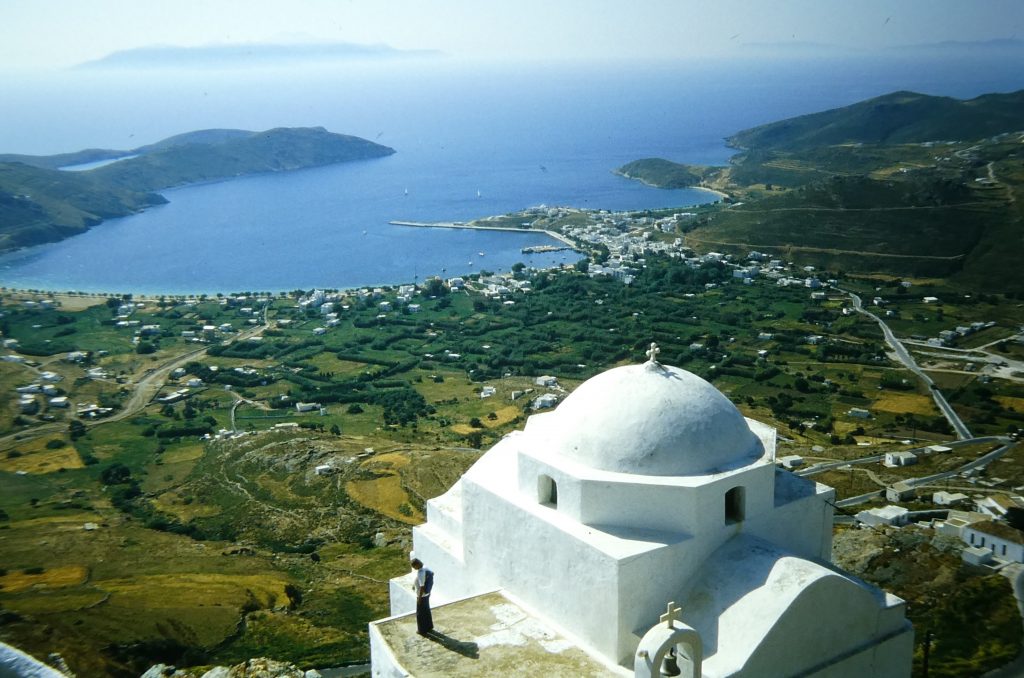 In improving weather we took the tough walk up to the chora. We started through neatly cultivated plots and then climbed up a long line of steps while enjoying the beautiful view opening up behind us. The town up top was very neat and clean, with many elderly people reacting well to our greetings. We continued on into the island, crossing fields before being directed on to a rough path. We saw many strange, large and very ornate dovecotes, thorny plants all around, wildflowers and lavender. We had lunch at a taverna in the hora: spicy meatballs, beetroot with leaves, garlic mashed potato. This was a pleasant, cheap meal presented by a very friendly proprietor.
In improving weather we took the tough walk up to the chora. We started through neatly cultivated plots and then climbed up a long line of steps while enjoying the beautiful view opening up behind us. The town up top was very neat and clean, with many elderly people reacting well to our greetings. We continued on into the island, crossing fields before being directed on to a rough path. We saw many strange, large and very ornate dovecotes, thorny plants all around, wildflowers and lavender. We had lunch at a taverna in the hora: spicy meatballs, beetroot with leaves, garlic mashed potato. This was a pleasant, cheap meal presented by a very friendly proprietor.
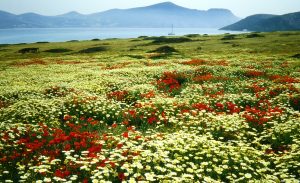 This was a very good stop, and the next leg was a pleasant day sail in light winds past Sifnos to a bay on the south side of Dhespotico Island. This rocky little island lies just off Antiparos, which is adjacent to Paros. Dhespotico was deserted, apart from large herds of goats and a goatherd. He showed Norma, on one of her walks ashore, the remains of old statuary, columns and pottery. There were acres of wild flowers all around, featuring huge poppies and several kinds of daisy.
This was a very good stop, and the next leg was a pleasant day sail in light winds past Sifnos to a bay on the south side of Dhespotico Island. This rocky little island lies just off Antiparos, which is adjacent to Paros. Dhespotico was deserted, apart from large herds of goats and a goatherd. He showed Norma, on one of her walks ashore, the remains of old statuary, columns and pottery. There were acres of wild flowers all around, featuring huge poppies and several kinds of daisy.
After a peaceful and pleasant short stay, anchored on our own, we rejoined civilisation in Ios, after a short motor to the south east. There is a big open bay off the touristy town, but it was windy with a swell, so we came into the inner harbour and tied to the town wharf in front of a hotel. We took a walk through the clean and neat port 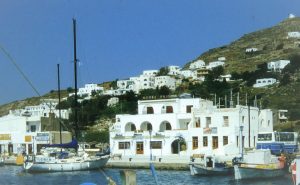 settlement with a classically white church on a little headland and fewer tourists than we had expected. We later walked up the stepped path to the chora, which was very picturesque, a labyrinth of alleys, many tavernas and bars. We had beers and salata at one that was owned by a Greek Australian who had started up only a couple of weeks earlier. The shopping for provisions was good. We were joined at the wharf by an American couple, Tom and Maureen on Tilly Whim, with whom we were later to become good friends.
settlement with a classically white church on a little headland and fewer tourists than we had expected. We later walked up the stepped path to the chora, which was very picturesque, a labyrinth of alleys, many tavernas and bars. We had beers and salata at one that was owned by a Greek Australian who had started up only a couple of weeks earlier. The shopping for provisions was good. We were joined at the wharf by an American couple, Tom and Maureen on Tilly Whim, with whom we were later to become good friends.
From Ios we continued generally east, to the long island of Amorgos. This looked barren, with patches of terraced cultivation; isolated white churches and windmills - with no blades - sat up on the top of rocky outcrops. On the north side of the island 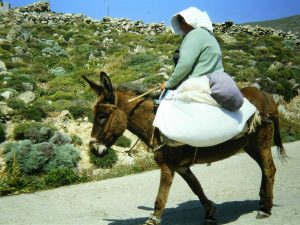 we tied to a wharf in Katapola Bay. The settlement there was a sleepy one-donkey place, with a few back-packers and young tourists wandering around. There was a friendly man in a shop, but otherwise the local people were uncommunicative and weird, with closed faces. For the first time since Galaxhidi the port police asked for our papers and crew list.
we tied to a wharf in Katapola Bay. The settlement there was a sleepy one-donkey place, with a few back-packers and young tourists wandering around. There was a friendly man in a shop, but otherwise the local people were uncommunicative and weird, with closed faces. For the first time since Galaxhidi the port police asked for our papers and crew list.
After a couple of days waiting for the wind (again) to settle, we continued up along the north side of the island and then past a line of small islands to Levitha Island and a near land-locked big bay on its south side. The island looked lower than most, but just as rocky. There were a few huts ashore, lots of goats of course, but no signs of people. Walking ashore, the going was incredibly tough. We stayed just for the night and then had a pleasant sail to the bigger and more developed island of Kalymnos.
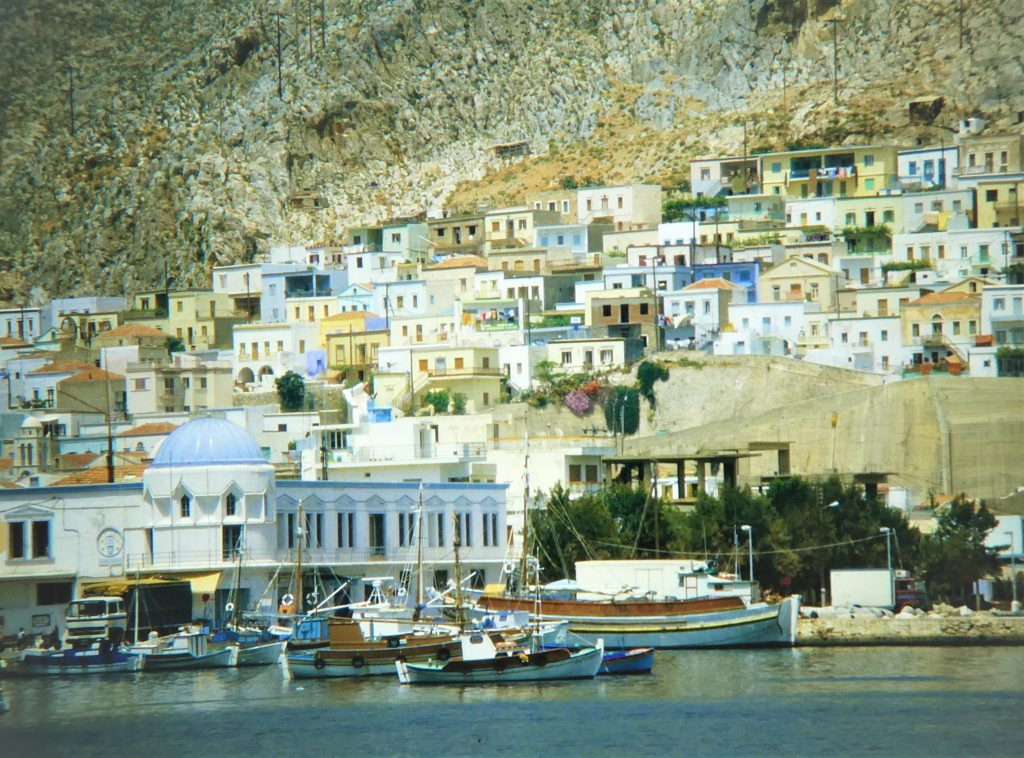
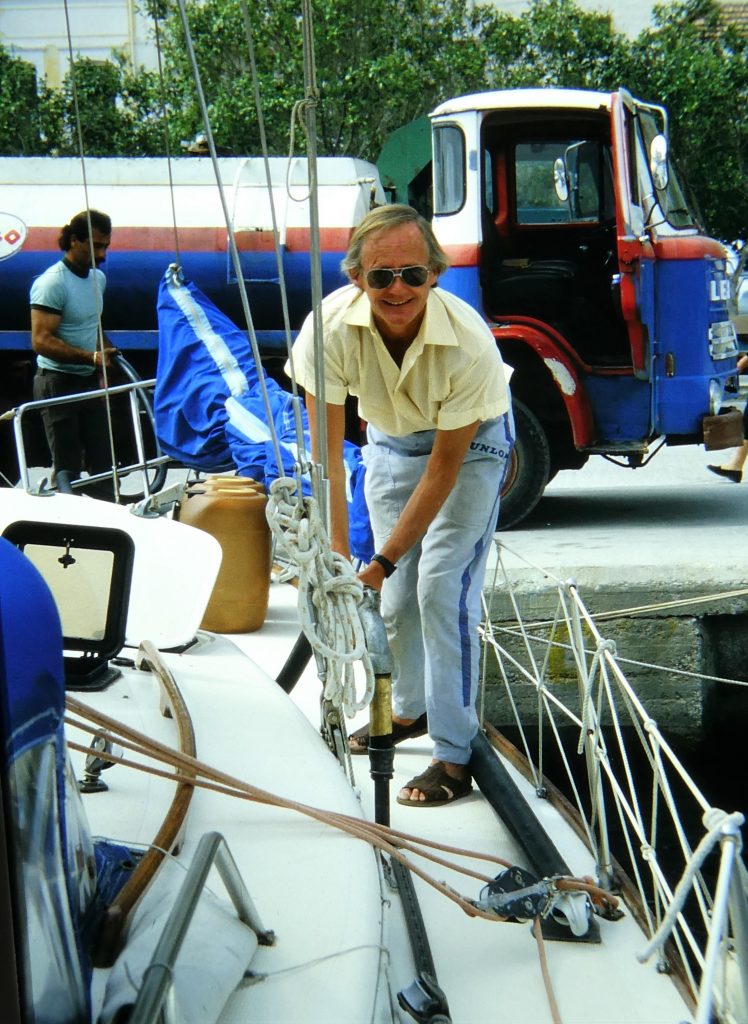 Again we tied up to the long wharf at the town, between fishing boats and yachts including one we had met during Christmas in Porto Heli.
Again we tied up to the long wharf at the town, between fishing boats and yachts including one we had met during Christmas in Porto Heli.
The town was very working Greek, with few tourists. There was a jumbled mess of boats in a "shipyard; in the old town there were small houses on a steep hill, workshops , old men chopping sponges. Our attitude to the place, as ever 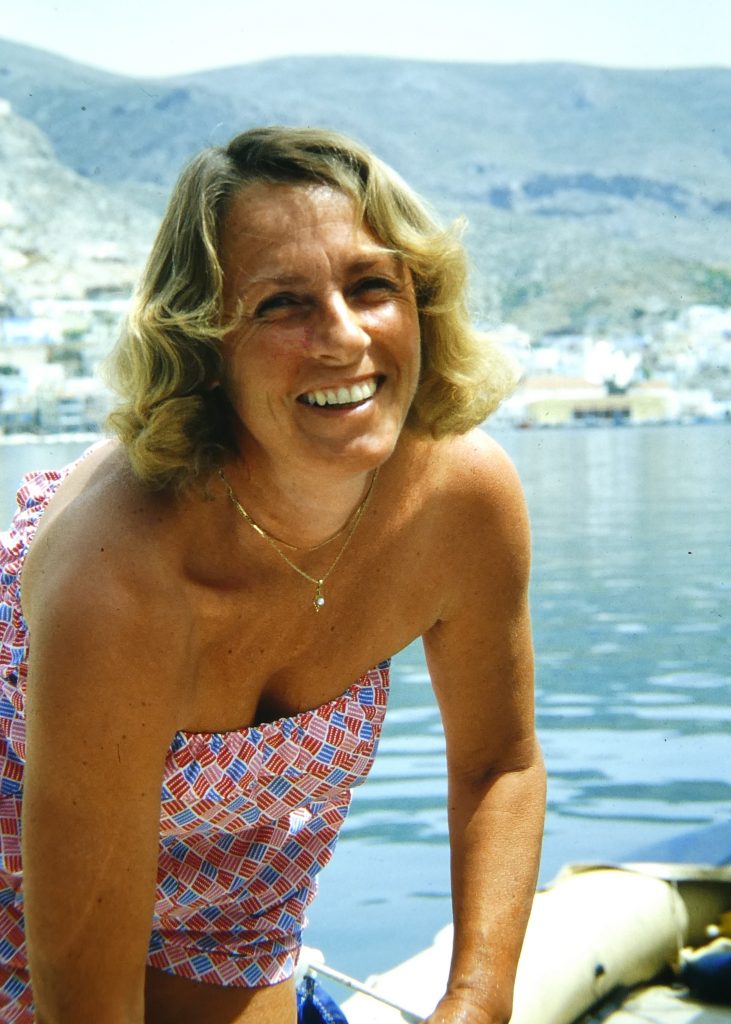 in the Med, was coloured by doubts on security while tying bow-to to the wall, with continuing noise and disturbance. But the shopping was good by Greek standards, including meat. We and a couple of other yachts were also able to fill up with water and with fuel, as the fuel truck was right by us while filling up a fishing boat tied alongside. We were able also to get all the gas bottles filled with no arguments, so this had been a good and practical stop in terms of logistics.
in the Med, was coloured by doubts on security while tying bow-to to the wall, with continuing noise and disturbance. But the shopping was good by Greek standards, including meat. We and a couple of other yachts were also able to fill up with water and with fuel, as the fuel truck was right by us while filling up a fishing boat tied alongside. We were able also to get all the gas bottles filled with no arguments, so this had been a good and practical stop in terms of logistics.
After this busy stay we were well stocked up and organised when we motored the short distance to the island of Kos and up to the north-east end where lies the eponymous harbour. This is in an almost circular bay, entered through a narrow entrance. We crossed the bay and tied up in the town on the waterfront wharf.
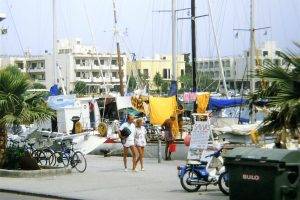 This was to be another busy but interesting stay, with a bit more history than most of the more remote islands. The wharf was bustling with tourists and small market stalls, many with small fish. The town featured many new hotels and unfinished cubic dwellings, but in the older part there was a mixture of medieval Frankish and Turkish architecture with a few later buildings build during the Italian occupation. Throughout the town there were bits and pieces of old monuments, surrounded by oleanders, bougainvillea and hibiscus.
This was to be another busy but interesting stay, with a bit more history than most of the more remote islands. The wharf was bustling with tourists and small market stalls, many with small fish. The town featured many new hotels and unfinished cubic dwellings, but in the older part there was a mixture of medieval Frankish and Turkish architecture with a few later buildings build during the Italian occupation. Throughout the town there were bits and pieces of old monuments, surrounded by oleanders, bougainvillea and hibiscus.
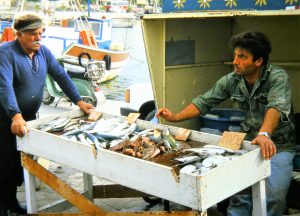 We had crossed from the stony islands of the Cyclades in the southern Aegean, and both Kalymnos and Kos lie in the Dodecanese group. They are very close to Turkey, and we could see the Turkish peninsula of Knidos from where we were moored in Kos. Over the ages they have faced battles to determine whether they are Greek or Turkish. The disputes still grumble along, and yachts were not permitted to visit Simi, the centre of the current troubles. On its western windward and rainy side, Kos is a green and fertile island (the home of Kos lettuce), more like the Ionian islands.
We had crossed from the stony islands of the Cyclades in the southern Aegean, and both Kalymnos and Kos lie in the Dodecanese group. They are very close to Turkey, and we could see the Turkish peninsula of Knidos from where we were moored in Kos. Over the ages they have faced battles to determine whether they are Greek or Turkish. The disputes still grumble along, and yachts were not permitted to visit Simi, the centre of the current troubles. On its western windward and rainy side, Kos is a green and fertile island (the home of Kos lettuce), more like the Ionian islands.
On the east side of the harbour we could see the the ruins of the 14th century castle of the Knights of Saint John, built by the knights for their battles with the Ottomans. It has been partially reconstructed with towers at its four corners. For some reason we were coming to like harbours overlooked by castles! Kos became an important maritime power after its founding in 366 BC. It was once famous for its silk, especially the diaphanous flowing silk dresses prized by the Roman women, but that industry is long gone.
We already knew several of the yachting crews in the harbour, and soon became friends with even more. So it was a sociable time.
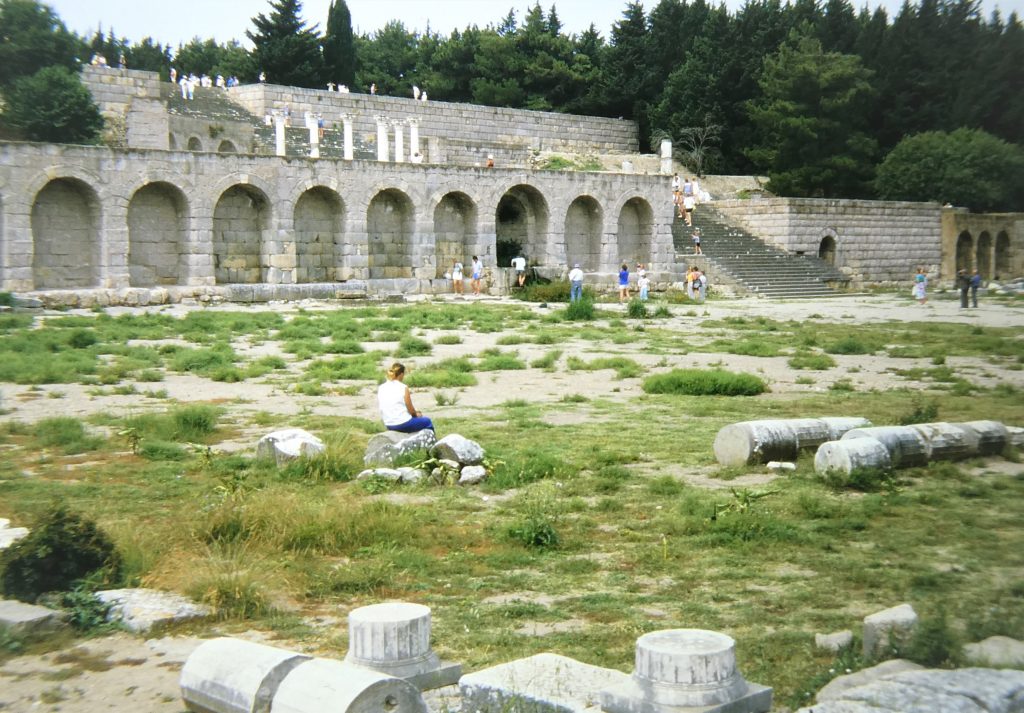 And there was lots to do in Kos. High on the list was a visit to the Sanctuary of Asclepius. Perhaps the most famous citizen of ancient Kos was of course Hippocrates, the father of modern medicine. We unfolded the bikes, fixed the inevitable puncture, and cycled the four kilometres or so past some little Muslim villages up to the Asklepion, the place of healing, built by and for his disciples (long after his death).
And there was lots to do in Kos. High on the list was a visit to the Sanctuary of Asclepius. Perhaps the most famous citizen of ancient Kos was of course Hippocrates, the father of modern medicine. We unfolded the bikes, fixed the inevitable puncture, and cycled the four kilometres or so past some little Muslim villages up to the Asklepion, the place of healing, built by and for his disciples (long after his death).
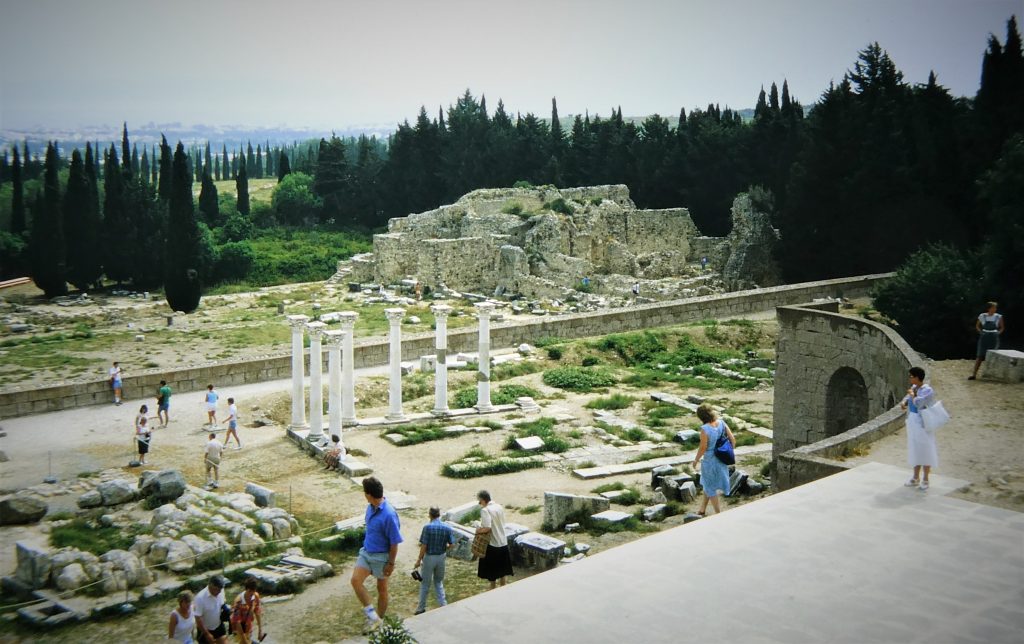 Three terraces lie in a large peaceful setting near to medicinal springs on the hill, with a great view overlooking Kos and the gulf. The remains of the temples looked grand, but there was no attempt to provide any information.
Three terraces lie in a large peaceful setting near to medicinal springs on the hill, with a great view overlooking Kos and the gulf. The remains of the temples looked grand, but there was no attempt to provide any information.
We mostly free-wheeled the bikes down back to Kos, and then visited the excavations of the ancient Roman town. There were some impressive stone streets, mosaics, and a splendid outline reconstruction of a Roman mansion. We also duly viewed the tree under which it is said that Hippocrates taught, propped up now by a complex of stone struts, but it is about 800 years too young to have been there at the time.
It became windy, humid and hot, bad for Norma's arthritis and thus a sign it was no time to leave safe harbour. Unfortunately the shopping for provisions was poor. Right by us were lines of tables set out with fish, mostly so small that if we had caught them we'd have thrown them back. As in other instances, we referred to them as "Med fish". But there was some nice craft work, and we bought a charming little painting for the aft cabin. We walked to the castle on the foreshore of the inner harbour, but it was shut.
Finally, as the weather improved, we were cleared out for Turkey by surly Port Police and Customs officials, who made their disapproval very plain. Turkey and Greece nearly came to war over seabed rights in the Aegean only last year (1987), the latest round in a series of disputes which – given changing names for the regions – has gone on for thousands of years. The premiers of Greece and Turkey had met together very recently; urged for comment by an optimistic press, Ozal pointed out that anyone who hoped for much progress out of one meeting had little understanding of history.
While on passage to our first port in Turkey, we again reviewed our experience of sailing in Greek waters, this time for the period since leaving Porto Heli in early May.
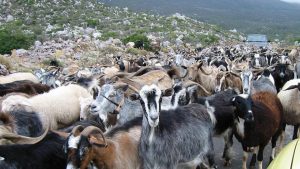 We had spent nearly three weeks moving through a small selection of the Cyclades islands in the southern Aegean. We were surprised at how barren many were, and it was often difficult to take walks over the stony ground. It was hard for us to see why they have attracted such a devoted following over the years.
We had spent nearly three weeks moving through a small selection of the Cyclades islands in the southern Aegean. We were surprised at how barren many were, and it was often difficult to take walks over the stony ground. It was hard for us to see why they have attracted such a devoted following over the years.
It has been long agreed that the widespread farming of goats over hundreds or thousands of years has been the cause of serious deforestation. However, it was not until the interwar period under the dictator Ioannis Metaxas that overgrazing by goats was aggressively addressed. Goats were slaughtered in their thousands, but it was really too late. The new tourism industry helped to prevent serious poverty in the islands, but diverted efforts to regenerate the land. It's not a simple problem, because thoughtless efforts to minimise goat populations would decimate large swathes of rural industry in the country; goat meat and milk are big markets in Europe.
Some of the harbours and anchorages had been good, and indeed chosen because they were not so barren, and there are some attractive little whitewashed villages in most of the foothills. But provisioning and water supplies were constant problems, and we hardly ever saw really pretty or dramatic scenery.
We found the island people easier to deal with than those on mainland Greece, but still unforthcoming unless pressed. Except on the tourist islands, the people tend to be either very young or very old – the others are off making money in Athens, Germany, the USA or Australia.
The islands did differ one from the other more than we had expected. Practically within sight of each other might be one island packed with young tourists and discos and another with nothing but a simple hamlet and no hotels at all. We could not describe them as beautiful in the normal sense, although some of the villages had charm, spilling their cubic white dwellings over craggy outcrops like sugar on a rock cake. The classic tourist pictures are of snow-white (read, glaring in the sun) houses and churches, steep paved alleys, bunches of flowers, and windmills. These spectacular features were all there, but it seemed to us that such views were pastiches that cut out the context, which is rugged, dry, and grey. We of course conceded that we had visited a relatively tiny selection of islands among those on offer, and our view could be seen as less than generous, but nevertheless they were mostly also among the most popular for visitors by both land and sea.
Turkey
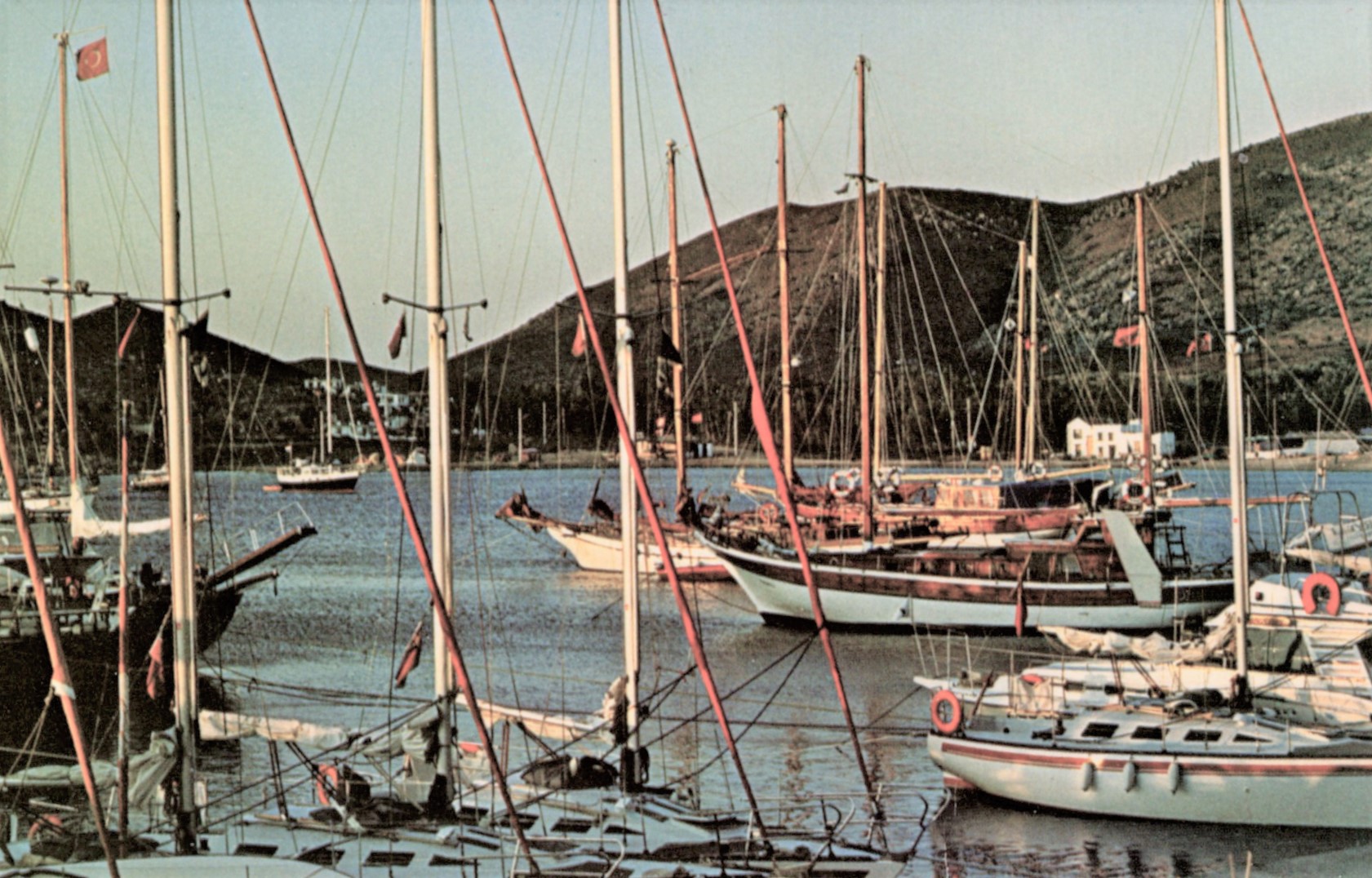 The official entry port of Datca, to which we were headed, sits on the south side of the finger-like peninsula of the same name, attached to the peninsula of Knidos. It's not much of a harbour, partly protected from open water by a short breakwater, but we needed to get "entered" into the country before getting on with our exploring. The anchorage and wharves were chaotic, with much shouting and efforts to get anchors to hold. We anchored out for the first night and went ashore in the morning.
The official entry port of Datca, to which we were headed, sits on the south side of the finger-like peninsula of the same name, attached to the peninsula of Knidos. It's not much of a harbour, partly protected from open water by a short breakwater, but we needed to get "entered" into the country before getting on with our exploring. The anchorage and wharves were chaotic, with much shouting and efforts to get anchors to hold. We anchored out for the first night and went ashore in the morning.
Early, police and customs were shut, and so were the banks. We had no Turkish cash, but a skipper of a charter flotilla changed some pounds for us. (In the evening, we spent a pleasant time with him and his charter fleet for dinner ashore.) The supermarket was open, and much better than recent Greek experiences in both quality and price. The people serving us were pleasant, ready to smile, most speaking some English. When officialdom opened we did face a pile of paperwork, but did not grumble; we saw that another skipper had begun to complain and was becoming subject to a fair bit of trouble and searches. Generally, though, it was a good experience for us entering the country.
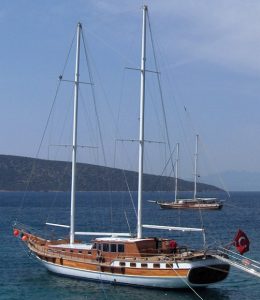 Once entered, we motored round a headland to another bay, open but in good conditions and free from the squabbling and dog-eat-dog anchoring efforts in the main harbour. Here, we shared the anchorage with a few of the beautiful Turkish charter gulets, with their yacht-like rigs and gleaming white and teak hulls. We had a long swim in clear water, cleaning the hull bottom and the prop. We also started detailing plans for our Turkish itinerary. We had the excellent British-published cruising guide, but Norma did point out that the chart we were using (thanks to Sibyl) was a photocopy of a chart that was 150 years old!
Once entered, we motored round a headland to another bay, open but in good conditions and free from the squabbling and dog-eat-dog anchoring efforts in the main harbour. Here, we shared the anchorage with a few of the beautiful Turkish charter gulets, with their yacht-like rigs and gleaming white and teak hulls. We had a long swim in clear water, cleaning the hull bottom and the prop. We also started detailing plans for our Turkish itinerary. We had the excellent British-published cruising guide, but Norma did point out that the chart we were using (thanks to Sibyl) was a photocopy of a chart that was 150 years old!
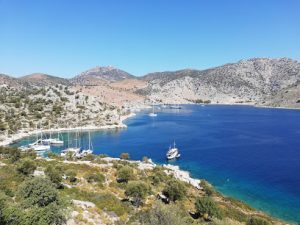 Moving off, we motored across the northern tip of the disputed Simi island (currently Greek), which we had been warned not to approach, and then after a pleasant sail entered one of the countless lovely coves along the Knidos peninsula. (Actually, from the sea, the bays and headlands all looked very similar, and were hard to sort out navigationally.) This bay - a "buku" - was Port Aplotheka, off the town of Bozukkale (Bozuk Buku). There was an ancient citadel on the headland to our left as we entered, part of the ruins of ancient (Hellenistic) Loryma. These multiple names for places were common.
Moving off, we motored across the northern tip of the disputed Simi island (currently Greek), which we had been warned not to approach, and then after a pleasant sail entered one of the countless lovely coves along the Knidos peninsula. (Actually, from the sea, the bays and headlands all looked very similar, and were hard to sort out navigationally.) This bay - a "buku" - was Port Aplotheka, off the town of Bozukkale (Bozuk Buku). There was an ancient citadel on the headland to our left as we entered, part of the ruins of ancient (Hellenistic) Loryma. These multiple names for places were common.
We found it a bit strange that here we were in south-west Turkey, a Muslim nation (albeit with a “secular” constitution) and with an Asian feel, yet the ruins we would be exploring along the way were of Greek and Roman settlements. The whole Aegean coast was “Greek” (although often under non-Greek rule) for nearly 3,000 years.
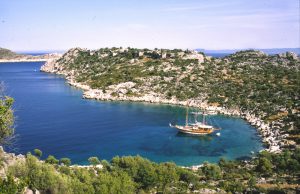 The anchorage was generally deep, which we soon found was typical of these bays. We got as far in as we could, and anchored off a set of ruins on the western side. We walked down the goat track to a citadel, enjoying a nice view from a ridge down into the cove. Turkish gulets had all the best anchorages! The next morning we said hullo to the crew of a traditional British yacht, one of those that had over-wintered in St Katharine's dock with us. Our voyaging friends, by this time, might unexpectedly be come across anywhere in the world.
The anchorage was generally deep, which we soon found was typical of these bays. We got as far in as we could, and anchored off a set of ruins on the western side. We walked down the goat track to a citadel, enjoying a nice view from a ridge down into the cove. Turkish gulets had all the best anchorages! The next morning we said hullo to the crew of a traditional British yacht, one of those that had over-wintered in St Katharine's dock with us. Our voyaging friends, by this time, might unexpectedly be come across anywhere in the world.
We pressed on along the southern side of the Knidos peninsula where there were several anchorages, but nearly all faced south and the wind had settled in as a southerly. This made none of them very attractive. We turned up towards the major 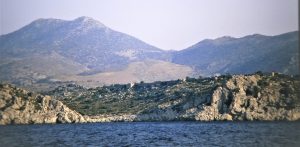 port of Marmaris and settled into Turunc Buku, open but protected from the wind. There were lots of buildings around but we lay in an incredibly impressive setting: a ring of cliff-like mountains around us, red rocks and green scrubland.
port of Marmaris and settled into Turunc Buku, open but protected from the wind. There were lots of buildings around but we lay in an incredibly impressive setting: a ring of cliff-like mountains around us, red rocks and green scrubland.
It was another windy night, gusts blasting out of Marmaris, and on the move in the morning we rode these with headsail only at first (our "Kiwi rig"). Later, with the mainsail set, we had a fast sail. The log comments, not for the first time, "a good sail by Med standards". But not for long, another Med standard, as the wind died and the swell built.
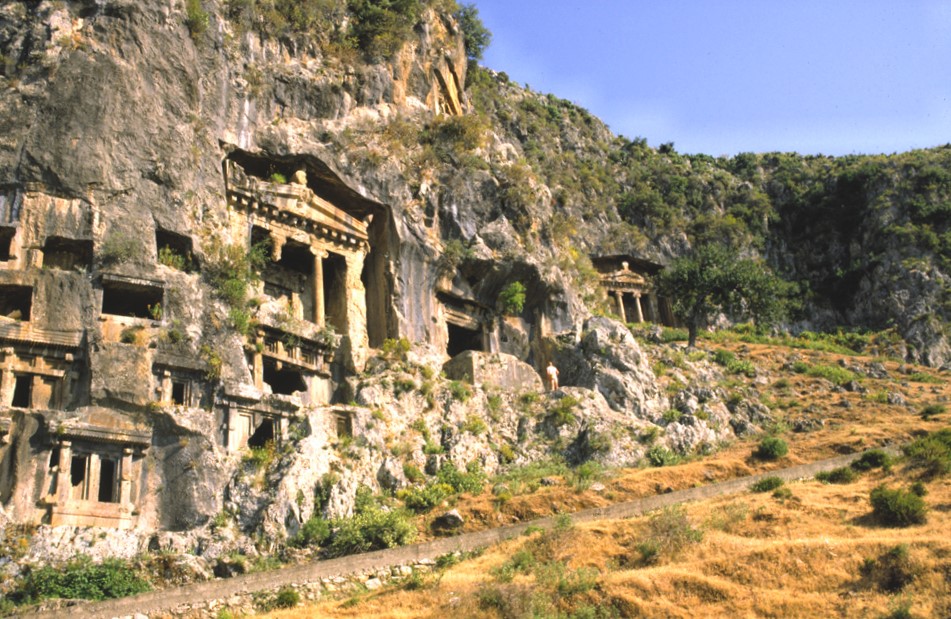 We finally rounded a headland and into Fethiye bay, a beautiful approach despite the many new tourist buildings being constructed along the foreshore. Rock tombs and fortifications were clearly visible up behind the town, and high mountains could be seen far inland. We anchored by ourselves in a peaceful cove across the big bay from the town. We enjoyed the most peaceful night for some time!
We finally rounded a headland and into Fethiye bay, a beautiful approach despite the many new tourist buildings being constructed along the foreshore. Rock tombs and fortifications were clearly visible up behind the town, and high mountains could be seen far inland. We anchored by ourselves in a peaceful cove across the big bay from the town. We enjoyed the most peaceful night for some time!
In the morning we motored the dinghy over to the town of Fethiye.
In terms of the voyage as a whole, this was an important stop for us. When we left Sydney in 1981, our general plans was to do a clockwise loop round the Pacific ocean, via Canada, Galapagos and French Polynesia. But while sailing down the US west coast we realised that the financial situation was acceptable, we were enjoying ourselves hugely, and we might as well transit the Panama Canal to the Caribbean and maybe think about crossing the Atlantic to Europe. Well, that's what happened, and while sailing east along the Mediterranean the question now arose, what next?
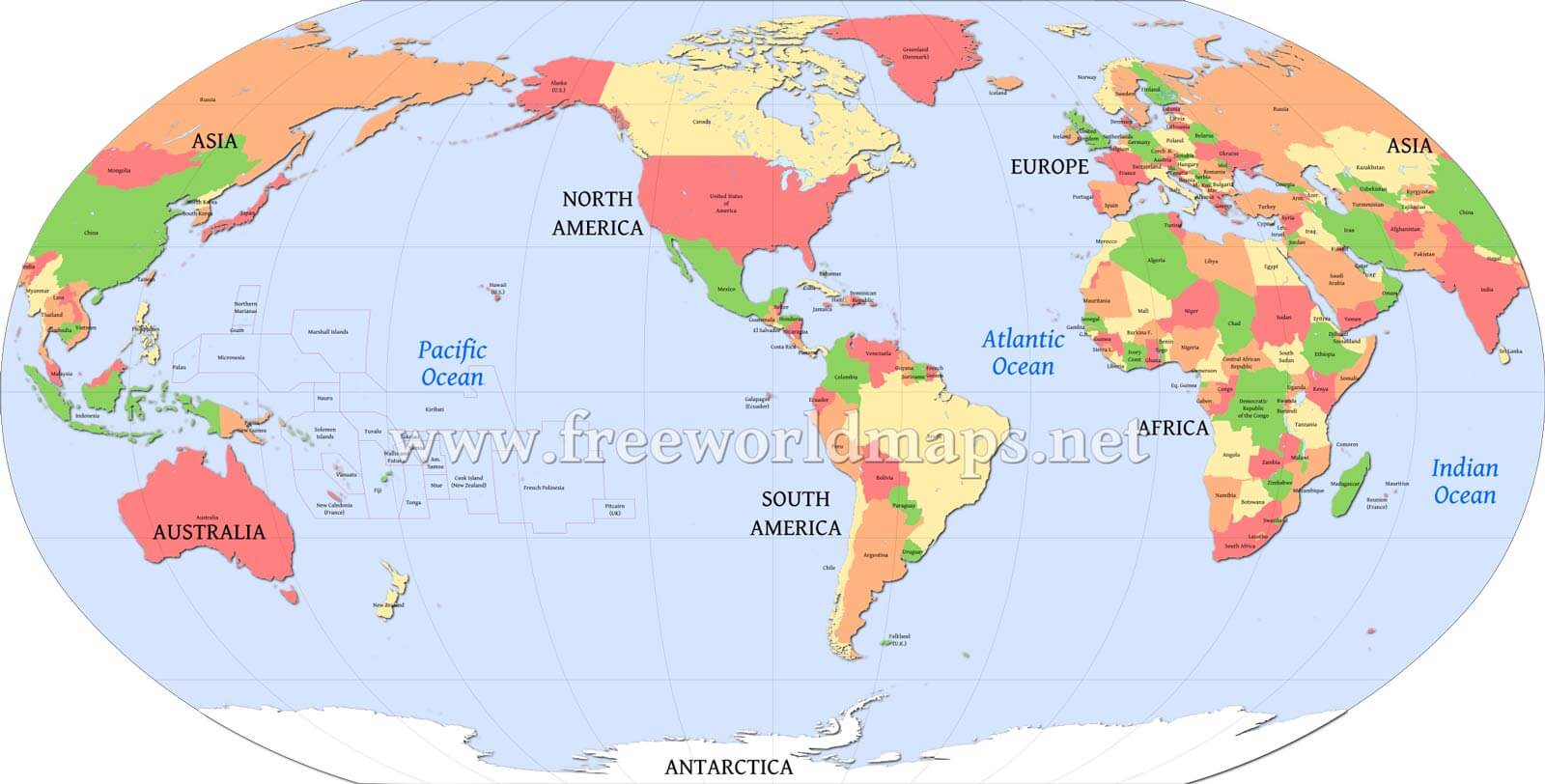 There were two main options: the first, to continue east and complete a circumnavigation via the Red and Arabian seas and south-east Asia; and the second, to turn west and leave the Med for the Caribbean, transit the Canal to the west, and return to Australia via the Galapagos and French Polynesia. This second option would make the total voyage longer and deny us circumnavigation bragging rights, but in our developing view would be much more fun. And we liked the idea of riding the classic trade wind routes sailing west in the tropics, given that we had taken a fair bit of battering while so far sailing much more than half way round the world to the east. The decision made itself, and Fethiye emerged as the obvious turning point.
There were two main options: the first, to continue east and complete a circumnavigation via the Red and Arabian seas and south-east Asia; and the second, to turn west and leave the Med for the Caribbean, transit the Canal to the west, and return to Australia via the Galapagos and French Polynesia. This second option would make the total voyage longer and deny us circumnavigation bragging rights, but in our developing view would be much more fun. And we liked the idea of riding the classic trade wind routes sailing west in the tropics, given that we had taken a fair bit of battering while so far sailing much more than half way round the world to the east. The decision made itself, and Fethiye emerged as the obvious turning point.
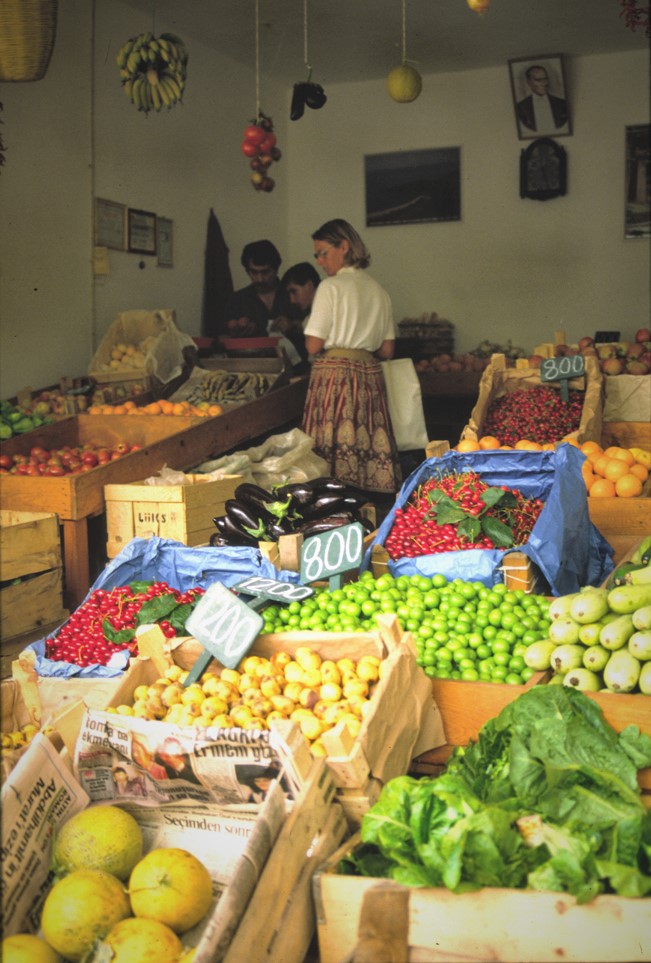 Ashore, along the wharf (also des
Ashore, along the wharf (also des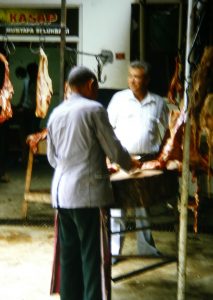 cribed as the "marina") there were some touristy souvenir shops, but further into the town the shops were open and offering a good range of provisions and excellent bread everywhere. In the older part of town some genuinely old buildings were scattered among the much newer, cubic concrete dwelling so common around here. In the outer regions women were humping big cloth bags, and they - with all others - were smiling and friendly. The market was the best since leaving Italy, with good fruits and vegetables. The meat was mostly lamb, available in big lumps at low prices. A butcher in the market told us that he had never sold brains to a tourist before! The fish were far better than usually seen in the Med: good trout and
cribed as the "marina") there were some touristy souvenir shops, but further into the town the shops were open and offering a good range of provisions and excellent bread everywhere. In the older part of town some genuinely old buildings were scattered among the much newer, cubic concrete dwelling so common around here. In the outer regions women were humping big cloth bags, and they - with all others - were smiling and friendly. The market was the best since leaving Italy, with good fruits and vegetables. The meat was mostly lamb, available in big lumps at low prices. A butcher in the market told us that he had never sold brains to a tourist before! The fish were far better than usually seen in the Med: good trout and
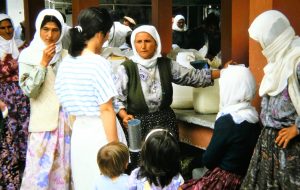 grouper.
grouper.
Over the following days we did more exploring of the town and environs. The market was always busy; among the sellers were local women in white headscarves selling home-made yogurt. The older men sat in small cafes with the coffee and cigarettes. 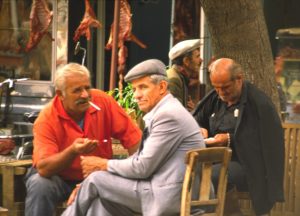
In a bazaar area there were many carpet and kilim shops, with many examples very beautiful. For Norma's b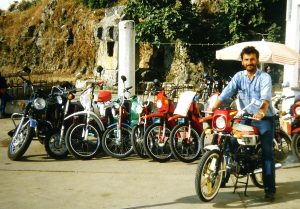 irthday we ate out for dinner at the pleasant Aphrodite restaurant: mezes and spicy meat balls, good.
irthday we ate out for dinner at the pleasant Aphrodite restaurant: mezes and spicy meat balls, good.
We decided to do some exploring of the countryside, and rented a 50cc Puch moped for the day from Osman, who insisted on giving us tea to get us going. We set off first for the village of Karakoy, or Levissi. This was abandoned soon after WW1 and the settlement of the Turkish war of independence, when Greece and Turkey forced mass migrations to "purify" each others' territory. The abandoned village was left as a memorial for those turbulent times, but we didn't get to visit because it was at the top of a steep hill and the little Puch couldn't make it.
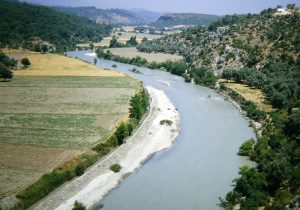 So then we headed south for about 60km towards Xanthos, riding along the lovely river valley. Alongside ran fast, milky green streams carrying melted snow through stands of pink oleander. People were bustling and busy in the countryside, every person with a smile and a wave. Women and girls in baggy pants were carrying loads in cloth backpacks leading donkeys and cattle in halters and goats on leads like dogs.
So then we headed south for about 60km towards Xanthos, riding along the lovely river valley. Alongside ran fast, milky green streams carrying melted snow through stands of pink oleander. People were bustling and busy in the countryside, every person with a smile and a wave. Women and girls in baggy pants were carrying loads in cloth backpacks leading donkeys and cattle in halters and goats on leads like dogs.
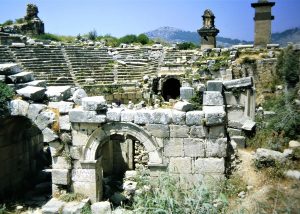 The bike made it to Xanthos, and up a stony dirt road to the old capital of Lycia. There is a striking amphitheatre there, with much older Lycian tombs behind it. There were lovely views over the river valley from the ruins of a palace. We returned down to the village through the ruins of ancient residential areas, passing a Byzantine basilica and visiting another collection of rock tombs and another pillar tomb.
The bike made it to Xanthos, and up a stony dirt road to the old capital of Lycia. There is a striking amphitheatre there, with much older Lycian tombs behind it. There were lovely views over the river valley from the ruins of a palace. We returned down to the village through the ruins of ancient residential areas, passing a Byzantine basilica and visiting another collection of rock tombs and another pillar tomb.
We had lunch in the village: very good kebabs, lamb, beef and liver, with aubergines and bread. Sitting by the roadside it was very reminiscent of the times we spent in Niazi's kebab in Cyprus, more 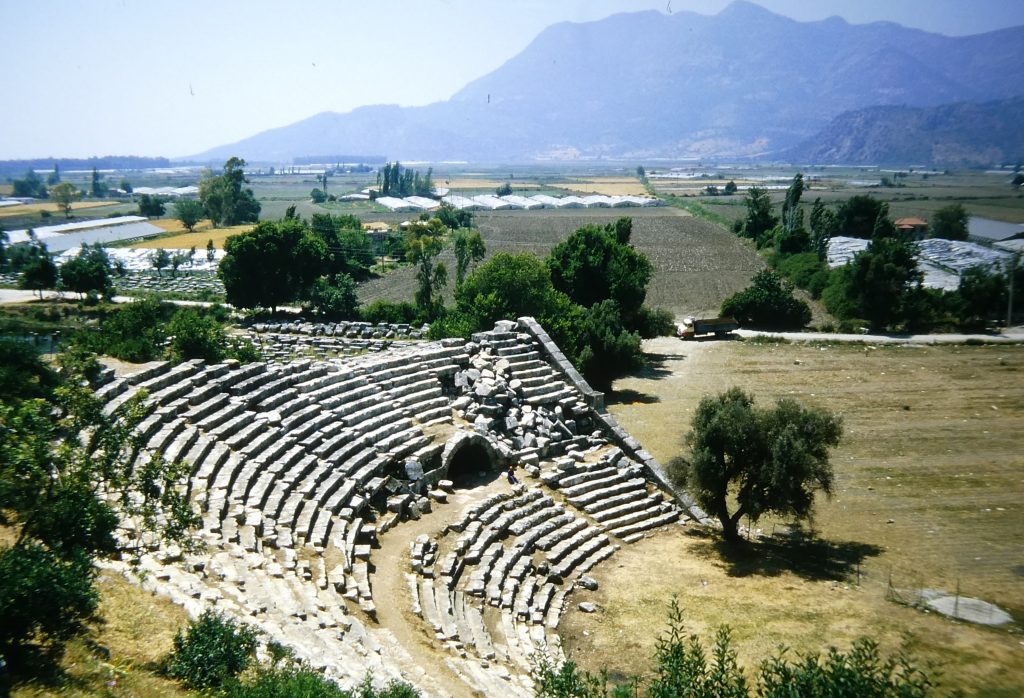 than 20 years before. We continued then to Letoon, an ancient sanctuary and meeting place w
than 20 years before. We continued then to Letoon, an ancient sanctuary and meeting place w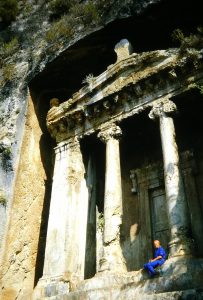 ith three temples and many submerged ruins as home for frogs and terrapins. There was another impressive theatre there, where we were greeted by Osman, who showed us around. There were few other tourists and no buses.
ith three temples and many submerged ruins as home for frogs and terrapins. There was another impressive theatre there, where we were greeted by Osman, who showed us around. There were few other tourists and no buses.
The moped was getting a bit hard on our bottoms by then, so we set off back, still needing a few rests and occasional walks by Norma when the bike wouldn't go up the steeper hills. We returned for a closer look at the magnificent rock tombs behind Fethiye, particularly impressive in the late afternoon sun. After a busy day we returned the bike to the man and enjoyed more tea with him.
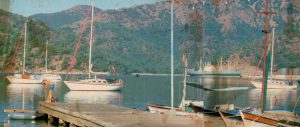 The weather was continuing fine when we left this great harbour with good memories. We motored north west this time, having made our strategic turn of direction westward, and entered another big bay complex centred on village of Gocek.
The weather was continuing fine when we left this great harbour with good memories. We motored north west this time, having made our strategic turn of direction westward, and entered another big bay complex centred on village of Gocek.
We pottered around some boats anchored off the village and tied along the two wharves, but ended up anchoring in a small cove called "the creek" on the other side of the bag bay, near the hefty (but quiet) Paterson's commercial wharf. There were spectacular red mountainsides all around, Ashore there was a pleasant little picnic place with a stream running through.
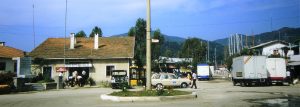 There were also signs here of the early development of a marina that was intended to fill the cove with marina berths. We already understood that attracting yachts, including charter fleets, to Turkey was an important part of its plans for the tourist industry here.
There were also signs here of the early development of a marina that was intended to fill the cove with marina berths. We already understood that attracting yachts, including charter fleets, to Turkey was an important part of its plans for the tourist industry here.
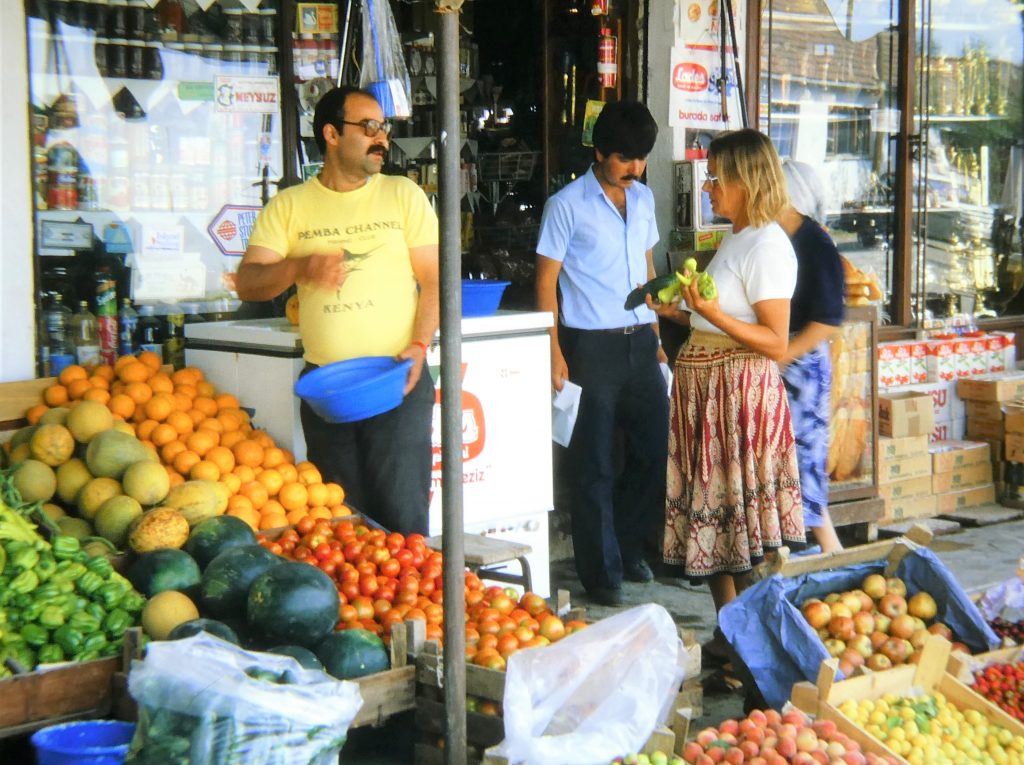 Gocek was a village best described as ramshackle! There were scattered small shops and a few restaurants in the outskirts, and more touristy places along the road by the town wharves. The shopkeepers here were more pushy than we had experienced so far, presumably because there were more tourist visitors. But there were excellent provisions to be found, perhaps because of the requirements of the charter flotillas. We were introduced to the most prominent of the food store owners, "greasy Mohamed", who became a major contributor to our own stores and those of other yachts.
Gocek was a village best described as ramshackle! There were scattered small shops and a few restaurants in the outskirts, and more touristy places along the road by the town wharves. The shopkeepers here were more pushy than we had experienced so far, presumably because there were more tourist visitors. But there were excellent provisions to be found, perhaps because of the requirements of the charter flotillas. We were introduced to the most prominent of the food store owners, "greasy Mohamed", who became a major contributor to our own stores and those of other yachts.
We quickly became involved in the social life of the yachts, including many old friends and new, including some of the charter fleet skippers. Among them were Ives and Marta, whom we had met in La Coruna and were now living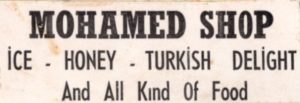 ashore in Gocek and running one of the fleet operations.
ashore in Gocek and running one of the fleet operations.
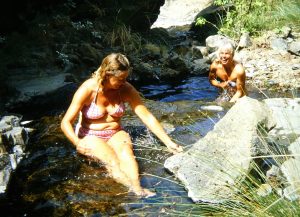 On the boat we got stuck into lots of maintenance, including cleaning both above and under the water, varnishing the teak trim, checking and fixing up the mast and rigging, while Norma was checking the sails and bringing them up to standard. One evening pretty much the whole cruising group brought food and wood over to the picnic area for a big barbeque, lots of fun.
On the boat we got stuck into lots of maintenance, including cleaning both above and under the water, varnishing the teak trim, checking and fixing up the mast and rigging, while Norma was checking the sails and bringing them up to standard. One evening pretty much the whole cruising group brought food and wood over to the picnic area for a big barbeque, lots of fun.
With most of the work done we took a lovely walk up the creek into the hills, through a cleft in the rugged rocks and into green pine forests. We came across baby tortoises and lizards, a partridge, and some wild pigs. Along the stream there were several little waterfalls and pools, and we took the opportunity for a freshwater dip.
Soon before we had to leave, we were invited to dinner with Ives and Marta in their apartment overlooking the countryside, along with some other experienced cruisers. Like us, one couple had also sailed Central America, had cruised Belize and even come across "hard-luck Charlie" there.
In Fethiye and Gocek we had spent two happy and busy weeks and got the boat into very good shape for getting on the move again, with more extended sailing westward ahead of us. Gocek lies at the head of a long gulf, Skopea Liman, protected by the mainland on the west side and a line of islands to the east, all indented by a multitude of pine-forested coves. We motored 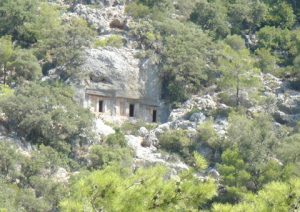
 gently down to the first of these, Valley Bay, where there is a fresh-water spring. From this runs a hose that can be led to a yacht tied to the shore. We set the anchor in very deep water and tied the stern to a tree. Borrowing two more hoses from other boats we managed to get connected up and fill our tanks and jerries.
gently down to the first of these, Valley Bay, where there is a fresh-water spring. From this runs a hose that can be led to a yacht tied to the shore. We set the anchor in very deep water and tied the stern to a tree. Borrowing two more hoses from other boats we managed to get connected up and fill our tanks and jerries.
The next stop down was at Tomb Bay, with a few Lycian tombs in the cliff face above us. There was little space of anchorable depth and there was a chop rolling in, so we moved back to a longer inlet, Boynuz Buku, where we anchored off a bed of reeds. By this time, in early June, the number of boats was rapidly increasing.
Also up was the summer heat, even at night, and Norma was felled by a short-lived bout of heat exhaustion. There was a basic restaurant ashore, and crews from three other yachts joined us for a very chatty dinner out, eating under the trees. Nearby, another freshwater pipe was set up for a refreshing shower. Over the next few days we continued socialising, walking and boat maintenance until it got too hot.
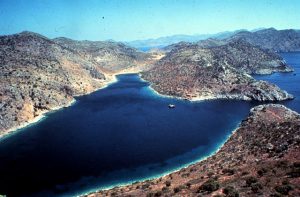
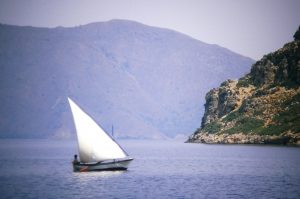 From there we day motorsailed west for 50 nautical miles or so, leaving Marmaris far to our north, and rejoined the Datca peninsula near where we had earlier stopped at Bozuk Buru. This time we entered the fjord-like Serce Limani, through a narrow gap in the grey and stony hillsides. After entering we could go left or right, all surrounded by this barren hillside cut by gorge-like clefts.
From there we day motorsailed west for 50 nautical miles or so, leaving Marmaris far to our north, and rejoined the Datca peninsula near where we had earlier stopped at Bozuk Buru. This time we entered the fjord-like Serce Limani, through a narrow gap in the grey and stony hillsides. After entering we could go left or right, all surrounded by this barren hillside cut by gorge-like clefts.
We anchored up at the end of the northward bay and anchored in a patch of sand among the weeds. In its way it was a very peaceful and pleasant anchorage. There were a few huts around, looking like goat sheds but apparently also used by their herdsmen and boys. The stony shores were very unlike the pine forests we had just left. We swam in very cold water to clean off the bottom, and cleared out the partly blocked engine water cooling inlet.
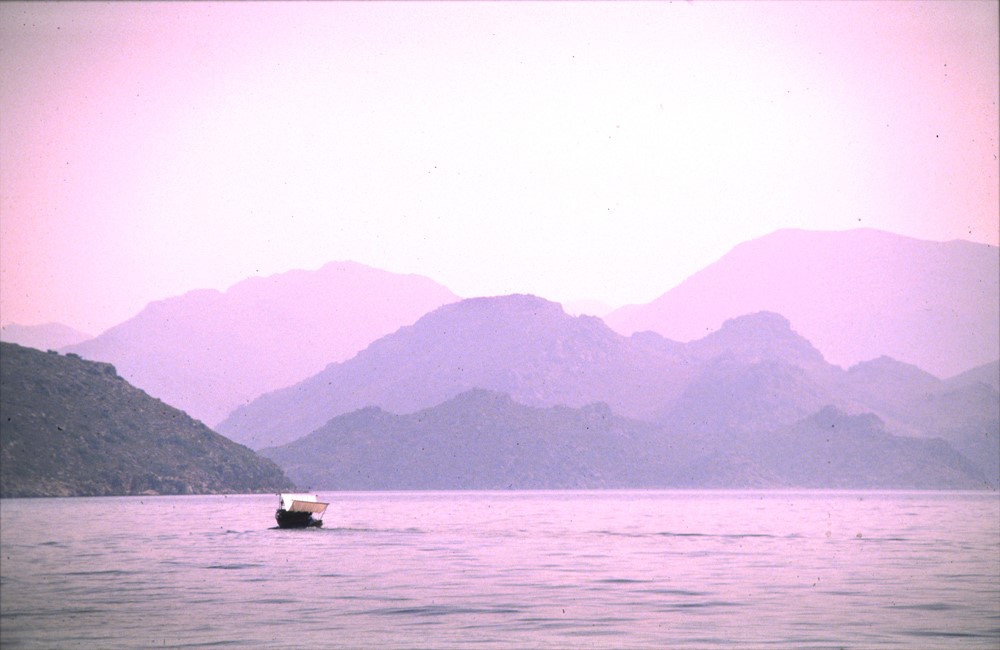
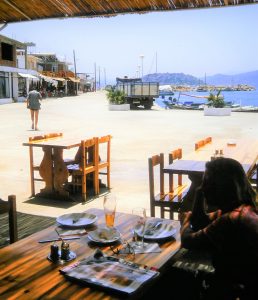 The next day we rounded the end of the peninsula and turned up towards Bozburun Limani. There was a lovely entrance to this enclosed bay, surrounded by hazy layers of hills with the village at the head. There were plenty of good-looking anchorages among the several islets, all covered by both old and new ruins, the ground covered by oleanders trying to survive. We anchored in an undeveloped bay to the south-west of the town and went ashore for lunch at a
The next day we rounded the end of the peninsula and turned up towards Bozburun Limani. There was a lovely entrance to this enclosed bay, surrounded by hazy layers of hills with the village at the head. There were plenty of good-looking anchorages among the several islets, all covered by both old and new ruins, the ground covered by oleanders trying to survive. We anchored in an undeveloped bay to the south-west of the town and went ashore for lunch at a 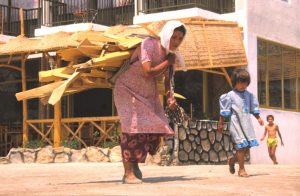 welcoming restaurant: doner kebab with salad and pilaf, dirt cheap. The shops were good, too, again with very friendly owners. We had a chat with the British skipper of a charter flotilla and with an Australian physio working at Westmead. She was for a time selling carpets and kilims, and gave us a good rundown on what to look for.
welcoming restaurant: doner kebab with salad and pilaf, dirt cheap. The shops were good, too, again with very friendly owners. We had a chat with the British skipper of a charter flotilla and with an Australian physio working at Westmead. She was for a time selling carpets and kilims, and gave us a good rundown on what to look for.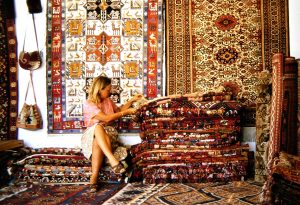
In the inner part of the village the dwellings were poor, sitting among shipyards and smaller yards for smaller boats. Along the waterfront gulets were being fitted out and finished off; shops by the water were selling good boating gear. It got very windy in the afternoon and a gulet, inevitably, and as usual relying on an old-fashioned fishermen's anchor, dragged across the anchorage. (They often did this!) There was a strong nautical flavour to the whole of the town, with a sailmaker spreading canvas as the goats walked by.
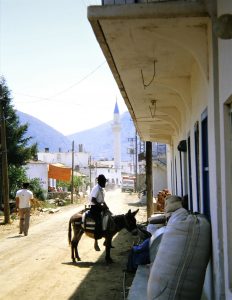
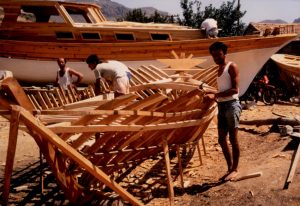 The next day we took the dinghy out for a round of the coves in the bay, almost all being busy building and maintaining gulets. They were in a amazing setting, surrounded by rocky hills layering up behind, with green trees in the beds of creeks. The gradual slope of the waterfront land here made for relatively easy launching.
The next day we took the dinghy out for a round of the coves in the bay, almost all being busy building and maintaining gulets. They were in a amazing setting, surrounded by rocky hills layering up behind, with green trees in the beds of creeks. The gradual slope of the waterfront land here made for relatively easy launching.
We were joined in the bay by a catamaran whose British skipper, it turned out, had been a racing driver in the sixties and early seventies. This was Peter Westbury, to become best known as a championship-winning hillclimb driver. He also ran his own motorsport business, drove twice in Formula One and raced at Le Mans and the Targa Florio. Unsurprisingly we had a great deal to talk about, and we spent a fair bit of time with him and Jenny.
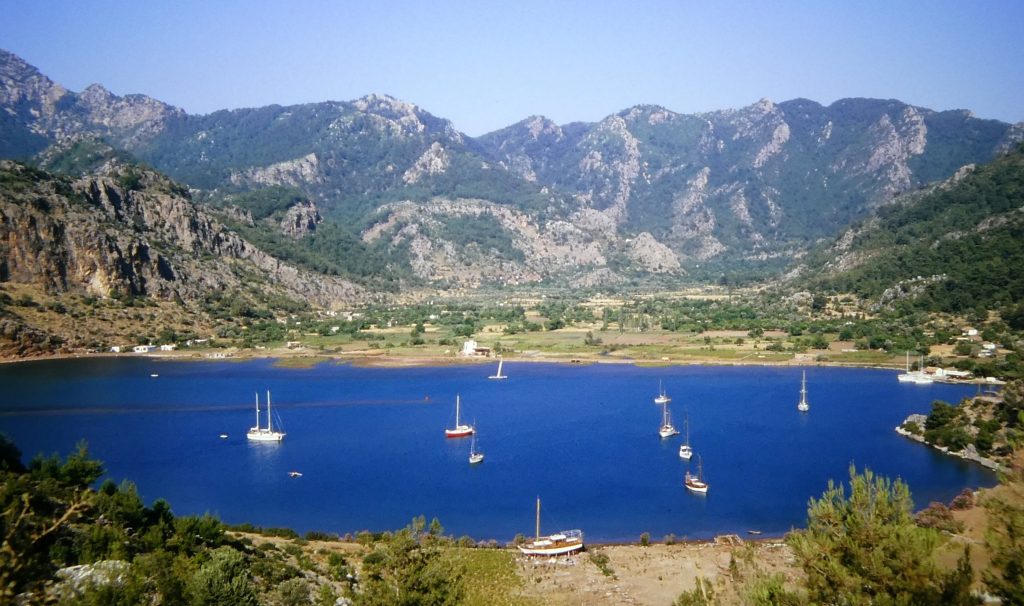
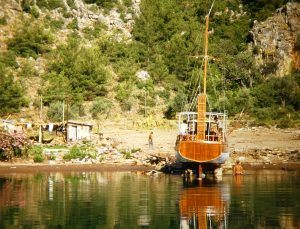 We then sailed up a beautiful stretch of water among multiple small islands to the bay of Keci Buku. This was a long inlet, with a Byzantine fort prominent on an islet on its west side. There were a few small hotels and restaurants in a splendid setting. We anchored off yet another boat yard among the oleanders, goat bells tinkling. We watched a small gulet quite casually being launched from the beach.
We then sailed up a beautiful stretch of water among multiple small islands to the bay of Keci Buku. This was a long inlet, with a Byzantine fort prominent on an islet on its west side. There were a few small hotels and restaurants in a splendid setting. We anchored off yet another boat yard among the oleanders, goat bells tinkling. We watched a small gulet quite casually being launched from the beach.
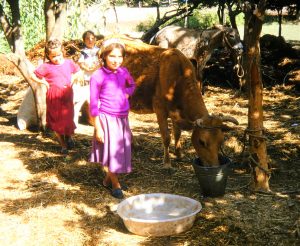 It was a lovely walk ashore the following day, first taking a dirt road past Kardi's restaurant and into the fields, all very lush. We came across many local families, with the women doing most of the work and the children looking after the goats and sheep.
It was a lovely walk ashore the following day, first taking a dirt road past Kardi's restaurant and into the fields, all very lush. We came across many local families, with the women doing most of the work and the children looking after the goats and sheep.
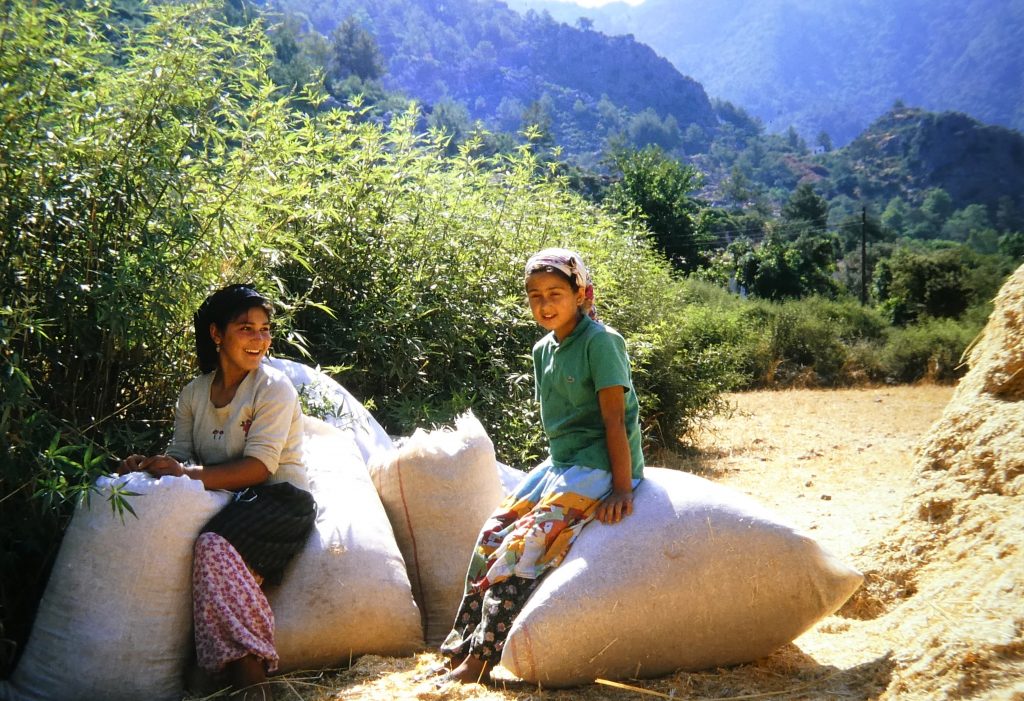 They were all making up bags of feed. Little girls gave us flowers. We passed through the simple little village of Oraniye, with a minaret and trough in the central square. A couple
They were all making up bags of feed. Little girls gave us flowers. We passed through the simple little village of Oraniye, with a minaret and trough in the central square. A couple  was selling vegetables from a truck. The backdrop for all this featured cliffy crags and pine trees, oleanders everywhere. The women and girls wore colourful dresses over baggy pants,
was selling vegetables from a truck. The backdrop for all this featured cliffy crags and pine trees, oleanders everywhere. The women and girls wore colourful dresses over baggy pants, 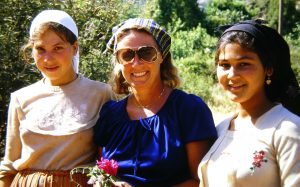 and white and coloured headscarves. The bigger bags were carried n their backs, held on by a pair of colourful woven straps.
and white and coloured headscarves. The bigger bags were carried n their backs, held on by a pair of colourful woven straps.
On the way back we were summoned into the market garden of Aydogan, an entrepreneurial character with a "shopping list". of fruit, veg and much else, translated into English, German and French. We sat and nibbled cucumbers apricots and plums as the kids gathered a kilo of honey, potatoes, apricots and plums. Just down the road was a butcher - he would bring what we bought to the boat.
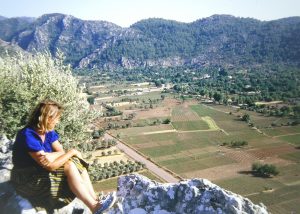
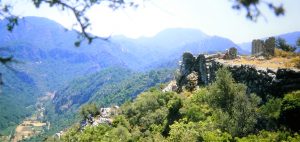 More long walks followed during this wonderful stay, including up to a rock outcrop high on a hill with lovely view over a river valley extending from the sea to the mountains, with spreading acres of fertile fields. Again, scores of women could be seen tending green rows of plants in dark, irrigated soil punctured by wells. At times we also walked over the ridges between the several bays. coming across many more rural sights and the ruins of an ancient city, to which we were guided by a helpful boy who could see we were lost. We had outstanding views from here and other places, and all to ourselves.
More long walks followed during this wonderful stay, including up to a rock outcrop high on a hill with lovely view over a river valley extending from the sea to the mountains, with spreading acres of fertile fields. Again, scores of women could be seen tending green rows of plants in dark, irrigated soil punctured by wells. At times we also walked over the ridges between the several bays. coming across many more rural sights and the ruins of an ancient city, to which we were guided by a helpful boy who could see we were lost. We had outstanding views from here and other places, and all to ourselves.
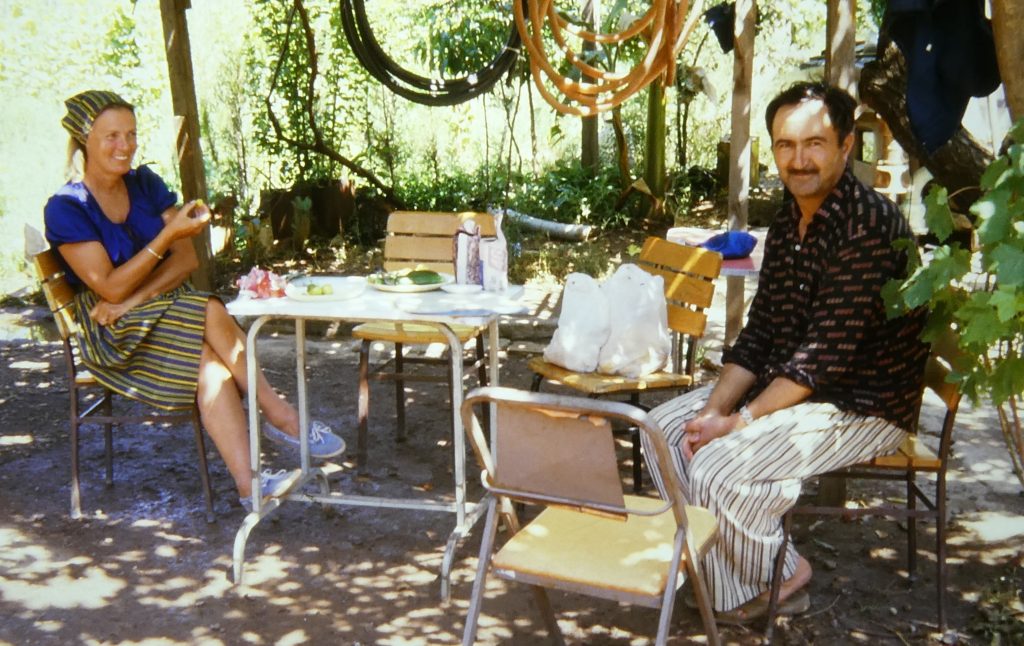 We tended to end up at Halil's restaurant, drink lots of water and then enjoy kofte with salad, yogurt and cucumber, soup, bread and beer, usually on our own, tended to by the friendly owner, his wife and children. Everything there was spotless, with smart and colourful tablecloths. We sat out under the willow trees and surrounded by their garden, from which our vegetables were picked and washed in the fountain.
We tended to end up at Halil's restaurant, drink lots of water and then enjoy kofte with salad, yogurt and cucumber, soup, bread and beer, usually on our own, tended to by the friendly owner, his wife and children. Everything there was spotless, with smart and colourful tablecloths. We sat out under the willow trees and surrounded by their garden, from which our vegetables were picked and washed in the fountain.
After finally getting under way again, we meandered through several little coves along the south side of the Datca peninsula but none looked particularly interesting and we anchored again in the harbour of Datca, where we had entered. We went ashore to do some basic shopping and change some money, but there was no other reason to stop in this unattractive place. We spent the night there and then sailed to the western tip of the Datca promontory to the harbour of Knidos.
The mouth of the harbour faces south-east, protected from the west and the prevailing NW winds by a hook of land (Cape Krio) and is further protected by a pair of breakwaters, one partly sunken.
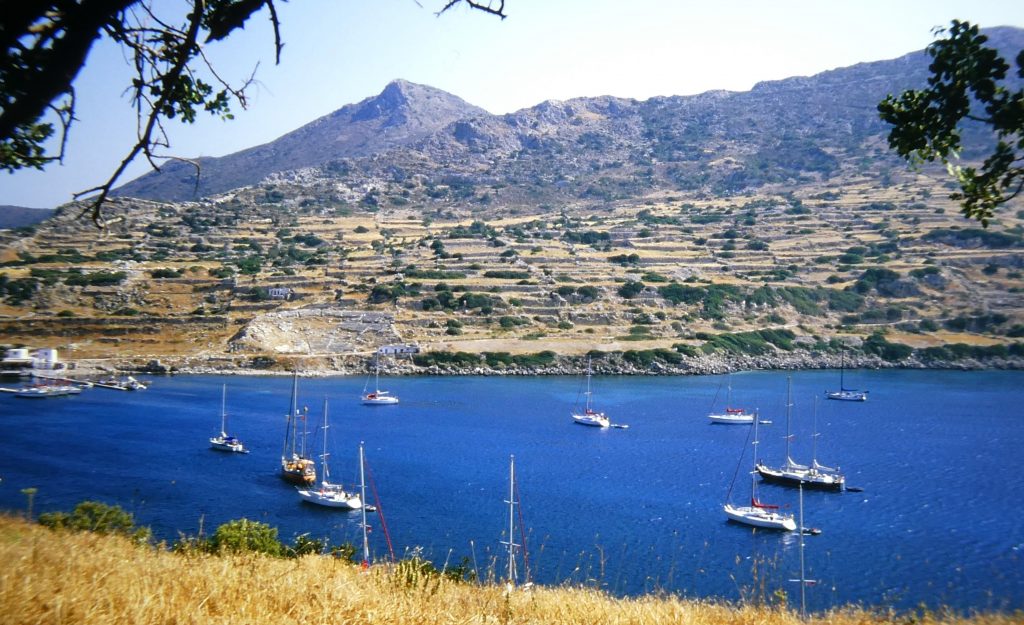 We anchored in about six metres in the northern part of the bay, good holding in a patch of sand. The other side of the bay, which on first glance looked better protected, but for us was too popular - and becoming more so - with charterers, and gulets, which Norma was now terming "goolies". We did not trust the anchoring of either group. A flotilla did come in just as the wind increased, they all dragged and ended up tying stern-to to the rickety restaurant pier at the end. We met up with the flotilla skipper later, an experienced but worried man.
We anchored in about six metres in the northern part of the bay, good holding in a patch of sand. The other side of the bay, which on first glance looked better protected, but for us was too popular - and becoming more so - with charterers, and gulets, which Norma was now terming "goolies". We did not trust the anchoring of either group. A flotilla did come in just as the wind increased, they all dragged and ended up tying stern-to to the rickety restaurant pier at the end. We met up with the flotilla skipper later, an experienced but worried man.
In ancient times Knidos was one of the capital cities of the ancient world, and (with Kos) one of the two main centres for the healing arts.
The start of next morning's walk was to the end of the bay and over an isthmus 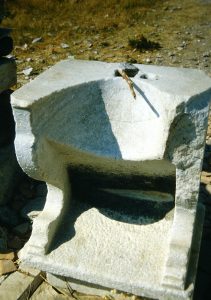 to a lagoon that had been the anchorage for triremes in ancient times. From there we returned and walked up the northern side of the bay and to the extensive remains of a
to a lagoon that had been the anchorage for triremes in ancient times. From there we returned and walked up the northern side of the bay and to the extensive remains of a 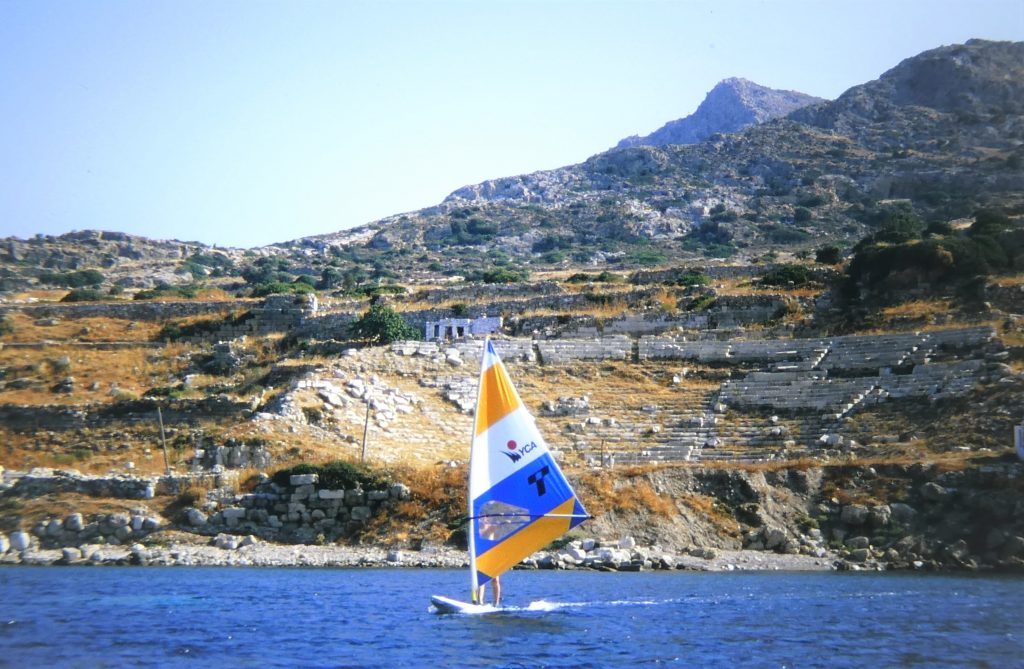 large Roman city. Acres of ruins were scattered over the rocky hillsides. There was an all-pervading sense of the passage of civilisation after civilisation, as the excavations over time have uncovered layer on layer of building upon building, temple upon temple. The theatre was well preserved, with superb marble seating in the lower levels. There was a lovely little sundial, in the shape of a chair.
large Roman city. Acres of ruins were scattered over the rocky hillsides. There was an all-pervading sense of the passage of civilisation after civilisation, as the excavations over time have uncovered layer on layer of building upon building, temple upon temple. The theatre was well preserved, with superb marble seating in the lower levels. There was a lovely little sundial, in the shape of a chair.
There was the usual incompetent performance in the evening with boats coming in late. One dragged into us, and Norma was becoming very edgy. The well-established north-west wind continued strong into the night and the following day. We stayed aboard to look after things as more bedraggled sailors entered late in the day and tried to get anchored in the admittedly difficult ground. I got on with letter-writing and Norma was cooking stuff like pizzas, bread, cake - as she said, facing shortages, anything that didn't need real food!
On the fourth night of these strong winds we were watching one of the gulets' shambolic efforts to raft up together one got its dinghy painter round its prop, then dragged its fishermen's anchor (their useless favourite), then dragged right out of the bay, just missing the rocks of the breakwater.
Without the constant wind and resulting dramas this was a pleasant and interesting anchorage, but as the wind finally eased a bit we left, sailed round the end of the peninsula and north to Bodrum. Meanwhile, in eastern Turkey, the stationary depression that had brought us the wind did a lot more damage there, with torrential rain and a disastrous landslide that wiped out a village and killed many of its people.
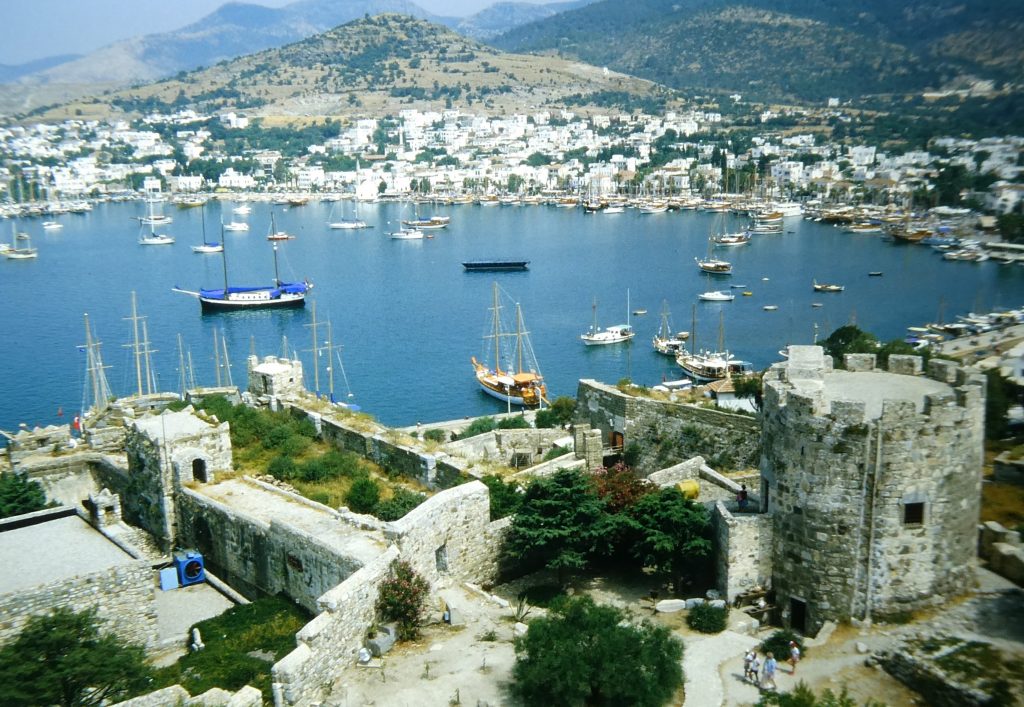 After all that we anchored in Bodrum harbour after a very pleasant sail. It was a biggish harbour, with gulets moored all around its harbour walls. There were over 300 operating out of Bodrum alone, and a much bigger fleet out of Marmaris.
After all that we anchored in Bodrum harbour after a very pleasant sail. It was a biggish harbour, with gulets moored all around its harbour walls. There were over 300 operating out of Bodrum alone, and a much bigger fleet out of Marmaris.
Several minarets were sounding off in sequence at regular intervals. The very impressive castle sat at the eastern side of its entrance. We took a quick walk and got some basic stores and water from the mosque ablutions tap. (We were never sure that this was the right thing to do, but water was always hard to get and many yachties did use these facilities when they were not otherwise occupied.)
There was a small marina at the inner end of the harbour, and we forecast that it would soon be enlarged and anchoring would no longer be allowed. The anchored yachts were already something of an obstruction to the gulets, especially when it was dark, and we didn't feel that secure either.
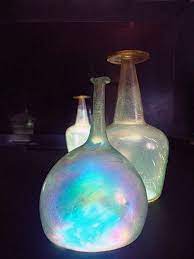 The next day we walked a couple of miles or so out along the beach to the east of the city, where there were several boatyards. We were needing to arrange to be hauled out for cleaning and antifouling the hull. Once out of the touristy part of the city we walked along a dusty road and around to another bay, with boatyards along the beach and fields just inland. The Agantur yard seemed acceptable, and the agent there was helpful. They also had all the needed supplies. Back aboard after a long hot walk back, we bought more stores and did some socialising among the many anchored yachts.
The next day we walked a couple of miles or so out along the beach to the east of the city, where there were several boatyards. We were needing to arrange to be hauled out for cleaning and antifouling the hull. Once out of the touristy part of the city we walked along a dusty road and around to another bay, with boatyards along the beach and fields just inland. The Agantur yard seemed acceptable, and the agent there was helpful. They also had all the needed supplies. Back aboard after a long hot walk back, we bought more stores and did some socialising among the many anchored yachts.
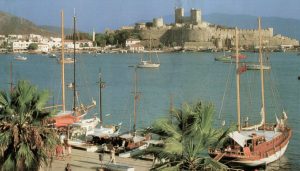 We visited the castle, an impressive structure, built in the 16th century by crusaders and then taken over by Turks. It was an extraordinary jumble of towers walls and gardens from different eras. Throughout the castle there were rooms for sections of the excellent museum of marine archaeology, including a superb display of glassware from wrecks, from ancient to medieval times. Each piece was lit from below, sitting on dark ground in an unlit hall. Outside there was a tourist camel, while at the same time working camels were being led along the waterfront.
We visited the castle, an impressive structure, built in the 16th century by crusaders and then taken over by Turks. It was an extraordinary jumble of towers walls and gardens from different eras. Throughout the castle there were rooms for sections of the excellent museum of marine archaeology, including a superb display of glassware from wrecks, from ancient to medieval times. Each piece was lit from below, sitting on dark ground in an unlit hall. Outside there was a tourist camel, while at the same time working camels were being led along the waterfront.
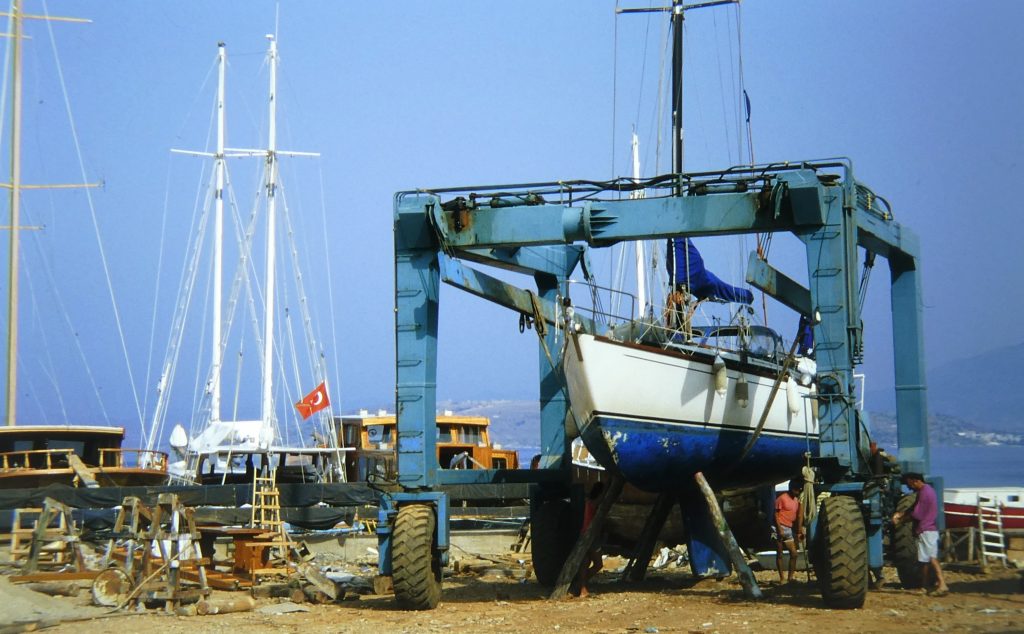 We then motored Cera to the Agantur boatyard, and she was lifted out quickly and efficiently from the water with a travelift and propped up by tree trunks set into holes dug into the ground with picks. Our efforts to keep the bottom clean by wiping and scrubbing while we swam had done well, so there was little weed and slime to be cleaned off. Norma got on with wet sanding, while I ground out a few blisters. The only troublesome patch of "osmosis" was on the rudder, but it was fairly easily ground out and refilled with epoxy. Our work was watched by wandering cows and goats. We swam in clear water to clean off. There were gulets being finished off in the yard, and many more in other yards along the beach.
We then motored Cera to the Agantur boatyard, and she was lifted out quickly and efficiently from the water with a travelift and propped up by tree trunks set into holes dug into the ground with picks. Our efforts to keep the bottom clean by wiping and scrubbing while we swam had done well, so there was little weed and slime to be cleaned off. Norma got on with wet sanding, while I ground out a few blisters. The only troublesome patch of "osmosis" was on the rudder, but it was fairly easily ground out and refilled with epoxy. Our work was watched by wandering cows and goats. We swam in clear water to clean off. There were gulets being finished off in the yard, and many more in other yards along the beach.
There was no fresh water available apart from a well. The electricity supply was simply dead dodgy, with leads meandering around the yard, punctuated by rickety junction boxes where wires were attached by sticks, tape and broken plugs.
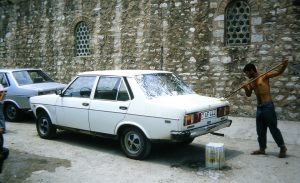 We hitched a lift into town to try to arrange a rental car for a quick tour of western Turkey. We tried all the well-known agencies, but they were very expensive and we were a bit despondent when we left the last one. While walking away a pleasant girl appeared from nowhere and said we should meet at a nearby café a little later. It turned out that she (Harika) was working at one of the rental agents and had heard our negotiations. We met with her and her brother Ali, who suggested we might like to rent his car, a respectable-looking Fiat 131 Mirafiore, for a week at half the big business price. Cash was exchanged, insurance was assured and checked, and we drove away in it back to the boat while they went off on their motorcycle.
We hitched a lift into town to try to arrange a rental car for a quick tour of western Turkey. We tried all the well-known agencies, but they were very expensive and we were a bit despondent when we left the last one. While walking away a pleasant girl appeared from nowhere and said we should meet at a nearby café a little later. It turned out that she (Harika) was working at one of the rental agents and had heard our negotiations. We met with her and her brother Ali, who suggested we might like to rent his car, a respectable-looking Fiat 131 Mirafiore, for a week at half the big business price. Cash was exchanged, insurance was assured and checked, and we drove away in it back to the boat while they went off on their motorcycle.
Overnight on the boat we were reassured to find that all the gulets - ashore and in the water - were being lived on, so there was a degree of security. In late June, therefore, we set off for our driving tour.
A quick drive around Anatolia, western Turkey
This little tour would take us round Anatolia, first up the western coast and then back down inland. Our first stop was at the busy market town of Milas, and from there to Didyma (unexpecdedly because we got lost) and its impressive temple.
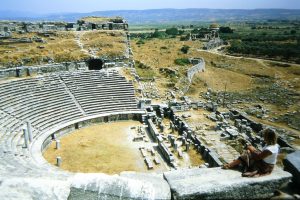 Miletos was once the greatest city of them all along this coast; it once had a harbour, but now lies 5km from the sea. The theatre is superb, with huge galleries.
Miletos was once the greatest city of them all along this coast; it once had a harbour, but now lies 5km from the sea. The theatre is superb, with huge galleries.
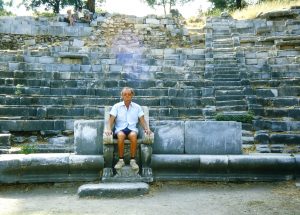 Prienne was a Hellenistic city, now featuring a lovely little council chamber and a theatre with lion seats in the front row, for priests only.
Prienne was a Hellenistic city, now featuring a lovely little council chamber and a theatre with lion seats in the front row, for priests only.
In Selcuk we stayed in a pleasant pension in preparation for an early start for Ephesus on the morrow.
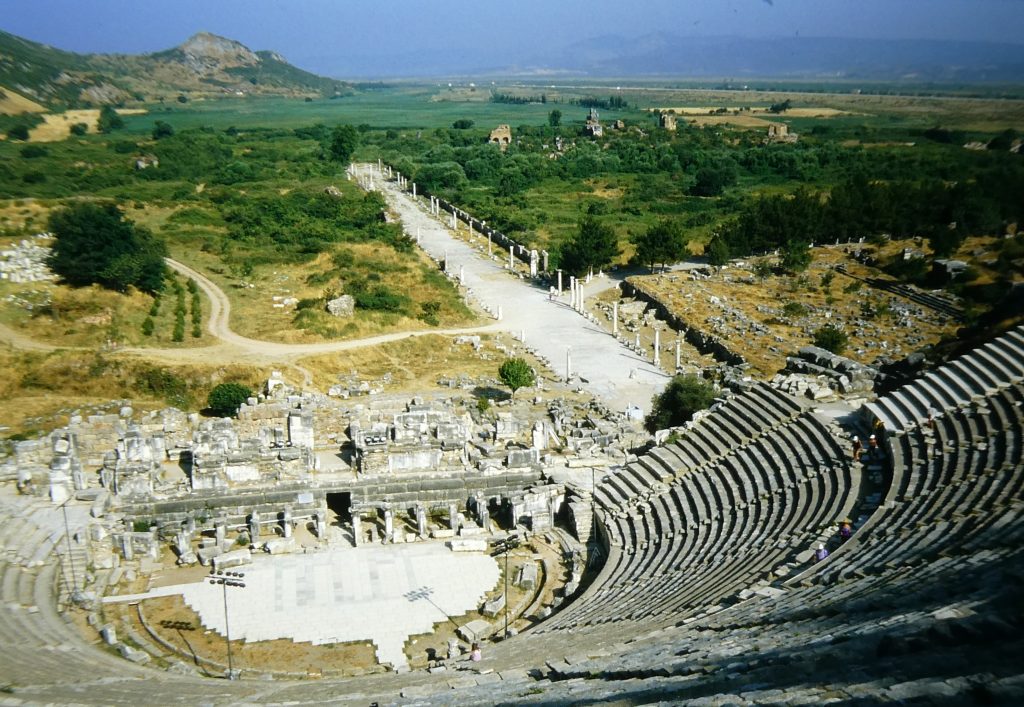 We beat most of the tourists to the site, and had most of it for ourselves and a handful of others for a couple of hours or so. So we saw the most important of the
We beat most of the tourists to the site, and had most of it for ourselves and a handful of others for a couple of hours or so. So we saw the most important of the 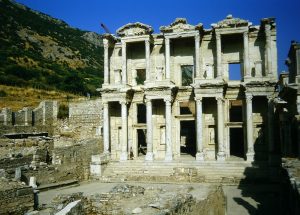 sights, including the magnificent library, in the golden light of the rising sun in the east. We then had an impressive drive to Izmir - where we had a good lunch - and
sights, including the magnificent library, in the golden light of the rising sun in the east. We then had an impressive drive to Izmir - where we had a good lunch - and 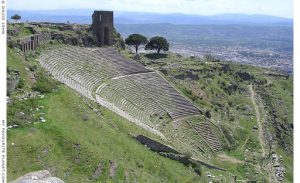 then on to Bergama and Pergamon. We drove and then walked to the top of the hill where stood in this grand situation the acropolis for this major city. We marvelled at the dangerous-looking steepness of the seating for the theatre, built into the face of the cliff. We spent the night in Ayvalik, a seaside resort, and ate at the harbourside's restaurant row.
then on to Bergama and Pergamon. We drove and then walked to the top of the hill where stood in this grand situation the acropolis for this major city. We marvelled at the dangerous-looking steepness of the seating for the theatre, built into the face of the cliff. We spent the night in Ayvalik, a seaside resort, and ate at the harbourside's restaurant row.
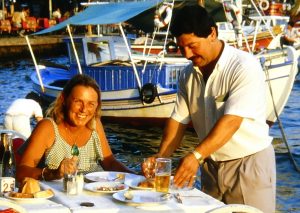 After a hot night we visited Troy, or rather the several layers of Troy that make it hard to interpret what you see. In Canakkale we took the ferry across the Dardanelles strait to the Gallipoli peninsula and over to Anzac Cove, on the western (Aegean) side.
After a hot night we visited Troy, or rather the several layers of Troy that make it hard to interpret what you see. In Canakkale we took the ferry across the Dardanelles strait to the Gallipoli peninsula and over to Anzac Cove, on the western (Aegean) side.
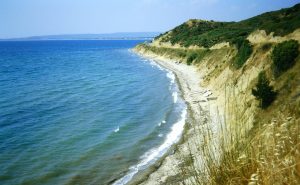 This little stretch of shingle had been given that name in 1985, just three years ago. The battlefields were peppered with simple, tasteful cemeteries, very well tended. We walked up the hill from the cove, marvelling at the heroism of the soldiers as they faced each other over a few metres between the trenches.
This little stretch of shingle had been given that name in 1985, just three years ago. The battlefields were peppered with simple, tasteful cemeteries, very well tended. We walked up the hill from the cove, marvelling at the heroism of the soldiers as they faced each other over a few metres between the trenches.
For the night we drove up to Malkara, a country industrial centre, where we would be sure to find accommodation, and booked into one of the only two hotels. It was a lot cooler than we had experienced for weeks, and we needed bedclothes for the first time in weeks! After another early start, having woken up the night clerk, we headed east through rolling countryside and increasing traffic to the great city of Istanbul. We left the car in an "otopark" near the Blue Mosque and looked for a hotel. There was a big gap between real scruffy and real expensive, but we found the Optimist Guesthouse, a great little place run by a South African girl, very clean and well presented.
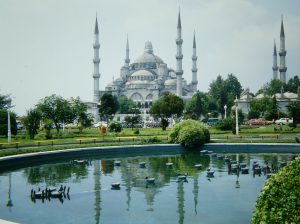 We soon got started on most of the recognized sights, including the Blue Mosque (big, but we have seen much more attractive mosques on a smaller scale) and the
We soon got started on most of the recognized sights, including the Blue Mosque (big, but we have seen much more attractive mosques on a smaller scale) and the 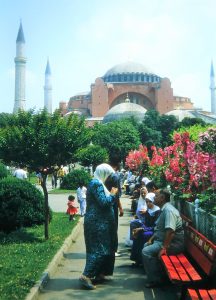 Saint Sophia basilica/mosque, now a nondenominational museum.
Saint Sophia basilica/mosque, now a nondenominational museum.
But for us easily the most memorable complex of buildings was Topkapi, the palace of the Ottoman sultans for hundreds of years, and now a collection of museums. They have beautifully restored part of the enormous labyrinth of the harem, centre of court intrigue, and in another part of the palace Norma was especially fascinated by the kitchen buildings. The pots they used were so enormous 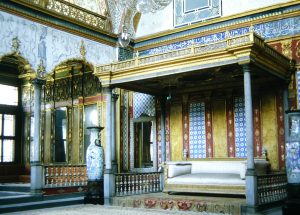 that she couldn’t even lift the lids of most of them.
that she couldn’t even lift the lids of most of them.
In the Treasury there is a display of some of the fabulous jewels of the Ottoman empire, said to rival the Crown Jewels in beauty and value. Iv was doubtful about that, but there were so many egg-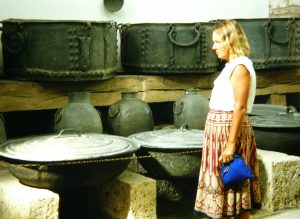 sized diamonds and much solid gold to be seen that it was easy to become very ho-hum about yet another slab of magnificence. It is an important place in the world of Islam, and Norma received a dirty glare from some Moslem pilgrims when an irrepressible giggle escaped her on being confronted by a hair of the beard of the Prophet.
sized diamonds and much solid gold to be seen that it was easy to become very ho-hum about yet another slab of magnificence. It is an important place in the world of Islam, and Norma received a dirty glare from some Moslem pilgrims when an irrepressible giggle escaped her on being confronted by a hair of the beard of the Prophet.
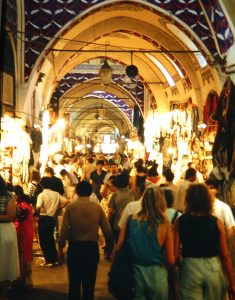 We pushed our way through the bazaar through the packed little streets of the famous covered market: hooting cars, noisy weaving machinery, groups of Hasidic Jews with black coats and hats. In the central part we found the constant hassling from the stall-holders and shop-keepers very trying, especially those selling carpets. “Carpet touts” are pretty pushy all over Turkey (outside Istanbul, the Turkish people as a whole were not pushy at all), but in that city they could be a real pain in the neck. The trouble is, when a pleasant-looking young man comes and offers help or information you have no idea whether he is being friendly or just trying to sell carpets, souvenirs, or in some cases restaurant meals. We found the best policy was to ignore their entreaties totally, but that’s a bit hard when they are standing in front of you and blocking your way! I lost my temper with a restaurant owner who wanted us to try his fish, wouldn’t take no for an answer and started cross-questioning us as to why we wouldn’t come in, and I shouted at him to leave us alone, not like me at all!
We pushed our way through the bazaar through the packed little streets of the famous covered market: hooting cars, noisy weaving machinery, groups of Hasidic Jews with black coats and hats. In the central part we found the constant hassling from the stall-holders and shop-keepers very trying, especially those selling carpets. “Carpet touts” are pretty pushy all over Turkey (outside Istanbul, the Turkish people as a whole were not pushy at all), but in that city they could be a real pain in the neck. The trouble is, when a pleasant-looking young man comes and offers help or information you have no idea whether he is being friendly or just trying to sell carpets, souvenirs, or in some cases restaurant meals. We found the best policy was to ignore their entreaties totally, but that’s a bit hard when they are standing in front of you and blocking your way! I lost my temper with a restaurant owner who wanted us to try his fish, wouldn’t take no for an answer and started cross-questioning us as to why we wouldn’t come in, and I shouted at him to leave us alone, not like me at all!
But off the tourist beat the locals were as nice as ever, and where the Turks do their trading in the outer reaches of the enormous market area we were not troubled at all. There is no room in the narrow alleys for even small carts, and most of the heavy wares are carried on the stooped-over backs of specialist porters, who use a sort of cradle strapped to their backs and carry incredible loads, way over 100 kilograms. Many of these men are quite old, with white beards, with a Semitic appearance; this has been a traditional occupation for these people for centuries. Heaven knows what it does to their spines in the long term, although one travel book we read was optimistic that no harm results. It didn't look that way.
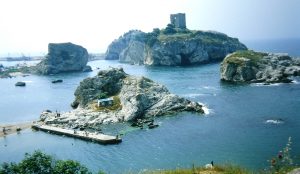 We picked up the newly-washed Fiat and drove away over the Galatea and Bosporus bridges. We pulled off the main road too early and got lost in terrible slumlands, in combat with belching trucks, buses and taxis. Once untangled we drove north-east over rolling countryside to the Black Sea resort of Sile, where the coast was : green, rolling hillsides, colourful fields, looking very much like the Sussex downs. Then south on to the inland route, climbing through attractive hills to plateau country, with miles and miles of wheat fields.
We picked up the newly-washed Fiat and drove away over the Galatea and Bosporus bridges. We pulled off the main road too early and got lost in terrible slumlands, in combat with belching trucks, buses and taxis. Once untangled we drove north-east over rolling countryside to the Black Sea resort of Sile, where the coast was : green, rolling hillsides, colourful fields, looking very much like the Sussex downs. Then south on to the inland route, climbing through attractive hills to plateau country, with miles and miles of wheat fields.
It was harvest time, much of it being done in the traditional manner with scythes and winnowing by hand. Farming is, we observed, very labour-intensive in Turkey; it is not unusual to see one person looking after a single cow as it grazes, and common to see small herds of healthy-looking cows, sheep or goats being led around on strings. The people of the countryside are poor in the sense that they have no money, but they certainly have plenty to eat. Their houses are very simple, mostly wooden dwellings or a mixture of wood and mud brick. The scent of barbequed meat from roadside restaurants was everywhere.
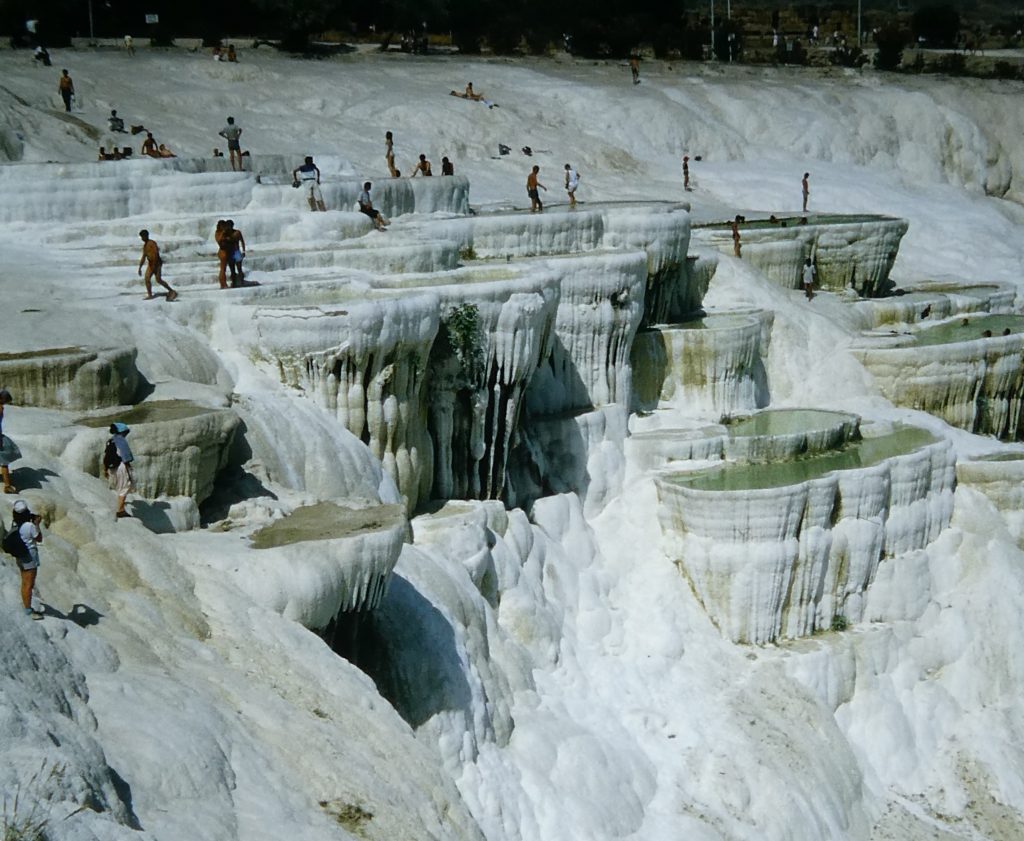
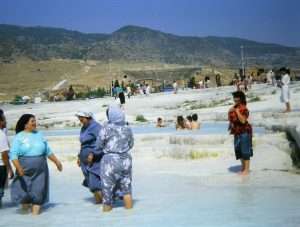 The route continued south to our destination of Pamukkale, with its famous white terraced cliffs and cascades of heavily mineralised water. Many local people were paddling in the pools, and we joined them. This is a touristy place, with plenty of choice for accommodation, and we chose a hotel with a swimming pool: blissfully refreshing in the heat, but we found it hard to swim in fresh water!
The route continued south to our destination of Pamukkale, with its famous white terraced cliffs and cascades of heavily mineralised water. Many local people were paddling in the pools, and we joined them. This is a touristy place, with plenty of choice for accommodation, and we chose a hotel with a swimming pool: blissfully refreshing in the heat, but we found it hard to swim in fresh water!
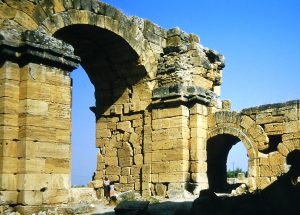 We returned to Pamukkale in the early morning to view the ruins of Heiropolis, a Roman city, and the neighbouring necropolis. Tombs were everywhere, bath walls were glowing bronze in the morning sun. We then drove down through fertile plains and up again to the ruins (the last set!) of Aphrodisias, the one-capital of Caria. There is a huge temple of Aphrodite
We returned to Pamukkale in the early morning to view the ruins of Heiropolis, a Roman city, and the neighbouring necropolis. Tombs were everywhere, bath walls were glowing bronze in the morning sun. We then drove down through fertile plains and up again to the ruins (the last set!) of Aphrodisias, the one-capital of Caria. There is a huge temple of Aphrodite 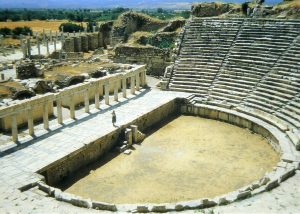 there, and a very impressive stadium, almost completely preserved with only a few weeds in the seats.
there, and a very impressive stadium, almost completely preserved with only a few weeds in the seats.
The final drive back down to Bodrum, completing 2,360km, was also a lovely one, over a mostly unsurfaced mountain road, with gorges and pine forest alongside us.
We did some stocking up at the market and rejoined the boat after what we agreed had been a very satisfying and enjoyable week. We went back into the town later to return the car to Ali and Harika.
Back aboard
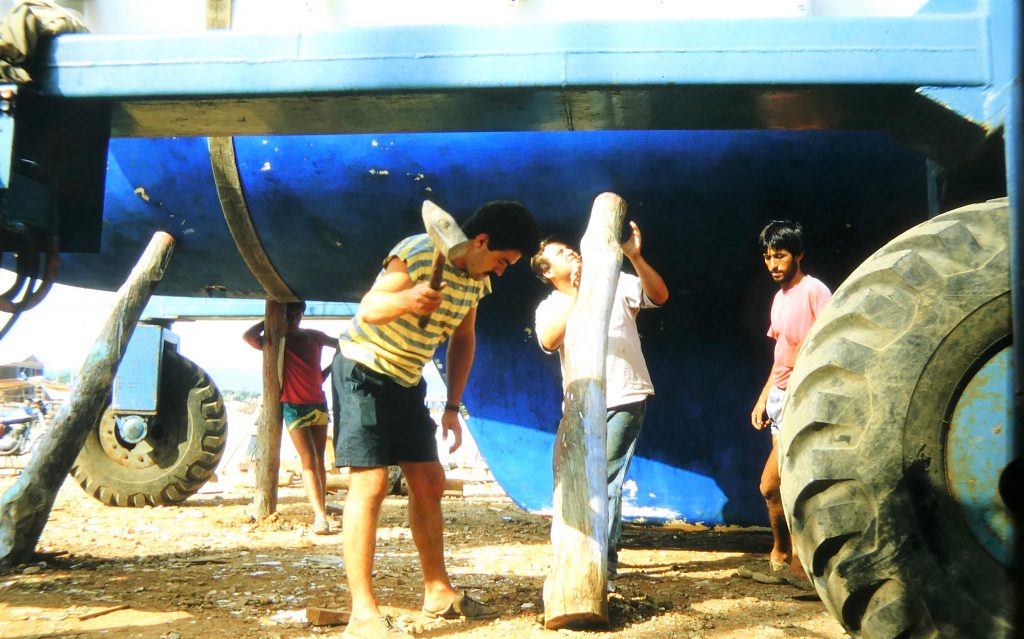 We then got back to heavy work on the boat's undersides. It was exceedingly hot, and in the afternoon I suddenly found I could not lift my big belt sander. I quickly realised that I had heat exhaustion and dehydration (possibly also some copper poisoning from the antifouling sanding). So cooled off in the water and drank and drank. Overnight, in a blisteringly hot northerly we slept in the cockpit, regularly dousing ourselves with water. We used Turkish antifouling when we got to the painting, but its covering power was poor and we hoped two coats would be enough.
We then got back to heavy work on the boat's undersides. It was exceedingly hot, and in the afternoon I suddenly found I could not lift my big belt sander. I quickly realised that I had heat exhaustion and dehydration (possibly also some copper poisoning from the antifouling sanding). So cooled off in the water and drank and drank. Overnight, in a blisteringly hot northerly we slept in the cockpit, regularly dousing ourselves with water. We used Turkish antifouling when we got to the painting, but its covering power was poor and we hoped two coats would be enough.
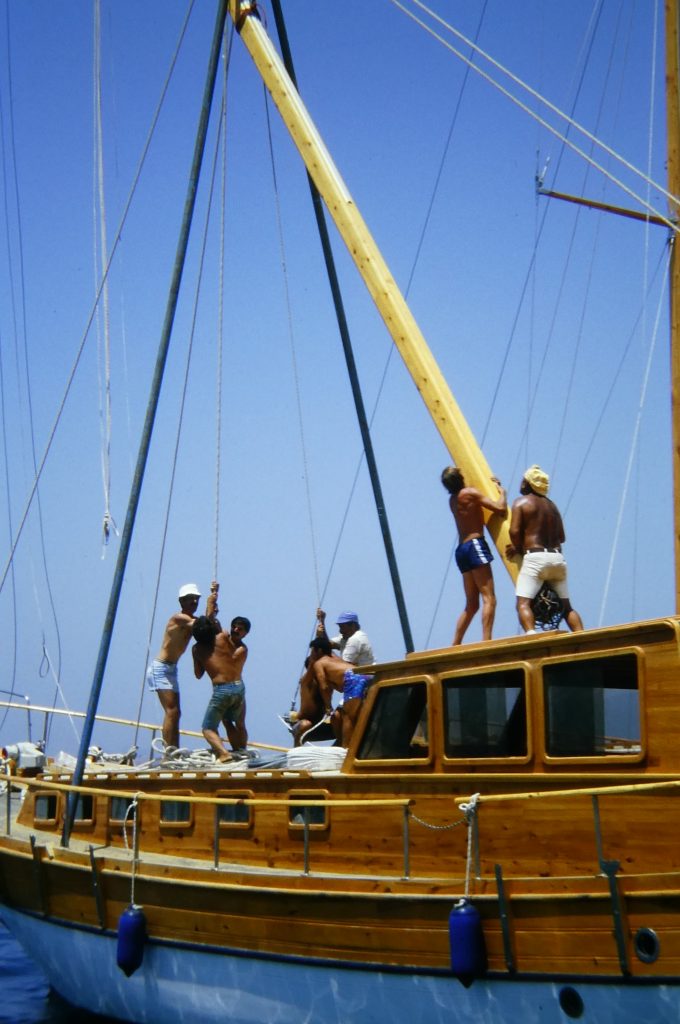 It got hotter and hotter, up to 107 degrees F in the cabin, the highest we had ever seen. The workers were keeping their children running to and fro fetching and carrying water, as every man was drinking gallons - as were we. The boatbuilders finished a new gulet and we helped step its mainmast. Launching was celebrated by the apparently ritual slaughter of a cow. It was not cooked there, but butchered so that the workers could take large cuts home.
It got hotter and hotter, up to 107 degrees F in the cabin, the highest we had ever seen. The workers were keeping their children running to and fro fetching and carrying water, as every man was drinking gallons - as were we. The boatbuilders finished a new gulet and we helped step its mainmast. Launching was celebrated by the apparently ritual slaughter of a cow. It was not cooked there, but butchered so that the workers could take large cuts home.
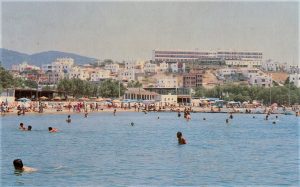 We were smartly launched into the water the next morning with great relief, and motored gently back past Bodrum harbour and round a headland to Gumbet bay, where we hoped to get a rather more refreshing wind. We had some trouble anchoring in poor holding ground, but once secure we had a welcome swim, a clean-up, another swim and lots of water to drink. We slept in the cockpit, again douching ourselves with water from time to time. John and Diana, from a neighbouring British boat, were also having trouble with the heat, and we were called over to help. She was in quite a bad way, very dehydrated and with a gastro problem to make it worse. She reluctantly tried to keep op with my usual medication, orange Tang with salt mixed in, because it made her feel sick; my advice was that it would work if she kept drinking it, and sure beat admission to the local Turkish hospital. Within a couple of days she was pretty well over it.
We were smartly launched into the water the next morning with great relief, and motored gently back past Bodrum harbour and round a headland to Gumbet bay, where we hoped to get a rather more refreshing wind. We had some trouble anchoring in poor holding ground, but once secure we had a welcome swim, a clean-up, another swim and lots of water to drink. We slept in the cockpit, again douching ourselves with water from time to time. John and Diana, from a neighbouring British boat, were also having trouble with the heat, and we were called over to help. She was in quite a bad way, very dehydrated and with a gastro problem to make it worse. She reluctantly tried to keep op with my usual medication, orange Tang with salt mixed in, because it made her feel sick; my advice was that it would work if she kept drinking it, and sure beat admission to the local Turkish hospital. Within a couple of days she was pretty well over it.
We had to move back into Bodrum harbour for stores and clearance out of the country. This all went fairly well, but I was getting fed up with the succession of offices we had to visit, simply to fill up forms. A surveyor from a government tourist office was unlucky enough to catch me for comments on the process and our visit to Turkey. I love the country but not the bureaucracy, I responded!
We did a quick stop for the night in Gumbet to get ready for sea and to check on Diana, then on 14 July 1988 we sailed away from Turkey to cross the Aegean westwards.
It had always had been our intention, since we decided on this route, to make sure we crossed the Aegean before August, at which time the notorious Meltemi north to north-west wind, blows day in and day out at 20 to 35 knots, gusting violently through the anchorages and blowing red dust off the scorched hillsides - often to the dismay of European sailors chartering for their summer holidays.
As we got under way we reviewed our experience of sailing in Turkey. It had been a very good time for us. We thought the country would probably justify a whole season on its own, and indeed we regretted not having more seriously considered spending the previous winter there, in Fethiye for example. However, we were conscious of a certain ennui – we had had more than enough of sailing in the Mediterranean sea and felt a strong pull westwards to distant shores, to decent sailing and decent anchorages, fishing, and all the other good maritime things.
Our plan for this passage was to sail for Malta, about 600 nautical miles away, which should take - all being well - about five days. It did start quite well, passing Ios about midnight, averaging six knots in a quite strong nor-wester. By the following evening we were approaching the passage between Kithera and the Peloponnese mainland, keeping well to the south of the channel to avoid an endless stream of ships. Norma was scared stiff when we were suddenly lit up by a spotlight shone from an unlit but very noisy patrol boat of some kind. It circled us and then disappeared; we thought it might have been searching for a terrorist boat that had attacked a cruise ship near Aegena a few days before.
In the early hours we passed the bright lighthouse on the northern tip of Kithera. The wind promptly shifted to the WSW and strengthened. This was now dead on the nose for our intended course, and we began to worry about tacking our way through the masses of oncoming ships. By dawn the Greek forecast was for this wind to continue and get stronger, so we went back to the charts to look for a possible port of refuge. We identified Porto Khaio/Kagio as a possibility, lying as it did on the eastern (now lee) side of a small peninsula extending south from the Peloponnese. We pulled in there in the early morning.
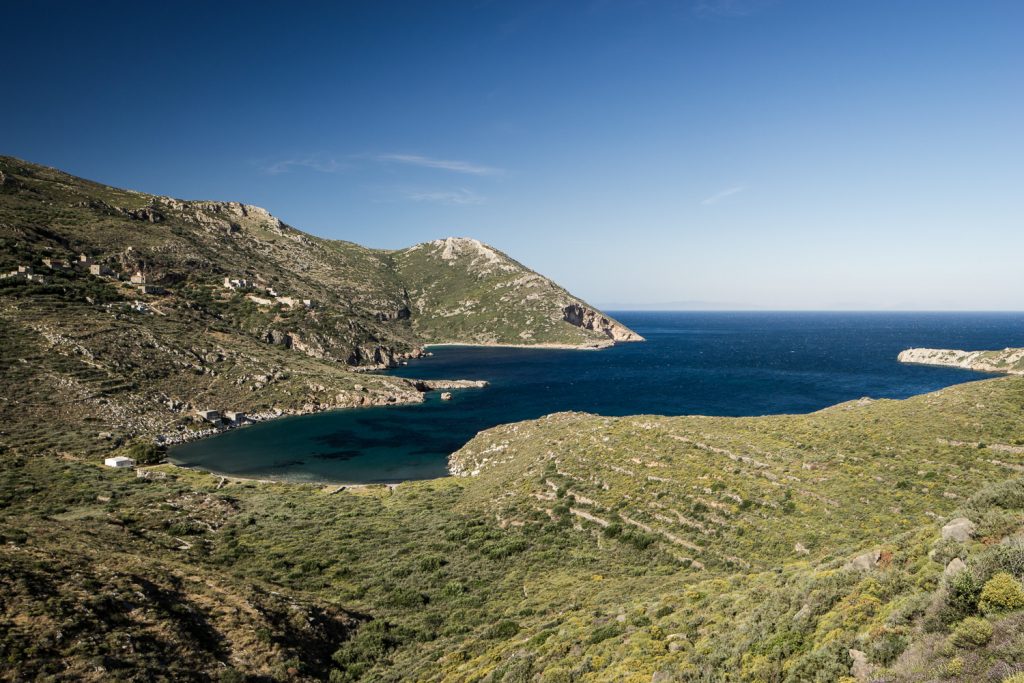 The bay looked to be an excellent choice, but it took us a fair while to get anchored. It was deep and there was a lot of weed. It was hard to get the anchor set solid. Many who were watching from other boats there probably thought we were inexperienced amateurs as we went round the bay and kept trying. Unlike them, however, our anchor was finally very firmly set underneath the weed, so when the wind swirled round the anchorage, we stayed put when they didn't.
The bay looked to be an excellent choice, but it took us a fair while to get anchored. It was deep and there was a lot of weed. It was hard to get the anchor set solid. Many who were watching from other boats there probably thought we were inexperienced amateurs as we went round the bay and kept trying. Unlike them, however, our anchor was finally very firmly set underneath the weed, so when the wind swirled round the anchorage, we stayed put when they didn't.
We looked around at a steep sided bay, barren, with a handful of earth-coloured block houses and a monastery up behind an encircling wall on the hillside. At the head of the bay there was a small collection of huts along the back of a gravel beach. There were no shops to be seen. It was literally a Spartan sight. The blustery west wind came in with a vengeance, gusting powerfully over the hills into the bay and continuing all day and through the night and next day too.
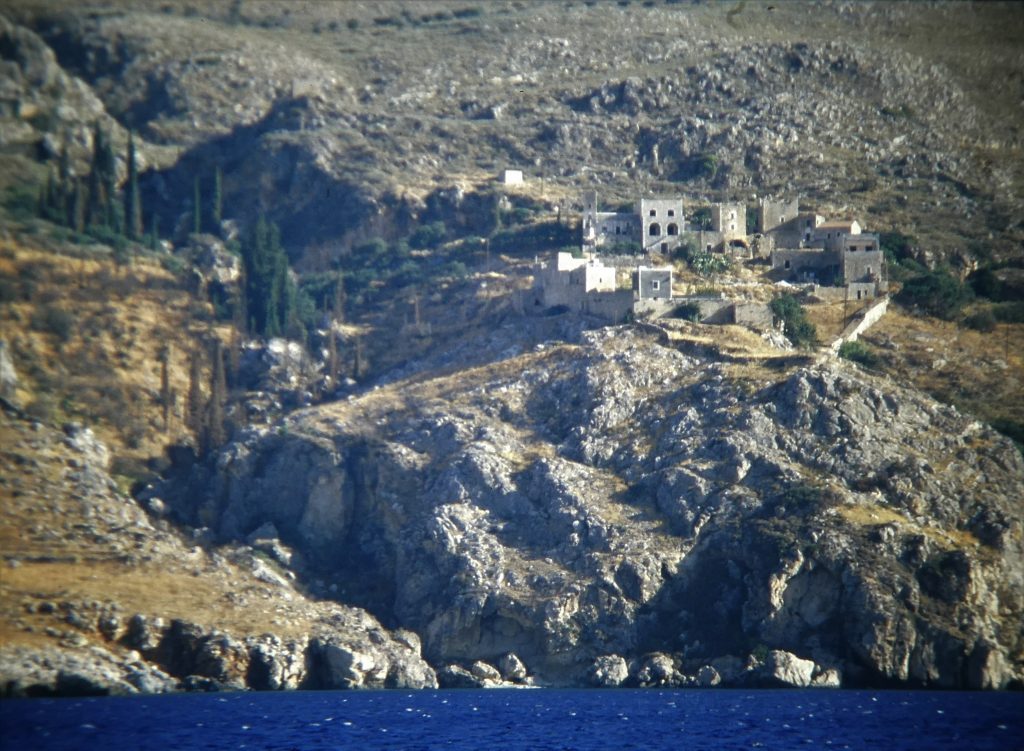 Ashore we could also see a few campervans. As we sat out the gale, Norma commented that our next trip to Europe and the Mediterranean would have to be in a campervan!
Ashore we could also see a few campervans. As we sat out the gale, Norma commented that our next trip to Europe and the Mediterranean would have to be in a campervan!
When the wind eased a bit we ventured ashore, past some grumpy Greek men at a tiny taverna on the beach. Then after a calm night we walked round the bay to the north side to the walled village. The peninsula where we lay is in the wild region of the Peloponnese known as the Mani, where villages feature tall towers. The old houses and towers, originally for defensive purposes, were being restored for accommodation. Back on the boat we had to help with incompetent French and Italian boat skippers with no idea how to anchor and were becoming a threat to us.
To our great relief, one afternoon a supply truck came down to the beach. With her experience in speaking Greek while shopping, Norma was in good form in the battle and shouting match with the local black clad women for the best supplies. She managed to secure a chicken, eggs and other supplies to keep us going. We still had a long way to sail for Malta.
After five nights in this memorable (!) anchorage, which had played its part as a refuge, we finally sailed away with a favourable forecast to hand.
Malta
Until recently before our approach to Malta there had been several restrictions on cruising around the Maltese islands However, they had just been relaxed because the group is such an obvious stopping place when sailing from one end of the Mediterranean to the other. Therefore, we knew that many more yachts were calling in.
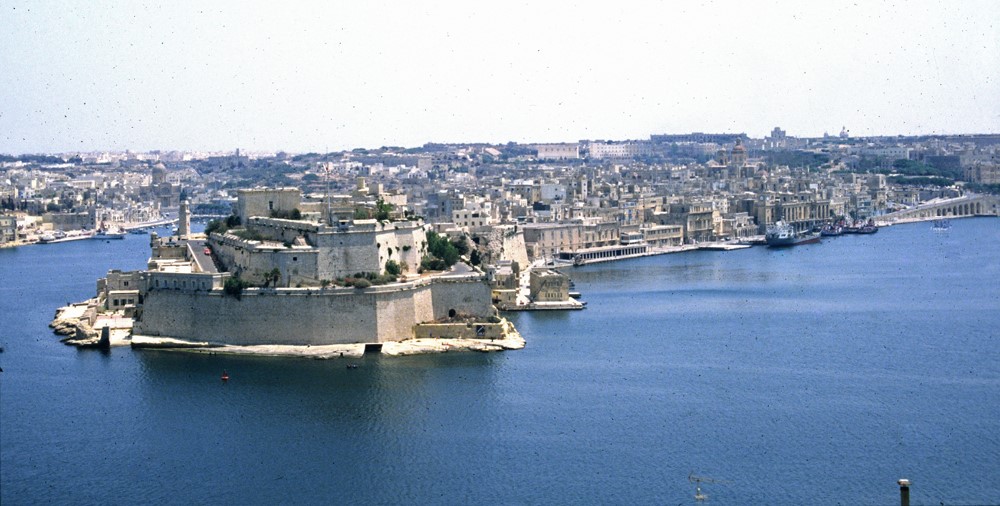 We arrived off Valletta Harbour during the morning of Sunday July 27, 1988. Having been warned that it was a requirement to do so, we called Valletta Port Control on Channel 12 advising our approach. Overseen by supreme bureaucrats, we knew that every movement by a yacht inside and in the vicinity of the harbour had to be so advised.
We arrived off Valletta Harbour during the morning of Sunday July 27, 1988. Having been warned that it was a requirement to do so, we called Valletta Port Control on Channel 12 advising our approach. Overseen by supreme bureaucrats, we knew that every movement by a yacht inside and in the vicinity of the harbour had to be so advised.
The approach to the harbour, and the entrance, is one of the most spectacular in the world. We were overlooked from all sides by forts of every shape and size. It is easily the most highly fortified place we have ever seen. The buildings are all in the same shade of stone, which adds to the impression that the whole of Valletta and the harbourside surroundings make up one big castle.
Valletta harbour is a wide collection of inlets on the east side of the main island. The whole is divided down the middle by a major peninsula (Sciberras), on which stands the capital city, Valletta, with Port St Elmo at its tip. To the south side of Valletta is Grand Harbour, a largely commercial port. On the northern side there is Marsamxett Harbour, where there are a collection of inlets housing smaller commercial vessels, fishing boats and visiting craft - including cruising yachts.
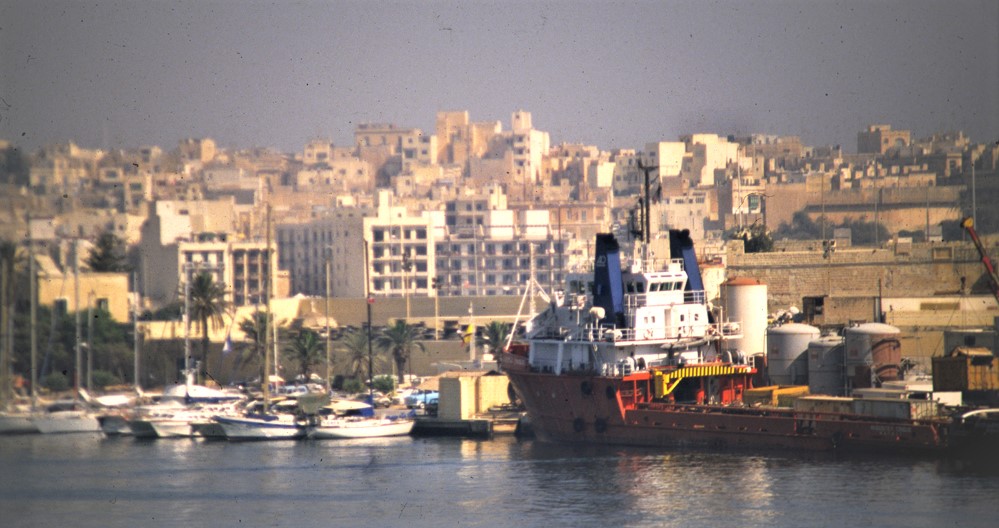 The Port Control confirmed that we should enter to the north of the breakwater and Port St Elmo and make our way down Marsamxett and thus to Lazaretto Creek, on the south side of Manoel Island. Here we would find a "guest berth". We already knew that anchoring anywhere was not permitted.
The Port Control confirmed that we should enter to the north of the breakwater and Port St Elmo and make our way down Marsamxett and thus to Lazaretto Creek, on the south side of Manoel Island. Here we would find a "guest berth". We already knew that anchoring anywhere was not permitted.
However, all space adjacent to a prominent sign reading “Guest Berth” was full up, it turned out later with locally-owned boats permanently kept there. We rafted alongside a Canadian boat at the east end of the dock, and when he left to a long-term berth further down the wharf the next day, we moved in to his space.
Customs and Immigration offices were nearby, and the officers were friendly and courteous. We were told to arrange a short-term berth in the morning, as on a Sunday everything was shut, including the harbour office. But even during the week we never heard the office respond to calls from arriving yachts for advice on where to go. We had our Canadian neighbours, John and Caroline, aboard for a drink in the afternoon before settling into the typical post-passage "jet lag" sleep.
Come Monday, and the berthing master – the only functionary able to allocate berths, and often away from his office on other duties – told us to stay put where we were.
It became clear the “Guest Berth” sign meant nothing in practice: the entire wharf frontage (laughingly called a marina) was being used by short-term and long-term yachts alike, with the latter having to take the chance that a vacant space will not soon be claimed by its permanent or semipermanent user. Some yachts, accordingly, found themselves being reallocated new berths and having to move almost daily, although this fate did not befall us.
Having to move would complicate the already rather painful situation in regard to water and electricity. Again, only one man had sufficient authority to make decisions on who was to be connected to what and when; only available in the mornings, many people found this employee of the municipal authorities a somewhat abrasive character. Electrical supply had to hard-wired in, not plugged, and disconnection required 24 hours’ notice.
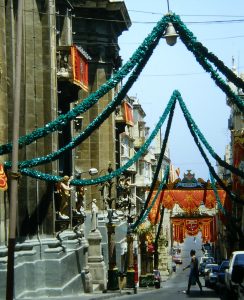 The next day we finally got connected up with water and power. A vegetable truck came by, and we felt we were getting organised. There was plenty of socialising, of course, and we had Mike and Karen, from the 24-foot sloop Tola, aboard for dinner. They were well into a westabout circumnavigation from the US west coast, , and Karen was due to have a baby in two weeks' time! They had decided to have the birth in Malta because of its British-style hospitals, which they trusted more than in Italy. I checked her blood pressure, which was normal. A day or two later they came to us with a large pile of yachting magazines. They told us they were clearing space in the forepeak for the new baby!
The next day we finally got connected up with water and power. A vegetable truck came by, and we felt we were getting organised. There was plenty of socialising, of course, and we had Mike and Karen, from the 24-foot sloop Tola, aboard for dinner. They were well into a westabout circumnavigation from the US west coast, , and Karen was due to have a baby in two weeks' time! They had decided to have the birth in Malta because of its British-style hospitals, which they trusted more than in Italy. I checked her blood pressure, which was normal. A day or two later they came to us with a large pile of yachting magazines. They told us they were clearing space in the forepeak for the new baby!
Our first tourist trip was to take the bus round the head of the harbour to Valletta. The city was hung with multiple decorations and was seething with tourists. The Government Tourist Information office was as unhelpful as usual, but we had done some homework by then. Malta became an independent republic within the British Commonwealth in 1964. Valletta, the capital, is its administrative and commercial centre. The Grand Harbour houses the former British Naval dockyard, nationalised in 1968 and employing thousands of people.
The position of the islands, right in the centre of the narrowest part of the Mediterranean, has long made it a valued strategic asset, and over the years it has been ruled by the Ottoman Empire, the Knights of St John, the French under Napoleon (but for only two years) and the British starting in 1800. During WW2 the islands and Valletta in particular were heavily bombed.
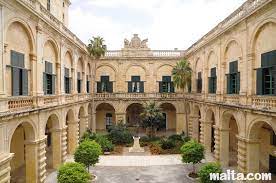
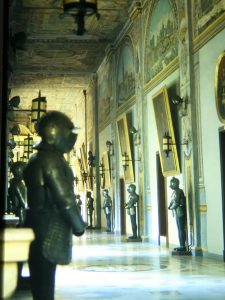 Down the main street in the centre of town we visited the Renaissance Grandmaster's Palace, finished in 1574. This is the residence of the President and houses the Parliament and government offices. It has a highly impressive inner central court, with a bronze statue of a sea god and a clock on which two Moors strike the hours with hammers. Weapons in the armoury are well displayed, and in the upper floors magnificent corridors circle the state rooms. Down in the town again we thought many of the buildings were looking a bit shop-worn , but many had lovely baroque facades. The entire precinct is surrounded by layers of fortifications, merging with tough-looking forts at all the strategic places from which there were wonderful views of Grand Harbour. We enjoyed an audio-visual display, the Malta Experience, covering some of Malta's long history.
Down the main street in the centre of town we visited the Renaissance Grandmaster's Palace, finished in 1574. This is the residence of the President and houses the Parliament and government offices. It has a highly impressive inner central court, with a bronze statue of a sea god and a clock on which two Moors strike the hours with hammers. Weapons in the armoury are well displayed, and in the upper floors magnificent corridors circle the state rooms. Down in the town again we thought many of the buildings were looking a bit shop-worn , but many had lovely baroque facades. The entire precinct is surrounded by layers of fortifications, merging with tough-looking forts at all the strategic places from which there were wonderful views of Grand Harbour. We enjoyed an audio-visual display, the Malta Experience, covering some of Malta's long history.
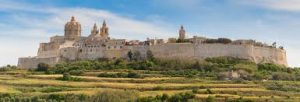 John and Caroline took us for a drive around the island in their rented Fiesta. We first visited the ancient former capital of Mdina, a medieval walled city on top of a plateau. There is a lovely baroque cathedral nearby, with a great art collection and a seminary. Like everything else in Malta they were all built in golden limestone blocks, hewn from great square-sided quarries that are all over the island.
John and Caroline took us for a drive around the island in their rented Fiesta. We first visited the ancient former capital of Mdina, a medieval walled city on top of a plateau. There is a lovely baroque cathedral nearby, with a great art collection and a seminary. Like everything else in Malta they were all built in golden limestone blocks, hewn from great square-sided quarries that are all over the island.
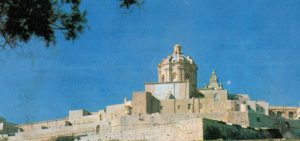 The yellowish stone – “Malta” comes from the old word for honey, melita – and the climate and the absence of topsoil prevents anything of any significance growing. In mid-summer, it looked as though a blowtorch had been waved over it, and there was very little livestock to be seen.
The yellowish stone – “Malta” comes from the old word for honey, melita – and the climate and the absence of topsoil prevents anything of any significance growing. In mid-summer, it looked as though a blowtorch had been waved over it, and there was very little livestock to be seen. 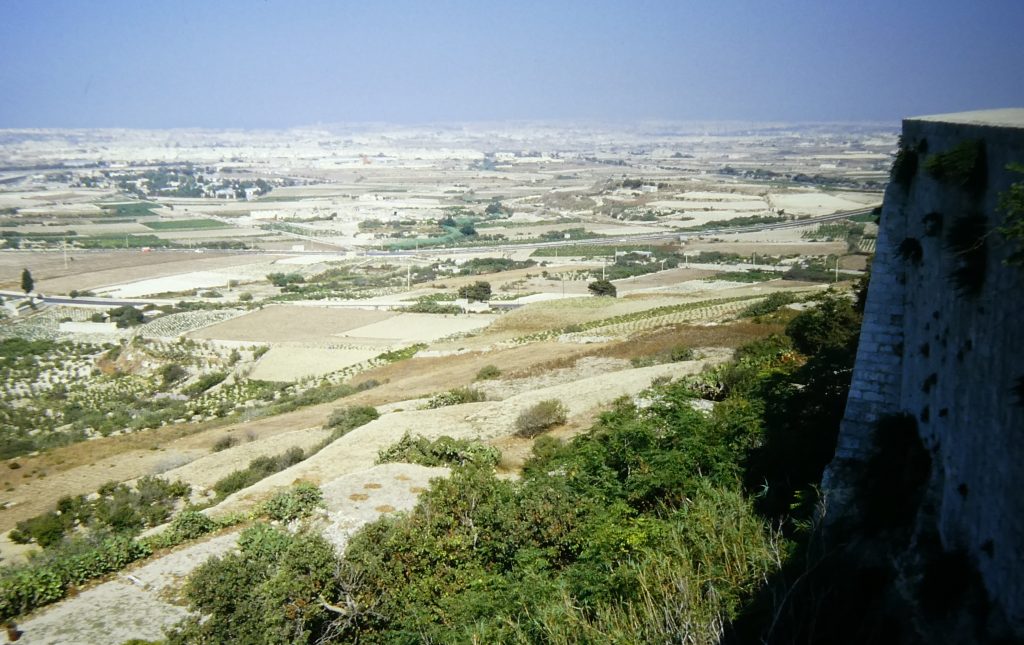 Even the goats would find little to eat! Throughout the barren landscape that we could see from the hilltop were scattered countless quite large towns, looking from a distance a bit like bunches of bigger versions of the stones which are everywhere, and all marked by a prominent church. This is a very Catholic country, and the population was growing fast. As it is, we had no idea how the island supports itself.
Even the goats would find little to eat! Throughout the barren landscape that we could see from the hilltop were scattered countless quite large towns, looking from a distance a bit like bunches of bigger versions of the stones which are everywhere, and all marked by a prominent church. This is a very Catholic country, and the population was growing fast. As it is, we had no idea how the island supports itself.
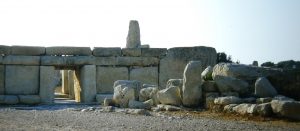 Down in the south-west corner we visited the prehistoric temple of Hagar Qim. We finished the day at the little coastal suburb of St Julians, where we dined Italian style on the cliffside overlooking the water.
Down in the south-west corner we visited the prehistoric temple of Hagar Qim. We finished the day at the little coastal suburb of St Julians, where we dined Italian style on the cliffside overlooking the water.
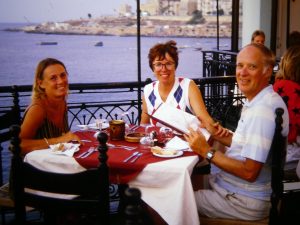 Back aboard we continued to be very active every day, and I spent much time arguing with the berth master about paying - he accused me of trying to avoid this, but he had never asked for any payment - and the electrical supply. We were required to have it hard-wired into the box, not connected by a plug. Some Maltese were a pain to deal with, but most were very pleasant.
Back aboard we continued to be very active every day, and I spent much time arguing with the berth master about paying - he accused me of trying to avoid this, but he had never asked for any payment - and the electrical supply. We were required to have it hard-wired into the box, not connected by a plug. Some Maltese were a pain to deal with, but most were very pleasant.
After a few days we had found good shopping in the adjacent suburb of Sliema, a  bike ride away. Norma did lots of stocking up and bottling. The waterways in other parts of Marsamxett harbour were packed with colourful fishing boats.
bike ride away. Norma did lots of stocking up and bottling. The waterways in other parts of Marsamxett harbour were packed with colourful fishing boats.
It was getting very hot by this time. A big tug was tied up a few berths away, with a friendly crew who had to run their noisy generator all the time. On one night a huge motor cruiser under charter came alongside, blocked the little wind there was, and blew hot air from its air conditioners over us all night. The captain was apologetic, but what could he do? We felt very claustrophobic here at times, and longed to be back at anchor - anywhere!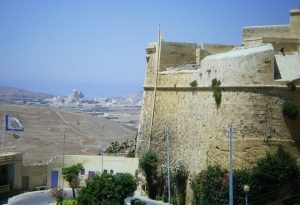
On the ferry, we took the bikes over to the second-largest island, Gozo. The harbour is at the bottom of a very steep hill, so it was hot and hard work to ride up to the main city, Victoria. Up in the old northern part of the city there is also a highly impressive citadel, a fortified refuge for the islanders when they were under attack. Within the ramparts there is a pleasant cathedral. Other circular ramparts could be seen all around, bleak in African desert style, yellow limestone blocks, bleached soil, settlements large and small, but nothing green. There was a tremendous view from the citadel over the wide brown land, where even the prickly pear seemed to be struggling.
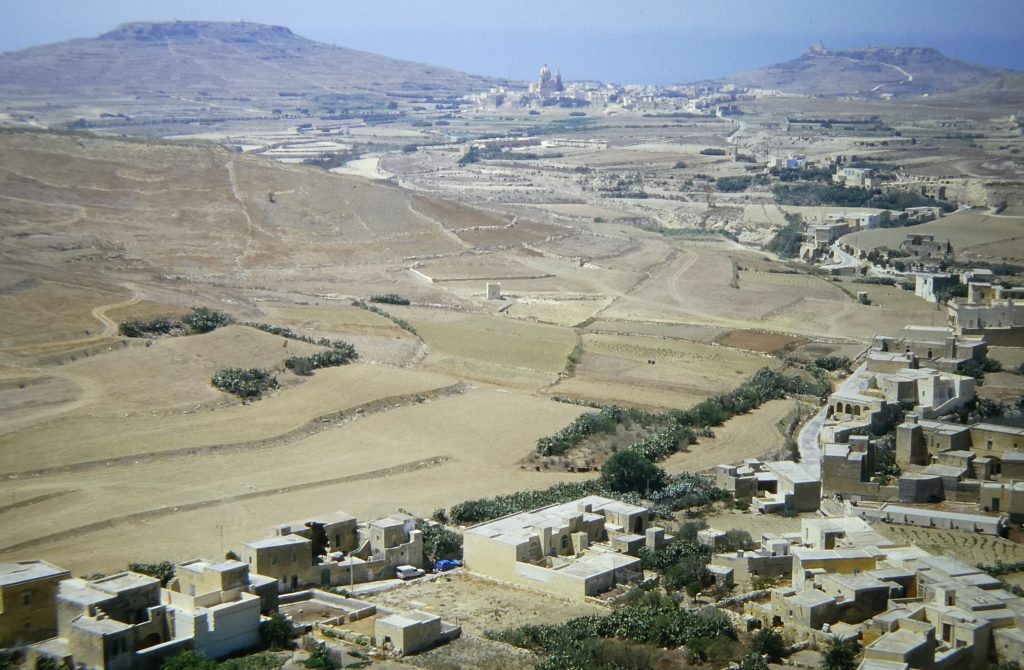
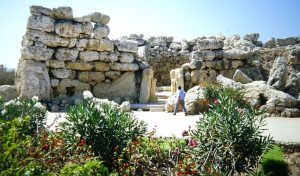 The other main sight to be seen here is the prehistoric temple of Ggantija (Place of Giants). It dates from about 3600 BC. There are two groups of chambers within a casing wall. In this quiet setting we and the few other tourists were talking in whispers. We got there just in time, as the complex shut at 3:15pm.
The other main sight to be seen here is the prehistoric temple of Ggantija (Place of Giants). It dates from about 3600 BC. There are two groups of chambers within a casing wall. In this quiet setting we and the few other tourists were talking in whispers. We got there just in time, as the complex shut at 3:15pm.
It was a much easier ride back down to the harbour, and we spent a while looking at more of the colourful and very picturesque fishing boats, their high curved stems supposedly modelled on craft of ancient times. We had a quick swim in the harbour water, but paid the price in stomach upsets overnight.
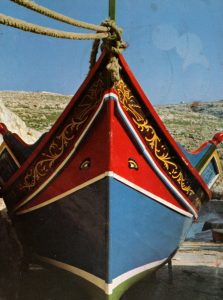 We took another quick trip into Valetta before moving out the next day, mainly to visit the War Museum at Fort St Elmo. The displays describing the war in Malta, and the bravery of its inhabitants and the British warriors, were excellent. We picked up lots of mail at the Amex office. Back at the boat we cleared Customs and paid the berth fees. We had arranged the previous day - as required - for a man to come and disconnect us, but that had not been done, a typically Maltese frustration. In the end, we simply - and carefully - cut the wires.
We took another quick trip into Valetta before moving out the next day, mainly to visit the War Museum at Fort St Elmo. The displays describing the war in Malta, and the bravery of its inhabitants and the British warriors, were excellent. We picked up lots of mail at the Amex office. Back at the boat we cleared Customs and paid the berth fees. We had arranged the previous day - as required - for a man to come and disconnect us, but that had not been done, a typically Maltese frustration. In the end, we simply - and carefully - cut the wires.
Malta is a very interesting place, but at the time we were there we thought that many Maltese had not come to terms with tourism, and some clearly never would. For 16 years after independence Malta had a hard-left government more interested in contacts with nations such as Libya than with the west. Malta was already an overpopulated island, and it was hoped that the tourist industry would bring jobs to those who could not be assured of work in Valletta’s harbour and dockyard facilities.
Fortunately, we learnt, a recent change in government had brought about a change in attitude towards tourists, including those arriving on yachts, and the foreign exchange they bring with them. As far as yachts are concerned, there was indeed some evidence of a change in attitude – no longer are their owners necessarily seen as capitalist warmongers – but the warming of approach had not filtered down to some of the many officials with whom relationships have to be established. Also, facilities for short-term cruising yachts left a great deal to be desired.
As we prepared to leave, we thought that we had probably not made the best of our time here, but it had not been easy. We were not that sorry to move on.
Tunisia
We got up early for what we hoped would be an overnight sail pretty much due west for Monastir, on the eastern coast of Tunisia.
This is a country which is usually missed out by circumnavigators, because for most people it is off the track for a one-way transit of the Mediterranean. East-west (or vice versa) passage-makers stick understandably to the popular shores of the countries of the northern Mediterranean, tracking (as we had done) through the Straits of Messina and the fishing harbours of Italy. This could explain why during our cruise of Tunisian waters, the overwhelming majority of boats hailed from Italian or French ports. We hardly saw any English speakers at all.
As we got ready for sea, men in white uniforms came rushing down to check that we had cleared Malta Customs. We went through another interrogation as we made our mandatory call to Valletta Harbour Radio, and finally we were off. In light airs we motorsailed round the top of the main island and through the Comino channel to the south of Gozo. It continued calm for most of the day, followed by a reasonable sail for most of the night. In the early hours we passed Lampedusa Island about 20 miles to the south.
About 10 miles out from Monastir we had to pass to the north of the small off lying island of Kuriat; very well off, in fact, needing to round a buoy a long way to the north of the island. What we knew, but what had been a trap for many yachts, is that this offshore buoy marked the end of a five-mile long tuna fishing net, which was very hard to see against the setting sun. We felt a bit smug that we done our research. There were no yacht cruising guides for Tunisia.
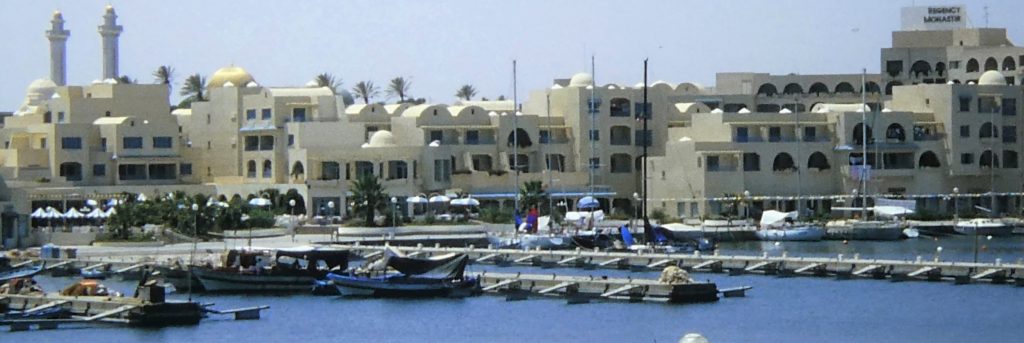 Officials of every kind swarmed down to us as we pulled into the marina at Monastir. It turned out that they were busy because a yacht race from Palermo had just arrived. But they were all very friendly, and we were only boarded by Customs, no problems apart from all the forms that needed to be completed.
Officials of every kind swarmed down to us as we pulled into the marina at Monastir. It turned out that they were busy because a yacht race from Palermo had just arrived. But they were all very friendly, and we were only boarded by Customs, no problems apart from all the forms that needed to be completed.
We looked around what looked like a pleasant marina, surrounded by attractive apartment developments. We were invited to a post-race cocktail party at the Hyatt Regency, with bands and dancing girls in local costumes, before returning to the boat for chicken breasts and an early night.
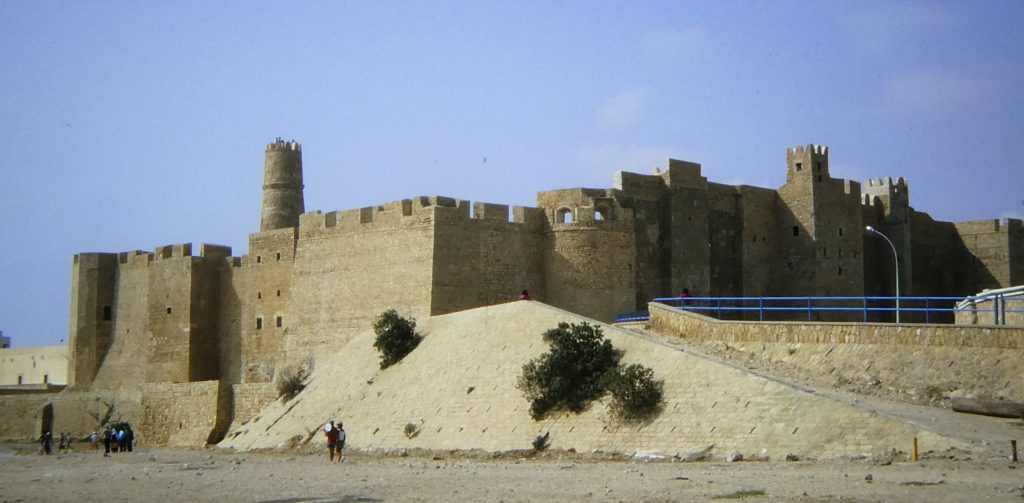 In the morning we walked into the town. On the way we passed the Ribat, a picturesque fortified sandstone monastery, much used as a film set. Hard by the Ribat is an ugly square box of a building, looking like an aircraft hangar: a peek inside revealed a full-scale mock-up of a Roman temple! The other buildings in the area may or may not be original – it is now very hard to say! We faced the usual painful business of changing money at the central bank and then went on down through the old town and the many souvenir stalls, attracting our custom with no more than the usual hassle. We looked in to an ancient olive-pressing cellar, where we were shown round by its enthusiastic owner who then took us for coffee with his friends.
In the morning we walked into the town. On the way we passed the Ribat, a picturesque fortified sandstone monastery, much used as a film set. Hard by the Ribat is an ugly square box of a building, looking like an aircraft hangar: a peek inside revealed a full-scale mock-up of a Roman temple! The other buildings in the area may or may not be original – it is now very hard to say! We faced the usual painful business of changing money at the central bank and then went on down through the old town and the many souvenir stalls, attracting our custom with no more than the usual hassle. We looked in to an ancient olive-pressing cellar, where we were shown round by its enthusiastic owner who then took us for coffee with his friends.
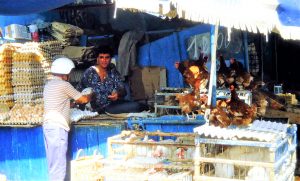 The produce market was adequate, with the extensive range of vegetables – pumpkins, tomatoes, potatoes, onions, carrots and peppers – looking a bit tired. There was wine at the general store, but hard liquor was very expensive. There was no pig meat to be had, of course, in this Moslem country, but chickens and their eggs were massively popular and low-priced, as was excellent goat meat, plus lamb and beef. Typically for the Med, all the meat was very fresh.
The produce market was adequate, with the extensive range of vegetables – pumpkins, tomatoes, potatoes, onions, carrots and peppers – looking a bit tired. There was wine at the general store, but hard liquor was very expensive. There was no pig meat to be had, of course, in this Moslem country, but chickens and their eggs were massively popular and low-priced, as was excellent goat meat, plus lamb and beef. Typically for the Med, all the meat was very fresh.
 We examined some possibilities for a trip to the Sahara and other local sights, but it looked like all we could afford would be a bus tour.
We examined some possibilities for a trip to the Sahara and other local sights, but it looked like all we could afford would be a bus tour.
The weather was near perfect, a refreshing change from the oven heat of Greece. We got the bikes out for more touring round the town over the next few days. Once off the tourist beat we found the local people a bit offhand and pushy, and the smell of garbage and drains pervasive. But on the marina there was lots of lovely free water, and Norma washed and hosed everything in and out.
Five days after arriving we rose early for our two-day bus tour, which had been strongly recommended by a yachty friend some months previously. We were picked up at the Hyatt, and going from hotel to hotel the bus was filled up, mostly young people and all French or Italian other than us.
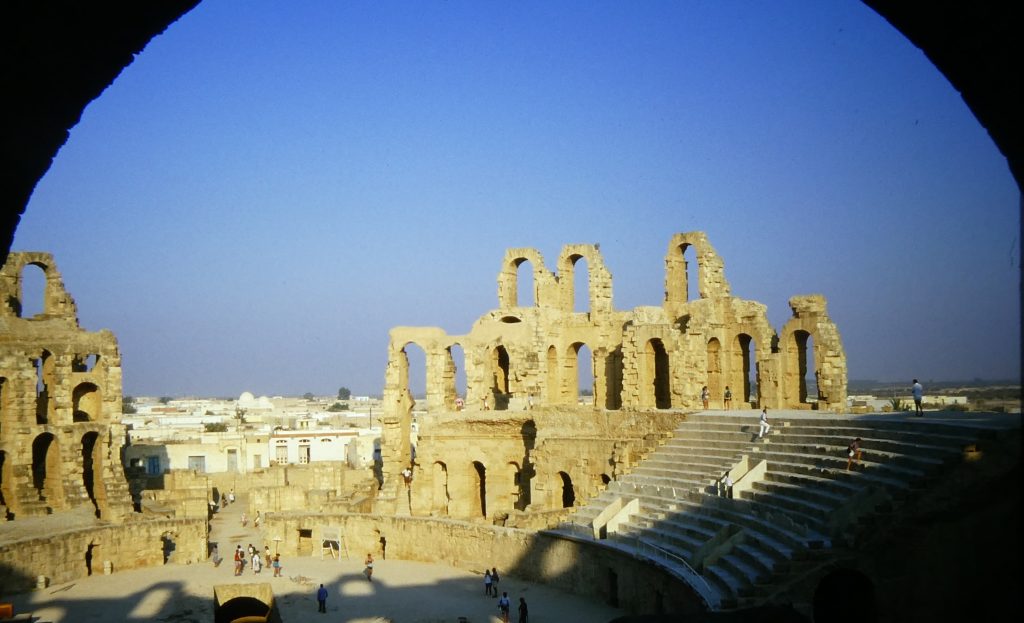 We started out by passing through massive olive groves separated by fences of live prickly pears. We made a stop at a country market, goats’ heads and cows’ legs, and another at El Djem. The only building here was a huge and very impressive 3rd century Roman amphitheatre. Apart from some damage caused by besieging Turks, all the interior alleys, arches and chambers for performers were essentially intact.
We started out by passing through massive olive groves separated by fences of live prickly pears. We made a stop at a country market, goats’ heads and cows’ legs, and another at El Djem. The only building here was a huge and very impressive 3rd century Roman amphitheatre. Apart from some damage caused by besieging Turks, all the interior alleys, arches and chambers for performers were essentially intact.
The next stop was at Sfax, down the coast from Monastir, where we took a walk around the medina and bought delicious doughnuts with an egg, salad and chili sauce from a roadside vendor. The surroundings were becoming bleak, with block-like houses with no porches or shade from other than the buildings. Knots of people were sitting out in the sun. Dead cars, buses, railway wagons and tanker trucks were sitting around the settlements, like everything else in this climate seemingly destined to last for ever. There were several police check points, where the locals were stopped but we were waved through.
After rounding the shallow Gulf of Gabes we headed inland and to the north-east corner of the great Sahara Desert, among the main sights we had really come to see.
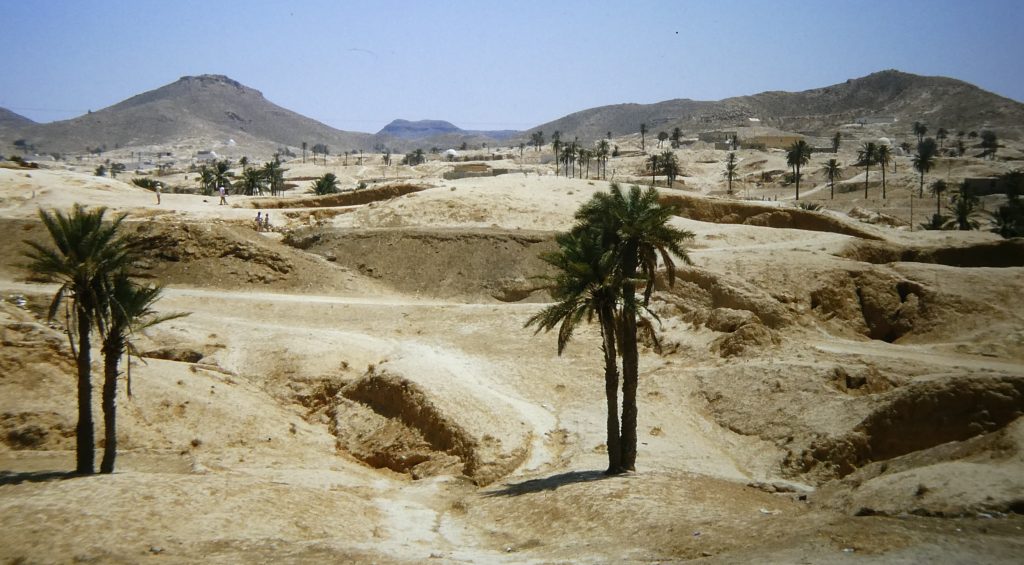 We stopped at Matmata, a small Berber speaking town where many of the local Berber residents live in traditional underground "troglodyte" structures, which the people have dug out in the sandstone of the hills in order to get away from the summer heat and the winter cold.
We stopped at Matmata, a small Berber speaking town where many of the local Berber residents live in traditional underground "troglodyte" structures, which the people have dug out in the sandstone of the hills in order to get away from the summer heat and the winter cold.
We had lunch in one such place, now converted into a hotel. We went in down a tunnel, which took us to a central pit, open to the sky. Off this large hole in the ground led more tunnels and cave-like rooms. From a distance, the landscape looks pitted with craters, which are the tops of these central excavations; a few years ago that’s all there was to be seen, but the seething tourist activity at Matmata, and the money this has brought, has led to the building of several above-ground houses, which sort of spoils the effect.
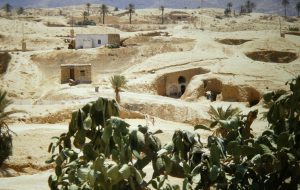 Also, like most “houses” in the south (and in the tradition of Islam), these again were ugly, dumpy structures, like blockhouses which haven’t even been finished properly. Centuries ago, all these people lived in tents. Many, the Bedouins, still do – but those who have moved into more solid homes have made no effort to make them attractive in any way, at least as seen by western eyes.
Also, like most “houses” in the south (and in the tradition of Islam), these again were ugly, dumpy structures, like blockhouses which haven’t even been finished properly. Centuries ago, all these people lived in tents. Many, the Bedouins, still do – but those who have moved into more solid homes have made no effort to make them attractive in any way, at least as seen by western eyes.
We ate in one of the whitewashed dugout caves, starting with a “bric a l’oeuf”, famous in these parts. We enjoyed several of these during our time in the country, where it’s supposed to be unique. When done well, it’s absolutely delicious. It is a thin pancake, crisply deep fried, wrapped round a spicy salad and a whole egg which is broken into it and cooks inside. Norma had no idea how or why the egg doesn’t run out first, and had to try making her own later. They were much tastier, we found, when purchased from street vendors rather than at restaurants and hotels, and during bus tours like ours.
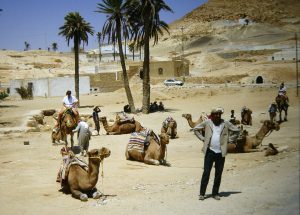 This rather bland bric was followed by couscous and date cake. After that we walked around the village. There were hordes of bus tourists, many taking the camel rides that were on constant offer. The Berber residents who actually lived in the underground dwellings were reticent and rarely in view.
This rather bland bric was followed by couscous and date cake. After that we walked around the village. There were hordes of bus tourists, many taking the camel rides that were on constant offer. The Berber residents who actually lived in the underground dwellings were reticent and rarely in view.
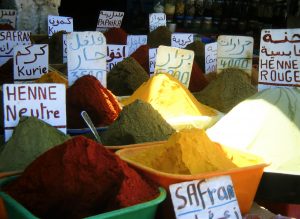 We then returned to the town of Gabes on the coast, where we were offered rides in rather scruffy horse carriages. We chose to walk on our own through the market, with some striking displays of spices and dyes including henna. This is used on hands and hair for occasions such as weddings.
We then returned to the town of Gabes on the coast, where we were offered rides in rather scruffy horse carriages. We chose to walk on our own through the market, with some striking displays of spices and dyes including henna. This is used on hands and hair for occasions such as weddings.
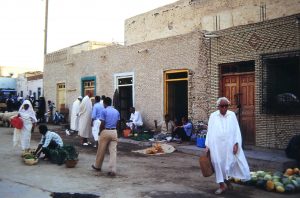 During these regular stops we usually walked off on our own, and gained a reputation for doing so! Round the markets and back streets of the towns and villages we were able to get a bit of a feel for the way of life in the near-desert. The villagers live a basic existence, to say the least, in their simple houses – we could see very little furniture, and most people seemed to sleep outside on mats and blankets. The village houses are often grouped into little squares, presumably containing families, with a central courtyard and surrounded by a blank and forbidding wall.
During these regular stops we usually walked off on our own, and gained a reputation for doing so! Round the markets and back streets of the towns and villages we were able to get a bit of a feel for the way of life in the near-desert. The villagers live a basic existence, to say the least, in their simple houses – we could see very little furniture, and most people seemed to sleep outside on mats and blankets. The village houses are often grouped into little squares, presumably containing families, with a central courtyard and surrounded by a blank and forbidding wall.
The local people seemed friendly enough, and the children all waved and said “bonjour” (French is the second language here). But the older women were all heavily veiled, although this was no longer compulsory, and turn their heads away if you look at them. The guide insisted that in Tunisia huge steps had been taken towards female emancipation, but from our reading of the history of Islam, we thought it would take more than a few government decrees to change attitudes ingrained over centuries.
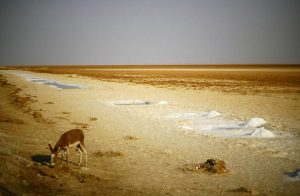
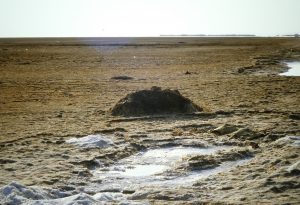 Off then in the bus to the west, to a different part of the desert with differing patterns of scenery: some scrub, some hills, some rocks, views of mountains. Patches of palm trees grew around wadis.
Off then in the bus to the west, to a different part of the desert with differing patterns of scenery: some scrub, some hills, some rocks, views of mountains. Patches of palm trees grew around wadis.
During the day we skirted the enormous Chott el Djerid, a dry salt lake whose name can be roughly translated into English as "Lagoon of the Land of Palms". It was flat and brown as far as the horizon in all directions, almost like being at sea, except that mirages shimmered in the direction of the sun. Not even Bedouins or their camels could survive out there.
We drove up into some hills approaching Tozeur, seeing men playing dominos and cards in patches of shade. We called into the poor example of a zoo in Tozeur, with sad animals including lions and a black bear, some being teased for the enjoyment of tourists, who were all responding merrily. We walked out.
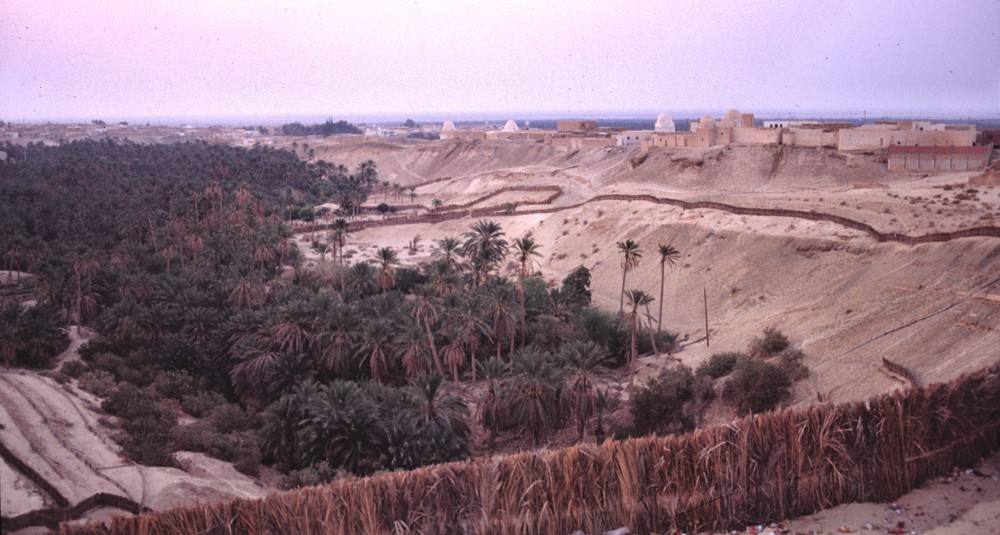 We spent the night at the basic Hotel El Djerid, where we shared a dinner of stew with a pleasant French couple crewing on a yacht. We were up early for a trip to the Nefta oasis; we missed the intended sunrise, but it was still a lovely desert view over the oasis at first light. Local people were sleeping outside on blankets, and there were several Bedouin camps and camels at regular intervals along the way.
We spent the night at the basic Hotel El Djerid, where we shared a dinner of stew with a pleasant French couple crewing on a yacht. We were up early for a trip to the Nefta oasis; we missed the intended sunrise, but it was still a lovely desert view over the oasis at first light. Local people were sleeping outside on blankets, and there were several Bedouin camps and camels at regular intervals along the way.
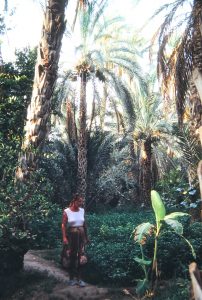
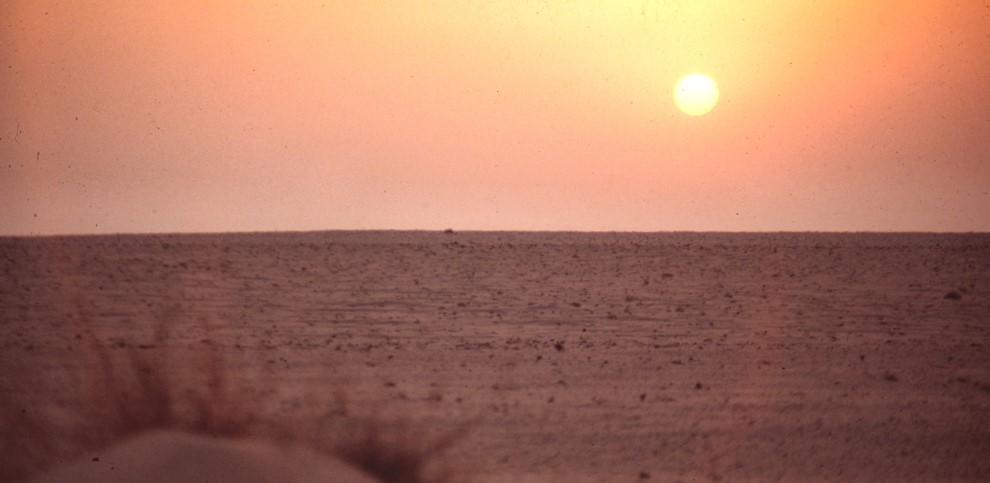 We walked into another large oasis, with attractive hordes of palm trees under the cool shade of which other plants were cultivated, such as potatoes, chilis, okra and so on. Water sprang from underground, and in this arid country it was strange to hear its sound as it was channelled from place to place by a system of ditches and sluice gates. The settlements are built round the edges of the oases, as the fertile shady areas are too valuable except for cultivating date palms with vegetables and fruit in their shade.
We walked into another large oasis, with attractive hordes of palm trees under the cool shade of which other plants were cultivated, such as potatoes, chilis, okra and so on. Water sprang from underground, and in this arid country it was strange to hear its sound as it was channelled from place to place by a system of ditches and sluice gates. The settlements are built round the edges of the oases, as the fertile shady areas are too valuable except for cultivating date palms with vegetables and fruit in their shade.
From there we drove through very bleak scenery to the north, unrelenting flat scrub between blockhouse villages. We passed phosphate mines and WW2 cemeteries to remind of the fierce fighting of the North African campaigns. We had a basic lunch at Sbeitla, small town in west-central Tunisia. Nearby are the Roman ruins of Sufetula, containing the best-preserved Roman forum temples in Tunisia. We visited the site in the afternoon.
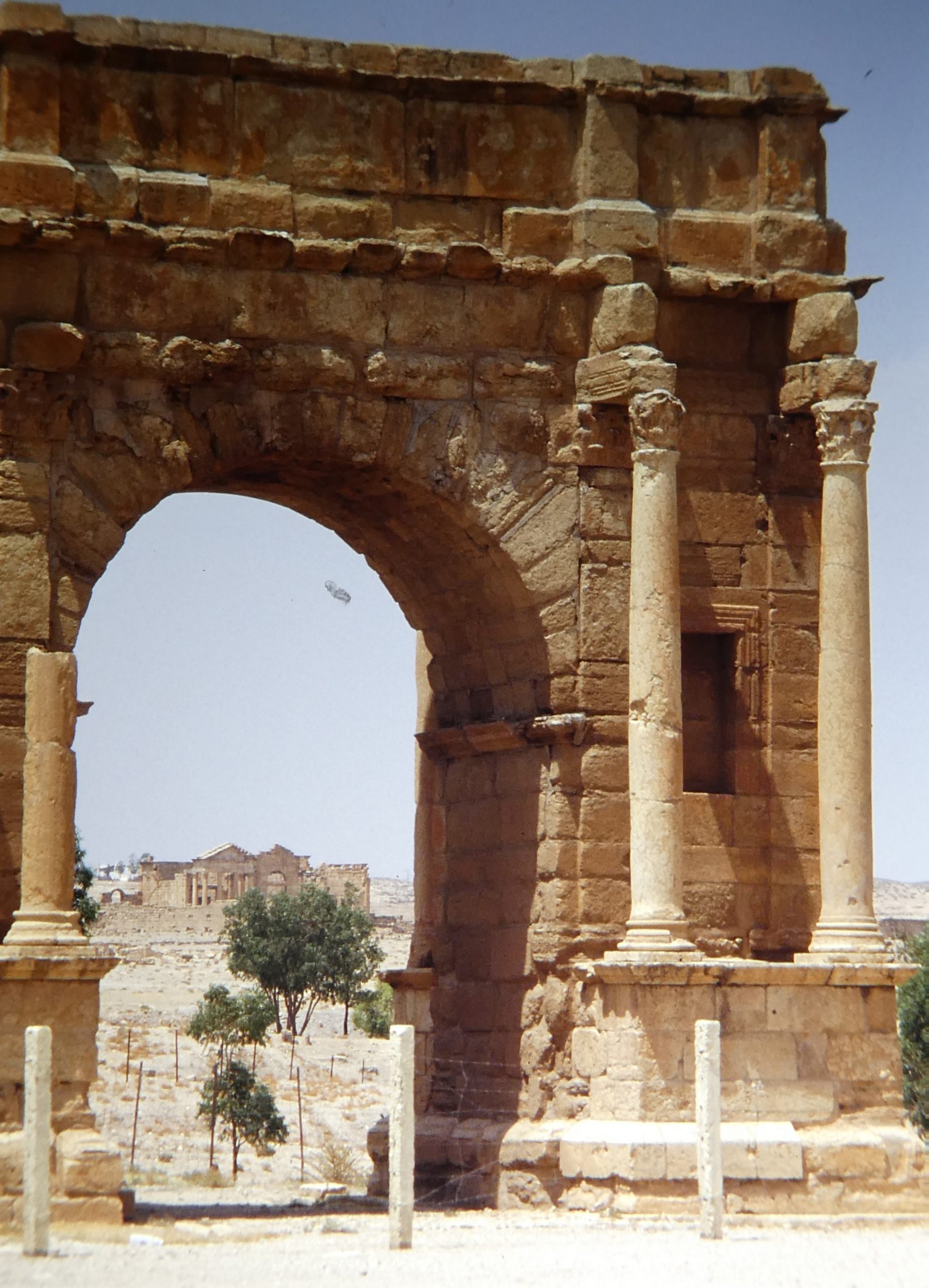 This was a highly impressive collection of ruins. The forum still had its four sides, and three well-preserved temples faced the entrance arch. It was where the Muslim conquest of North Africa began.
This was a highly impressive collection of ruins. The forum still had its four sides, and three well-preserved temples faced the entrance arch. It was where the Muslim conquest of North Africa began.
 Our final stop was at Kairouan, a walled city in northern Tunisia’s inland desert. It became a powerful trading hub and centre of Islamic scholarship in the 9th century, when Aghlabid emirs ruled Kairouan and built many of its monuments. The Great Mosque, on the edge of the medina, with its antique columns and imposing minaret, dates from this period and is a major pilgrimage site. For Muslims, we were told, seven trips here are said to equal one hajj to Mecca.
Our final stop was at Kairouan, a walled city in northern Tunisia’s inland desert. It became a powerful trading hub and centre of Islamic scholarship in the 9th century, when Aghlabid emirs ruled Kairouan and built many of its monuments. The Great Mosque, on the edge of the medina, with its antique columns and imposing minaret, dates from this period and is a major pilgrimage site. For Muslims, we were told, seven trips here are said to equal one hajj to Mecca.
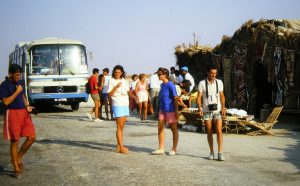 We were taken to the restored house of a pasha for a carpet display, demonstration and sales pitch. In the souk we had an excellent bric, but were pestered by small boys.
We were taken to the restored house of a pasha for a carpet display, demonstration and sales pitch. In the souk we had an excellent bric, but were pestered by small boys.
All in all, we were pleased we did this trip, as we could not have got anywhere near the Sahara at reasonable cost otherwise, but we thought it would be some time before we took another bus tour! We were taken only to the more “touristy” places, got fed some pretty terrible meals, and had to put up with some heavy smokers in the bus. It was good to be home.
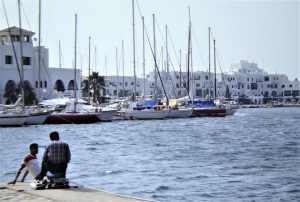 After a couple of days of hot, humid and windy weather, reprovisioning and washing, we sailed north in light winds the few miles past Sousse, a huge commercial harbour, to Port El Kantaoui. We were welcomed by the Port Captain, outside whose office we had tied, with the necessary papers and a bottle of wine.
After a couple of days of hot, humid and windy weather, reprovisioning and washing, we sailed north in light winds the few miles past Sousse, a huge commercial harbour, to Port El Kantaoui. We were welcomed by the Port Captain, outside whose office we had tied, with the necessary papers and a bottle of wine.
This was the first of the marinas built as one of a series of new tourist developments, Tunisia’s answer to Spain’s Benalmadena. It had a long way to go before being finished, as we found when touching bottom about half-way into the basin, groping around looking for a berth in what had become a screaming afternoon sou-easter, which as it happen blows straight into the entrance.
The El Kantaoui development ashore is being nicely done, with attractive buildings of a reasonable height, not overwhelming. It is, of course, entirely artificial: typical Arabic Tunisia, it was not! Surprisingly, we found it quieter than Monastir, perhaps because the comparatively up-market and established restaurants did not find it necessary to blare loud music from outside speakers in order to attract customers. There is no local town, and a ride into the port of Sousse is required to see anything of the real world or buy stores which include anything much in the way of fresh produce.
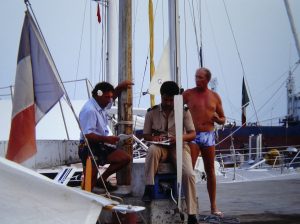 Because berths were at this stage few the marina was packed, and there was nothing much to see or do there, so the next day we sailed north to the port of Kelibia, which had been well spoken of by the few people we’d met who had been there: quiet and friendly, they said. However, August is a very busy time to be cruising anywhere in the Mediterranean, so it was probably not surprising that the wharf newly set aside for the use of yachts was crammed, with a crazy mixture of stern-to mooring, the great Med raft-up alongside, and long lines cobwebbed to an adjacent wharf. Officialdom was everywhere, although friendly enough. A typically European situation, we thought, but not one which made for peaceful days and nights.
Because berths were at this stage few the marina was packed, and there was nothing much to see or do there, so the next day we sailed north to the port of Kelibia, which had been well spoken of by the few people we’d met who had been there: quiet and friendly, they said. However, August is a very busy time to be cruising anywhere in the Mediterranean, so it was probably not surprising that the wharf newly set aside for the use of yachts was crammed, with a crazy mixture of stern-to mooring, the great Med raft-up alongside, and long lines cobwebbed to an adjacent wharf. Officialdom was everywhere, although friendly enough. A typically European situation, we thought, but not one which made for peaceful days and nights.
There was a village with basic supplies just up the way, and a bigger town a couple of miles further in. Whole families of local people were coming to the port for the evening walkabout, and a row of stalls catered for their snack needs including our favourite, the brik a l’oeuf.
A favourite game in Kelibia is moving the boats around. When we found the next morning that we would have to move because a ferry was coming, and the skipper of the French boat to which we were tied warned us that the charge would be higher than we thought. So we decided at short notice to sail to Sidi Bou Said, deep in the Bay of Tunis.
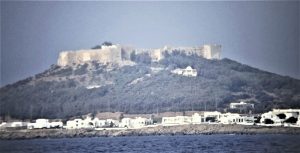
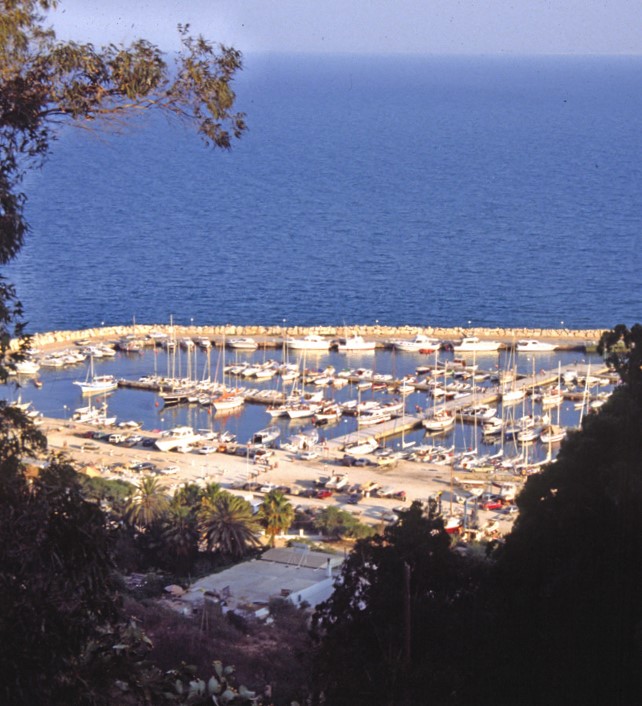 We motored out in a light northerly, and rounded Cape Bon at Tunisia’s north-east tip. We then had a good reaching sail in moderate airs, taking all day. Cape Carthage, on which Sidi Bou Said sits, was hard to make out against the setting sun. We groped our way into yet another marina and were waved down into a corner, through something of an obstacle course. The officials were straight down in full strength, but after that the marina became quite peaceful.
We motored out in a light northerly, and rounded Cape Bon at Tunisia’s north-east tip. We then had a good reaching sail in moderate airs, taking all day. Cape Carthage, on which Sidi Bou Said sits, was hard to make out against the setting sun. We groped our way into yet another marina and were waved down into a corner, through something of an obstacle course. The officials were straight down in full strength, but after that the marina became quite peaceful.
Sidi Bou Said is the place to be seen in Tunisia, we were told. On the top of the hill behind the marina – and up a steep line of 365 steps - was an enchanting little Moorish village, all white with blue trim, now a centre for 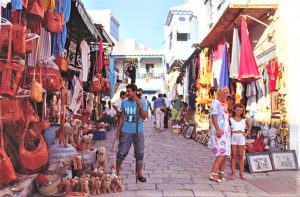 tourist-oriented crafts and a target for bus tours. In a separate “new” town there was the usual supply of stores and an idiosyncratic approach to the selling of liquor. Hard spirits and expensive wine could be obtained at any time, but ordinary wine and beer could only be bought from a tucked-away shop after four in the afternoon. We were conscious, not for the first time in the country, that ex-President Bourguiba’s efforts to ease the strictures of Islam have met with patchy acceptance over the years.
tourist-oriented crafts and a target for bus tours. In a separate “new” town there was the usual supply of stores and an idiosyncratic approach to the selling of liquor. Hard spirits and expensive wine could be obtained at any time, but ordinary wine and beer could only be bought from a tucked-away shop after four in the afternoon. We were conscious, not for the first time in the country, that ex-President Bourguiba’s efforts to ease the strictures of Islam have met with patchy acceptance over the years.
For a few days we then stuck to reading, writing, and rigging maintenance and repair, and Norma slowly recovered from a bad stomach bug.
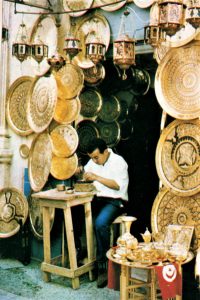
 We did a day trip by light train into the city of Tunis from here. It was a Sunday, which is a weekend holiday day, so despite this being a Moslem country most of the shops were shut. But that didn’t matter, we weren’t there for the shopping, and we had a much more relaxed wander through the market areas than usual because most of the stalls and little shops were closed up and we were free from the incessant hassling which normally accompanies a stroll through these areas. And we could see the decorated arches of the souks (the covered market areas), with pretty painted decorations – and masses of horrifically exposed electrical wiring. We snacked on large vol-au-vents with an egg filling and the pastry wrapped around meat and spinach. Good.
We did a day trip by light train into the city of Tunis from here. It was a Sunday, which is a weekend holiday day, so despite this being a Moslem country most of the shops were shut. But that didn’t matter, we weren’t there for the shopping, and we had a much more relaxed wander through the market areas than usual because most of the stalls and little shops were closed up and we were free from the incessant hassling which normally accompanies a stroll through these areas. And we could see the decorated arches of the souks (the covered market areas), with pretty painted decorations – and masses of horrifically exposed electrical wiring. We snacked on large vol-au-vents with an egg filling and the pastry wrapped around meat and spinach. Good.
The main target of this trip was the national museum of Tunisia, the Bardo, which is famous for its collection of mosaics from the many Roman ruins in the country. To get there we had first to find the bus station and establish which was the correct bus; having done this, we joined the milling mob of people waiting for the same bus. When it arrived, we were involved in the most extraordinarily vicious scramble to get on, during which I felt wriggling fingers exploring a pocket in which I had some money. I slapped that hand down, and as it turned out there was plenty of room on the bus anyway! We learnt that this unseemly scramble is normal.
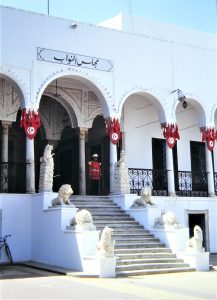
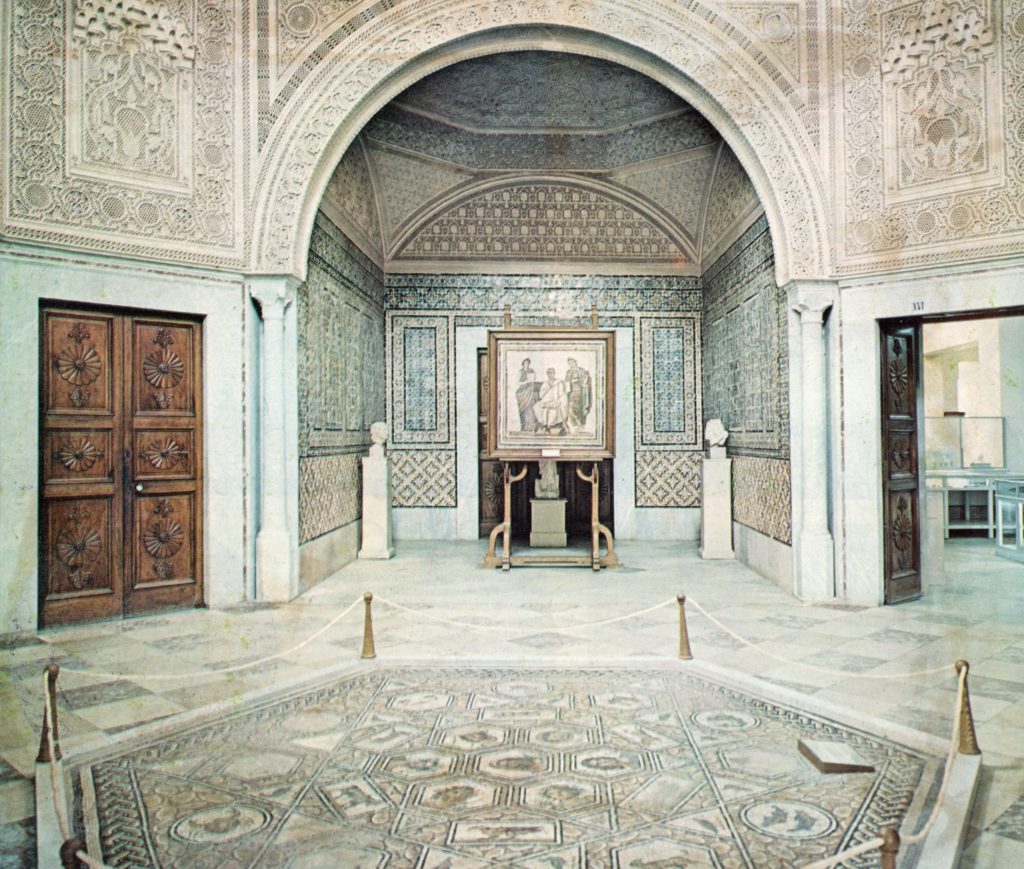
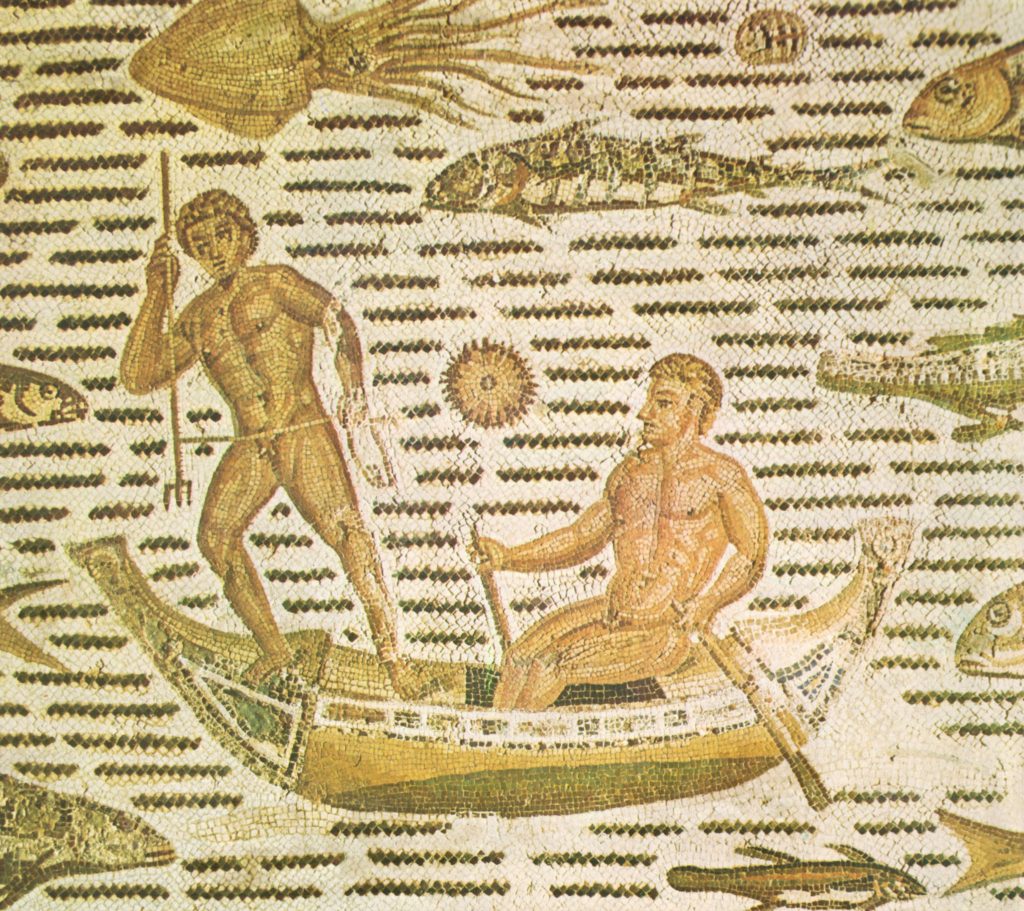 The Bardo was well worth the visit. It is an old palace, with masses of Islamic decoration almost worthy of the Alhambra, and the Roman mosaics were staggering, among the most interesting being those that depicted all aspects of Roman life. The mosaics are exceptionally good in this country because wherever else the Romans settled they painted the walls of their houses; here, they used mosaics for all their decoration, walls and floors. We walked around the medina and souk area, almost deserted, viewing the arches and multicoloured pillars, painted doorways with “hand of Fatima” doorknockers.
The Bardo was well worth the visit. It is an old palace, with masses of Islamic decoration almost worthy of the Alhambra, and the Roman mosaics were staggering, among the most interesting being those that depicted all aspects of Roman life. The mosaics are exceptionally good in this country because wherever else the Romans settled they painted the walls of their houses; here, they used mosaics for all their decoration, walls and floors. We walked around the medina and souk area, almost deserted, viewing the arches and multicoloured pillars, painted doorways with “hand of Fatima” doorknockers.
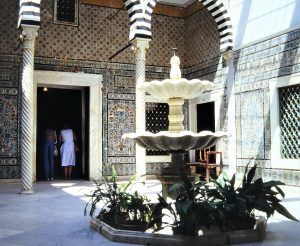 After letting a front move through we left early one morning for what turned out to be a tough sail against the common north-west wind. We were further not assisted by the current swirling around Cape Farina, and finally reached the harbour at Bizerta late that evening. We joined three other boats at anchor in the spacious reaches of the outer harbour behind the harbour wall, despite the entreaties – and, within a few minutes, the apoplectic waving – of a fat man in an amateur admiral’s hat, standing at the end of the wharf of the Club Nautique marina. Having for so long looked forward to lying once more to our own anchor, we were glad to hear from a German boat already doing so that we should ignore him and to stay where we were would be “no problem”.
After letting a front move through we left early one morning for what turned out to be a tough sail against the common north-west wind. We were further not assisted by the current swirling around Cape Farina, and finally reached the harbour at Bizerta late that evening. We joined three other boats at anchor in the spacious reaches of the outer harbour behind the harbour wall, despite the entreaties – and, within a few minutes, the apoplectic waving – of a fat man in an amateur admiral’s hat, standing at the end of the wharf of the Club Nautique marina. Having for so long looked forward to lying once more to our own anchor, we were glad to hear from a German boat already doing so that we should ignore him and to stay where we were would be “no problem”.
We walked ashore, first to Bizerta's attractive Old Harbour precinct, with a kasbah 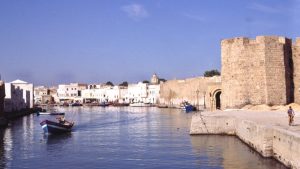 and old fort by the waterside. It was also a fine town for taking on provisions, the main reason we were there at all. All stores were available within an easy walk of the harbour beach, and the market, Norma found, was an exceptionally good one. The fish were of a size and quality we had not seen since the markets of Spain and Portugal, and the meat we bought there was among the best we had sampled in the Mediterranean. It was a bit of a shock to our sensitive souls, however, to have a chicken killed and plucked before our very eyes, especially as we had asked – wholly illogically – for one of the dead ones displayed on the counter.
and old fort by the waterside. It was also a fine town for taking on provisions, the main reason we were there at all. All stores were available within an easy walk of the harbour beach, and the market, Norma found, was an exceptionally good one. The fish were of a size and quality we had not seen since the markets of Spain and Portugal, and the meat we bought there was among the best we had sampled in the Mediterranean. It was a bit of a shock to our sensitive souls, however, to have a chicken killed and plucked before our very eyes, especially as we had asked – wholly illogically – for one of the dead ones displayed on the counter.
We had been intending to leave Tunisia from Bizerta, but a prolonged period of westerly winds set in which would have meant an awful passage – the Mediterranean Sea being what it is – to our next destination, Gibraltar.
After two days sitting it out it seemed that we had the change were waiting for, and we left in a light sou-west land breeze. We rounded Cape Bizerta, the northernmost point of Africa, and thought it would be downhill from there. However, the weatherfax map showed a new depression and a line of fronts approaching from the west. We decided to divert and follow the coast down to the “last” port in Tunisia, Tabarka, only five miles or so from the border with Algeria.
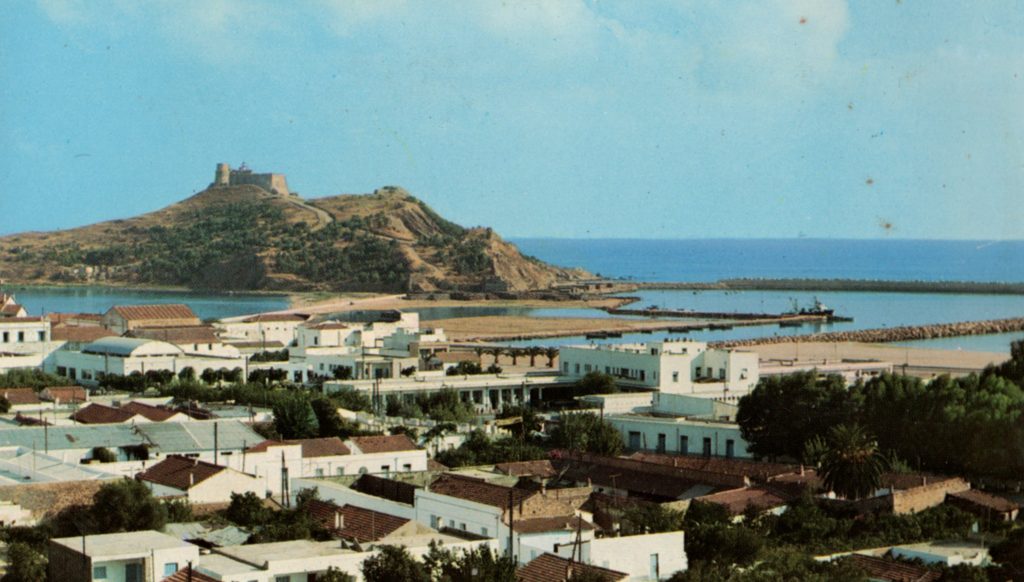 During that day while sailing along the north coast of Tunisia, we could see the coast was very pretty indeed: green and wooded hills, with golden sandy beaches between bunches of rocky cliffs. It was all completely deserted, as far as we could see. The approach to Tabarka was attractive, too, with a Genoese fort set high on a little island which forms part of the protection for the harbour. We arrived to this (originally) unscheduled port late in the evening, once again finding it hard to discern obstacles and markers with the setting sun in our eyes. We tied alongside the southern sea wall, with a handful of other yachts.
During that day while sailing along the north coast of Tunisia, we could see the coast was very pretty indeed: green and wooded hills, with golden sandy beaches between bunches of rocky cliffs. It was all completely deserted, as far as we could see. The approach to Tabarka was attractive, too, with a Genoese fort set high on a little island which forms part of the protection for the harbour. We arrived to this (originally) unscheduled port late in the evening, once again finding it hard to discern obstacles and markers with the setting sun in our eyes. We tied alongside the southern sea wall, with a handful of other yachts.
Although tired and hungry we then had to go through the run-around with the officials, who were particularly bureaucratic here, perhaps because of the harbour's proximity to the border with Algeria. But, as usual, they were pleasant enough as individuals. They thought that such formalities were required everywhere, and were a bit surprised when we told them our experience in other countries was different.
Tabarka was quite an isolated place, very “Tunisian”, which tends to mean block-like houses, rubbish strewn everywhere, and smells of all kinds. (Especially in the harbour, as it happened, into which the town sewer runs, although they were in the process of diverting it – to a nearby beach). We were told that the port was being reconstructed as a base for fishing boats.
Sure enough, the westerlies set in again, blowing red dust all over us, and Norma continued to battle with the problem of keeping the boat stocked with enough provisions for the week or ten days at sea that it would take to sail to Gibraltar - not to mention that we had little idea each day as to when we would actually be leaving!
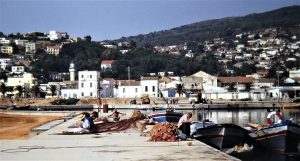 In these more isolated, non-touristy areas the Moslem faith is stronger, and I had my own battle getting some wine and beer, drinking which the faith officially forbids. These beverages were only sold from an unmarked hideaway in a back street, for just about an hour a day, and there was an indescribable scrum of the most scruffy and villainous-looking Arabs fighting to get service at the tiny counter before the booze ran out. Wine was a pretty awful rosé, with no choice. The problem was to get my hands on any of it at all, and I had to use my elbows and feet to keep my place in what we would laughingly call a queue. The local men surreptitiously stuffed their purchases into zipper bags or under their other shopping, and I saw one fellow stick a whole lot of bottles of beer into the waistband of his trousers. I felt as if I was buying bootleg liquor during Prohibition!
In these more isolated, non-touristy areas the Moslem faith is stronger, and I had my own battle getting some wine and beer, drinking which the faith officially forbids. These beverages were only sold from an unmarked hideaway in a back street, for just about an hour a day, and there was an indescribable scrum of the most scruffy and villainous-looking Arabs fighting to get service at the tiny counter before the booze ran out. Wine was a pretty awful rosé, with no choice. The problem was to get my hands on any of it at all, and I had to use my elbows and feet to keep my place in what we would laughingly call a queue. The local men surreptitiously stuffed their purchases into zipper bags or under their other shopping, and I saw one fellow stick a whole lot of bottles of beer into the waistband of his trousers. I felt as if I was buying bootleg liquor during Prohibition!
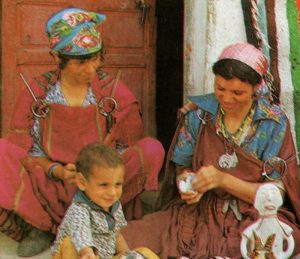 The people in these northern regions are mostly Berbers, generally pale skinned, and in Tabarka the women were dressed in very colourful patterned clothes, often interwoven with gold and silver threads. Very few were wearing the white shrouds and veil which were so common further south. They were also selling carved animals at the handicraft stalls at the market – elsewhere in the Moslem world any depiction of the human or animal form is strictly forbidden.
The people in these northern regions are mostly Berbers, generally pale skinned, and in Tabarka the women were dressed in very colourful patterned clothes, often interwoven with gold and silver threads. Very few were wearing the white shrouds and veil which were so common further south. They were also selling carved animals at the handicraft stalls at the market – elsewhere in the Moslem world any depiction of the human or animal form is strictly forbidden.
Our weather-enforced stay here did become quite sociable. We were hailed by an Australian (Ali), a civil engineer working on the port reconstruction. We enjoyed the hospitality and advice we were granted by him and Kerrie, and had some fun with the crews from the few other boats on the wharf.
After very nearly a week, both the weather and the forecast finally improved. We cleared with officialdom and retrieved the papers we had had to leave with them. We did some final shopping to get rid of most of the remaining Tunisian dinars and gave the rest to a surprised but grateful beggar.
We motored out of the harbour in a gentle nor-easter, a fair wind. But after rounding the promontory with its impressive fort guarding the harbour, we faced a rotten swell from the west as a result of the recent gales.
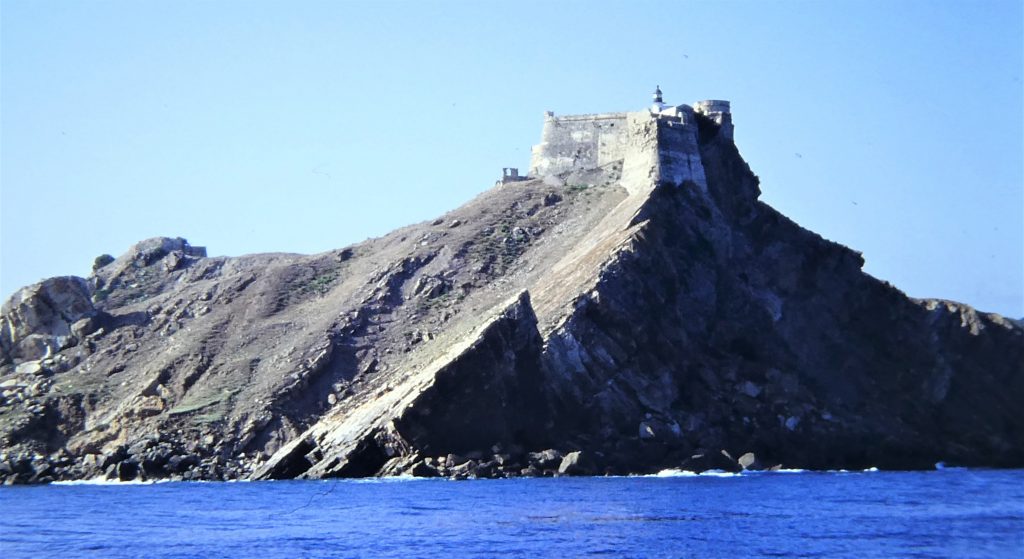 We left the shores of Tunisia, most interesting and mainly enjoyable as the country had been for us as travellers, conscious that the yacht cruising offered was not the cruising we most enjoy. “Anchorages” are mostly good for lunch stops only, although there are some holes in the sandy and tidal southern part of the coastline where shoal-draft yachts could find all-round protection. The all-pervading presence of armed officialdom made us uneasy, and the paperwork required when entering each and every port was a pain. Those who, unlike us, enjoy being parked in crowded full-service marinas – being rapidly constructed in the hope of attracting the yachty dollar - which could really be anywhere in the world, would have a much better time than we did.
We left the shores of Tunisia, most interesting and mainly enjoyable as the country had been for us as travellers, conscious that the yacht cruising offered was not the cruising we most enjoy. “Anchorages” are mostly good for lunch stops only, although there are some holes in the sandy and tidal southern part of the coastline where shoal-draft yachts could find all-round protection. The all-pervading presence of armed officialdom made us uneasy, and the paperwork required when entering each and every port was a pain. Those who, unlike us, enjoy being parked in crowded full-service marinas – being rapidly constructed in the hope of attracting the yachty dollar - which could really be anywhere in the world, would have a much better time than we did.
It's a long way from Tunis to Gibraltar, and we had been advised that calling in anywhere along the coast of Algeria was a very bad idea. But the first day’s sailing was very pleasant, even though Norma had caught a cold that was rapidly worsening. We were also in the margin shipping lanes along the north coast of Africa, which made a careful lookout essential and gave little time for rest. Sometimes there were as many as ten ships to be seen.
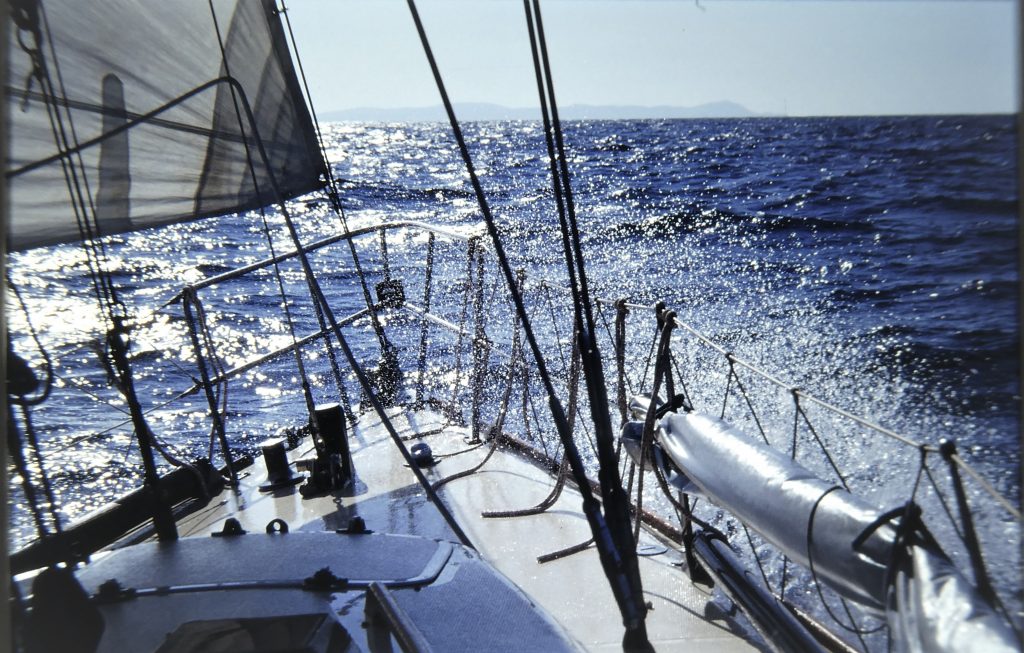 These good conditions continued for four days no less, the best long sail we’d had in the Med. Still hard work, though, because the wind kept varying in speed and direction, required constant changes of sail. It finally died away completely, leaving an oily calm. Starting the motor, we found that a big sheet of plastic was wound round the propeller. I had to dive over to free it. Once motoring again we were hailed by a French single-hander in a small yacht who was out of fuel and worried about the ships. Almeria, in Spain to the north, was only about 20 miles away and we gave him sufficient fuel to get there.
These good conditions continued for four days no less, the best long sail we’d had in the Med. Still hard work, though, because the wind kept varying in speed and direction, required constant changes of sail. It finally died away completely, leaving an oily calm. Starting the motor, we found that a big sheet of plastic was wound round the propeller. I had to dive over to free it. Once motoring again we were hailed by a French single-hander in a small yacht who was out of fuel and worried about the ships. Almeria, in Spain to the north, was only about 20 miles away and we gave him sufficient fuel to get there.
The next hazard was fog, which came in thickly one morning; we stopped for a while, but that makes no difference to the risk of being run into, so we pressed on again, blowing our foghorn from time to time.
Later that day the Rock of Gibraltar loomed out of the murk on Europa Point. The tide was turning, and the calm sea was a mess of garbage, including items such as a floating fridge, all part of the junk that was routinely thrown off the cliffs on the eastern side of the Rock. We learnt later that the Spanish were not too impressed by this, as most of the rubbish was ending up on their beaches.
Return to Gibraltar
On Thursday 8 September 1988 we tied up at the Customs wharf in Gibraltar. On this passage we had covered 700 nautical miles in five and a quarter days, averaging 5.6 knots including 29 hours under power. We had completed our two-year circumnavigation of the Mediterranean Sea, and would now have to get ready for some serious ocean-going.
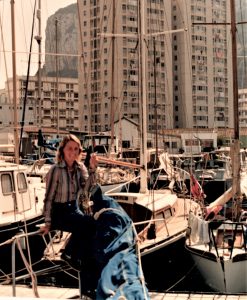 We cleared in quickly with some friendly officials, and because of all the work we would have to do, we took a berth at Sheppard’s Marina.
We cleared in quickly with some friendly officials, and because of all the work we would have to do, we took a berth at Sheppard’s Marina.
We picked up a pile of mail and booked flight for a two-week visit back to England to see our mothers and other family. Norma got stuck into washing, including the sails, and serious provisioning at the convenient Liptons supermarket. The little laptop was now keeping records of all the stores. After dealing with a lot of paperwork we purchased – duty free – a new Honda petrol generator, which would supply 240 V more steadily than our invertor, and would back up the engine alternator for battery charging. There was plenty of boat maintenance to keep up with, in hot, humid "Levanter" weather.
Then off to England for a couple of rather busy and fraught weeks, and although we started the process of getting Norma’s Mum out to Australia, it was sad to leave them both alone again.
Once back, we were quickly into more boat work and provisioning, and packing every spare corner with spare parts. We replaced the lower shrouds, as Norma had seen that one of the strands had broken. On October 1 we had a ringside seat for Gibraltar Air Day, a splendid air show including the Red Arrows, the 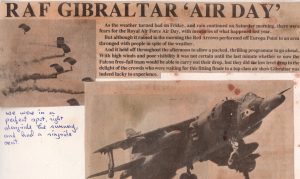 Harriers doing their aerial acrobatics, and other aircraft including Tornados, Jaguars, Canberras and a Shackleton. The next day we had lunch with four of the RAF Jaguar pilots on Satisfaction, Jim (ex-USAF) and Judy, with whom we had spent time in Venice and Malta.
Harriers doing their aerial acrobatics, and other aircraft including Tornados, Jaguars, Canberras and a Shackleton. The next day we had lunch with four of the RAF Jaguar pilots on Satisfaction, Jim (ex-USAF) and Judy, with whom we had spent time in Venice and Malta.
We began tracking the weather and forecasts, waiting for a propitious time to start our trans-Atlantic passage to the Caribbean. Many in the marina, and several friends, were all waiting for the same. We moved from the marina out into the anchorage the north side of the airport runway. The weather began deteriorating seriously, with strong and gusty winds predominantly from the south-west, directly  contrary to what we wanted and to what was supposed to be the prevailing wind at this time of the year. We took a few little local trips to kill the time, including over to La Linea in Spain and for a retrospective visit to Estepona.
contrary to what we wanted and to what was supposed to be the prevailing wind at this time of the year. We took a few little local trips to kill the time, including over to La Linea in Spain and for a retrospective visit to Estepona.
We met up again with Mike and Karen on Tola. Their baby boy had successfully been born in Malta and named Falcon. They asked me to give him a post-natal check. After giving them the usual disclaimers - this was not exactly my field of expertise - I made the examinations prescribed in the textbook I carried. As a result I pronounced him healthy and with all joints in good order, and we wished them well for their continuing circumnavigation.
During this waiting period there was continuing socialising among the yachts. Some were already leaving for Tangier in Morocco or Las Palmas in the Canary Islands and other take-off points for the trans-Atlantic passage. But the weatherfax maps I was studying several times a day continued to be pessimistic, despite often much more optimistic forecasts transmitted by the RAF station here. Indeed, yachts who had decided to get on their way were all reporting having a very bad time of it, with heavy headwinds. Some were already heaving to in gale-force winds, and being swept to the north by the ocean currents.
A month after going out to anchor by the runway we were getting sick of waiting and re-provisioning. But both the weatherfax maps and reports from those at sea were clear that strong south-west winds were still prevailing along our planned route down the coast of western Africa. However, after a particularly bad and sleepless night of vicious thunderstorms a weather window did seem to be opening. Also, the anchorage was becoming untenable as swells were rolling in following the gales. Therefore, on the morning of Friday November 11 1988 we finally decided to leave Gibraltar, under clearing skies and easing winds.
We motorsailed out of the harbour and round to the west through the Strait of Gibraltar in the expected choppy conditions. Then more bad news on the radio: a boat that had just left Tangier reported adverse conditions and that they were returning. Two other boats had decided to keep plugging on, but their reports were not encouraging. We were in agonies of indecision, but in lumpy seas to the north of the city we decided to cut back down to Tangier. We could see that two other yachts had already done so. Our good friends Tom and Maureen on Tilly Whim reported that they were in the harbour there and were having a good time! So the decision was quite easy in the end, although we were beginning to wonder whether we'd ever make it across the Atlantic at this rate.
Tangier, Morocco
It was an easy enough approach around the end of Tangier's big harbour wall and through a passage into the small inner harbour. It seemed that it was only for yachts. There were many already there, as could be expected, all rafted in several layers out from the wharf. We tied up to Tilly Whim.
We were greeted by friendly officialdom. The dock was cost free and was accessed only by a gate guarded by security men, very reassuring. That evening we had a big boat get-together with Tilly Whim and others, a barbeque on the dock: sardines, salads, various German specialities. We were all relieved to be waiting in these pleasant conditions rather than fighting with the ocean as other friends were. The popular saying was, "It's better to be in here wishing you were out there, than being out there wishing you were in here".
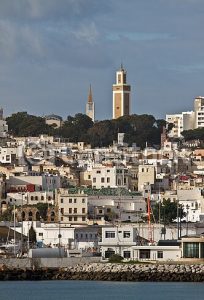 We returned to tourist mode and walked into the city with Tom and Maureen. Tangier is an ancient city with a complex history. In the early 5th century BC the settlement on this bay on the African side of the Strait of Gibraltar was one of the many Phoenician trading posts in the Mediterranean. It became a permanent Carthaginian settlement until 81 BC. The port (then known as Tingis) came under Roman control and later became the capital of the Roman province of Mauretania Tingitana.
We returned to tourist mode and walked into the city with Tom and Maureen. Tangier is an ancient city with a complex history. In the early 5th century BC the settlement on this bay on the African side of the Strait of Gibraltar was one of the many Phoenician trading posts in the Mediterranean. It became a permanent Carthaginian settlement until 81 BC. The port (then known as Tingis) came under Roman control and later became the capital of the Roman province of Mauretania Tingitana.
In the mid-19th century the city was the diplomatic centre of Morocco, with a strong British political influence. From 1923 to 1924 it was part of an internationally administered zone and was returned to internal control following World War II, during which time it had been administered by Spain.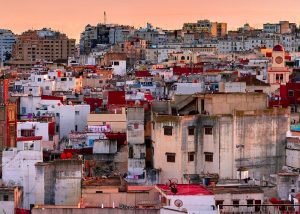
It is uphill into the city from the harbour, with layer upon layer of tightly-packed buildings. Some of the old buildings were very attractive and fronted wide open squares with ornate tiled features. Most men were dressed in Moroccan cloaks with high-peaked hoods. We walked up into the "new" town and then back down to the older shopping area and the covered market. The next day we returned to the old town, 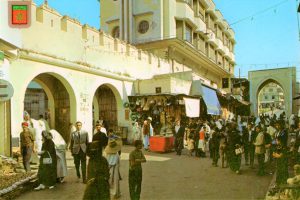 the medina and the Kasbah, viewing the western strait from the heights. This (Sunday) was market day, with many women dressed in red-striped skirts and toped by wide straw hats.
the medina and the Kasbah, viewing the western strait from the heights. This (Sunday) was market day, with many women dressed in red-striped skirts and toped by wide straw hats.
Back down on the wharf we were hailed by a yachty who knew (like most of the others) that I was a doctor. "There's one of the guys flat out on the wharf", he exclaimed. We soon found the invalid lying there, being attended by an attractive young woman. I said to her, "maybe I can help - I'm a doctor". "Thank heavens", she replied - "so am I"! It was our professional agreement was that our invalid was simply heat-stressed and dehydrated, and simply told his friends to keep him cool and plenty to drink.
The doctor was a young anaesthetist, Lilian, and with her husband Rudy - both Swiss - were preparing to sail the Atlantic and the Caribbean in their sloop Shiva. They were to become life-long friends.
In Gibraltar and here, we were getting a reputation as weather gurus, reinforced by my constant studying of fax weather maps. During our second day in the harbour we were approached and asked, "are you leaving tomorrow?' "No", I replied, "but maybe the day after". "OK, we'll go shopping today," was the reply. We got the same enquiries the next day, and my report was that the offshore weather systems had appeared at last to be returning to normal and the outlook was good.
Accordingly, after three nights in the harbour we motored out into light easterly winds, closely followed by ten other boats! Soon afterwards we were sailing well, on a broad reach under full sail, south-west down the coast of Morocco in beautiful conditions. By evening we were sailing wing-and-wing with the wind dead astern, over slight seas, and only being overtaken by a racing yacht under spinnaker. The skies were clear enough for star sights. It then became calm for a while, but we caught a nice tuna; out of practice, we did spray more blood than usual over the deck.
We had finally left the historic Mediterranean Sea and its amazing mix of cultures, nations, landscapes, seaways and anchorages. We would never forget the amazing two years we had sailed around it.
However, there were some aspects of the actual sailing that we did not enjoy and would be happy to forget. Much is unrewarding; the old saw, there’s always too little wind or too much, is right. We’d had some pleasant afternoon drifts, but on passage nothing about the weather lasts for more than an hour or two. There is never a real swell, just a rotten little chop that kicks up in any breeze and hangs on through the next morning’s calm.
Ashore, with the starry exception of Venice and the Adriatic coast of Yugoslavia and Greece, we have also had some disappointments. Part of the problem is probably that, rather surprising as it may seem, the people of the Mediterranean basin are not that keen on the sea. (Ulysses has a lot to say about that!) The main aim of fishermen in Greece and southern Italy is to make enough money to move ashore for good. In most harbours we were reluctant to leave the boat for any length of time so that, as in Central America, we did very little exploring inland. Culturally, therefore, we missed many of the pleasures to be found away from the coast, in these ancient empires. We resolved to return to Europe one day, for more extended exploration by land.

